This annual report details the initiatives, achievements, and functions of the Ministry of Personnel, Public Grievances & Pensions for the fiscal year 2017-2018. It covers a wide range of activities undertaken by its various departments, including the Department of Personnel & Training, Department of Administrative Reforms and Public Grievances, and Department of Pensions and Pensioners’ Welfare. Key areas highlighted include cadre management, policy formulation, training programs, e-governance initiatives, public grievance redressal, international cooperation, and financial management. The report also provides insights into the organizational structure, key personnel, and significant events that occurred during the year, offering a comprehensive overview of the Ministry’s operations and its contribution to good governance.
SOURCE PDF LINK :
Click to access DOPT-PG-AND-TRAINING-ANNUAL-REPORT-2017-18.pdf
Click to view full document content
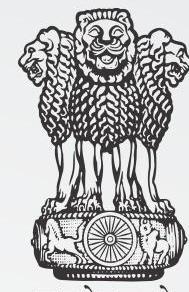
ANNUAL REPORT 2017-2018
MINISTRY OF PERSONNEL, PUBLIC GRIEVANCES & PENSIONS
GOVERNMENT OF INDIA
ANNUAL REPORT 2017-18
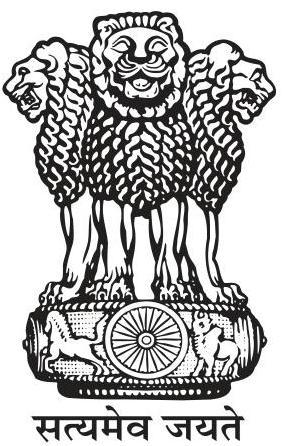
Ministry of Personnel, Public Grievances and Pensions
Government of India
.
CONTENTS
List of Chapters ….. Page Nos.
Vision and Mission
Executive Summary
DEPARTMENT OF PERSONNEL AND TRAINING
1 Overview ….. 1
2 Major Initiatives/Achievements/Events during the year ….. 7
3 Personnel Policies ….. 25
4 Reservation in the Central Government services ….. 47
5 Cadre Management ….. 54
a) Indian Administrative Service (IAS) ….. 54
b) Central Secretariat Service (CSS) ….. 60
c) Central Secretariat Stenographer Service (CSSS) ….. 65
d) Central Secretariat Clerical Service (CSCS) ….. 68
e) State Reorganization ….. 69
6 Senior Appointments under Government of India ….. 72
7 Training Policy and Programmes ….. 77
8 Training Institutions ….. 86
9 Administrative Vigilance Division ….. 106
10 International Cooperation ….. 119
11 Central Bureau of Investigation ….. 123
12 Joint Consultative Machinery ….. 134
13 Administrative Tribunals ….. 136
14 Staff Welfare ….. 142
15 Right to Information ….. 151
16 Grievance Redressal Mechanism & Citizens’ Charter ….. 157
17 Progressive Use of Hindi in Official Works ….. 159
18 Financial Management ….. 163
19 DEPARTMENT OF ADMINISTRATIVE REFORMS AND PUBLIC GRIEVANCES ….. 169
20 Administrative Reforms ….. 176
21 Public Grievances ….. 179
22 Organisation and Methods Division ….. 186
| List of Chapters | | Page Nos. |
| — | — | — |
| 23 | E-Governance | 188 |
| 24 | International Exchange & Cooperation (IE\&C) | 192 |
| 25 | Documentation and Dissemination Division (D\&D) | 198 |
| 26 | Hindi Section | 203 |
| 27 | DEPARTMENT OF PENSIONS AND PENSIONSERS’ WELFARE | 204 |
| | ANNEXURES | 219 |
| 28 | Department of Personnel and Training
Annexure I – Incumbency Position of Under Secretary level Officers and above in DoPT | 221 |
| 29 | Department of Administrative Reforms and Public Grievances (DARPG)
Annexure II – Organisational Chart of DARPG | 225 |
| | Annexure III – Incumbency position of Under Secretary level officers and above in DARPG | 226 |
| | Annexure IV – Prevention of Sexual Harassment of Women at Workplace | 227 |
| | Annexure V – Welfare of SC, ST, OBC and Person with Disability(PWD) | 228 |
| 30 | Department of Pensions and Pensioners’ Welfare
Annexure VI – Organisation Chart | 229 |
| | Annexure VII – Incumbency Position of Group ‘A’ officers in D/o PPW | 230 |
Ministry of Personnel, Public Grievances and Pensions Department of Personnel & Training
Vision
To create an enabling environment for the development and management of Human Resources of the Government for efficient, effective, accountable, responsive and transparent and ethical governance.
Mission
Development and management of government personnel by attracting the best talent, providing excellent career advancement opportunities, encouraging competence and innovation, adopting a dynamic framework of personnel policies and procedures, ensuring capacity building at all levels, inculcating and supporting a culture of transparency, accountability and zero tolerance of corruption in public affairs, and institutionalizing a system of continuous and constructive engagement with stake-holders to make the public services in India more efficient, effective, accountable and responsive.
.
EXECUTIVE SUMMARY
The Ministry of Personnel, Public Grievances and Pensions is the nodal Ministry responsible for personnel matters, especially in respect of issues concerning recruitment, training, career development, staff welfare and the post retirement dispensation. The Ministry also works towards promotion of responsive, people-oriented and modern administration.
The Ministry comprises three Departments:
(i) Department of Personnel and Training (DoP&T)
(ii) Department of Administrative Reforms and Public Grievances (DARPG)
(iii) Department of Pensions and Pensioners’ Welfare (DPPW)
Department of Personnel \& Training
Various wings of DoP\&T are as under:
- Establishment Officer’s (EO) Wing
- Services \& Vigilance (S\&V) Wing
- Establishment (Estt.) Wing
- Training (Trg.) Wing
- Administration Wing
The Establishment Officer’s Wing deals with the matter relating to senior appointments under the Government of India requiring approval of the ACC.
The Services \& Vigilance Wing handles matters relating to Administration of Rules on all the service matters in respect of All India Services and acts as the nodal agency in the arena of vigilance and anti-corruption. This wing in addition to governing the implementation of RTI Act, also handles the administrative matters relating to the Administrative Tribunals and Central Information Commission. This wing also handles the work related to Cadre Restructuring in respect of the other Central Services.
The Establishment Wing is responsible for framing and revising rules and regulations regarding service conditions of the employees and personnel policies of the Central Government employees other than All India Service Officers. This wing also handles the work related to Reservation Policy of the Government, Joint Consultative Machinery (JCA) and Civil Services Officers’ Institute (CSOI).
The Training Wing acts as the nodal agency for training of Government functionaries and is primarily responsible for formulating policies with regard to training.
Administration Wing deals with the matters related to Cadre Management of the Central Secretariat Service, Central Secretariat Stenographers Service and the Central Secretariat Clerical Service. This wing also handles the administrative matters relating to the State Reorganization and Welfare Activities for benefit of the employees of the Government except CSOI.
The Department of Personnel & Training also handles the administrative work relating to the following Institutions: –
- Union Public Service Commission
- Central Vigilance Commission
- Lokpal
- Central Administrative Tribunals
- Central Information Commission
- Central Bureau of Investigation
- $\quad$ Staff Selection Commission
- Public Enterprises Selection Board
- Lal Bahadur Shastri National Academy of Administration
- Institute of Secretariat Training \& Management
Department of Administrative Reforms \& Public Grievances
The Department of Administrative Reforms and Public Grievances is the nodal agency of the Government of India for administrative reforms as well as redressal of public grievances relating to the States in general and those pertaining to the Central Government agencies in particular. The Department endeavours to document and disseminate successful governance practices by way of audio-visual media and publications. The Department also undertakes activities in the field of international exchange and cooperation to promote public service reforms. There are 7 Divisions in the Department namely Administrative Reforms, Organization \& Methods, E-Governance, Documentation \& Dissemination, International Cooperation, Administration \& Coordination and Public Grievances.
Department of Pensions and Pensioners’ Welfare
The Department of Pension \& Pensioners’ Welfare was set up in 1985 as part of the Ministry of Personnel, Public Grievances and Pensions to formulate policy and coordination of matters relating to retirement benefits of Central Government employees (except Defence, Railway and Post \& Telecommunication Pensioners).
OVERVIEW
1.0 The Department of Personnel and Training acts as the formulator of policies pertaining to recruitment, regulation of service conditions, and deputation of personnel besides advising all organizations of the Central Government on issues pertaining to personnel management. The Organizational chart of the Department is at next page.
Major Initiatives / Achievements / Events during the year (Chapter 2)
1.1 Major Initiatives/Achievements during the period January 2017 – January, 2018 have been brought out in Chapter 2.
Personnel Policies (Chapter 3)
1.2 The Department is responsible for framing rules and regulations governing service conditions including recruitment rules, promotions and seniority, Flexible Complementing Scheme, Leave Travel Concession, deputation and Child Care Leave of employees. Personnel are recruited for the Central Government by the Union Public Service Commission through competitive examinations conducted by them for appointments to higher civil services and through the Staff Selection Commission of non-gazetted staff in Group ‘B’ & ‘C’ categories.
Reservation (Chapter 4)
1.3 In order to achieve the objective of
upliftment and welfare of the Scheduled Castes and Scheduled Tribes, Other Backward Classes and Persons with Disabilities, the Department frames policies to provide reservation to these groups in various Central Government services and for monitoring its implementation.
Cadre Management (Chapter 5)
1.4 This Department is responsible for management of the cadres of All India Services (AIS) (IAS, IPS and IFS) and all three Secretariat Services namely Central Secretariat Services (CSS), Central Secretariat Stenographers’ Services (CSSS) and Central Secretariat Clerical Services (CSCS). In addition, this Department frames and also revises Rules and Regulations regarding conditions of the All India Services, such as Indian Police Service (IPS) and Indian Forest Service (IFS), in consultation with the Ministry of Home Affairs and Ministry of Environment, Forest and Climate Change respectively. This Department is also responsible for cadre review of 61 Central Group ‘A’ Services on a periodic basis.
Senior Appointments under the Government of India (Chapter 6)
1.5 The Department deals with appointments at senior level and personnel policies of the Government of India. All proposals for senior appointments under the Government of India, which require the
approval of the Appointments Committee of the Cabinet (ACC), are processed by the Department. These include board level appointments to Central Public Sector Undertakings and appointments under the Central Staffing Scheme for posts of Joint
Secretaries, Directors and Deputy Secretaries in Ministries /Departments. In addition, all appointments by promotion, which require the approval of the ACC, are also processed by the Department.
Organisation Chart for Department of Personnel & Training
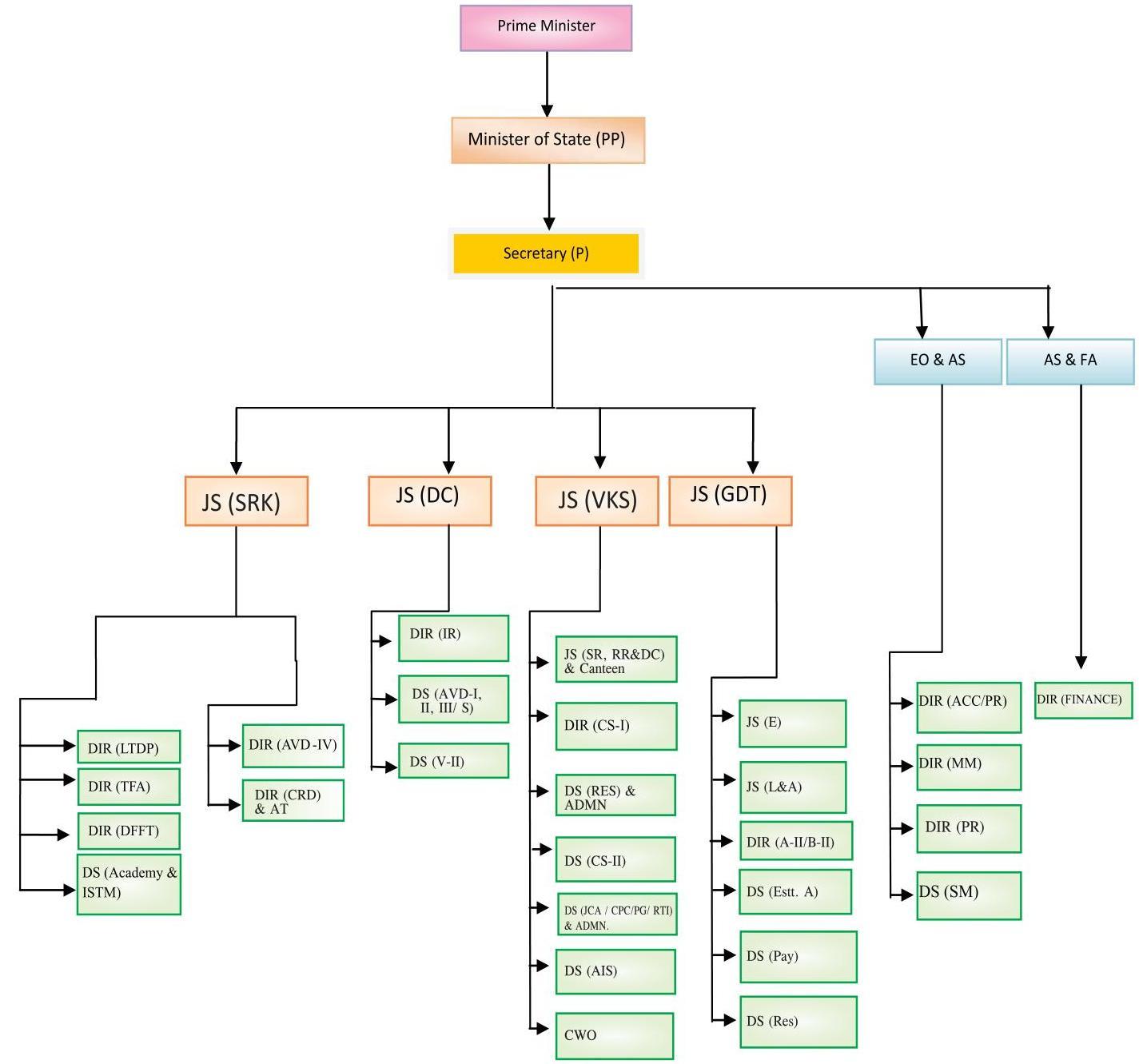
| Abbreviations Used in the Organization Chart | |
|---|---|
| ACC | Appointments Committee of Cabinet |
| AVD | Administrative Vigilance Division |
| ADMIN | Administration |
| AIS | All India Services |
| AS | Additional Secretary |
| B&C | Budget \& Coordination |
| CS | Central Secretariat |
| CPC | Central Pay Commission |
| CRD | Cadre Review Division |
| CWO | Chief Welfare Officer |
| DFFT | Domestic Funding of Foreign Training |
| DS | Deputy Secretary |
| DIR | Director |
| E | Establishment |
| EO | Establishment Officer |
| IR | Information Rights |
| JS | Joint Secretary |
| JCA | Joint Consultative Machinery and Arbitration |
| LTTP | Long Term Training Programme |
| L\&A | Leave Allowances |
| MOS | Minister of State |
| MM | Middle Management |
| PR | Personal Records |
| PIIA | Pathways for an Inclusive India Administration |
| PESB | Public Enterprises Selection Board |
| PP | Personnel \& Pension |
| RES | Reservation |
| RR\&DC | Redeployments \& Retraining \& Departmental Council |
| S\&V | Services \& Vigilance |
| S | Services |
| SM | Senior Management |
| SR | State Reorganization |
| TRG | Training |
| V | Vigilance |
Training Policy and Programmes (Chapter 7)
1.6 The Department is the nodal Department to impart training to the government functionaries. The Training Wing of the Department formulates policies and implements its training programmes by identifying areas of training, designing training programmes, development of trainers and training capabilities and administering policies in training. Major training activities undertaken during the year are (i) In-service training of IAS officers (ii) Mid-Career Training of IAS Officers (iii) Domestic Funding of Foreign Training (iv) Post Graduate Programmes in Public Policy (v) Training Support, (vi) Intensive Training Programme, (vii) Augmentation of the Capacity of training institutions (viii) Capacity Building for poverty reduction (ix) Distance and e-learning initiatives and (x) e-governance initiatives.
Training Institutions (Chapter 8)
1.7 Lal Bahadur Shastri National Academy of Administration (LBSNAA), Mussourie, Uttarakhand and Institute of Secretariat Training and Management (ISTM), Delhi are two premier training institutions, attached to this Department. These institutes cater to the needs of human resource development by imparting training to all officers of Central Government at frequent intervals for their career progression. The Department also supports the Indian Institute of Public Administration (IIPA) which is an autonomous organisation, in undertaking advance training programmes for administrators as well as researchers on issues
relating to public administration.
Administrative Vigilance Division (Chapter 9)
1.8 The Department is the nodal agency responsiblefor formulation and implementation of vigilance and anti-corruption policies of the Government. Administrative Vigilance Wing in the Department oversees government programme for maintenance of discipline and eradication of corruption from public service. The Central Vigilance Commission (CVC) advises the Central Government on all vigilance matters. The jurisdiction of the Commission extends to all the organisations to which the executive powers of the Union of India extend.
International Cooperation (Chapter 10)
1.9 The Department of Personnel and Training is the nodal Department for anti corruption. To deal with international cooperation on these aspects an International CooperationCellwascreatedinthisDepartment. The primary tasks of this Cell emanate from the follow up to the ratification of the United Nations Convention Against Corruption (UNCAC) and the other consequential international collaborative efforts, on global platforms. This Cell acts in conjunction with specialized agencies like the Central Bureau of Investigation, the Enforcement Directorate and the other line Ministries entrusted with the specific ancillary tasks within their respective administrative domain, viz. corporate governance, extradition matters, prevention of money laundering, mutual legal assistance treaties etc.
Central Bureau of Investigation (Chapter 11)
1.10 Central Bureau of Investigation (CBI) was set up by the Government of India by a Resolution dated April 1, 1963 to not only investigate cases of bribery and corruption, but also violation of central fiscal laws, major frauds relating to Government of India Departments, Public Joint Stock Companies, passport frauds and serious crimes committed by organized gangs and professional criminals. CBI was further strengthened by the addition of Economic Offences Wing by the Government of India by Resolution dated February 2, 1964.
Joint Consultative Machinery (Chapter 12)
1.11 The Government provides for a Joint Consultative Machinery for joint consultation at three levels between the Central Government and its employees for promoting harmonious relations and securing optimum level of co-operation between the Central Government and its employees in matters of common concern. The objective is to increase the efficiency of public services along with the well-being of the employees. The three tiers are:
a) National Council – at the apex level, functioning under the Department of Personnel and Training.
b) Department Councils – functioning at the level of the Ministries / Departments.
c) Office Councils-functioning at offices/
organisations under various Ministries / Departments.
1.12 The Scheme has proved to be an effective forum for amicable settlement of grievances of the Central Government employees relating to their service matters etc.
Administrative Tribunal (Chapter 13)
1.13 In order to provide speedy and inexpensive justice delivery system to the employees who feel aggrieved by Government decisions, the Government set up the Central Administrative Tribunal (CAT) in 1985, which now deals with all cases relating to service matters. The CAT has 17 regular benches, 15 of which operate at the Principal seats of High Courts and the remaining two are at Jaipur and Lucknow.
Staff Welfare (Chapter 14)
1.14 The Central Government being the largest single employer in the country discharges its responsibility for looking after the welfare of employees through various welfare measures. The Department also extends support to various staff welfare measures. The DoPT is the nodal Department for four registered societies set up for the welfare of the Government employees and their families. In addition, the Department lays down policies for Departmental Canteens and supports the Resident Welfare Associations.
Right to Information (Chapter 15)
1.15 The Department has brought out a comprehensive law in order to ensure right to information to the citizens of India in almost
entire matters of governance at all levels from Central Government to the local selfgovernment. The Law (RTI Act, 2005) has provided a mechanism where the Central Information Commission, being the apex body at the Centre, facilitates its citizenry in accessing information in a time bound, hassle free and affordable manner.
Grievance Redressal Mechanism & Citizens’ Charter (Chapter 16)
1.16 DOP\&T have identified some of the core services being offered by its various divisions and their standards for the purpose in its first charter. This has been undertaken by a Task Force in consultation with the Stakeholders. While identifying the services the focus has been on measurable and verifiable services and their standards. The charter contains Grievance Redress Mechanism related to the services mentioned in the Citizens’/Clients’ Charter. The Charter also provides links for other grievances which are not related to the Citizens’/Clients’ Charter. Time lines have been prescribed for final disposal of the complaint arising out of the Citizens’/Client’s Charter.
Progressive Use of Hindi (Chapter 17)
1.17 The Department is fully committed to promote the use of Hindi as the official language, in official matters and motivate
compliance of the provisions of the Official Language Act, 1963 and the rules framed thereunder. The Department also ensures that the spirit of various orders and guidelines issued by the Department of Official Language is appropriately enforced for implementation of the official language policy of the Union. The Department has an Official Language Division which monitors the implementation of the policy in the Department.
Financial Management (Chapter 18)
1.18 In order to promote the various programmes administered by Ministry of Personnel, Public Grievances and Pensions, an annual allocation of Rs. 150.96 crores was made in the Central Sector Scheme Outlay for the year 2017-18 (RE 2017-18) against a total allocation of Rs. 1560.00 crore for 2017-18 (RE 2017-18). The corresponding figures for 2018-19 are Rs. 152.75 crore as Central Sector Scheme Outlay against a total allocation of Rs. 1527.00 crore. The requirements and priorities of its attached and subordinate offices were kept in view while making budgetary allocation to them by this Department. 3 PAC para are pending in this Ministry. However, no C\&AG Para is pending.-
Major Initiatives/Achievements/ Events during the year
Posting of the third batch of IAS Officers as Assistant Secretary in Government of India:-
2.1 175 IAS officers of 2015 batch were posted as Assistant Secretary in the Ministries/ Departments of Government of India for a period of 3 months from 03.07.2017 to 29.09.2017 on Central Deputation.
2.1.1 The objective of providing wider exposure to the working of Central Government, macro perspective on policy formulation, strengthening cooperative federalism & citizen centric implementation of schemes has been carried forward in the third year of the Scheme.
2.2 The Hon’ble PM addressed the Assistant Secretaries in the inaugural session on $3^{\text {rd }}$ July, 2017 as well as the Valedictory Session on $26^{\text {th }}$ September 2017.
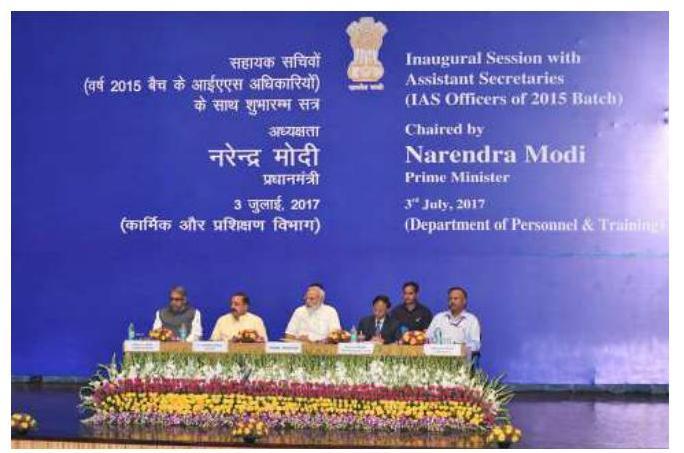
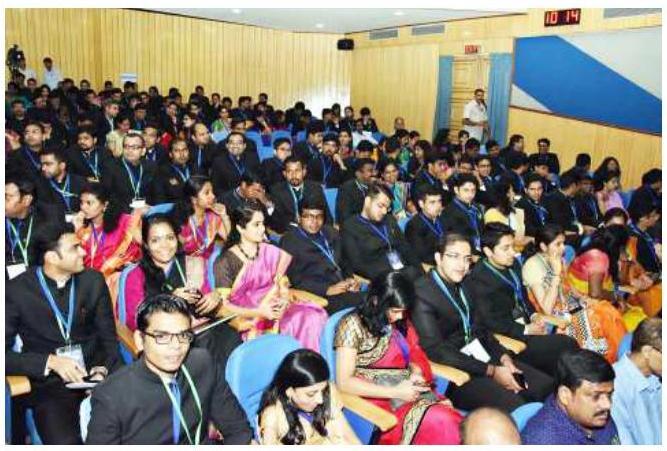
2.3 Several interactive sessions with Assistant Secretaries (IAS-2015 Batch) were organized by DoP\&T, NITI Aayog, Cabinet Secretariat, D/o AR\&PG, Scientific Ministries / Organizations, D/o Agriculture and Famer’s Welfare, etc. on different topics in which a large number of dignitaries/Head of Departments/Head of Organizations /Senior Officers participated. Positive feedbacks on the posting were received from the officers in the feedback session organized on $27^{\text {th }}$ October, 2017.
2.4 Hon’ble Prime Minister also addressed the Valedictory Session of the Assistant Secretaries (IAS-2015 batch) at DRDO Auditorium, New Delhi on $26^{\text {th }}$ September 2017. During the Valedictory session, eight (8) Assistant Secretaries made presentations on various topics in which many useful suggestions were made before the Hon’ble PM.
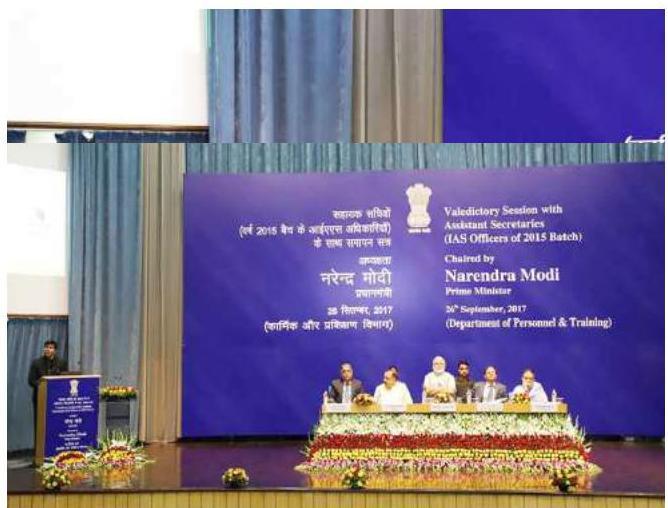
Launch of employee portal (eHRMS):-
2.5 Electronic Human Resources Management System (eHRMS) was launched on the occasion of “Good Governance Day” (on 25/12/2017) by Hon’ble MoS (PP) as a part of an ambitious initiative towards Good Governance in Government of India.
2.6 Expenditure Management Commission (EMC) recommended HRMS (Employee Portal) across all offices of Government of India covering all employees within a defined time frame. The Group of Secretaries deliberated on the subject and recommended.
- A critical review of the applications which are already available and suitable upgradation to meet contemporary challenge.
- Unification of database of the employees, and new applications required to be developed.
- The application related to e-service book will have to be first implemented so that a single platform with this unified database is available for further integration
2.7 The automated HRMS comprehensively covers all service matters from entry to exit including leave, transfer, promotion, performance appraisal, travel, LTC, pay, pensions, advances etc. E-service book of 661 employees of DOPT was launched on 30.03.2017 by MoS (PP). Thereafter 28 applications were identified and software for 23 applications developed till now and 22 applications got verified from users. These 22 applications broadly comprise 04 modules having end to end solutions were launched on the occasion of “Good Governance Day”. Remaining application will be operationalized by 31.03.2018.
2.8 With launch of e-HRMS, employees will be able to not only see all their details w.r.t service book, leave, GPF, Salary etc. but also apply for different kind of claims/ reimbursements, loan/advances, leave, leave encashment, LTC its advances, Tour etc. on single platform.
2.9 Availability of centralized data will enable government for policy research and planning as such educational qualifications and other competencies and deficiencies may be easily obtained. It will enable Government to take transfer and posting decisions more pragmatically based on reliable first hand data.
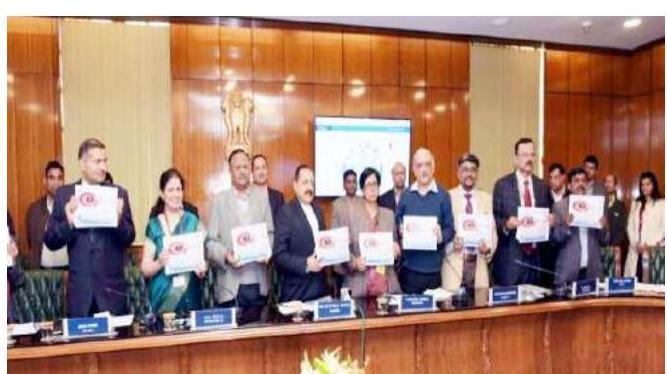
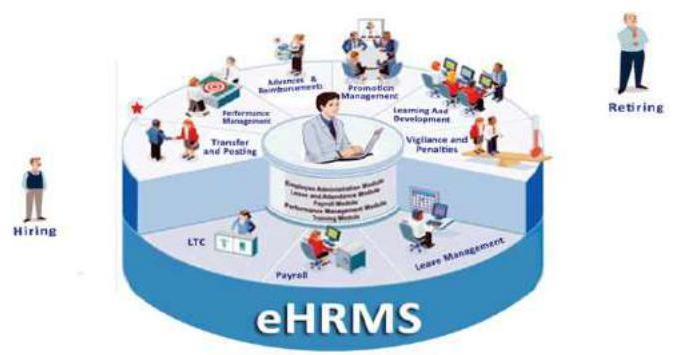
Launch of Online System for Monitoring of Disciplinary Proceedings:-
2.10 The Online System for Monitoring of Disciplinary Proceedings was launched by Hon’ble MoS (PP) on 22/06/2017. The new system will expedite the proceedings against government employees involved in corruption cases. Reducing the timeline in completion of disciplinary proceedings will give faster relief to the honest officers. The focus of the software is to reduce the pendency in the cases related to disciplinary proceedings.
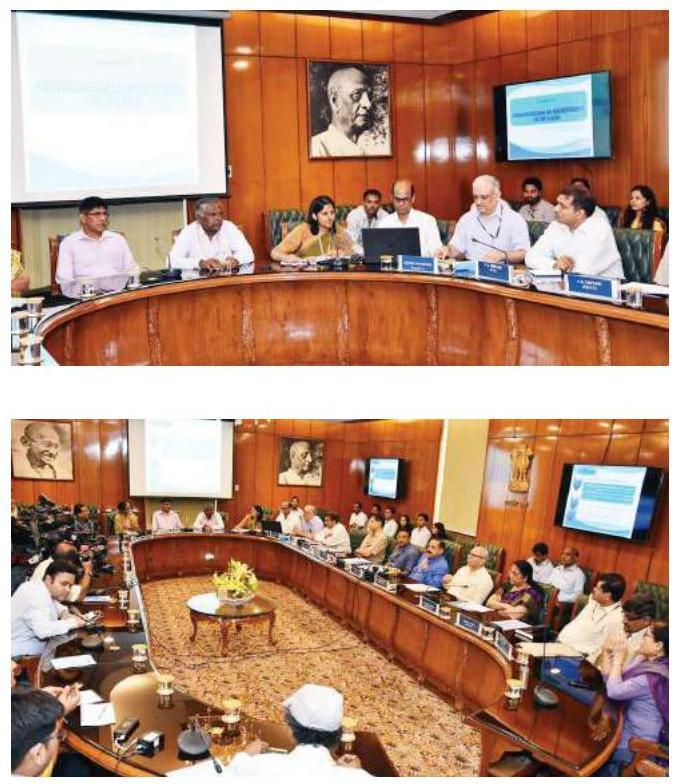
Launch of Online Vigilance System of Board and below Board Level Executives of Central Public Sector Enterprises (CPSEs)” and “Launch of e-Service Book”
2.11 Hon’ble MoS (PP) inaugurated two digital initiatives on $30^{\text {th }}$ March, 2017 namely “Online Vigilance System of Board and below Board Level Executives of Central Public Sector Enterprises (CPSEs)” and “Launch of e-Service Book in respect of employees of DoP&T”. The launch of online vigilance system will bring transparency and accountability in the system whereas introducing e-service book will ease the maintenance of career record of Government Servant. This would also provide database for launching online services for employees. Upon success, this initiative is to be implemented across all departments.
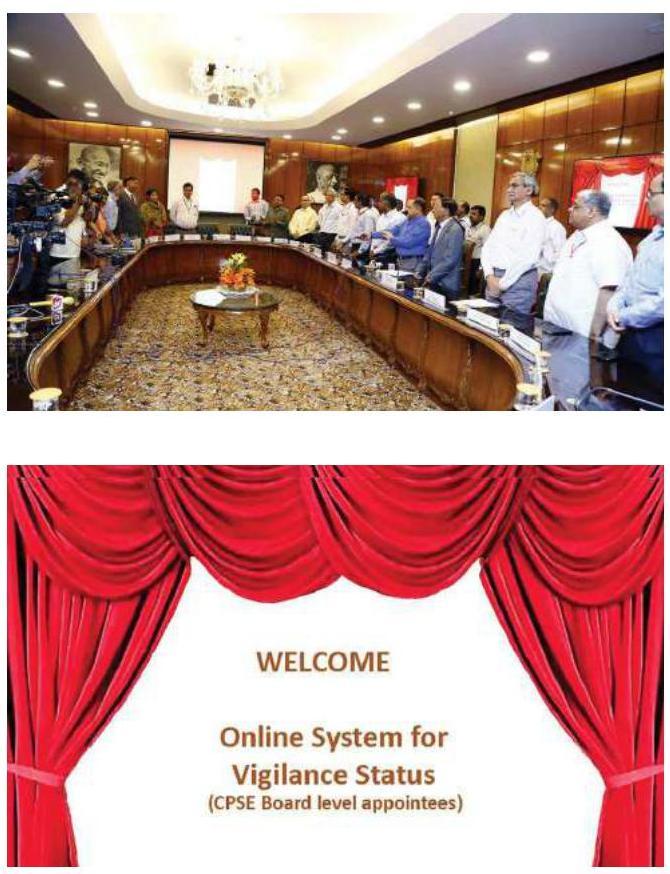
Launch of Comprehensive Online / Modified Modules on Induction Training (COMMIT)
2.12 A new blended training programme called Comprehensive Online /Modified Modules on Induction Training (COMMIT) was digitally launched by Hon’ble MoS (PP) on June 29, 2017 at North Block. The Comprehensive Online Modified Modules on Induction Training (COMMIT) has been conceptualised in the background of the National Training Policy-2012 which stipulates that all civil servants from lowest level functionaries to the highest level will be provided training at the time of their entry into civil service and mandates that priority will be given to the training of frontline staff, including training on soft skills, so as to improve customer orientation as well as quality service delivery to the citizen. This programme will supplement the existing 12-Day Induction Training Programme (ITP) launched in 2014- 15 for newly recruited frontline state government functionaries to develop in them Generic & Domain specific competencies.
2.13 The COMMIT has been launched in 6 States of Assam, Haryana, Maharashtra, Tamil Nadu, Telangana and West Bengal on pilot basis during the current financial year 2017-18. The programme will cover approximately 82,000 frontline State government functionaries in the financial year 2017-18.
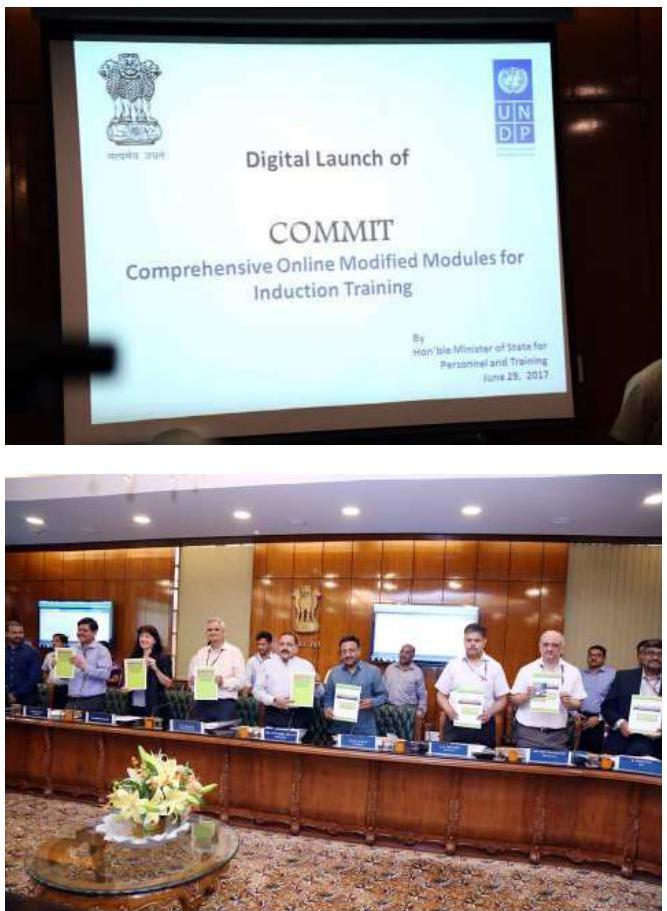
Induction Training at cutting edge level:–
2.14 In order to promote a citizen centric attitude in the employees, for better public service delivery and promote good practices towards achieving the vision of citizen centric governance, Department of Personnel and Training had launched a 12-Days Induction Training Programme (ITP) in the year 2015-16 in 103 districts of 21 States with a Two Day Regional Training of Trainers (ToT) Workshop at various State ATIs for training of 7000 frontline State government functionaries. In the year 2016-17, the Induction Training Programme has been implemented in 115 new districts of 24 States. In the year 2017-18, the Induction Training Programme is proposed
to be implemented in 75 new districts of 15 States.
RTI ONLINE PORTAL:-
2.15 A web portal namely ‘RTI Online’ has been launched to provide the facility for the Indian Citizens to file online RTI applications and first appeals and also to make online payment of RTI fees. The prescribed fee can be paid by the applicant through internet banking of the State Bank of India and its associate banks as well as by Credit/Debit cards of VISA/ Master, through the payment gateway of SBI linked to RTI Online portal.
2.16 The RTI online portal provides for sending online replies to applications and appeals, though reply can be sent by regular post also. For the successful implementation of this facility, extensive training to the CPIOs/ FAAs has been provided by DOPT, with the help of NIC. Till 31.10.2017, 2144 Public Authorities have been aligned under this portal.
E-Governance Initiatives:
I SUPREMO
2.17 SUPREMO (Single User Platform Related to Employees Online), a web based application which was operationalised in January, 2016 integrates the existing applications, using latest technology to reduce redundancy and establish a centralised data base relating to Human Resource Management and functions as a Decision Support System.
The following systems have been integrated under this:
- Integrated Personnel Information System (IPIS) for IAS and Group A services officers working under Central Staffing Scheme
- Central Staffing Scheme processing system and Panel processing system
- Empanelment & Appraisal system (EASY) for empanelment of JS level and Equivalent posts in GOI
- ACC vacancy monitoring system (AVMS)
- ACC Proposals monitoring system (APMS)
- SPARROW (Smart Performance Appraisal Report Recording Online Window for IAS officers) using WEB services.
- $\quad$ Immovable property returns of IAS officers
- Vigilance information system for IAS officers
2.18 SUPREMO includes a module for the maintenance of e-records of the career profiles of IAS officers and also of officers of other services who come on deputation under the Central Staffing Scheme. The records are updated regularly based on orders received from various sources. The Executive Record Sheets of IAS officers generated from the database are available in the public domain.
2.19 Online submission of applications by officers for retention under Central Staffing
Scheme and their online validation by the Cadre Controlling Authorities is also done on SUPREMO. The Software provides a list of officers’ retained and available, on offer for postings under the Central Staffing Scheme, which is published in the public domain. The application for the post of CVOs has also been incorporated thereby providing a single form for both CSS and CVO applicants.
2.20 SUPREMO also incorporates a Vacancy Monitoring System which is a web enabled application for getting information from all Ministries/Departments related to all posts, which require ACC approval and for monitoring vacancies and anticipated vacancies of posts under PSUs, PSBs, Autonomous Organizations, Attached Offices, General Central Services, Statutory Bodies and Export Promotion Councils etc. This incorporates the features of the earlier ACC Vacancy Monitoring System (AVMS).
2.21 Provision has been made for an online tool for real-time monitoring of proposals submitted to the Appointments Committee of the Cabinet. This is based on the earlier ACC Proposal Monitoring System (APMS), which provides a readily available e-record of orders, directions and back-references made by the ACC Secretariat. The system helps in tracking of proposals thereby enabling the effective monitoring and elimination of delays.
SUPREMO also connects the following existing systems:
(A) Empanelment and Appraisal System (EASY)
An IT-enabled System-Empanelment and Appraisal System (EASY) had been developed with technical support from NIC for generating data electronically by Cadre Controlling Authorities (CCAs) and then transferring it to DOPT for further online processing of the proposal for JS level empanelment. All the proposals for JS level empanelment are now received and processed electronically through this software. The software includes various other features which help the CCAs in the management of the cadres under their control and at the same time helps EO Division in expediting the empanelment process. The software has three modules viz, Cadre Controlling Authority Module, DOPT Module and Officers’ Interface Module. All the Three modules have been made functional.
(B) Property Related Information System (PRISM)
The PRISM application was launched with effect from 01/08/2014 for IAS officers in order to facilitate online filing of information related to assets and liabilities. The officer is required to authenticate the declaration and information filed by using the Digital Signature (DSC). In case the officer does not have a DSC or is not able to use his DSC for any reason there is a provision enabling the officer to scan and upload the declaration and information relating to assets and liabilities.
(C) SmartPerformance Appraisal Report Recording Window (SPARROW)
SPARROW is an online system for performance appraisal of IAS officers. The system aims to
bring more transparency in the recording of performance appraisals, to eliminate loss of PARs during transition, to ensure better monitoring and timely completion of PARs and to provide easy and immediate access to the PARs by authorized stakeholders. The system was launched with effect from 01/04/2014 and was initially linked to the intra-IAS database enabling the PAR form to be pre-populated with the existing information. Subsequently the responsibility to update the requisite details in respect of officers was passed on to the Employee Master Data (EMD) manager of the respective Cadre/Central Ministry or Department.
SPARROW system generates auto-alerts in respect of the officers whose PARs are pending beyond the stipulated timeline. As on date, the total number of the electronically generated PARs for the Assessment year 2015-16 is 7034 and for the Assessment Year 2016-17 is 7822 .
Immovable Property Returns (IPR) Module on SPARROW. As per Rule 16(2) of AIS (Conduct) Rules, 1968, IAS officers are required to submit IPRs every year as on $1^{\text {st }}$ January and latest by $31^{\text {st }}$ January in respect of the preceding year. Since the year 2010, the IPRs of IAS officers are being uploaded on the Department’s website. Though digitization of IPRs was done through uploading these on DOPT’s website, however, as officers were filing their return in hard copy only, certain problems viz., IPRs getting lost in transition, IPRs through submitted but not uploaded by the State Govt. IPRs without date uploaded in the system, ante-dating IPR etc. were still being submitted online by the officers w.e.f. 1.1.2017, the navigation tab of which has been provided in the menu on Home Page of SPARROW. The officers can access the Module by using the login ID and Password, which have already been provided to them for accessing the SPARROW and after filing the return, he/she is required to authenticate it by using either DSC or eSign.
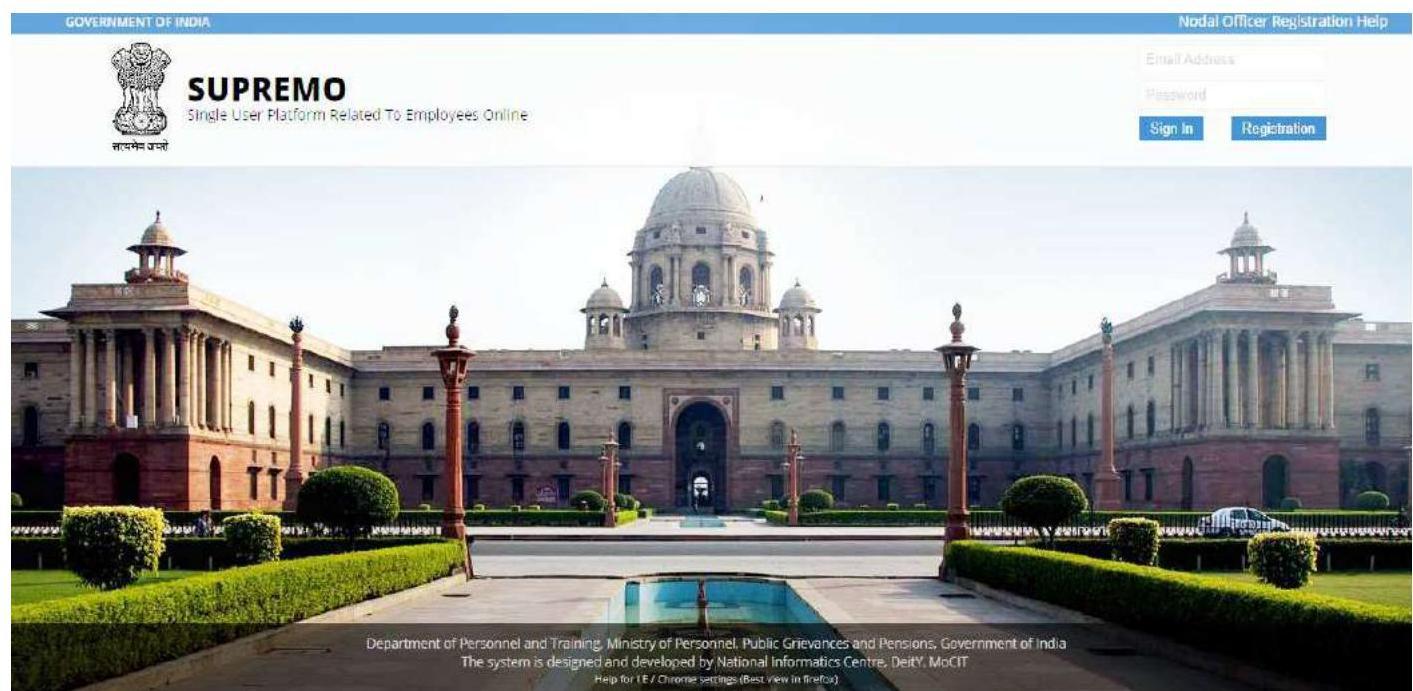
(II) Employees Online (EO) App
2.22 The Employees Online (EO App) is a mobile application which was launched on 28/10/2016 for Android users and on 25/12/2016 for IOS. The App aims at providing information on real time basis and thereby promotes transparency. The salient features are detailed below:
(i) EO App provides the information like Sr. Officers Appointment and Posting orders approved by ACC, What is New of D/o Personnel and Training website, Holiday list, Directory Listing of all Ministries/ Departments (contact us info) on real time basis for media persons, officers and all stake holders.
(ii) IAS and other Group A central services personnel can login and see their individual information like, ER sheet, APAR, IPR and information like offer list, Officers at Centre, Training Application status, domestic, foreign training details, Civil list (IAS), vacancy circulars, OMs & Orders etc. The application has feature of “push notification” i.e. users of the application will get alert on the app whenever there is a new notification.
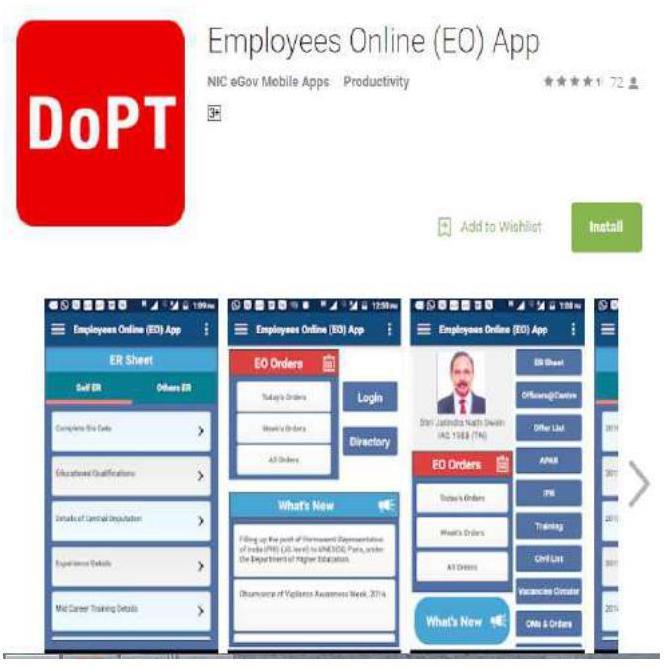
Introduction of conducting examinations by SSC on Computer Based Mode
2.23 The Central Government has approved the introduction of conducting examinations by SSC through the Computer based mode for transparency and elimination of malpractice. The following examinations have been switched over from the O.M.R. mode to the C.B.E.:
(i) Lower Division Clerk Grade Limited Departmental Competitive Examination – 2017.
(ii) Stenographer Grade- ‘C’ Limited Departmental Competitive Examination – 2017
(iii) Junior Hindi Translator, Junior Translator, Senior Translators, Hindi Pradhyapak Exam – 2017
(iv) Re-examination of Multi Tasking Staff (Non-Technical) Examination, 2016.
Signing of Memorandum of Understanding between Union Public Service Commission and Royal Civil Service Commission, Bhutan
2.24 This Department vide letter No. 39011/11/2015-Estt (B) dated 28.06.2017 furnished a copy of signed MoU to Cabinet Secretariat, which was executed between the Royal Civil Service Commission, Bhutan (RCSC) and Union Public Service Commission (UPSC) on 29.05.2017 for strengthening existing relationship between RCSC and UPSC.
Making available publicly scores and rankings of candidates in the recruitment examinations through portal
2.25 This Department conveyed its decision that all recruitment agencies viz. UPSC, SSC, RRB etc. will use National Career Service (NCS) portal of Ministry of Labour and Employment for disclosure of scores and rakings of candidates.
2.26 This Department also requested all public Recruitment Agencies to link their respective web pages to NCS portal for disclosure of scores / rankings of all the candidates appearing in the final stage of each recruitment process being conducted by them. All the Ministries / Departments were also requested to direct the Recruitment Agencies working under them for doing the needful in this regard.
Certificates of Excellence for RTI Request & Appeals Management Information System
2.27 Hon’ble MoS (PP) presented Certificates of Excellence for RTI Request \& Appeals Management Information System on 17th March, 2017. The awards were presented in various categories including implementation in a Ministry/Department/Public Authority, digitising the physically received RTI requests, average time taken for final reply to RTI requests and quality of disposal based on extent of online first appeals received. DOP\&T bagged an award under “Digitizing Physically Received RTIs” segment.
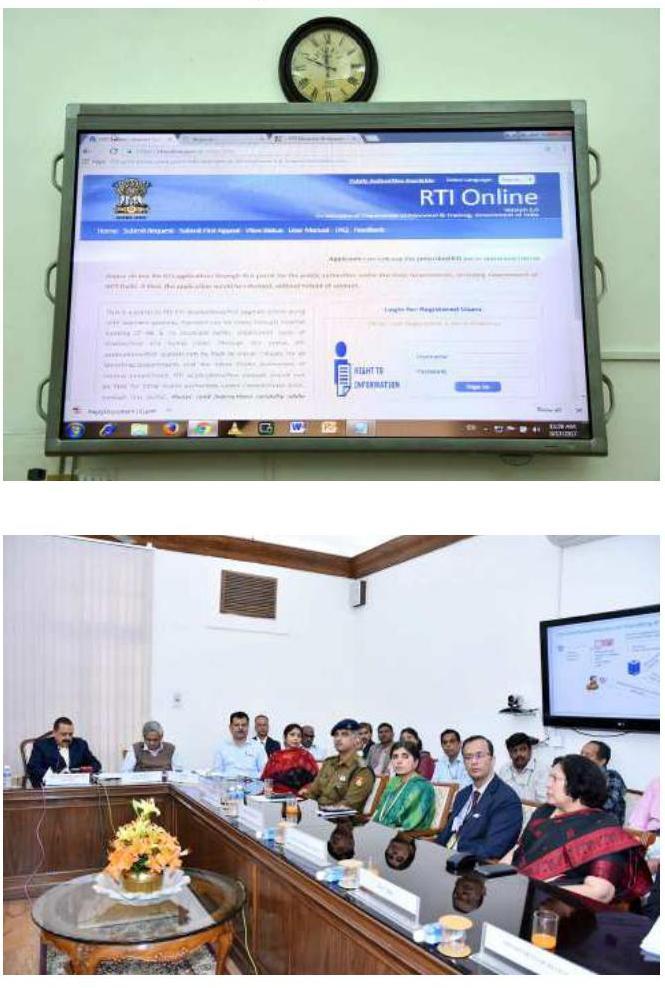
Launch of e-booklet of DoP&T
2.28 Press Conference by MoS (PP) was held on 23.05.2017 at National Media Centre, New Delhi on three years initiatives of the Government. On this occasion, e-Booklet of DoPT was also launched by MoS (PP) which is available at web link http://persmin.gov.in/ ebook/index.html
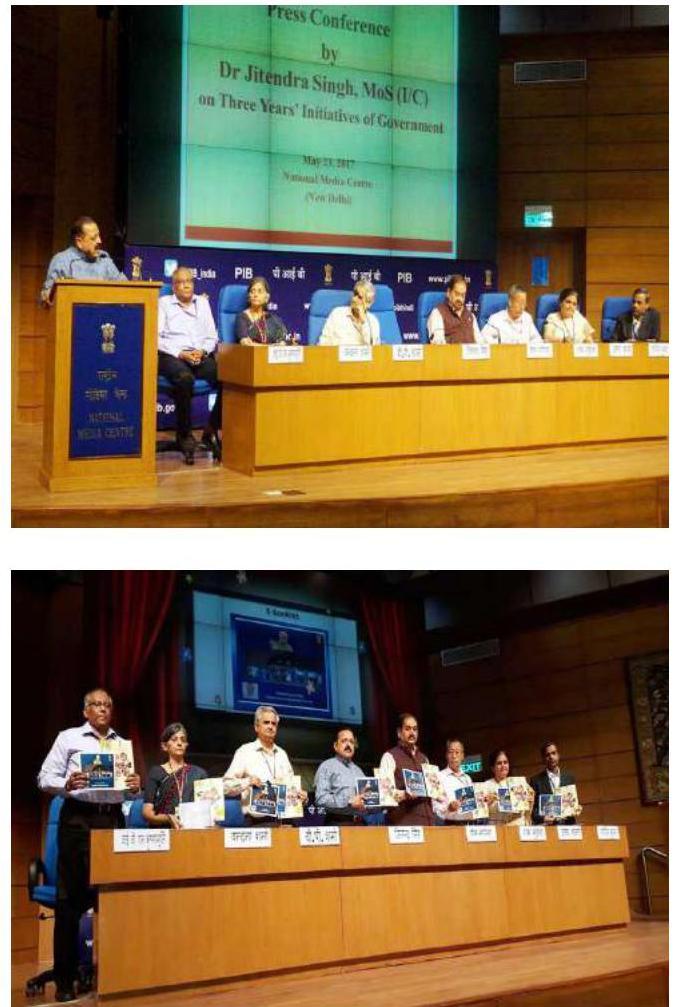
Interaction and felicitation of Civil Services Examination, 2016 achievers
2.29 Interaction and felicitation of Civil Services Examination, 2016 achievers by Hon’ble MoS (PP) was held on 02.06.2017 at North Block, New Delhi.
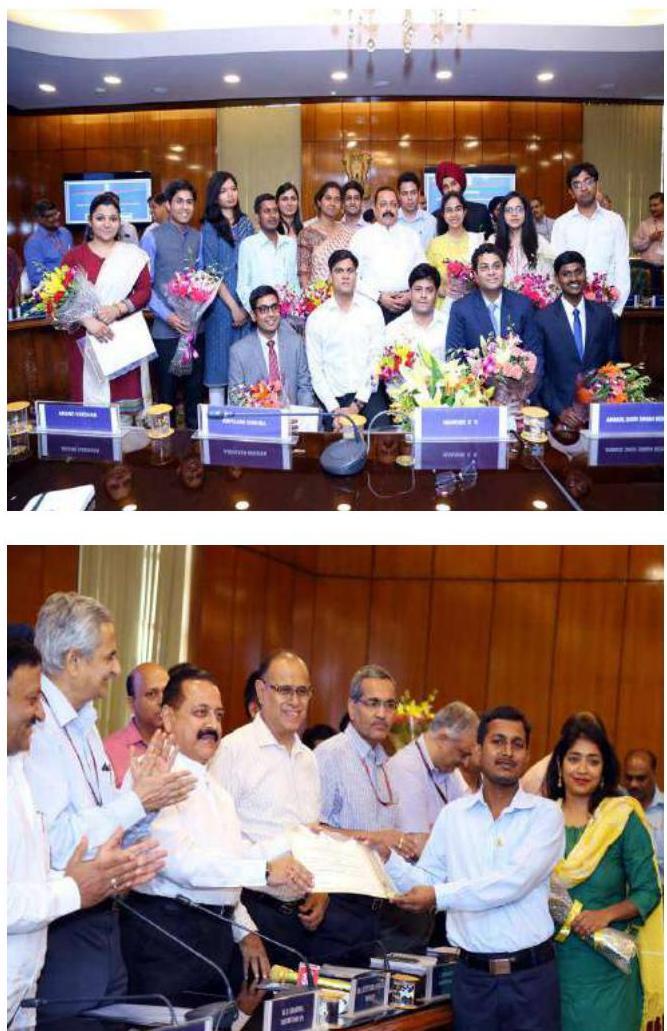
Interaction of Prime Minister with Officer Trainees at LBSNAA
2.30 The Prime Minister, Shri Narendra Modi, visited the Lal Bahadur Shastri National Academy of Administration (LBSNAA), Mussoorie, Uttarakhand on 2627 October, 2017 and interacted with over 360 Officer Trainees of the $92^{\text {nd }}$ Foundation Course. A variety of subjects such as administration, governance, technology and policy-making came up for discussion. Cabinet Secretary, Shri P.K. Sinha, and Director, LBSNAA, Smt. Upma Chawdhry were present during the interactions.
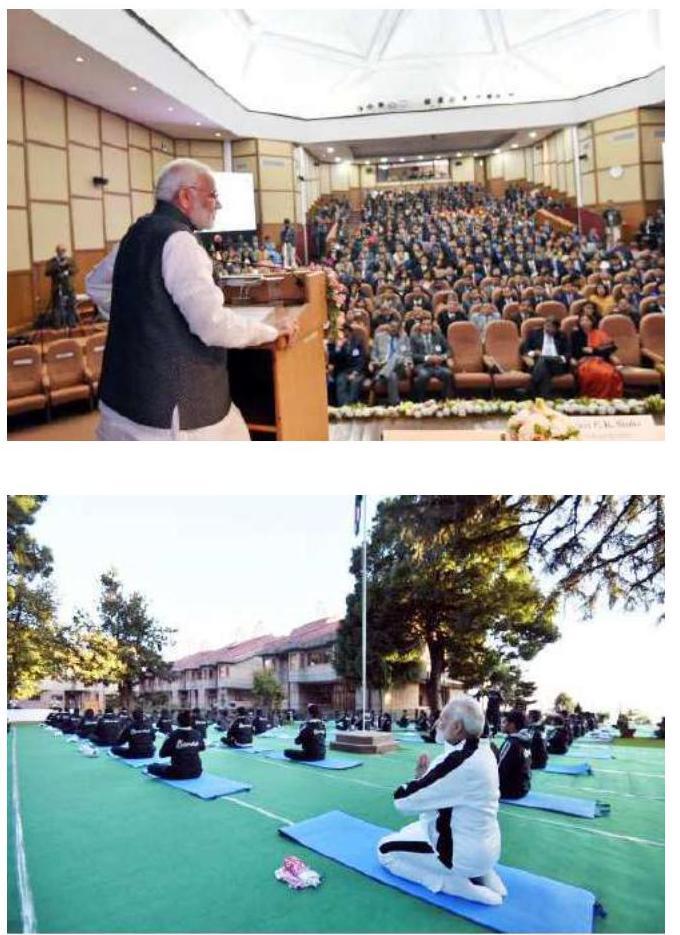
Pledge for New India Movement
2.31 On $75^{\text {th }}$ anniversary of Quit India Movement, Dr. Jitendra Singh, MoS (PP) administered pledge for New India Movement in DoPT. Sh. Devesh Chaturvedi, Joint Secretary, DoP&T and Sh. Akshay Rout, OSD, M/o DWS made presentations on “Anticorruption Measures Undertaken by DoP\&T” and “Swachha Bharat” respectively on this occasion.
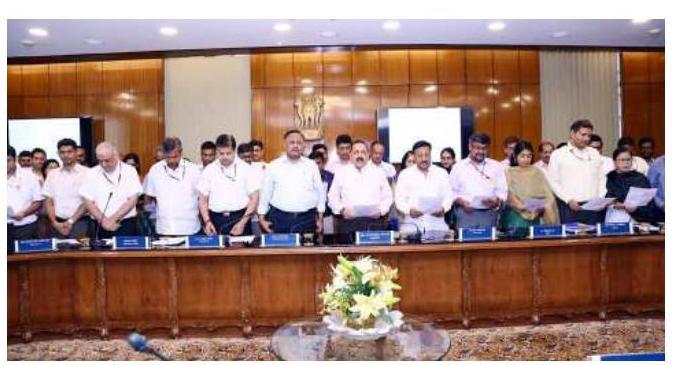
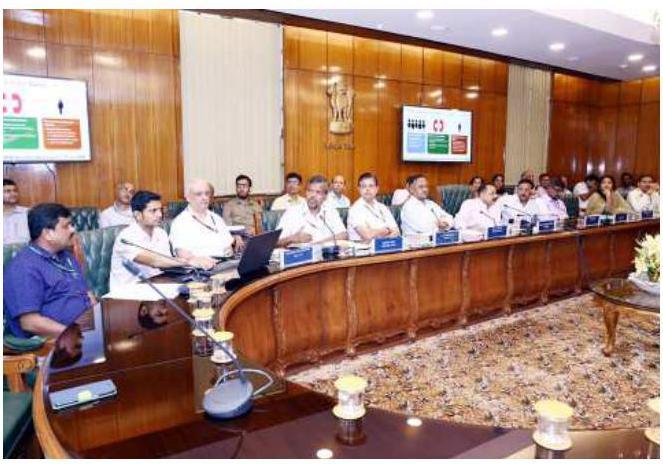
Celebration of International Women’s Day
2.32 Ministry of Personnel, Public Grievances \& Pensions celebrated International Women’s Day on $8^{\text {th }}$ March, 2017. Hon’ble MoS (PP) graced the occasion. Smt. Santosh Yadav, Indian Mountaineer to climb Mount Everest twice was the chief guest. Women employees of Ministry of Personnel, Public Grievances and Pensions actively participated in the event. Special awareness sessions on “Prevention of Breast Cancer” and “Stress Management” were also organized. Awards were given to the successful participants of “Slogan Writing Competition” and “Poster Making Competition” held on the eve of International Women’s Day.
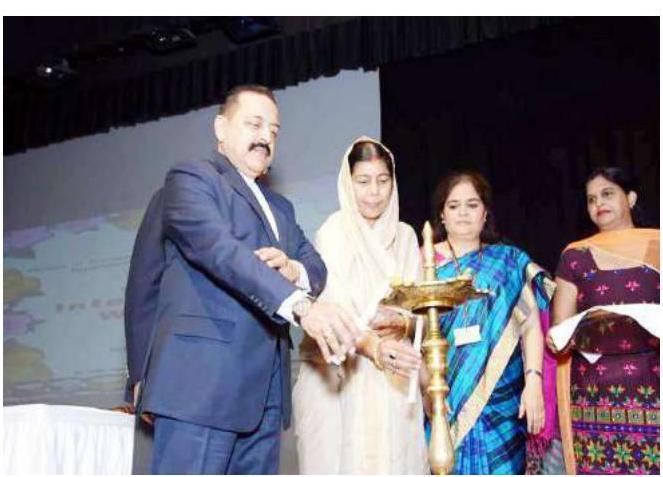
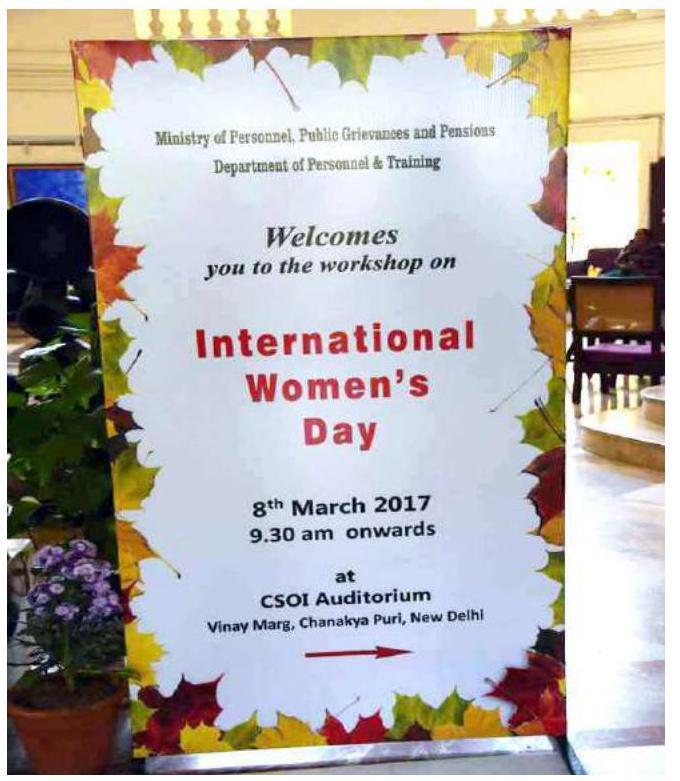
Swachhata Pakhwada
2.33 DOP&T undertook “Swachhata Hi Sewa” campaign during $16^{\text {th }}$ to $30^{\text {th }}$ June, 2017 and $15^{\text {th }}$ September, 2017 to $2^{\text {nd }}$ October, 2017 and carried out several cleanliness related activities.
2.34 On inaugural day, DoPT joined hands with New Delhi Municipal Corporation {NDMC} at Connaught Place, New Delhi. The cleanliness campaign was launched by Mr. Anil Baijal, Honourable Lieutenant Governor, Delhi and attended by many officials/ officers of DoPT and NDMC, Delhi Police, local shopkeepers and Brand Ambassador of NDMC, Ms. Deepa Malik, Para Olympiad. On this occasion, Honourable Lieutenant Governor administered Swachhta Hi Sewa pledge.
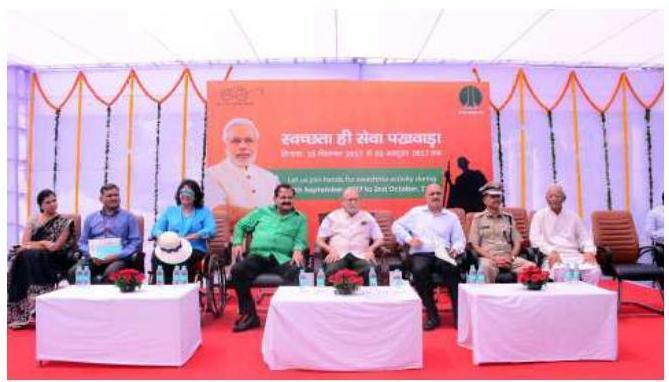
2.35 Further, as a part of “Swachhata Hi Sewa” Campaign officials/officers of this Department visited NP Co-ed Sr. Sec. School, Tilak Marg on 19.09.2017 to sensitise the children about “Swachhta” and also to clean the premises of the School. The children along with teachers of the school played two short “Nukkad Natak” on Swachhta. Thereafter, a pledge on Swachhta was taken and officials appended their signature on the pledge board to mark the event. Thereafter, officials of DoP\&T cleaned the premises of the school. At the end of the event there was an interactive session with the children of the School in which officer of this Department sensitized the children about hygiene and various Swachhta related issues. Children present on this occasion enthusiastically participated in the interactive session and cited self-composed poems in Hindi and English on Swachhta.
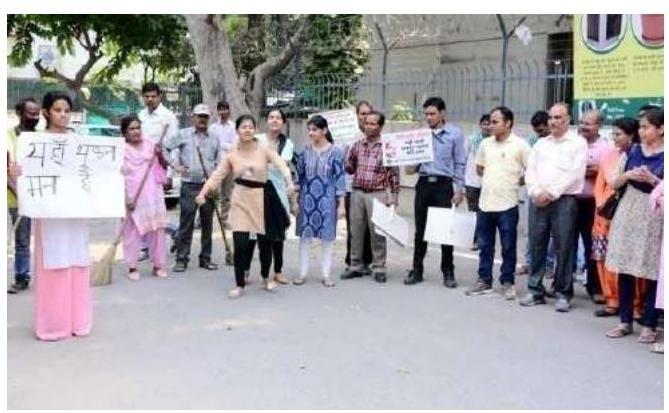
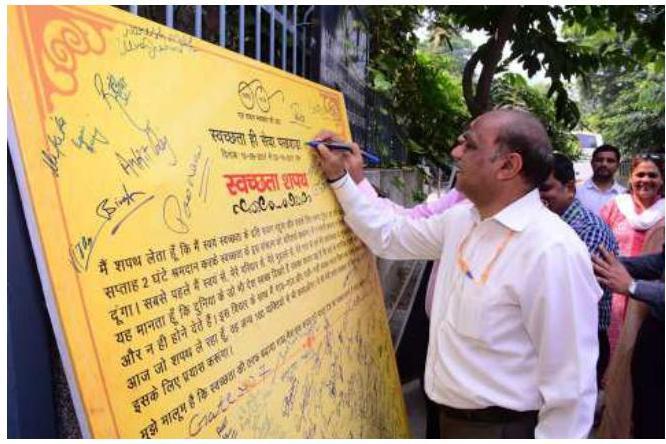
2.36 Tree plantation drive was undertaken at Sports Board Playground at CSOI, Vinay Marg, New Delhi on 27.09.2017. Officers and officials of this Department participated in the programme enthusiastically.
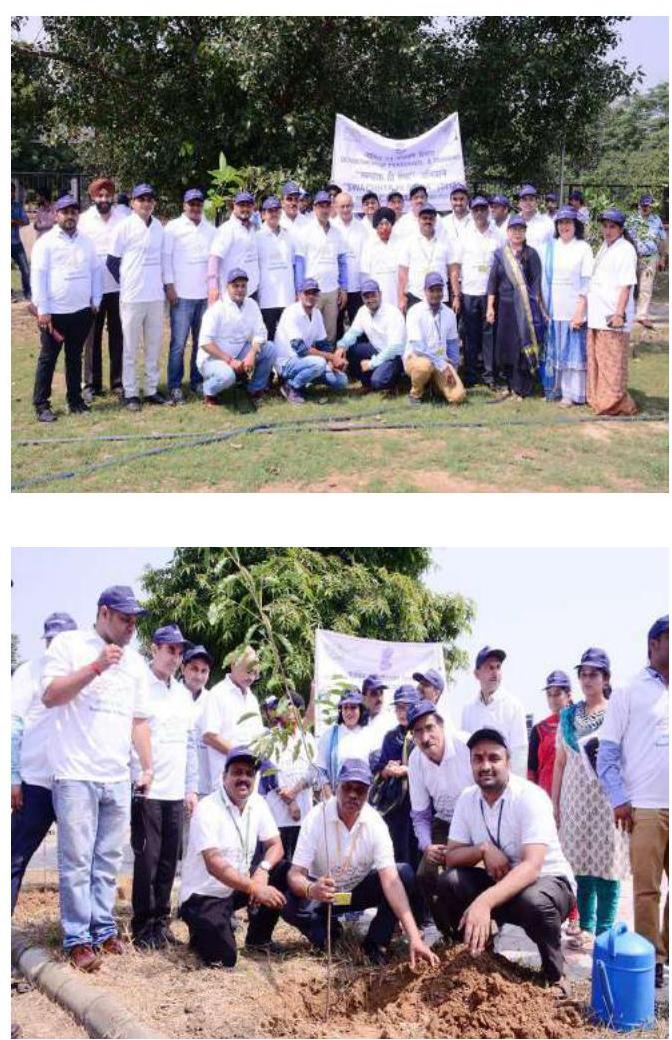
2.37 For better hygiene and convenience for female employees in North Block, Sanitary napkin vending / disposal machines were installed in the toilets of North Block.
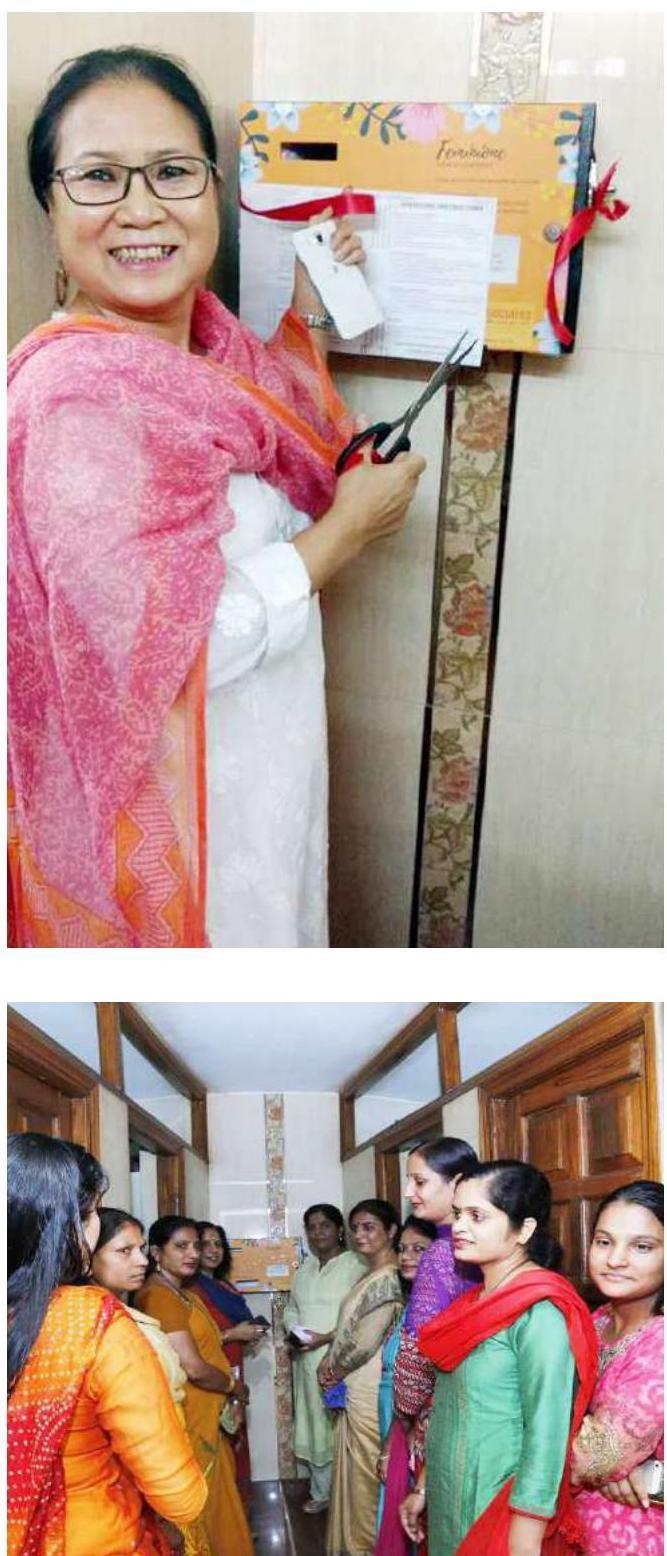
Civil Services Day and Prime Minister’s Awards Scheme for Excellence in Public Administration
2.38 Civil Services Day, 2017 was observed on 20-21st April, 2017 at Vigyan Bhavan, New Delhi. On Civil Services Day, i.e. on 21st April, 2017, the Hon’ble Prime Minister presented 12 awards of which 10 awards were given to the best performing districts in implementing Priority Programmes and 2 awards for Innovation Category.
2.39 During the function, panel discussions on ‘Creating value through Human Capital Management in Government’ and three Breakaway Sessions on ‘Agriculture’, ‘Energy’ and ‘Skill Development and Entrepreneurship’ were organized. Inputs on the theme ‘Creating value through Human Capital Management in Government’ were taken from 533 District Collectors and these were crystallized in form of a discussion paper for the panel discussion.
2.40 Another new feature of CSD 2017 programme was that 55 shortlisted initiatives were made available online and shared with IAS batches of 2013-16. The objective was to make them imbibe learning from these case studies and to encourage them to introspect and further expedite and innovate on these schemes and programmes. 615 young officers undertook a questionnaire based on these case studies and provided their perspectives and suggestions. These were also shared in the breakaway sessions on Agriculture, Energy and Skill & Entrepreneurship.
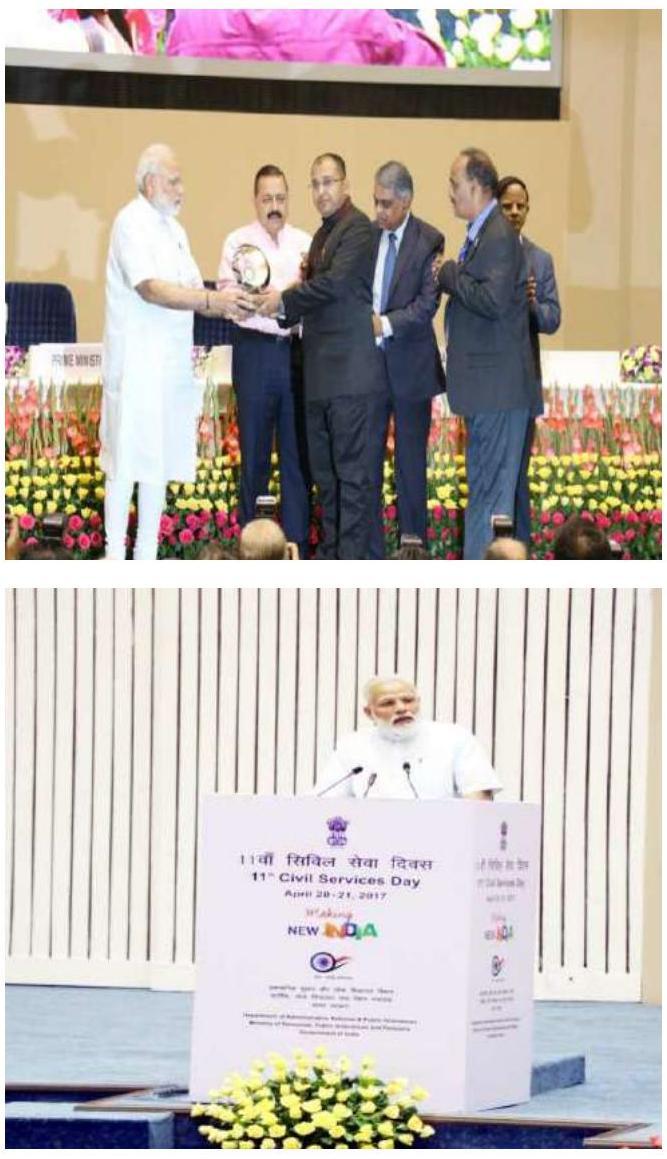
Jeevan Pramaan
2.41 An Aadhar based scheme for online submission of digital life certificate was launched by the Hon’ble Prime Minister in November, 2014. The scheme benefits pensioners specially the old and infirm who can submit life certificate from the comfort of their homes anywhere in the country or abroad. 11 lakh pensioners availed this facility through banks from $1^{\text {st }}$ November, 2017 to $30^{\text {th }}$ November, 2017. The efforts made by the Department towards this endeavour include:-
(i) Meetings with Banks, Department of Posts and CPAO.
(ii) Publicity through audio, visual and print media to reach out to the pensioners.
2.41.1 Till date about $93 %$ of the pension bank accounts of Central Government pensioners drawing pension through banks have been seeded with Aadhaar Numbers.
12 th Annual Convention on ‘Right to Information’
2.42 The Central Information Commission (CIC) organised its $12^{\text {th }}$ Annual Convention on ‘Right to Information’ on December 06, 2017 at Vigyan Bhawan. The Vice President Shri M. Venkaiah Naidu inaugurated the Convention and delivered the inaugural address at the
Annual Convention. The Convention is held to commemorate the inception of the Right to Information Act, 2005 and takes stock of the implementation of the Right to Information (RTI) Act around the country. The Convention is attended by all State Information Commissions besides stakeholders from all across the country. This year the Convention follows two seminars held in May and July this year, to discuss ‘Implementation of the RTI Act, 2005’ and ‘Land Records and RTI Act’ respectively. The CIC invited well researched original presentations, including case studies from academicians, practitioners, researchers, NGOs/civil society groups, students and other stakeholders to cover three subjects namely ‘Suo-motu disclosures’, ‘Record Keeping’ and ‘Emerging issues in implementation of RTI Act’ for the Convention.
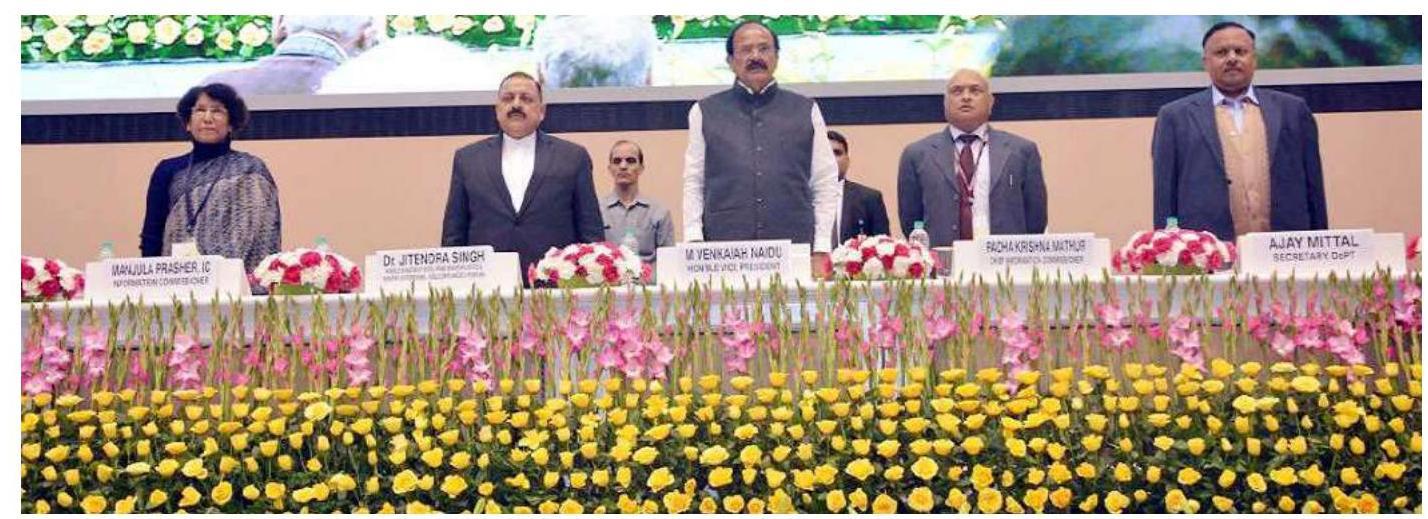
Blood Donation Camps
2.43 InordertoinculcateemployeesofCentral Government for participation in Citizen Centric activities, this Department has been organizing Blood Donation Camps in association with the Indian Red Cross Society, New Delhi on monthly basis since June 2015 in all major buildings
where Government offices are situated. Blood Donation Camp was also organised by DOP&T at North Block, New Delhi on 21.06.2017. In the year 2017 (as on 01.01.2018), 09 Camps have been organized at various locations and 639 units of blood have been collected.
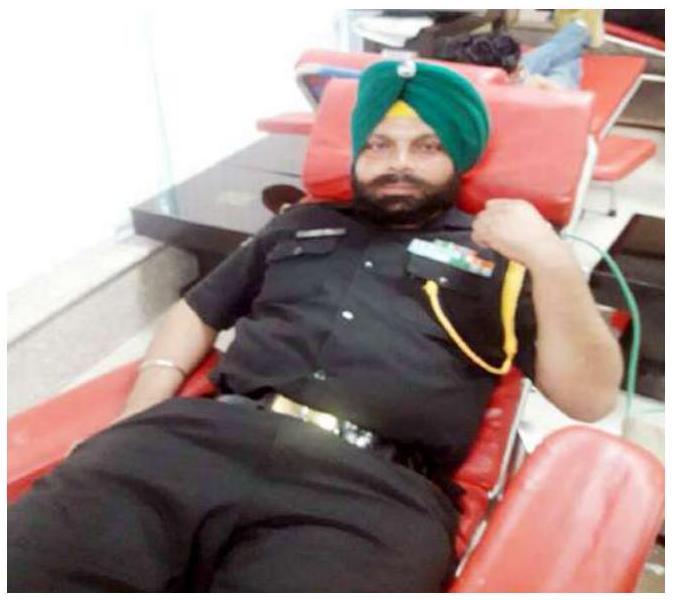
Celebration of $3^{\text {rd }}$ International Yoga Day
2.44 On the occasion of $3^{\text {rd }}$ International Day of Yoga on 21.06.2017, 250 Yoga Sadhaks from Grih Kalyan Kendra participated in the Yoga Session at Connaught Place, Lodhi Garden and Talkatora Stadium organized
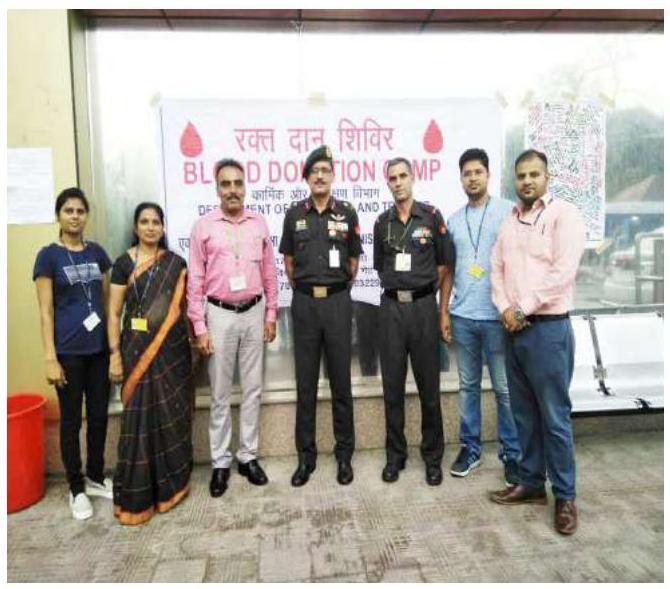
by Ministry of AYUSH. Besides, about 750 Yoga Sadhaks performed Yoga Sessions at their respective Samaj Sadans of Grih Kalyan Kendra in Delhi, Dehradun, Nagpur, Mumbai, Bangalore, Kolkata and Chennai on this occasion. The officials from DoPT performed Yoga in front of North Block on that day.
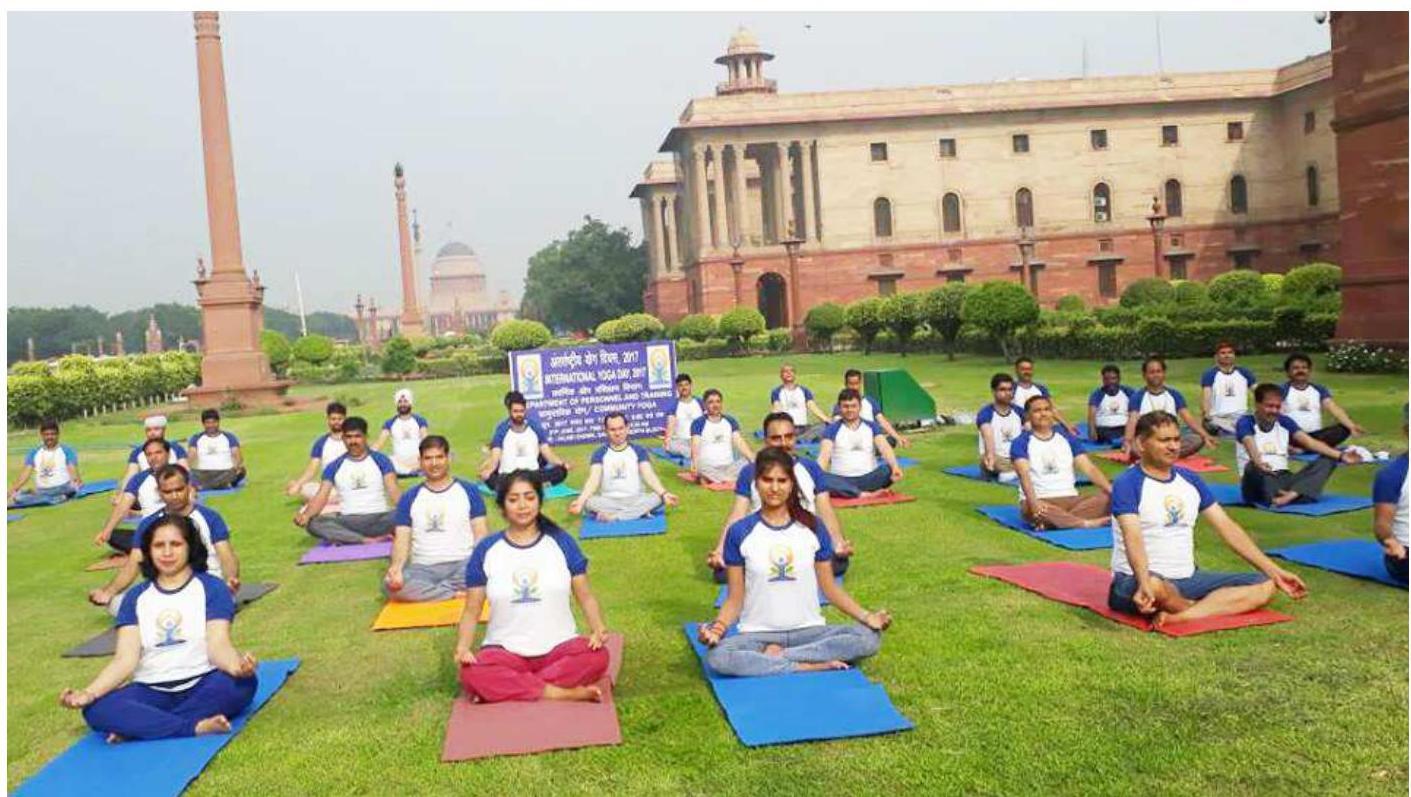
In-House Training Programme
2.45 With a view to build the capacity of employees, a weekly One Hour Training for the officials of DoPT from LDC to Director Level on various topics was started w.e.f. 09.10.2014. Weekly training also includes training of official of CSSS upto the rank of PPS. So far eight (8) modules viz. Filing System, Noting and Drafting, Gender Sensitization, Litigation Management (Handling of Court and CAT Cases), Preventive Vigilance, Ethics and Values, Records Management and Financial Management (Financial Propriety, issuing sanctions, role of Head of Office, role of Head of Department) were completed. Ninth module on ‘Report writing (not APAR)’ was started from 23.08.2017.
Hindi Salahakar Samiti
2.46 This is a high committee consisting of 30 members. The Hindi Salahakar Samiti of this Ministry was reconstituted on 13.04.2014 after the constitution of 16th Lok Sabha. The eleventh meeting of the committee was held in New Delhi under the chairmanship of Hon’ble Minister of State (PP) on $8^{\text {th }}$ May, 2017 in which progressive use of Hindi in official work of the Ministry was reviewed.
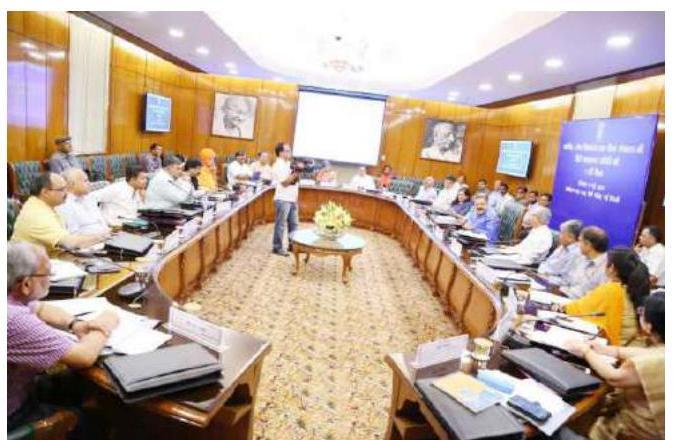
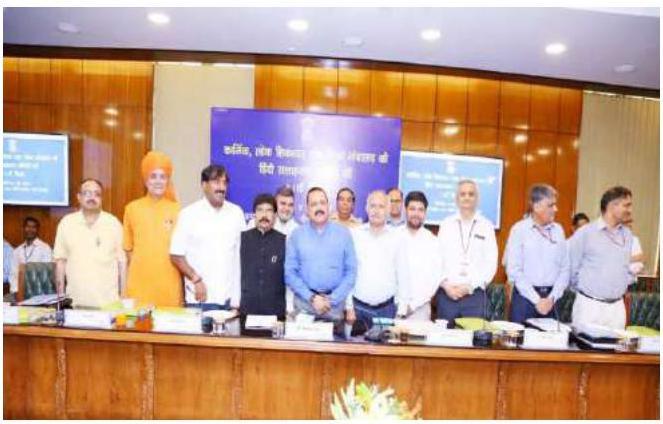
$3^{\text {rd }}$ Cadre Review Committee of Central Secretariat Service (CSS)
2.47 Based on the recommendation of $3^{\text {rd }}$ Cadre Review Committee of Central Secretariat Service (CSS), Government has approved the creation of 150 posts in Deputy Secretary grade-75 posts each for Central Secretariat Service (CSS) and Central Staffing Schme (Cst.S), 232 posts in Under Secretary and 463 posts in Section Officer Grades in CSS. Accordingly, all Cadre Units of CSS were requested to submit proposals for creation/ allocation of posts with full justification in these three grades. The proposals are still awaited from some Ministries/Departments. On receipt of the same, the matter will be examined by the Committee comprising of Joint Secretaries of DoPT and Department of Expenditure. Based on the recommendation of the Committee, further action will be taken by this Department for the opertionalization/ allocation of the posts amongst the Cadre Units.
$3^{\text {rd }}$ Cadre Review Committee of Central Secretariat Stenographer’s Service (CSSS)
2.48 Based on the recommendation of $3^{\text {rd }}$ Cadre Review Committee of Central
Secretariat Stenographer’s Service (CSSS), Government has approved the creation of 247 posts of Sr. PPS/PSO, 549 posts of PPS and 204 posts Stenographers Gr. D and reduction of 1000 posts in the grade of Personal Assistant (PA) subject to certain conditions. Accordingly, all Cadre Units of CSSS have been requested to submit proposal for creation/allocation of posts with full justification in these grades. On receipt of the complete information from all the cadre units, the matter will be examined by a designated committee for allocation of posts among cadre units. Based on the recommendation of the Committee, further action will be taken by this Department for the opertionalization/allocation of the posts amongst the Cadre Units.
Personnel Policies
- Matters relating to framing and amendment of recruitment rules/ service rules for Group “A” and “B” posts
- Framing of policy relating to the procedure for Departmental Promotion Committee(s)
- Policy on seniority
- General policy matters relating to:-
(a) Flexible complementing scheme,
(b) Modified Assured Career Progression Scheme,
(c) Leave travel concession,
(d) Deputation,
(e) Child care leave,
(f) Pay & allowances,
(g) Holiday policy,
(h) Age relaxation and
(i) Other matters concerning service conditions. - Administration of UPSC and SSC including exams except the Civil Service Examination
- Policy matters of PESB
- Policy on Character verification before appointment
- Disagreement cases with UPSC from various Ministries except on appointment cases
- UPSC (Exemption from Consultation) Regulations
- Policy on APAR.
- Commercial employment after retirement
- Policy on
(a) Retirement, extension, reemployment,
(b) Posting and transfers, Conduct and CCA Rules,
(c) Sealed Cover procedure,
(d) Status of Women in Central Government,
(e) Temporary Service Rules, Etc.
(f) Lien, Probation, Confirmation
(g) Daily Wage Casual Labourers
Journey to Headquarters on LTC in respect of dependent family members of the Government servant.
3.0 As per the extant LTC Rule provisions, Government servant and the members of the family may claim LTC independently, however, reimbursement in such cases is restricted to the actual distance travelled by the family or
the distance between the headquarters/place of posting of the Government servant and the place visited/hometown, whichever is less. Restriction of reimbursement to the distance from the Headquarter/place of posting creates an anomalous situation where the Government servant seeks to avail of LTC in respect of members of the family to the Headquarters/
place of posting either from the Home town of the Government servant or from anywhere else.
3.1 To resolve the issue, the matter was considered by the Government in consultation with Joint Consultative Machinery – Staff side. It has been decided that full reimbursement as per the entitlement of the Government servant shall be allowed for journey(s) performed on LTC by the family members from any place in India to Headquarters/place of posting of the Government servant and back. When such journey is performed from the Home Town, the LTC shall be counted against ‘Home Town’ LTC and in case the journey is from any other place in India, then it shall be counted against ‘Any place in India’ LTC.
(Reference DoPT’s O.M. No. 31011/5/2015-Estt.A-IV dated 31.10.2017)
Extension of probation period on account of availing Leave.
3.2 As per extant instructions on Probation/ Confirmation in Central Services “if during the period of probation, a probationer has not undergone the requisite training course, the period of probation may be extended by such period or periods as may be necessary, subject to the condition that the total period of probation does not exceed double the prescribed period of probation.”
3.3 This has been examined in the view that some employees are not able to complete the probation on account of availing leave for long duration during probation period.
It has been decided that in such cases if any employee does not complete $75 %$ of the total duration prescribed for probation on account of availing any kind of leave as permissible to a probationer under the Rules, his/ her probation period may be extended by the length of the Leave availed, but not exceeding double the prescribed period of probation.
(Reference DoPT’s O.M. No. 28020/1/2017Estt (C) dated 09.10.2017)
Instruction on sealed cover procedurewhere Government servant has been acquitted but appeal is contemplated/ pending- clarification regarding.
3.4 References were received seeking clarification with regard to the course of action in cases where the government servant is acquitted by trial court but an appeal against the judgement is either contemplated or has been filed. This issue was considered in the light of various court judgments including Bank of India and another vs. Degala Suryanarayana, Appeal (Civil ) 3053-54 of 1997, (1999) 5 SCC 762 in consultation with Department of Legal Affairs and it is clarified as following:-
i) Where the recommendation of DPC has been kept in sealed cover solely on account of pendency of the criminal case, the sealed cover may be opened in case of acquittal of the government servant provided it has not been stayed by a superior court.
ii) In the order of promotion a mention may however be made that the promotion is provisional subject to the outcome
of appeal that may be filed against the acquittal of the Government servant. The promotion thus will be without prejudice to the action that may be taken if the judgment of the trial court acquitting the government servant is set-aside.
iii) In case on appeal the government servant stands convicted, following action will be taken:-
a) The provisional promotion shall be deemed non est, and the Government servant shall stand reverted;
b) In case of the Government servant being sentenced to imprisonment exceeding 48 hours, he will be deemed to be under suspension in terms of rule10(2)(b) from the date of conviction;
c) Action under rule 19(i) of the CCS(CCA) Rules, 1965, read with OM NO. 11012/11/85-Estt(A) dated the $11^{\text {th }}$ November, 1985 and $4^{\text {th }}$ April, 1986 shall be taken.
(Reference DoPT’s O.M. No. 11012/6/2016Estt (A-III) dated 19.01.2017)
Amendment to Rule 6 of Central Civil Services (Classification, Control and Appeal) Rules, 1965 for classification of Civil posts
3.5 Notification S.O. 3578(E) dated 9.11.2017:- Under Rule 6 of the CCS(CCA)
Rules, all civil posts except persons serving in the Indian Audit and Accounts Department under the Union shall be classified as follows:-
| S. No. |
Description of Posts | Classification of Posts |
|---|---|---|
| (1) | (2) | (3) |
| 1 | A Central Civil Post carrying the pay in the Pay Matrix at the Level from 10 to 18 |
Group A |
| 2 | A Central Civil Post carrying the pay Matrix at the Level from 6 to 9 |
Group B |
| 3. | A Central Civil Post carrying the pay in the Pay Matrix at the Level from 1 to 5. |
Group C |
(Reference Gazette Notification S.O. 3578(E) dated 09.11.2017)
Online complaint management system titled “Sexual Harassment electronicBox (SHe-Box)” regarding:-
3.6 The features of Sexual Harassment electronic Box (SHe-Box), an online complaint management system, launched by M/o Women and Child Development have been highlighted and also stressed that the complaint registered in the She-Box contains only a brief description of the incident of sexual harassment at workplace. The Internal Complaints Committee (ICC) is required to initiate inquiry as prescribed under Section 11 of the Sexual Harassment of Women at Workplace (Prevention, Prohibition and
Redressal) Act, 2013 read with Department of Personnel & Training’s O.M. No.11013/2/2014Estt.(A-III) dated $16^{\text {th }}$ July, 2015 by calling upon the complainant to provide detailed complaint along with all the relevant evidences.
(Reference DoPT’s O.M. No. 11013/7/2016Estt (A-III) dated 01.11.2017)
Amendment in Central Civil Services (Classification, Control and Appeal) Rules, 1965 for introducing stringent
| S. No. | Subject | Time line |
|---|---|---|
| 1. | Time line for written statement of defence by CO on charge-sheet |
15 days Can be extended by 15 days at a time, maximum upto 45 days. |
| 2. | Time line for producing requisite document claimed by CO. |
01 Month |
| 3. | Time line for conducting inquiry by Inquiring officer. |
06 Months Can be extended by period not exceeding 06 months at a time. |
| 4. | Time line on written representation by the CO on advice of the UPSC |
15 days |
(Reference Gazette Notification G.S.R.548(E) dated 02.06.2017)
Establishment (Allowances) Section
3.9 Establishment (Allowances) Section issued a number of instructions implementing therecommendations of theSeventh CentralPay Commission as accepted by the Government. Instructions have been issued enhancing the Children Education allowance to Rs. 2250/-per month and that of Hostel Subsidy to Rs. 6750/per month vide O.M No. A-27012/02/2017Estt. (AL) dated 16/08/2017. Implementation of decision relating to the grant of Children
timeline for completing Disciplinary proceeding in time bound manner.
3.7 Central Civil Services (Classification, Control and Appeal) Rules, 1965 has been amended vide Gazette Notification No. 548 (E) dated 2.06.2017 for introducing stringent timeline for completing disciplinary proceeding in a time bound manner.
3.8 Through the aforesaid Notification, following timelines have been incorporated in the aforesaid Rules.
Time line
15 days
Can be extended by 15 days at a time, maximum upto 45 days.
01 Month
06 Months
Can be extended by period not exceeding 06 months at a time.
15 days
Education Allowance for differently abled children of Government employees which will be payable at double the normal rates prescribed. Instructions were issued to this effect vide O.M. No. A-27012/02/2017-Estt. (AL) dated 31/10/2017. Instructions were also issued vide O.M No A-27012/03/2017-Esst. (AL) dated 16/08/2017 implementing the recommendations of the 7th CPC relating to Special Allowance for Child Care for Women with Disabilities. Women with disabilities shall be paid Rs. 3000/- per month as Special Allowance for Child Care. The allowance shall be payable from the time of the child’s
birth till the child is two years old. Desk Allowance has been abolished vide O.M No. A-27023/01/2017-Estt (AL) dated 16/08/2017 on the basis of recommendations of the $7^{\text {th }}$ CPC.
Establishment (Leave) Section
3.10 Establishment (Leave) Sections has incorporated a new rule in the CCS (Leave) Rules, 1972, consequent to the enactment of the ‘Sexual Harassment of women at Workplace (Prevention, Prohibition and Redressal) Act, 2013. As per the newly notified rule, leave up to a maximum of 90 days may be granted to an aggrieved female Government Servant during the pendency of inquiry under the said Act. Further, instructions were issued to all Ministries/Departments that leave encashment to re-employed pensioners may be capped at 300 days including the period for which encashment was allowed at the time of retirement.
Establishment (Pay) Section
Fixation of pay of State Government Employees on their appointment in Central Government, subsequent to the implementation of CCS (RP) Rules, 2016: OM No. 12/2/2016-Estt.(Pay-I) dated 11/05/2017.
3.11 This Department vide OM dated 11.05.2017 has issued guidelines for fixation of pay of State Government employees on their appointment in Central Government, subsequent of implementation of CCS (RP) Rules, 2016.
Availability of option for fixation of pay on promotion from the Date of Next Increment (DNI) in the lower post and method of fixation of pay from DNI, if opted for, in context of CCS (RP) Rules, 2016: OM No. 13/02/2017-Estt.(Pay-I) dated 27/07/2017.
3.12 Since the issue of availability of option for fixation of pay on promotion from the Date of Next Increment (DNI) in the lower post and method of fixation of pay from DNI, if opted for, was not covered under the CCS (RP) Rules, 2016, the same was clarified vide this Department’s OM dated 27.07.20 17.
Guidelines for fixation of pay of candidates working in Public Sector Undertakings etc., recommended for appointment by method of recruitment by selection: OM No. 12/3/2017-Estt.(Pay-I) dated 28/07/20 17.
3.13 By partially modifying this Department’s OM No.12/1/88-Estt.(Pay-I) dated 07.08.1989, O.M. No. 12/1/96-Estt. (Pay-I) dated 10.07.1998 and O.M. No.12/3/2009-Pay-I dated 30.03.2010, the method of pay fixation in respect of those working in Public Sector Undertakings etc., recommended for appointment by method of recruitment by selection through interview by a properly constituted agency including Departmental Authorities on or after 01.01.2016 has been described in OM No. 12/3/2017-Estt.(Pay-I) dated 28/07/20 17.
OM No. 2/11/2017-Estt.(Pay-II) dated 24.11.2017 Grant of Deputation (Duty) Allowance – Recommendations of the Seventh Central Pay Commission
3.14 In pursuance of recommendation of $7^{\text {th }}$ CPC the rates of Deputation (Duty) Allowance has been revised w.e.f $1^{\text {st }}$ July, 2017 to 5 percent of basic pay subject to a maximum of Rs. 4500/- p.m within same station and at the rate of 10 percent of basic pay subject to Rs. 9000/- p.m in case of deputations involving change of stations subject to the conditions mentioned in the O.M.
Headquarters Allowance OM No. 2/12/2017-Estt.(Pay-II) dated 14.09.2017 (Discontinuation of Headquarter Allowance in pursuance of recommendation of $7^{\text {th }} \mathbf{C P C}$ )
3.15 In pursuance of the recommendation of $7^{\text {th }} \mathrm{CPC}$, the payment of Headquarters Allowance to the officers of the organized Group ‘A’ services on their posting in their respective Headquarters has been discontinued w.e.f $1^{\text {st }}$ July, 2017.
OM No. 3/3/2016-Estt.(Pay-II) dated 1.5.2017 (Applicability of CCS (RP) Rules, 2016 to persons re-employed in Govt. Service after retirement and whose pay and allowances are debitable to Civil Estimates. )
3.16 The provisions of CCS (RP) Rules, 2016 have been made applicable to persons re-employed in Government service after retirement and whose pay is debitable to Civil
Estimates vide OM dated 1.5.2017 subject to the conditions mentioned therein. The existing ceiling of Rs. 80,000/- for drawal of pay plus gross pension on re-employment has been enhanced to Rs. 2,25,000/-, the maximum salary payable to the Secretary to the Government of India under Central Civil Services ( Revised Pay) Rules, 2016.
OM No. 3/4/2016-Estt.(Pay-II) dated 30.5.2017 (Revision of Pay of the Chairpersons and Members of the Regulatory Authorities/Bodiesconsequent to the implementation of the 7th Central Pay Commission recommendations)
3.17 In pursuance of recommendations of $7^{\text {th }}$ CPC vide OM No. 3/4/2016-Estt.(Pay-II) dated 30.05.2017, pay of the Chairpersons and Members of the Regulatory Authorities / Bodies has been revised consequent to the implementation of $7^{\text {th }} \mathrm{CPC}$ recommendations.
Gazette Notification No.4/2/2016-Estt. (Pay-II) dated 12 th June, 2017 ( GSR 213) Revision of ceiling for aggregate of pay and additional pay under FR 49 in pursuance of $7^{\text {th }} \mathbf{C P C}$ recommendations.
3.18 In pursuance of recommendation of $7^{\text {th }}$ Central Pay Commission, ceiling for aggregate of pay and additional pay under FR 49 (iv) has been revised from Rs. 80,000/- to Rs. 2,25,000/- ( admissible to the Secretary to the Government of India), from the $1^{\text {st }}$ day of January, 2016.
Establishment (RR) Section
3.19 The Recruitment Rules Formulation, Amendment Monitoring System (RRFAMS)
Portal has been under implementation since 25.12.2016. The system facilitates online examination and approval of DoPT to proposals relating to framing/amendment of Recruitment Rules.
3.20 With the introduction of new system, the processing of proposals regarding finalizing of recruitment rules on the physical file has been discontinued. The online system provides error free, more user friendly, responsive, efficient and interactive environment which facilitates quick disposal of the proposals relating to amendment/framing of recruitment rules. In the online system of examination and approval of recruitment rules, 655 RRs have been processed, out of this, 148 RRs have been approved by DoPT as on 18.01.2018.
Establishment D Section
(i) Procedure to be observed by the Departmental Promotion Committees (DPCS)-Model Calendar for DPCS-Relevant year up to which APARs are to be considered and model calendar for conducting DPCS.
3.21 In order to ensure that Departmental Promotion Committee (DPC) meetings are convened in advance and approved select panels are ready on the date of commencement of the relevant vacancy year, there was a need to synergise/ to evolve a practical model calendar for DPCs after the issue of guidelines regarding time schedule for completion of APAR. Accordingly, a fresh model calendar for DPCs has been finalised vide OM No. 22011/4/2013-Estt(D) dated $8^{\text {th }}$ May 2017 and following have been decided in order to
streamline the process of timely convening of DPCs:-
i. The vacancy year may be shifted to Calendar Year from the year 2018 onwards, wherever the financial year based vacancy year being followed now.
ii. The crucial date of eligibility will be $1^{\text {st }}$ of January of the Vacancy year w.e.f 2019.
iii. The APARs for five years preceding T-2 nd year may be taken as reckoning APARs, i.e. for the vacancy year 2019 (January 2019 to December, 2019), the reckoning APARs shall be 201617, 2015-16, 2014-15, 2013-14 and 2012-13.
iv. The year of 2018 being the transitional year, the vacancy period shall be from $1^{\text {st }}$ April 2018 to $31^{\text {st }}$ December, 2018. The reckoning APARs for this vacancy year shall be 2015-16, 2014-15, 201314, 2012-13, and 2011-12. The crucial date of eligibility shall be $1^{\text {st }}$ April, 2018 for the transitional year.
(ii) Modification in Para 4 of Annexure-I of Modified Assured Career Progression Scheme issued vide OM No. 35034/3/2008Esst.(D) Dated 19.05.2009
3.22 On receipt of references from several Ministries/Departments to allow the employee to draw the difference in Grade Pay after availing regular increment in the Pay Band and Grade Pay w.e.f. date of promotion or date of next increment consequent to MACP, it
has been decided vide this Department’s OM No. 35034/3/2008-Estt(D)(Vol.II) dated $4^{\text {th }}$ July 2017 to modify Para 4 of Annexure-I of MACP Scheme as under:-
3.23 “Benefit of pay fixation available at the time of regular promotion shall also be allowed at the time of financial upgradation under the Scheme. Therefore, the pay shall be raised by $3 %$ of the total pay in the pay band and the grade pay drawn before such upgradation. There shall, however, be no further fixation of pay at the time of regular promotion / grant of Non-Functional Scale, if it is in the same grade pay as granted under MACPS. However, at the time of actual promotion / grant of Non-Functional Scale, if it happens to be in a post carrying higher grade pay than what is available under MACPS, no pay fixation would be available and only difference of grade pay would be made available. At the time of such regular promotion/grant of Non-Functional Scale to the higher grade pay than what has been given under MACPS, the employee shall have the option to draw the difference of Grade Pays from the date of such regular promotion/grant of Non-Functional Scale or the date of accrual of next increment in the pay allowed under MACP”.
iii Fixation of the pay of the Pre-Revised Pay Scale of 1S Scale Granted to candidates appointed as trainees on Compassionate Grounds in the Seventh Central Pay Commission ( $7^{\text {Th }}$ CPC)
3.24 “The $7^{\text {th }} \mathrm{CPC}$ has not provided any replacement scale for 1S pay, band of Rs.44407440 without any grade pay which is granted
to trainees appointed under the scheme for compassionate appointment. The matter was taken up with the Department of Expenditure and it has now been decided by the Government vide OM No. 14014/2/2009-Estt.(D) dated $09^{\text {th }}$ October, 2017 that Level-1 of the Pay Matrix introduced on implementation of the $7^{\text {th }} \mathrm{CPC}$ Report be the replacement for the pre-revised1S scale. The pay of those governed by the 1S scale may be revised by using the Fitment Factor of 2.57 for placement in Level-1 in conformity with the Rule 7 of the CCS (RP) Rules, 2016. All pre revised pay stages lower than pre-revised pay of Rs.7,000 in the prerevised 1S scale shall not be considered for determining the benefit of bunching, on the same lines as has been clarified by Department of Expenditure’s OM dated 03.08.2017 on application of the benefit on account of bunching.
This will be effective from 01.01.2016.”
RECRUITMENT AGENCIES
3.25 The Union Public Service Commission (UPSC) and the Staff Selection Commission (SSC) are the two designated recruitment agencies administered by the Department of Personnel and Training. While the UPSC is a Constitutional body set up under Article 315 of the Constitution, the Staff Selection Commission has been set up by Resolution of the Government and it has the status of an attached office of the Department of Personnel and Training. Both these agencies enjoy the reputation for selecting candidates for the Government services in fair, objective and impartial manner. The candidates for the
various examinations come from a variety of social environment and having studied in different disciplines.
3.26 SET UP AND FUNCTIONS OF UNION PUBLIC SERVICE COMMISSION
3.26.1 The Union Public Service Commission comprises a Chairman and ten Members. The UPSC makes recruitment for All India Service, Group ‘A’ Central Civil Services /posts, and Group ‘B’ Gazetted posts in Ministries/ Departments of the Central Government. The Commission also conducts the examination for recruitment of Commissioned officers in the Defence Forces. Some Union Territories (UTs) also avail the services of the Union Public Service Commission for recruitment to the posts under the UT.
3.26.2 The functions of the Commission are as specified in Article 320 of the Constitution. By exercise of powers conferred by the proviso to Article 320 (3) of the Constitution, the President has made the UPSC (Exemption from Consultation) Regulations, 1958 as amended from time to time, as respects the All India Services and also as respects other services and posts in connection with the affairs of the Union specifying the matters in which it shall not be necessary for the UPSC to be consulted. The latest 67th Annual Report (2016-17) of the Union Public Service Commission for the year ending March, 2017 is yet to be placed on the Table of both the Houses of Parliament. The major activities of the Commission during the period 2016-17, as included in the above Annual Report are given below:-
3.26.3 Examination
- $\quad$ The Commission conducted a total of 14 examinations under the method of Recruitment by Examinations. Of these, 10 examinations for selection to Civil Services/Posts and 04 for Defence Services were conducted. For these examinations, a total of 34,71,693 applications were received and processed and 8,990 candidates interviewed for Civil Services/Posts. The interviews for Defence Services were conducted by Services Selection Board (SSB) of Ministry of Defence. A total of 4,612 [4,445+167(Reserve list)] candidates were recommended for appointment to various posts. A total of 3,244 candidates (including 167 candidates through Reserve List) were recommended for Civil Services/ Posts and 1,368 for Defence Services/ Posts.
- $\quad$ Of the 1,741 posts reserved for SC, ST and OBC candidates to be filled up under method of Recruitment by Examinations, the Commission recommended 1,729 SC, ST and OBC candidates. In addition, 12 reserved category candidates were recommended against unreserved posts.
- $\quad$ The scheme of Engineering Services Examination has been changed from the year 2017. The Examination which was previously held in two stages has now been split up into three stages viz. Preliminary/Stage-I examination,
Mains/Stage-II examination and StageIII (Personality Test). A merit list will be prepared based on the performance of the candidates in all the three stages of the Examination for recommendations.
- The syllabi of all the four disciplines of Engineering namely Civil Engineering, Mechanical Engineering, Electrical Engineering and Electronics & Telecommunication Engineering have also been revised and implemented with the new scheme introduced from the year 2017.
- A new pattern for Indian Statistical Services Examination was implemented for Indian Statistical Services Examination, 2016 as under:
| S.
No. | Subjects | Maximum
Marks | Time
Allowed
(in Hrs.) |
| — | — | — | — |
| 1. | General English | 100 | 3 |
| 2. | General Studies | 100 | 3 |
| 3. | Statistics-I
(Objective) | 200 | 2 |
| 4. | Statistics-II
(Objective) | 200 | 2 |
| 5. | Statistics-III
(Subjective) | 200 | 3 |
| 6. | Statistics- IV
(Subjective) | 200 | 3 |
- $\quad$ Statistics I \& II has been of Objective Type Questions (80 questions with maximum marks 200 in each paper) to be attempted in 120 minutes.
- $\quad$ Statistics III \& IV has been of Descriptive Type having short Answer/small Problems Questions (50%) and Long
Answer and Comprehension problem questions (50\%). At least one short answer and One Long Answer Question from each section is compulsory.
- $\quad$ The syllabus of Indian Statistical Services Examination has also been revised accordingly from the year 2016 in sync with the revised pattern of Examination.
- Under the method of Recruitment by Examination, the offer of appointment is made by the Ministry/Department concerned. A delay in the issues of offer of appointment was reported in 20 such cases.
- $\quad$ The Commission is of the firm view that the candidates recommended by it, should not be made to wait for receipt of the offers of appointment from the Ministries/ Departments concerned. In many cases, candidates selected by the Commission, in the meantime, secure placement elsewhere and do not become available for appointment under the Government, thus rendering the whole exercise of the selection of such candidates infructuous.
- $\quad$ Eleven cases of malpractices, committed by the candidates were reported to the Commission relating to suppression of information, submission of false information/fabricated documents, using unfair means and copying etc. The Commission took serious note of such cases and, after following due process, imposed penalties on the delinquent candidates, ranging
from cancellation of their candidature to their debarment from the future Examination/Selections, conducted by the Commission, for periods varying from five years to permanent debarment.
3.26.4 Direct Recruitment by Selection
- The Commission received 264 requisitions for 1,808 posts from various Ministries/ Departments. After adding the cases carried forward from the previous year, a total of 440 requisitions for 3,352 posts were processed during the year. Of these, 24 requisitions for 147 posts were deemed as closed for want of clarifications from the Ministries/Departments concerned, or withdrawn at the pre-advertisement stage by them.
- A total of 1,661 posts against 240 requisitions were advertised during the year and 7,42,679 applications were received. The recruitment process was cancelled in respect of 12 requisitions for 35 posts and modified in respect of 01 requisition, subsequent to the publications of advertisement.
- During the year, a total of 4, 55,255 applications were finalized including applications received in the preceding year; 6,397 candidates were called for interview and 4,918 candidates actually appeared for interview. 1,123 candidates were recommended against 1,247 posts requisitioned in 200 cases. The applicant to Post Ratio was 365 and the Recommendation to
Post Ratio was 0.90 .
- Computer Based Recruitment Tests/Recruitment Tests (CBRTs/ RTs) were conducted in 24 cases, where the number of applicants was disproportionately high vis-a-vis the number of vacancies. It includes one Recruitment Test to the post of Enforcement Officer /Accounts Officer, Employees Provident Fund Organisation involving 5,54,018 applications.
- $\quad$ The process of selection to 124 posts became infructuous due to nonavailability of suitable candidates. Most of these posts required specialized medical or scientific qualifications. The Commission is working with DoP&T to reduce the incidence of infructuous cases.
- $\quad$ The advertisements of vacancies in the Commission were placed on the National Career Service (NCS) portal of Ministry of Labour and Employment for wider publicity of Commission’s examinations and recruitments.
- As against 609 reserved posts, a total of 528 candidates (149 SC, 75 ST and 304 OBC) were recommended. Thus 86.7 percent of the posts for reserved categories were filled up. Besides, 19 SC, 04 ST and 71 OBC candidates were recommended for selection against the unreserved posts.
- $\quad$ The Commission recommended 27 candidates against 47 posts reserved for Persons with Disabilities.
- A delay was reported in 49 cases in issue of offer letters of appointment by the Ministry/Department concerned, to the candidates recommended by the Commission. In certain cases, the Ministry/Department concerned did not provide information regarding issue of the offer letters of appointment to the recommended candidates. The Commission reiterates the need for the Ministries/Departments concerned to adopt suitable measures in order to ensure that the recommended candidates are issued offers of appointment as early as possible.
3.26.5 Appointments
- The Commission made recommendations regarding the suitability of candidates/officials for promotion, deputation, absorption etc. in respect of 3,958 officers/posts.
- The Commission considered the service records of 7,999 officers and recommended (a) 3,850 officers for promotion in Central Services and (b) 108 officers for appointment on Deputation (ISTC)/Absorption.
3.26.6 Workshop on “Framing and Amendment of Recruitment Rules for the posts in the Government” for the delegates of SAARC Member States
In pursuance of the decision taken in fifth Meeting of the Chiefs of Public Service Commissions of SAARC Member States held in Thimphu, Bhutan, the Commission
organized a Workshop on “Framing and Amendment of Recruitment Rules for posts in the Government” for delegates from Public/ Civil Service Commission(s) of SAARC Member States on November 28-29, 2016. Delegates from all SAARC Member States and SAARC Secretariat, Kathmandu except Afghanistan and Pakistan, attended the Workshop.
3.26.7 Workshop on Interview Techniques
A Two-day Workshop on Interview Techniques for Hon’ble Members of State Public Service Commissions was held in the premises of the Union Public Service Commission on September 9-10, 2016. The Hon’ble Chairpersons and Members from State Public Service Commission(s) participated in the two days workshop.
3.26.8 Visits of Foreign Delegations
A delegation led by Dr. Tsedendambaa, Member Civil Service Council of Mongolia visited the Commission and had interactive session with Hon’ble Chairman, Union Public Service Commission on March 21, 2017.
3.26.9 Progressive use of Hindi in official work
Union Public Service Commission continued to make sincere and concerted efforts to ensure compliance with the provisions of the Official Language Act/Rules and various Orders/ Instructions issued by the Department of the Official Language from time to time regarding the progressive use of Hindi for official purposes.
(a) Implementation of Government’s Language Policy and programme
The Union Public Service Commission has a Hindi Branch under the charge of a Director (Official Language) with two Deputy Directors (Official Language), four Assistant Directors (Official Language) and other supporting staff. Apart from guiding and monitoring the implementation of the Official language policy and programmes of the Government, this Branch also perform the work relating to the translation of documents, which are required to be issued in Hindi or bilingually.
(b) Official Language implementation Committee
During 2016-17, four meetings of the Official Language Implementation Committee under the chairmanship of Secretary/Additional Secretary, UPSC were held in the Commission and necessary follow-up action was taken to implement the decisions of the Committee.
(c) Correspondence in Hindi
In pursuance of Section 3(3) of the Official Language Act, 1963, general orders, resolutions, notifications, press communiqués, administrative reports, rules, regulations, tender notices, tender forms etc. were issued bilingually during 2016-17. Correspondence with offices located in ‘ $A$ ‘ and ‘ $B$ ‘ regions were generally carried out in Hindi.
(d) Training in Hindi
During 2016-17, 38 officials have received typing training and 3 stenographers have received stenography training under Hindi
Teaching Scheme.
(e) Hindi Workshop
During 2016-17, 04 workshops were organized for the officers/employees of the Commission to encourage and to overcome the hesitation of doing their daily work in Hindi.
(f) Cash awards and Incentive Schemes
At present, three Incentive Schemes with cash prizes are in operation in the Commission. In accordance with the First Incentive Schemes of the Raj Bhasha Vibhag to encourage the officers/officials for doing their official work originally in Hindi, the Commission awarded 02 first prizes of Rs. 2000/- each, 03 second prizes of Rs. 1200/- each, 05 third prizes of Rs. 600/-each and 17 consolation prizes of Rs. 400/- each to its officers/officials. Similarly, two prizes of Rs. 2000/- each were awarded to two officers under the Second Incentive Scheme for officers for giving dictation in Hindi. In addition to these incentives provided under the Official Language Policy, the Commission is also implementing an Incentive Scheme for rewarding those Sections who have performed their maximum official work in Hindi.
(g) Hindi Diwas and Fortnight
Hindi Pakhwara or Hindi Fortnight was organized from 1.9.2016 to 14.9.2016. The Pakhwara started with an appeal made by the Chairman of the Commission, requesting the officers/officials of the Commission to perform their maximum official work in Hindi. During this period, competitions on Noting and Drafting, Essay writing, Poetry, Dictation,
Typing and On-the-Spot Speech competitions in Hindi were held during this period. To conclude the Hindi Pakhwara, the main function was organized on $14^{\text {th }}$ September, 2016 under the chairmanship of Hon’ble Member of UPSC Smt. Alka Sirohi wherein cash prizes and certificates were distributed to the winners.
3.27 The Staff Selection Commission
A. INTRODUCTION
3.27.1 The Staff Selection Commission is one of the largest recruiting agencies in India in terms of the number of applicants who apply for posts in the Central Government. As on 10.01.2018, a total of 194, 82,313 candidates are registered for appearing in various Competitive Examinations being conducted by the Commission during the year 2017-18.
3.27.2 The Staff Selection Commission is mandated to make recruitment to Group ‘B’ (Non-Gazetted) and Group ‘C’ (NonTechnical) Posts in the Government of India. The Commission has also been assigned the additional responsibility of making recruitment to Group ‘B’ (Gazetted) Posts of Assistant Accounts Officer and Assistant Audit Officer for the Indian Audit and Accounts Department.
3.27.3 The Commission makes its recruitment through two modes i.e.
(i) All India Open Competitive Examinations for filling up regular vacancies; and
(ii) Recruitment for Selection Posts: Selection posts are such posts in various Ministries/Departments where the number of vacancies is small and the Essential Qualifications vary from Matriculation to Post Graduate Degree specific to the job requirements.
B. EXAMINATIONS CONDUCTED BY THE COMMISSION
3.27.4 Mandated Examinations: The Commission is mandated to conduct eight All India Open Competitive Examinations in a year, viz.
(i) Combined Graduate Level Examination
(ii) Combined Higher Secondary Level Examination
(iii) Junior Engineers (Civil, Mechanical, Electrical and Quantity Surveying & Contract) Examination
(iv) Sub Inspectors in Delhi Police and CAPFs \& Assistant Sub Inspectors in CISF Examination
(v) Combined Junior Hindi Translators, Junior Translators, Senior Translator and Hindi Pradhyapak Examination
(vi) Junior Translators (CSOLS) Examination
(vii) Multi Tasking Staff (Non-Technical) Examination
(viii) Stenographer Grade C' \&D’ Examination
3.27.5 Non-mandated Examinations: In addition to the above, three non-mandated examinations are also being conducted by the Commission on the specific directions
of the Government on a Memorandum of Understanding (MoU) basis. These three examinations are (i) Constables (GD) in CAPFs, NIA & SSF and Riflemen (GD) in Assam Rifles Examination, 2017, (ii) Constables (Executive) (Male \& Female) in Delhi Police Examination, 2016 and (iii) Scientific Assistants in IMD Examination, 2017.
3.27.6 DepartmentalExaminations:Besides, the Commission also conducts three Limited Departmental Competitive Examinations in a year for promotion from (i) Multi-Tasking Staff (MTS) to Lower Division Clerk (LDC) Grade, (ii) Lower Division Clerk (LDC) to Upper Division Clerk (UDC) Grade and (iii) Stenographer Grade ‘D’ to Stenographer Grade ‘C’.
3.27.7 Selection Posts: The Commission also makes recruitment to Selection Posts (not covered by open competitive examinations) where the number of vacancies are small and the essential qualifications vary from Matriculation to Post Graduate degrees, specific to the job requirements, for different Group B' (Non-gazetted) and GroupC’ (Non-Technical) posts in various Ministries/ Departments and Attached and Subordinate Offices of the Government of India. These posts were earlier filled through interviews only. As interview has been dispensed with by the Government of India w.e.f. 1.1.2016, the said posts are now being filled through written examinations, conducted in the format of Objective Type Multiple Choice Questions, in the computer based mode.
C. INNOVATIVE MEASURES ADOPTED IN THE EXAMINATION SYSTEM
Introduction of Computer Based Mode of Examination for conduct of various examinations by the Staff Selection Commission.
3.27.8 The Commission took a fresh initiative in June 2016 by adopting the Computer Based Mode for the conduct of its Objective Type Multiple Choice Examinations. Earlier these examinations were conducted in the conventional Optical Mark Reader (OMR) Based Examination. This transition from the OMR based mode to the Computer Based mode has been swift and comprehensive and has contributed significantly towards improving the efficiency in the conduct of various examinations and delivery of timely results by the Commission. This modality has been continued in the Financial Year 2017-18 also. The Computer Based Mode of examination has the following advantages:-
i) It is more effective and with adequate safeguards in place, the said modality of examination is more reliable, efficient and robust.
ii) Human intervention is reduced to a minimum which also reduces the vulnerability of the examinations being compromised.
iii) There is greater flexibility and higher confidentiality in the question paper management and administration.
iv) There is complete automation leading to greater accuracy and faster
processing of results.
v) Besides, there is better data management contributing to more effective analysis and report generation.
3.27.9 Recruitment to Selection Posts
As a sequel to the Government’s decision to dispense with interviews for all Group B' and GroupC’ posts w.e.f. 01.01.2016, the Staff Selection Commission has adopted a revised modality for conducting recruitment for Selection posts. The said modality is implemented in the Computer Based mode wherein three common examinations are conducted at three EQ Levels viz. the (i) Matriculation Level, (ii) Higher Secondary (10+2) Level and (iii) Graduate & above Level.
3.27.10 Awards received by the Commission during the year 2017
The Staff Selection Commission has been awarded Certificates of Excellence under two categories of Awards, on the online RTI Portal launched by the Department of Personnel \& Training (DOP\&T) for all Ministries / Departments of the Government of India. The said awards were presented to the Commission by the Hon’ble Minister of State for Personnel, Public Grievances and Pensions on 17.3.2017. The two categories under which the Certificates of Excellence have been awarded to the Commission for the period 1.4.2016 to 31.3.2017 are (i) the average time taken for giving final reply to RTI requests and (ii) the quality of disposal of RTI requests during the period.
During the year 2016-17, 13934 RTI Applications and 724 RTI Appeals and in the year 2017-18 (upto 24.01.2018), 17360 RTI Applications and 1293 RTI Appeals were received under the Right to Information Act, 2005 in the Commission’s HQs. These RTI applications and appeals were expeditiously addressed and disposed off, with due weightage to quality considerations, within the stipulated time period.
The Commission also received an award titled “Gems of Digital India” for the year 2017, presented by Coeus Age Consulting, Gurugram.
3.27.11 Activities undertaken by the Commission to achieve the motto “Minimum Government, Maximum Governance”
The Commission has stridently embarked on the path of digitisation by receiving applications for all its examinations, online. Furthermore, the Commission also conducts all its major Objective Type Multiple Choice Question examinations in the Computer Based Mode. Besides the above, the Commission also uploads comprehensive information on its activities and all aspects of its examinations on the websites of Commission HQ and all the Nine Regional Offices of the Commission.
3.27.12 Measures for the benefit of Physically Handicapped Persons
The Commission extends the facility of Scribes for its Written /Computer Based Mode of examinations and Passage Reader for Skill
test, along with the compensatory time of 20 minutes per hour, to Visually Handicapped (VH) candidates/Cerebral Palsy affected candidates, with $40 %$ or more disability. Recently, the Commission has also extended this facility to candidates afflicted by locomotor disability ( $40 \%$ or more) wherein the dominant writing extremity is affected to the extent of slowing the performance of the candidates. The Commission has taken due precaution to ensure that a separate set of questions are administered in quantitative aptitude and general intelligence to VH candidates, which do not have components of maps, graphs, statistical data, diagram and figures. In fact, alternate questions are administered to VH candidates in place of questions with figures and diagrams.
The Commission makes a concerted effort to provide disabled-friendly examination centres, for candidates afflicted with disabilities during various Examinations conducted by it. Instructions have been issued to the Venue Supervisors for making necessary arrangements for Divyangjan, only on the ground floor, with easy, safe and trouble free access to the venues concerned. In case adequate number of rooms or computer labs are not available on the ground floor, Divyangjan are accommodated in the venues which are easily accessible and where lift facilities are available. The Commission makes an all out effort to ensure that the Divyangjan neither face any hardship nor are they subjected to any inconvenience while taking their examinations.
3.27.13 Transparency in Governance
As a premier recruiting agency for various posts in different Ministries/Departments in the Government of India, the Commission discharges its functions diligently, maintaining thereby a high standard of efficiency, transparency and integrity in the conduct of its examinations, to achieve the prime objective of ensuring merit based selection among candidates appearing for various examinations conducted by the Commission.
To ensure a high standard of transparency, the Commission uploads maximum information on its website(s), both at Commission HQ and in the nine Regional Offices of the Commission. The Commission is also prompt in responding to clarifications sought by candidates through CPGRAMs, RTI or any other mode of communication.
To ensure transparency in its examination processes, the Commission also uploads on its website(s) in Commission’s HQ and nine Regional Offices, comprehensive information on various aspects of the examination processes viz. the Notices of various examinations, question papers, answer keys, merit list, results, etc.
3.27.14 Candidates registering with the Commission
Total number of candidates registered for various Examinations of the Commission during 2017-18 as on 10.01.2018 are as under:
| Sl. No. |
Name of Examination | Date of Examination | Registered candidates |
|---|---|---|---|
| 1 | Junior Hindi Translators Examination, 2017 Paper-I (CBE) | 15.06.2017 | 29287 |
| 2 | Sub-Inspectors in Delhi Police and CAPFs & Assistant Sub-Inspectors in CISF Examination, 2017 (Tier-I) (CBE) | $\begin{gathered} 01.07 .2017 \text { to } \ 07.07 .2017 \end{gathered}$ | 729595 |
| 3 | Combined Higher Secondary Level Examination, 2016 (Tier-II) | 09.07.2017 | 53205 |
| 4 | Selection Post Examination, 2016 Metric Level (CBE) | 16.07.2017 | 23840 |
| 5 | Junior Engineers Examination, 2016 Paper-II | 30.07.2017 | 8332 |
| 6 | LDC Grade Ltd Dpt. Competitive Examination (CBE) | 30.07.2017 | 550 |
| 7 | Combined Graduate Level Examination, 2017 (Tier-I), (CBE) | $\begin{gathered} 05.08 .2017 \text { to } \ 23.08 .2017 \end{gathered}$ | 3026598 |
| 8 | Junior Hindi Translators Examination, 2017 Paper-II | 06.08.2017 | 2087 |
| 9 | Stenographer Grade C and D examination, 2017 (CBE) | $\begin{gathered} 11.09 .2017 \text { to } \ 14.09 .2017 \end{gathered}$ | 541900 |
| 10 | Multi Tasking Staff (Non-Technical) Examination, 2016 (CBE) | $\begin{gathered} 16.09 .2017 \text { to } \ 31.10 .2017 \end{gathered}$ | 6975285 |
| 11 | Selection Post Examination (Matric Level) | 05.11.2017 | 243 |
| 12 | Selection Post Examination (Higher Secondary Level) | 15.11.2017 | 1236 |
| 13 | Selection Post Examination (Graduate Level) | 18.11.2017 | 17401 |
| 14 | Scientific Assistants in India Meteorological Department Examination, 2017 (CBE) | $\begin{gathered} 22.11 .2017 \text { to } \ 25.11 .2017 \end{gathered}$ | 473701 |
| 15 | Constables in Delhi Police Examination, 2016 | $\begin{gathered} 05.12 .2017 \text { to } \ 08.12 .2017 \end{gathered}$ | 195857 |
| 16 | Sub Inspectors in Delhi Police and CAPFs \& Assistant Sub Inspectors in CISF Examination, 2017 (Tier-II) (CBE) | 15.12.2017 | 12047 |
| 17 | Junior Engineer Examination, 2017 (Tier-I) (CBE) | $\begin{gathered} 22.01 .2018 \text { to } \ 29.01 .2018 \end{gathered}$ | 1041604 |
| 18 | Combined Higher Secondary Level Examination, 2017 (Tier-I) (CBE) | $\begin{gathered} 04.03 .2018 \text { to } \ 26.03 .2018 \end{gathered}$ | 6349545 |
| TOTAL | 19482313 |
*CBE: Computer Based Mode of Examination.
Regular Video Conference with Regional Officers to improve efficiency
3.27.15 To facilitate near real time exchange of information, effective monitoring of various examinations conducted by the Commission and for discussion on other important/pressing issues, which warrant immediate attention, the Commission has adopted the modality of video conferencing with the Regional Directors / Deputy Directors of the nine Regional Offices of the Commission. These video conferences are held frequently on a regular basis. The interface provided by the video conferencing facility between the Commission HQ and Regional Offices has facilitated timely exchange of information which has had a salutary impact on the decision making processes of the Commission.
Candidates selected by the Commission
3.27.16 Data / information in respect of candidates selected in various Examinations, results of which were declared by the Commission during 2017-18 (as on 15.01.2018):
| S.
No | Name of Examination | Date of Declaration of Result | Candidates
Selected |
| — | — | — | — |
| 1 | Combined Graduate Level Examination, 2016 | 05.08 .2017 | 10661 |
| 2 | Combined Higher Secondary (10+2)
Examination, 2015 | 28.08 .2017 | 9194 |
| 3 | Junior Engineers (Civil, Mechanical, Electrical, Q.S. & C) Examination, 2015 | 09.10 .2017 | 1572 |
| 4 | Sub-Inspectors in Delhi Police, CAPFs and Assistant Sub-Inspectors in CISF Examination, 2016 (Male/Female) | 08.09 .2017 | 4782 |
| 5 | Revised/Additional lists of candidates to be included in merit list for the Recruitment of Constable (GD) in CAPFs, NIA \& SSF and Rifleman (GD) in Assam Rifles Examination, 2015 (Male/ Female) | 26.05 .2017 | 263 |
| 6. | Stenographers Grade ‘C’ and ‘D’ Examination, 2016 | 15.01 .2018 | 1261 |
| 7. | Selection Posts | | 966 |
| | Total | | 28699 |
Further, it is expected to nominate an additional 19,913 more candidates to the User Ministries / Departments upto 31.3.2018. In addition, the Commission is also making a concerted effort to declare the final result of the Multi Tasking (Non-Technical) Staff Examination (MTS) 2016, which was conducted in the months of September – October, 2017 within the Financial Year 2017-18. With the declaration of this result, it is proposed to nominate an additional 10,331 candidates to fill up the notified vacancies of MTS, in various Ministries/ Departments within this financial year. Accordingly, the total nominations, the Commission proposes to make in the Financial Year 2017-18, are estimated at 56,661.
D. PROGRESSIVE USE OF HINDI IN COMMISSION’S WORK
3.27.17 During the period under review, provision of Section 3(3) of Official Language Act, 1963 and Official Language Rule, 1976 were duly complied with. All the notices of various examinations published during the period were issued bilingually and the emphasis was laid on increasing the original correspondence in Hindi with three Regions namely $A, B$ and $C$ as per target prescribed by the Department of Official Language. Three Regional/Sub-Regional Offices of Staff Selection Commission namely Raipur (Region-A), Mumbai (Region-B) and Bangalore (Region-C) were awarded Rajbhasha Shield under the Scheme of Commendable Work in Official Language Hindi for the year 201617. In the year 2016-17, six cash awards were awarded to the employees under the Scheme of Original work in Hindi.
3.27.18 Staff Selection Commission (HQs), New Delhi has been awarded the Rajbhasha
Running Shield by DoP&T under the attached / subordinate office category, for outstanding work in Hindi for the year 2016-17.
3.27.19 In order to encourage the progressive use of Hindi in the official work and to create interest among officers/ officials for its usage, Hindi software supported by Unicode compliance is being used. All Sections in the Commission HQ and the nine Regional / Sub Regional Offices of the Commission are using this Hindi Software/Fonts. The Hindi Fortnight Event was organized from $1^{\text {st }}$ September, 2017 to $15^{\text {th }}$ September, 2017. During this fortnight, various competitions like Hindi Typing, Essay Writing, Noting and Drafting, Hindi Dictation, Poem Recitation and Hindi Quiz on “Quit India Movement, 1942” were organized. Certificates were distributed to the winners by the Hon’ble Chairman of Staff Selection Commission on $16^{\text {th }}$ October, 2017. A one day Hindi Workshop was also organized on $11^{\text {th }}$ August, 2017 on Noting and Drafting and Twenty participants were trained in this workshop.
3.28 Public Enterprises Selection Board
3.28.1 The Public Enterprises Selection Board {PESB} is a high powered body constituted by Government of India Resolution dated 3.3.1987 which was subsequently amended from time-to-time, the latest being on 10.06.2016 to the effect that “Candidates from State Public Sector Enterprises and the private sector subject to fulfilling the eligibility criteria will also be considered as non internal candidates along with the candidates of other public sector enterprises, for a period of five years”. The PESB has been set up with the objective of evolving a sound managerial policy for the Central Public Sector Enterprises (CPSE) and, in particular to advise Government on
appointment to top management posts. The PESB is headed by a full – time Chairman with three Members.
3.28.2 The specific functions assigned to the PESB include the following:
(i) to be responsible for the selection of personnel for the posts of Chairman, Managing Director or Chairman-cumManaging Director and Functional Director in CPSEs as well as in posts at any other level as may be specified by the government;
(ii) to advise Government on matters relating to appointments, confirmation or extension of tenure and termination of services of the personnel of the above mentioned levels;
(iii) to advise Government on the desired structures at the Board level, and for senior management personnel, for each PSE or a group of PSEs;
(iv) to advise Government on a suitable performance appraisal system for both the PSEs and the managerial personnel in such enterprises;
(v) to advise Government on formulation and enforcement of a code of conduct and ethics for managerial personnel in PSEs;
(vi) to advise Government on evolving suitable training and development programs for management personnel in PSEs; and
(vii) to build data bank containing data relating to the performance of PSEs and their officers.
3.28.3 During the year 2017-2018 (upto 30.11.2017), the PESB has conducted 110
Selection meetings for appointment of Board level executives. PESB has also recommended confirmation in one case, one case of creation of post and categorization of CPSE in one case. Recommendations are being sent six months in advance of the occurrence of anticipated vacancies and within four month of occurrence of unforeseen vacancies. Candidates from State Public Sector Enterprises and the private sector subject to fulfilling the eligibility criteria will also be considered as non internal candidates along with the candidates of other public sector enterprises, for a period of five years from the date of the Resolution dated 10.06.2016.
3.28.4 Keeping in view the specific role assigned to the PESB, the administrative Ministries/Departments have been advised to consult the PESB in all cases of nonconfirmation and non-extension of tenure, wherein the incumbents do not meet the bench mark.
3.28.5 As per extant procedure, Ministries are required to send proposals to PESB only in cases of non-confirmation of tenure of Board level incumbents on performance grounds i.e. in cases where the score on the Special Performance Report (SPR) is less than 37.5.
a) A CMD/MD/Functional Director would be deemed to be confirmed unless the Ministry/Department sends a proposal to the PESB, to the contrary, within 30 days after the expiry of one year of the executive’s contractual period.
Within this stipulated period of one year and thirty days, the Ministry/ Department shall issue necessary order for confirmation, if the Ministry fails to send a
proposal to the contrary, to the PESB.
b) Now only proposals of non-extension on performance grounds are required to be sent to PESB by the Administrative Ministries. All cases of extension are to be placed before the ACC directly by the concerned Ministry.
3.28.6 The PESB in consultation with DPE has evolved a benchmarking system to be applicable while considering proposals for extension. All proposals in which the incumbent meets the benchmark and the Ministry/Department decides to recommend extension are to be referred to the ACC for approval, not later than two months before the scheduled expiry of the tenure of the incumbent. No reference would be needed to be made to the PESB in such cases.
3.28.7 All proposals wherein the incumbent does not meet the benchmark are to be referred to the PESB by the Ministry/Department concerned. This reference has to be made six months before the scheduled expiry of tenure of the incumbent. The recommendation
of the PESB would then be submitted to the ACC for orders.
3.29 In view of large number of applications being received for Board level positions in CPSEs, shortlisting of eligible candidates is restricted to only 12 (Twelve) applicants for a Selection Meeting.
3.30 A software for inviting online applications for the Board level posts for various CPSEs has been enabled in PESB as a part of e-Governance initiative by the Government. Nodal officers have been nominated by CPSEs, Ministries and Cadre Controlling Authorities for verifying & forwarding applications. All applications are filled online.
3.31 Under the Swachh Bharat Mission, old records/files have been reviewed and weeded out/recorded as per the guidelines of record retention schedule. A mass cleanliness drive had also been undertaken under this mission to clear the office spaces of obstacles in fire safety measures and a schedule drawn up to monitor our cleanliness drive.
3.32 BUDGET ESTIMATES 2017-2018 (IN THOUSANDS OF RUPEES)
| HEADS | PLAN | NON-PLAN | TOTAL |
|---|---|---|---|
| SALARIES | 0 | 32100 | 32100 |
| WAGES | 0 | 50 | 50 |
| OVER TIME ALLOWANCE | 0 | 20 | 20 |
| MEDICAL TREATMENT | 0 | 400 | 400 |
| DOMESTIC TRAVEL EXPENSES | 0 | 550 | 550 |
| FOREIGN TRAVEL EXPENSES | 0 | 200 | 200 |
| OFFICE EXPENSES | 0 | 6000 | 6000 |
| PUBLICATION | 0 | 50 | 50 |
| OAE | 0 | 250 | 250 |
| MINOR WORKS | 0 | 500 | 500 |
| PROFESSIONAL SERVICES | 0 | 100 | 100 |
| TOTAL | $\mathbf{0}$ | $\mathbf{4 0 2 2 0}$ | $\mathbf{4 0 2 2 0}$ |
Reservation in the Central Government Services
MANDATE
Policy matters regarding Reservation in Services in Central Government for the following:-
- Scheduled Castes, Scheduled Tribes & Other Backward Classes;
- Persons with Disabilities;
- Ex-servicemen.
The Government has taken several steps for the upliftment and welfare of the Scheduled Castes, the Scheduled Tribes and Other Backward Classes. One of the welfare measures as per constitutional provisions is to give them reservation in services under the State. Persons with Disabilities and Ex-servicemen also get the benefit of reservation in services.
RESERVATION FOR SCs, STs AND OBCs:
4.1 Clause (4) of Article 16 of the Constitution of India enables the State to make provision for reservation of appointments or posts in favour of any backward class of citizens which, in the opinion of the State, is not adequately represented in the services under the State. Clause (4A) of the same Article enables the State to provide reservation for the members of the Scheduled Castes and Scheduled Tribes in the matter of promotion. Article 335 provides that the claims of the members of the Scheduled Castes and the Scheduled Tribes shall be taken into consideration, consistently with the maintenance of efficiency of administration, in the making of appointments to services and
posts in connection with the affairs of the Union or of a State.
4.2 In consonance with the powers given by the Constitution, the Government has issued various instructions from time to time providing for reservation in services for the members of the Scheduled Castes (SCs), the Scheduled Tribes (STs) and the Other Backward Classes (OBCs). Such members of Other Backward Classes who fall in creamy layer, however, do not get the benefit of reservation. The income limit for determining the creamy layer status amongst the OBCs to exclude the socially advanced persons/sections is presently Rs. 8.0 lakh per annum.
4.3 Reservation to SCs, STs and OBCs, in case of direct recruitment, is available in all groups of posts. When direct recruitment is made on all India basis by open competition, reservation for SCs, STs and OBCs is respectively $15 %, 7.5 \%$ and $27 \%$. In direct recruitment made on all India basis otherwise than by open competition, it is $16.66 \%, 7.5 \%$ and $25.84 \%$ respectively.
4.4 In case of direct recruitment to Group $C$ and (erstwhile) Group D posts normally attracting candidates from a locality or a region, percentage of reservation for SCs and STs is generally fixed in proportion to the population of SCs and STs in the respective States/UTs and reservation for OBCs in such cases is fixed keeping in view their proportion in the population of the State/UT and that it is not more than $27 %$ and total reservation for SCs, STs and OBCs does not exceed the limit of $50 \%$, prescribed by the 9 Judge Constitutional Bench of the Hon’ble Supreme Court in Indira Sawhney Judgement.
4.5 The Government had provided a subquota of 4.5 per cent for minority communities from within the $27 \%$ reservation for OBCs. However the Hon’ble High Court of Andhra Pradesh quashed the same. A Special Leave Petition (SLP) has been filed by Union of India in the Hon’ble Supreme Court against the decision of the High Court of Andhra Pradesh and the matter is sub-judice.
4.6 Reservation in promotion by nonselection method is available to SCs and STs in all groups of services at the rate of $15 \%$ and $7.5 \%$ respectively. In case of promotion by selection method, SCs and STs get the benefit of reservation upto the lowest rung of Group ‘A’. However, no reservation is given in the matter of promotion to the grades of posts or services in which the element of direct recruitment, if any, exceeds 75 percent. There is no reservation for OBCs in the matter of promotion. However, one Office Memorandum dated 13.08.1997 on reservation in promotion has been quashed by the Hon’ble High Court
of Delhi and an SLP has been filed against the Judgement.
4.7 In promotion by selection to posts within Group ‘A’ which carry a Grade Pay of Rs. 8700/- or less (in revised pay scale), there is no reservation, but the Scheduled Caste/ Scheduled Tribe officers who are senior enough in the zone of consideration for promotion so as to be within the number of vacancies for which the select list is to be drawn up, are included in that list provided they are not considered unfit for promotion.
4.8 Relaxations and concessions are given to SC and ST candidates so as to improve their representation in services. They get relaxation in upper age limit, unlimited number of chances within the relaxed age limit prescribed for appearing in the competitive examinations, exemption from payment of fees and relaxation in standards of suitability.
4.9 Likewise, the OBC candidate get concessions like relaxation in the upper age limit upto three years, relaxation in number of chances upto seven within the relaxed age limit for appearing in the Civil Services Examination etc. The SC/ST/OBC candidates appointed on their own merit are adjusted against unreserved vacancies. However, the office memorandum relating to the concept of own merit issued by this Department on 10.8.2010 on reservation in promotion to SCs/ STs is under challenge and is presently subjudice in the Hon’ble Supreme Court.
4.10 To ensure that posts reserved for SCs, STs and OBCs are filled by candidates belonging to these categories of persons only, there is
general ban on de-reservation of vacancies in case of direct recruitment.
4.11 Provision of reservation has, over the period, helped in increasing the representation of Scheduled Castes and Scheduled Tribes in services of the Central Government. As per available information, there were only 13.17% Scheduled Castes and 2.25\% Scheduled Tribes in services as on $1^{\text {st }}$ January, 1965, which has increased to $17.49 \%$ and $8.47 \%$, respectively, as on 01.01.2016. Representation of Scheduled Castes and Scheduled Tribes in Group A service has increased from $1.64 \%$ in 1965 to about $13.38 \%$ as on 01.01.2016. Likewise, the representation of Scheduled Tribes in Group ‘A’ services has increased from $0.27 \%$ in 1965 to about $5.92 \%$ as on 01.01.2016.
4.12 Representation of Other Backward Classes in services, as per information received from various Ministries/ Departments, is $21.58 \%$ as on 01.01.2016. Reservation for the Other Backward Classes started in the year 1993. Moreover, there are employees of Other Backward Classes who were appointed prior to introduction of reservation for them or who fall within the creamy layer. It is expected that as a result of introduction of reservation, their representation in services would increase in due course of time. Information provided by 78 Ministries/ Departments about representation of Scheduled Castes, Scheduled Tribes and Other Backward Classes as on $1^{\text {st }}$ January, 2016, is summarized below:-
| GROUP | Number of Persons | ||||||
|---|---|---|---|---|---|---|---|
| Total Number of Employees |
SC | ST | OBC | ||||
| Number | $\%$ | Number | $\%$ | Number | $\%$ | ||
| A | 84521 | 11312 | 13.38 | 5005 | 5.92 | 11002 | 13.02 |
| B | 290598 | 46583 | 16.03 | 20910 | 7.20 | 42975 | 14.79 |
| C (excluding Safai Karamchari) |
2833696 | 489749 | 17.28 | 246685 | 8.71 | 641873 | 22.65 |
| C (Safai Karamchari) |
48997 | 22124 | 45.15 | 3384 | 6.91 | 7101 | 14.49 |
| Total | $\mathbf{3 2 5 7 8 1 2}$ | $\mathbf{5 6 9 7 6 8}$ | $\mathbf{1 7 . 4 9}$ | $\mathbf{2 7 5 9 8 4}$ | $\mathbf{8 . 4 7}$ | $\mathbf{7 0 2 9 5 1}$ | $\mathbf{2 1 . 5 8}$ |
4.13 The details of number of vacancies reserved in Indian Administrative Service, Indian Foreign Service for the year of Examination,
2016 and vacancies filled up are given in the following statement:
| Unreserved | Scheduled Castes | Scheduled Tribes | Other Backward Classes |
|||||
|---|---|---|---|---|---|---|---|---|
| Ser- vice (s) |
Vacancies earmarked unreserved |
Service allocated as unre- served |
Vacancies earmarked/ reserved for SCs |
Service allo- cated to SCs |
Vacancies ear- marked/ reserved for STs |
Service allocated to STs |
Vacancies ear- marked/ reserved for OBCs |
Service allocated to OBCs |
| I.A.S | 90 | 77 | 27 | $27+1^{*}$ | 14 | $14+2^{*}$ | 49 | $49+10^{*}$ |
| I.F.S. | 26 | 26 | 06 | 06 | 01 | 01 | 12 | 12 |
| I.P.S. | 81 | 81 | 18 | 18 | 14 | 14 | 37 | 37 |
- Allocation against unserved vacancies
4.14 Quantum of reservation for the SCs, STs and OBCs in any grade/cadre is determined on the basis of number of posts in the grade/ cadre. However, in small cadres having less than 14 posts, where it is not possible to give reservation to all the three categories on the basis of this principle, reservation is provided by rotation by way of L-Shaped 14-Point rosters prescribed by Department of Personnel and Training Office Memorandum No.36012/2/96Estt.(Res.) dated 2.7.1997.
4.15 While determining reservation, it is ensured that total number of reserved posts for SCs, STs and OBCs in any cadre does not exceed $50 %$ of the total number of posts in the cadre. At the same time, total number of vacancies earmarked reserved in a year in any cadre should not be more than $50 \%$ of the total vacancies of the year. However, the backlog reserved vacancies are treated as a separate and distinct group, on which limit of $50 \%$ does not apply. This provision to treat backlog reserved vacancies has been done through an Amendment in the Constitution.
4.16 In each Ministry/Department, the Deputy Secretary in-charge of Administration or any other officer at least of the rank of Deputy Secretary is appointed to act as Liaison Officer in respect of matters relating to the representation of Scheduled Castes and Scheduled Tribes in all Establishments and Services under the administrative control of the Ministry/Department. He is, inter alia, responsible for ensuring due compliance, by the subordinate appointing authorities, of the orders and instructions pertaining to the reservation of vacancies in favour of Scheduled Castes and Scheduled Tribes and other benefits admissible to them. Each Ministry/ Department is supposed to have a Cell within the Ministry/ Department under the direct control of the Liaison Officer to assist him to discharge his duties effectively. In offices under the control of Head of Department also, a Liaison Officer is nominated for work relating to representation of Scheduled Castes and Scheduled Tribes. The duties of Liaison Officers for offices under such Heads of Departments are similar to those of Liaison Officer of the Ministry/Department in respect of offices under their charge.
4.17 Orders were issued on 6-3-1997 and reiterated from time to time for appointment of separate Liaison Officers in each Ministry/ Department for looking into the matters concerning reservation for Other Backward Classes.
4.18 In view of the extant instructions, separate Liaison Officers for matters relating to representation of SCs, STs & PWDs and matters relating to representation of OBCs were appointed on 23.10.2015 by the Department of Personnel and Training.
4.19 Instructions exist to the effect that a clause providing for reservation should be included in terms and conditions while giving grant to the voluntary agencies employing more than 20 persons on regular basis and meeting at least 50 per cent of their recurring expenditure from grants-in-aid from Central Government.
4.20 Department of Personnel and Training issued instructions in November/December, 2014 to all Ministries/Departments to constitute in-house Committee to identify backlog reserved vacancies, study of the root cause of backlog reserved vacancies, initiation of measures to remove such factors and to fill up the backlog reserved vacancies. Department of Personnel and Training monitors the progress in filling up of reserved category vacancies for Scheduled Castes, Scheduled Tribes and Other Backward Classes with 10 Ministries/Departments having majority of the employees in Central Government. As per information provided by these 10 major Ministries/Departments including Public Sector
Banks/Financial Institutions, Central Public Sector Undertakings etc. 20,975 vacancies for Scheduled Castes, 15,874 vacancies for Scheduled Tribes and 27,027 vacancies for Other Backward Classes have been filled up as on 31.12.2016 since 01.04.2012.
4.21 Instructions have been issued on $13^{\text {th }}$ February, 2014 wherever a Selection Committee/Board exists or has to be constituted for making recruitment to 10 or more vacancies in any level of posts or services, it is mandatory to have one member belonging to SC/ST, one member belonging to OBC and one member belonging to Minority Community in such Committees/Boards. One of the members of the Selection Committee/Board, whether from the general category or from the minority community or from SC/ST/OBC, should be a lady failing which a lady member should be coopted on the Committee/Board. It is also to be ensured that where the number of vacancies against which selection is to be made is less than 10, no effort should be spared in finding a Scheduled Caste/Scheduled Tribe/Other Backward Class Officer, a Minority Community officer and a lady officer for inclusion in such Committees/Boards.
4.22 Reservation for Ex-servicemen and Persons with Disabilities is termed as “horizontal” reservation and reservation for SCs, STs and OBCs is termed as “vertical” reservation. Guidelines have been issued which are available on the website of this Department explaining how the “horizontal” reservation is to be adjusted against the “vertical” reservation.
RESERVATION FOR PERSONS WITH DISABILITIES:
4.23 Section 34 of the Rights of Persons with Disabilities Act, 2016 (RPWD Act-2016) notified by the Department of Empowerment of Persons with Disabilities effective from 19.04.2017 provides that every appropriate Government shall appoint in every Government establishment not less than four percent of the total number of vacancies in the cadre strength in each group of posts meant to be filled with persons with benchmark disabilities of which, one per cent each shall be reserved for persons with benchmark disabilities under clause (a), (b) and (c) and one percent for persons with benchmark disabilities under clauses (d) and (e), namely:-
| GROUP | Number of Persons with Disabilities | |||
|---|---|---|---|---|
| VH | HH | OH | Total | |
| A | 36 | 79 | 414 | 529 |
| B | 296 | 325 | 2433 | 3054 |
| C (Excluding Safai Karmchari) | 2280 | 2746 | 12544 | 17570 |
| C (Safai Karmchari) | 320 | 401 | 810 | 1531 |
| Total | $\mathbf{2 9 3 2}$ | $\mathbf{3 5 5 1}$ | $\mathbf{1 6 2 0 1}$ | $\mathbf{2 2 6 8 4}$ |
4.25 The Hon’ble Supreme Court in Contempt Petition No. 499/2014 in Civil Appeal No. 9096/2013 noted the steps taken by the Government to expedite the process of filling up of vacancies already identified for Persons with Disabilities. As per data received from Ministries/Departments, 13,539 vacancies for Persons with Disabilities have been filled up.
RESERVATION FOR EX-SERVICEMEN:
4.26 Reservation for ex-servicemen is available in terms of the Ex-servicemen (Re-employment in Central Civil Services and Posts) Rules, 1979 as amended from time to time. As per these Rules, ten percent of the vacancies in the posts upto of the level of Assistant Commandant in para-military forces,
ten percent of the vacancies in Group ‘C’ posts, and twenty percent of the vacancies in Group ‘D’ posts are reserved for Ex-servicemen to be filled by direct recruitment in any year. The DG (Resettlement), Ministry of Defence monitors the implementation of resettlement of Ex-servicemen.
4.27 As per Office Memorandum dated 14.08.2014, if an E-serviceman applies for various vacancies before joining any civil employment, he/she can avail of the benefit of reservation as Ex-serviceman for any subsequent
employment, which are filled through direct recruitment and wherever reservation is applicable to the Ex-servicemen. However, to avail of this benefit, an Ex-serviceman as soon as he/she joins any civil employment, should give self-declaration / undertaking to the concerned employer about date-wise details of application for various vacancies for which he/she had applied for before joining the initial civil employment. These Orders took effect from the date of the Office Memorandum i.e. $14^{\text {th }}$ August, 2014.
Cadre Management
MANDATE
The Services Division is responsible for Cadre Management of All India Services (IAS, IPS and IFS) which includes framing and revising rules and regulations regarding service conditions of the employees, in consultation with the Ministry of Home Affairs and Ministry of Environment, Forest and Climate Change Matters relating to framing and amendment of recruitment rules, clarification related to rules etc., are examined and processed in this Division. Some of the important issues/ initiatives taken during the year include:
5.0 Amendments in AIS Rules
(i) Amendment in IAS (Pay) Rules, 2016 related to pay of IAS officers was notified on 12.06.2017.
(ii) Amendment in IPS (Pay) Rules, 2016 related to pay of IPS officers was notified on 12.06.2017.
(iii) Amendment in IFS (Pay) Rules, 2016 related to pay of IFS officers was notified on 12.06.2017.
(iv) AIS (Death-Cum-Retirement-benefits) Rules, 1958 were amended vide All
India Services (Death-Cum-RetirementBenefits) Amendment Rules, 2017 on 27.02.2017.
Cadre strength of IAS
5.1 The Total Authorized Cadre Strength of the IAS as on 01.01.2017 was 6500 and the number of officers in position was 5004. The corresponding figures are 6553 and 5091 as on 01.01.2018 respectively. The authorized cadre strength and the number of officers in position in different years since 1951 are as given below:
| Year | Authorized cadre strength |
Number of officers in position (As on 1st January) |
|---|---|---|
| 1951 (At the time of initial constitution of the service) |
1232 | 957 (Including 336 officers of the Indian Civil Service) |
| 1961 | 1862 | 1722 (Including 215 officers of the Indian Civil Service) |
| 1971 | 3203 | 2754 (Including 88 officers of the Indian Civil Service) |
| Year | Authorized cadre strength | Number of officers in position (As on $1^{\text {st }}$ January) |
|---|---|---|
| 1981 | 4599 | 3883 |
| 1991 | 5334 | 4881 |
| 2001 | 5159 | 5118 |
| 2002 | 5159 | 5051 |
| 2003 | 5159 | 4871 |
| 2004 | 5159 | 4791 |
| 2005 | 5261 | 4788 |
| 2006 | 5337 | 4790 |
| 2007 | 5422 | 4731 |
| 2008 | 5460 | 4761 |
| 2009 | 5671 | 4572 |
| 2010 | 5689 | 4534 |
| 2011 | 6077 | 4456 |
| 2012 | 6154 | 4377 |
| 2013 | 6217 | 4737 |
| 2014 | 6270 | 4619 |
| 2015 | 6375 | 4802 |
| 2016 | 6396 | 4926 |
| 2017 | 6500 | 5004 |
| 2018 | 6553 | 5091 |
5.2 There is a provision for quinquennial cadre review in respect of every cadre of the three All India Services under the relevant Cadre Rules. 5.3 In the year 2017, notifications have been issued revising the strength and composition of the following cadres participating in the All India Services:
| Indian Administrative Service | |
|---|---|
| 1. | Andhra Pradesh |
| 2. | Tripura |
| 3. | West Bengal |
| Indian Police Service | |
|---|---|
| 1. | Haryana |
| 2. | Gujarat |
| 3. | Chhattisgarh |
| 4. | Sikkim |
| 5. | Tripura |
| 6. | Uttarakhand |
| 7. | AGMUT |
| 8. | Bihar |
| 9. | Nagaland |
| Indian Forest Service | |
|---|---|
| 1. | Nagaland |
| 2. | Gujrat |
| 3. | Manipur |
| Indian Forest Service | |
|---|---|
| 4. | AGMUT |
| 5. | Tamil Nadu |
| 6. | Sikkim |
| 7. | Haryana |
| 8. | Telangana |
| 9. | West Bengal |
Commercial Employment
5.4 As per Rule 26 of the All India Services (Death-Cum-Retirement-Benefits) Rules, 1958 a pensioner shall not accept any commercial employment before the expiry of one year from the date of his retirement, except with the previous sanction of the Central Government. During the year 2017, permission of the Central Government were granted to 2 (two) retired IAS officers for accepting commercial employment (post retirement) under this rule.
Resignation of AIS Officers
5.5 The issue of resignation of AIS officers is governed by Rule 5 of AIS (DCRB) Rules, 1958. Rule 5(1) of AIS (DCRB) Rules, 1958 provides that no retirement benefits may be granted to a person who has been dismissed or removed from the service or who has resigned from service. During the current year i.e. 2017, no request for resignation of IAS Officers in terms of the AIS (DCRB) Rules, 1958 was received / finalized.
5.6 In 2016-17, the Union Public Service Commission conducted the Civil Services Examination 2016 for recruitment to the following 24 Services out of which 19 are Group ‘A’ Services and the remaining 5 are Group ‘B’ Services.
i) The Indian Administrative Service.
ii) The Indian Foreign Service.
iii) The Indian Police Service.
iv) The Indian P&T Accounts and Finance Services. Group ‘A’
v) The Indian Audit and Accounts Service, Group ‘A’
vi) Indian Revenue Service (Customs \& Central Excise) Gr. ‘A’
vii) The Indian Defence Accounts Service, Group ‘A’
viii) The Indian Revenue Service, (I.T) Group ‘A’
ix) The Indian Ordnance Factories Service, Group ‘A’ (Asstt. Works ManagerNontechnical).
x) The Indian Postal Service, Group ‘A’
xi) The Indian Civil Accounts Service, Group ‘A’
xii) The Indian Railway Traffic Service, Group ‘A’
xiii) The Indian Railway Accounts Service, Group ‘A’
xiv) The Indian Railway Personnel Service, Group ‘A’
xv) Post of Assistant Security Officer, Group ‘A’ in Railway Protection Force.
xvi) The Indian Defence Estates Service, Group ‘A’
xvii) The Indian Information Service, Junior Grade Group ‘A’
xviii) The Indian Trade Service, Group “A’ (Gr.III)
xix) The Indian Corporate Law Service, Group ‘A’.
xx) The Armed Forces Headquarters Civil Service, Group ‘B’ (Section Officer’s Grade).
xxi) The Delhi, Andaman and Nicobar Islands, Lakshadweep, Daman & Diu and Dadra \& Nagar Haveli Civil Service, Group ‘B’
xxii) The Delhi, Andaman and Nicobar Islands, Laskhadweep, Daman \& Diu and Dadra \& Nagar Haveli Police Service, Group ‘B’
xxiii) Pondicherry Civil Service, Group ‘B’
xxiv) Pondicherry Police Service, Group ‘B’
Data regarding service allocation on the basis of CSE 2016.
5.7 During the year 2017 (Jan 2017 to Dec 2017), service allocation to 972 candidates out of 1099 candidates recommended by UPSC on the basis of Civil Services Examination-2016 (Main List) have been done.
5.8 The Government has issued new cadre allocation policy, 2017 for allocation of cadres to the All India Services (IAS/IPS/IFoS) officers. This policy is to be implemented from Civil Services Examination, 2017 and Indian Forest Service Examination, 2017 itself. In this policy, physically disabled candidates will be allocated in the second preferred cadre by creating an additional post in case they do not get their first preferred home cadre.
Appointment by Promotion/ Selection:-
5.9 Filling up of the posts in IAS through
appointment by Promotion/ Selection is important to achieve the objective of bridging up the shortage of officers in the Service. During 2017, this Department made concerted efforts to make appointment from SCS/NonSCS category to the IAS. As a first step towards that, all the proposals regarding determination of vacancies received from cadres/segments were finalized. As regards appointment from SCS/ Non-SCS to IAS during the period from 01.04.2017 till date, in all 199 officers have been appointed in various cadres.
IAS Regulation of Seniority:-
5.10 Seniority / Year of Allotment is determined in accordance with the provisions contained in IAS (Regulation of Seniority) Rules, 1987 as amended from time to time. During 2017, seniority / year of allotment pertaining to 30 cadres/States including 215 officers under SCS and Non-SCS category have been determined, and orders have been issued accordingly.
Inter-cadre deputation / transfer during 2017
(A) Inter-Cadre deputation: –
5.11 Inter cadre deputation is permissible to All India Service Officers on completion of their nine years of service and before attaining promotion to super-time scale in his/her own home cadre. Such deputation is considered in view of the personal difficulties of the officers concerned and is permissible for a maximum period of 5 years in the entire service career of the officers.
5.12 However, All India Service Officers borne on a Cadre other than North East Cadre, after completion of 7 (Seven) years of service in his/ her Cadre may be allowed to go on InterCadre deputation to any North East Cadre, for a maximum period of 5 (Five) years in case of deputation to his/ her Home State and 9 (Nine) years in case of deputation to other than his/ her Home State at any time in his/ her entire career to be availed in two or more spells. Every spell should not exceed 5 years at a time.
5.13 Further, All India Service lady officers borne on a North East Cadre may be allowed to go on Inter-Cadre deputation including her Home State after completion of 6 (Six) years of actual service in the North East. Such lady officers would also be eligible for deputation for a maximum of 9 (Nine) years with flexibility to utilize the maximum allowable period of Inter-Cadre deputation in two or more spells in her entire career. Every spell should not exceed 5 (Five) years at a time; and
5.14 Male Officers borne on a North East Cadre may be allowed to go on Inter-Cadre deputation to other cadres including his Home State after completion of 9 (Nine) years of actual service in the North East and not being in SAG scale (to be seen only at the time of being sent on deputation) for a maximum period of 5 (Five) years in his entire career.
(B) Inter cadre transfer:-
5.15 Inter cadre transfer is normally permissible to an All India Service Officer on the ground of his/her marriage to another officer of the All India Service. Other grounds
for cadre transfer of All India Service Officers is ‘extreme hardship’ which includes (a) threat to the life of the officer or his immediate family and (b) severe health problems to the officer or his immediate family due to the climate or environment of the State to which he is allotted. All India Service Officers belonging to North East State and borne on any Cadre including North East Cadres may be allowed change of cadre to one of the cadres in North East except their Home State subject to availability of deficit in the insider quota. However, no officer shall be allowed change of cadre to any joint cadre in case he/she belongs to one segment of such joint cadre. In case of marriage between an All India Service lady officer borne on the North East Cadre and an officer of another Cadre, the lady officer would be mandatorily accommodated in the cadre of her spouse, if she so opts.
5.16 During the year 2017 (January to December 2017) approval of the ACC/ Competent Authority has been obtained on Inter cadre transfer, Inter cadre deputation, Regularization of overstay and Extension of inter cadre deputation in the following number of cases:-
| Type of Proposal | Number |
|---|---|
| Inter cadre transfer | 19 |
| Inter cadre deputation | 19 |
| Extension of Inter Cadre deputation |
14 |
| Premature repatriation | 4 |
| Regularization of overstay | 2 |
Cadre Review of Group ‘A’ Services
5.17 The Department of Personnel & Training is the nodal agency of the Govt. of India for personnel management policies. One of the major functions envisaged for the Department of Personnel \& Training is periodical review of Central Group ‘A’ Civil Services. Cadre review encompasses several key elements of cadre management such as manpower projection, recruitment planning, training, deputation, etc. It helps to realign a service to the ever changing organizational needs and maintain congruence between functional needs and legitimate aspirations of the officers.
5.18 Cadre Review Division facilitates the review of 61 existing Central Group ‘A’ Services in consultation with Department of Expenditure and Cadre Review Committee headed by Cabinet Secretary and with the approval of the Cabinet. The DoPT acts as the Secretariat of the Cadre Review Committee.
Target/Achievements
5.19 A new Organized Central Group ‘A’ Service in the name of Indian Naval Material Management Service has been constituted with the approval of the Cabinet.
5.20 A proposal to include Sashastra Seema Bal (SSB) as Group ‘A’ Service at par with other Central Armed Police Forces has been approved by the Cabinet on 20/12/2017. Proposal for constitution of a new Service of Indian Petroleum and Explosive Safety Service (IPESS) is at advance stage and the recommendations of Cadre Review Committee require approval of the Cabinet.
5.21 The Cadre Review of SSB (combatised), Central Engineering Services (Roads), Indian
Naval Material Management Service, Central Industrial Security Force (CISF) and Indian Defence Accounts Service has been completed with the approval of the Cabinet.
5.22 The proposals of cadre review of Indian Petroleum and Explosive Safety Service (IPESS), Railway Protection Force, Indian Railway Personnel Service, Indian Railway Accounts Service, Indian Railway Traffic Service, Indian Railway Service of Engineers, Indian Railway Service of Mechanical Engineers, Indian Railway Service of Signal Engineers, Indian Railway Service of Electrical Engineers, Indian Railway Stores Service, Indian Naval Armament Service (INAS), Indian P\&T Building Works Service, Indian Ordnance Factory Health Service (IOFHS), Indian Economic Service and Indian Defence Estate Service (IDES) are under process at various stages.
5.23 The Task Force constituted under the chairmanship of Shri T. Jacob, Additional Secretary, DoPT for comprehensive study of the cadre structures of all the organised Group ‘A’ Services in Government of India and address their issues in a time bound manner has submitted its report on 31/1/2017. A Working Group has been constituted under the chairmanship of Shri Ashim Khurana, Chairman, Staff Selection Commission, to study the recommendations and suggest measures on the observations of the Task Force.
5.24 For dissemination of information and for transparency, this Division updates status of all pending cadre review proposals on monthly basis on the website of DOPT. All the Cadre Controlling Authorities have repeatedly been requested to move the cadre review proposals timely.
CENTRAL SECRETARIAT SERVICE (CSS)
Mandate of CS-I Division
5.25 CS-I Division is responsible for the cadre management of the Central Secretariat Service (CSS) comprising the grades, starting from the entry grade of Assistant Section Officer, Section Officer, Grade-I (Under Secretary), Selection Grade (Deputy Secretary) and Senior Selection Grade (Director). The responsibility involves, inter alia, policy making, framing CSS Rules and Regulations, encadrement of posts in CSS & CSSS and managing the human resources of the service viz. recruitment, posting and transfer.
5.26 The details of the grades comprising CSS are as under:-
| Grade and Classifcation | Pay Scale and Grade Pay | Sanctioned Strength as on 30.01.2018 |
|---|---|---|
| Senior Selection Grade (Director);Group ‘A’ (Gazetted) |
Level 13 -Rs. 118500-214100; | |
| Selection Grade (Deputy Secretary); Group ‘A’ (Gazetted) |
Level 12- Rs. 78800-209200; | $626^{*}$ |
| Grade-I (Under Secretary); Group ‘A’ (Gazetted) |
Level 11- Rs. 67700-208700; | 1631 |
| Section Officers’ Grade Group ‘B’ (Gazetted) |
Level 8 – Rs. 47600-151100; Level 10- Rs. 56100-177500 (after 4 years of approved service) |
3219 |
| Assistant Section Officer’s Grade Group ‘B’ (Non-Gazetted) |
Level 7 – Rs. 44900-142400″. | 6691 |
- The strength of Deputy Secretary/Director is operated on combined basis with inter se flexibility. CSS officers empanelled as Joint Secretaries under Central Staffing Scheme are also given in situ promotion as Joint Secretary in SAG grade at their current places of posting till they are placed under the Central Staffing Scheme, with such in-situ promotions restricted to 40 in number. In the combined strength the ceiling for Director Grade is 220 . Any unfilled post at Dir/ JS (in-situ) is operated at the level of DS.
5.27 Cadre management of the grades of Under Secretary and above of CSS is centrally administered in the CS-I Division. The grades of Assistant Section Officer and Section Officer are partly centralized. Functions such as conduct of DPC for promotions, cadre clearance for deputations, acceptance of resignation,
voluntary retirement, disciplinary powers etc. are carried out by the respective Ministries/ Departments (also known as cadre units) in so far as the grades of Assistant Section Officer and SO are concerned. However, issue of zone of consideration for promotions, calculation of vacancies, maintenance of reservation roster
etc. for these grades are done centrally by the CS.I Division.
Major developments during the year
5.28 Promotions/appointments
5.28.1 Joint Secretary (in-situ): Orders of appointment of Joint Secretary (in- situ) in respect of 17 CSS officer was issued.
5.28.2 Director: 2 CSS officers were promoted as Director on regular basis against Select List year 2016 on completion of Level ‘ $F$ ‘ mandatory training programme.
5.28.3 Deputy Secretary: 3 CSS officers were promoted as Deputy Secretary (DS) on regular basis against Select List year 2012 on completion of Level ‘E’ mandatory training programme.
5.28.4 No promotion either regular or adhoc has been made during April 2017 to November 2017 in Under Secretary and Section Officer grades due to ongoing litigation in the matter of ‘own merit’ and Limited Departmental Competitive Examination.
Civil List of Grade- I (Under Secretary) and above of the CSS for the year 2017 has been published in the month of September, 2017.
5.28.5 Assistant Section Officer’s Grade: $75 %$ of regular vacancies in this grade are filled by direct recruitment through Combined Graduate Level Examination (CGLE) conducted by the Staff Selection Commission (SSC). CGLE 2016 is under litigation.
5.29 Encadrement of posts in CSS
Newly created posts in the Ministries/ Departments are encadred in relevant grades of CSS as per laid down policy, thus raising the strength of each grade in CSS. On the basis of proposals received from the Ministries/ Departments, 141 posts have been encadred in CSS/CSSS.
5.30 Annual Performance Appraisal Report of CSS officers:
5.30.1 CS.I Division is the custodian of APARs of Under Secretary and above level officers of Central Secretariat Service (CSS). For effective management and bringing transparency, a system has been developed through Web Based Cadre Management by uploading of APARs by the respective Cadre Units.
5.30.2 From 2015-16 on line recording of APARs on SPARROW system was introduced for Deputy Secretary and above level officers in CSS. From 2016-17, SPARROW has been introduced upto Under Secretary level officers in CSS. Till date 2723 Performance Appraisal Report (PARs) has been generated and 1091 PARs has been finalized. The remaining 1632 PARs are at various stage of finalization.
5.31 Web based cadre management of CSS
A web-based cadre management system has been developed for effective and efficient cadre management of CSS to facilitate timely and better quality of decision making for activities such as postings, training, promotions etc. The
System is continuously being improved. Forms for declaration of assets and liabilities by the CSS Officers, with regard to their property details/returns under the Lokpal/Lokayuktas Act, 2013 have also been added to the system. As a part of the PMO and Niti Ayog’s initiatives, a SUPREMO Dashboard for the CSS Officials has also been operationalised. The system has been operational for the past two years and a number of cadre management activities are being done through the system.
5.32 Cadre Training Plan for CSS
A comprehensive Cadre Training Plan (CTP) is in place for CSS officers. The training programmes under CSS (CTP) are mandatory and promotion linked.
5.33 ISTM is the nodal agency for training of CSS officers, including foundational training for Direct Recruit Assistant Section Officers. During the year 2017-18, ISTM has so far conducted 18 training programmes under the CSS-CTP. The table below gives the level-wise details:
| Sl. No |
Training Programme |
Eligible Officers | Duration | Number of training courses held |
Officers nominated during the year |
|---|---|---|---|---|---|
| 1 | ASO DR | Direct Recruit Assistant Section Officers on joining |
8 weeks | 0 | 0 |
| 2 | Level A | “SSAs” with eight years of approved service |
4 weeks | 5 | 220 |
| 3 | Level B | Assistant Section Officers with six years of approved service |
5 weeks | 5 | 289 |
| 4 | Level D | Section Officers with six years of approved service |
12 weeks | 4 | 140 |
| 5 | Level E | Under Secretaries with four years of approved service |
6 weeks | 5 | 213 |
| 6 | Level F | Deputy Secretaries with four years of approved service |
3 weeks | 1 | 48 |
5.34 Cadre Review of CSS:
5.34.1: Recommendations of the Committee on Cadre Restructuring of the CSS (3 $3^{\text {rd }}$ Cadre Restructuring) were examined and decisions taken. The following proposal has been approved by the Competent Authority under Cadre Restructuring of CSS:
Creation of posts:
a) 150 posts in the grade of Deputy
Secretary in the Central Secretariat-75 posts each for Central Secretariat Service (CSS) and Central Staffing Scheme (CSt.S); As a one-time measure, 75 posts recommended for Central Staffing Scheme may also be filled by CSS officers and these posts would revert to CStS in tranches 35 and 40 each in consecutive select list period i.e. from, 01.07.2017 to
30.06.2018 and from 01.07.2018 to 30.06.2019.
(b) 232 posts in the grade of Under Secretary in CSS on Desk pattern;
(c) 463 posts in the grade of Section Officer in CSS on Desk pattern.
5.34.2 The proposals for the same have been sought from Ministries/Departments. On receipt of the proposal from the Ministries/ Departments, the matter will be examined by the Committee comprising of Joint Secretaries of DoPT and Department of Expenditure before operationalization/allocation of the posts amongst the Cadre Units.
5.35 Rotational Transfer Policy: Rotational Transfer of 134 Section Officers and 142 Under Secretaries were carried out in the month of June 2017 and October 2017 respectively in
terms of the revised Rotational Transfer Policy. Further, Rotational Transfer of 248 Assistant Section Officers and 13 Deputy Secretary and Director were also carried out in the month of January, 2018.
5.36 Review of Officers under FR 56 (j):
During the month(s) of April to November 2017, 158 Under Secretaries have been reviewed under FR 56(J). One Under Secretary has been retired under 56(j) on the ground of public interest and humanitarian grounds.
5.37 An OM No.21/19/2015-CS.I(P) dated 15.6.2017 was issued to Ministries for reviewing officers in the grade of upto Section Officer/ Private Secretary at their level by constituting an Internal Committee and forward the recommendation to DoPT for consideration of Review Committee constituted by DoPT.
5.38 MANDATE OF CS-II DIVISION
(i) Matters pertaining to Central Secretariat Stenographers’ Service (CSSS) including:
(a) General policy and framing and interpretation of CSSS Rules.
(b) Open competitive / departmental examinations, recruitment and allocation of candidates to different grades of CSSS.
(c) Advice to Cadre Authorities on individual cases of promotion, confirmation, seniority and other related service matters.
(d) Preparation of panels of Senior Principal Private Secretary (Sr. PPS) and Principal Private Secretary (PPS) of CSSS.
(e) Cadre clearance in respect of PPS and Sr. PPS / Principal Staff Officer (PSO) of CSSS.
(f) Fixation of Zones of promotion for various grades in CSSS.
| (g) (h) Policy regarding training courses for officers of CSSS cadre on various subjects including mandatory training programmes. (i) Direct Recruitment of candidates to Stenographers Grade ‘D’ through competitive examination conducted by Staff Selection Commission (SSC). (j) Matters relating to compassionate appointment in the grade of Steno Grade. ‘D’ of CSSS. |
||
|---|---|---|
| (ii) All matters pertaining to Central Secretariat Clerical Service (CSCS) including: | (a) General policy and framing and interpretation of CSCS Rules. (b) Open competitive and/or departmental examinations, recruitment and allocation of candidates to different grades of CSCS. (c) Advice to Cadre Authorities on individual cases of promotion, confirmation, seniority and other related service matters. (d) Fixation of Zones of promotions for various grades in CSCS/ CSS (SSA/ASO). (e) Allocation and transfers of personnel to other cadres under the zoning schemes and inter-cadre transfers. (f) Policy regarding training courses for the members of CSCS Cadre. (g) Matters relating to appointment of eligible employees in the SSA Grade of CSCS. |
|
| (iii) Matters relating to personal staff of the members of the Union Council of Ministers. |
Central Secretariat Stenographers’ Service (CSSS):
5.39 The Central Secretariat Stenographer’ Service (CSSS) is one of the three services in the Central Secretariat. CS-II Division is the cadre controlling authority in respect of the CSSS:-
| Grade | Classification | Level in Pay Matrix | Sanctioned Strength before cadre review | Sanctioned Strength after $3^{\text {rd }}$ cadre review* |
|---|---|---|---|---|
| Principal Staff Officer (PSO) | Group ‘A’ (Gazetted) |
Level-13, Rs.118500- 214100 |
143 | $390 *$ |
| Senior Principal Private Secretary (Sr. PPS) | Group ‘A’ (Gazetted) |
Level-12, Rs.78800-209200 |
||
| Principal Private Secretary (PPS) | Group ‘A’ (Gazetted) |
Level-11, Rs.67700-208700 |
773 | $1329 *$ |
| Private Secretary (PS) (after 4 years service) | Group ‘B’ (Gazetted) |
Level-10, Rs.56100-177500 |
2090 | 2090 |
| Private Secretary (PS) (entry grade for 4 years) | Level-8, Rs.47600-151100 |
|||
| Personal Assistant (PA) | Group ‘B’ (Non-Gazetted) |
Level-7, Rs.44900-142400 |
2637 | 1627 |
| Stenographer Grade ‘D’ | Group ‘C’ (Non-Gazetted) |
Level-4, Rs.25500-81100 |
1328 | $1528 *$ |
*Since the cadre review has addressed the problems arising out of stagnation in various grades of CSSS, sanctioned strength after cadre review are subject to condition that vacancies arising out of retirement, death or VRS of incumbents promoted to the newly created additional posts in the grade of Sr. PPS/PSO, PPS would be downgraded to Steno Grade ‘D’ on yearly basis during the next four years from the date of implementation along with some vacant posts of PS during next 3-4 years.
5.40 The grades of PSO, Sr.PPS and PPS are centrally administered by Department of Personnel & Training and all matters relating to cadre management to these grades are directly dealt with by CS-II Division of the Department.
5.41 The other three grades viz. PS, PA \& Steno Grade D are decentralized into 48 cadre units. This Division coordinates the process of filling up the vacancies in these grades. Accordingly, as provided in CSSS Rules, 2010 and CSSS Regulations, 2010, the CS-II Division prescribes the zone of promotion in respect of vacancies to be filled up through seniority quota on the basis of seniority-cum-fitness. In respect of vacancies to be filled up through
direct recruitment in Stenographers Grade ‘D’ as well as Limited Departmental Competitive Examinations in the grades of PSs and PAs, the vacancies are reported by this Division to the recruiting agency, namely, Union Public Service Commission (UPSC) & Staff Selection Commission (SSC) respectively.
Major developments during the year Promotions/Appointments
Work done by CS-II Division during the year 2017-18
5.42 In respect of Stenographer Grade D, SSC recommended 145 candidates for appointment as Stenographer Grade D of CSSS on the basis of Stenographer Grade C \& D Examination, 2015. Out of 145, 121 joined the foundation training programme at ISTM w.e.f $6^{\text {th }}$ march 2017 to $28^{\text {th }}$ April 2017. After successful completion of foundation training programme, these 121 candidates have joined the nominated cadre units of CSSS. However no promotion could be made during April 2017 to November 2017 in the Grades of PS/ PPS/Sr.PPS/PSO due to ongoing litigations.
Cadre Training Plan
5.43 With a view to ensure that the officials are suitably trained before they are promoted to the next higher grade, officials have been regularly nominated to the various training programmes under CTP as per the calendar of ISTM. Level-II training for PAs, which was earlier non-mandatory, has been made mandatory vide O.M. dated 31.07.2014. Induction Training has been made mandatory for Steno Grade D before they join the allotted cadre unit. During the year 2017-18, ISTM has so far conducted 7 training programme under CSSS/CTP.
5.44 The table below gives the level-wise details:
| SI. No |
Training Programme | Eligible officers | Duration | Number of training courses held |
Officers nominated during the year |
|---|---|---|---|---|---|
| 1 | Foundation training of Stenographer Grade D |
Induction traning course for Stenographer Grade D |
8 weeks | 1 | 145 |
| 2 | Level I | Stenographer Grade D with seven years of regular service |
3 weeks | 0 | 0 |
| 3 | Level II | Personal Assistants with three years of regular service |
2 weeks | 1 | 40 |
| 4 | Level III | PS with four years of regular service |
3weeks | 3 | 165 |
| 5 | Level IV | PPS with four years of regular service |
4 weeks with 1 week foreign component |
2 | 90 |
| 6 | Level V | Sr. PPS with four years of regular service |
3 weeks | 0 | 0 |
Cadre Review of CSSS:-
5.45 A committee on Cadre Restructuring of CSSS was set up vide DoP&T’s Order No. 15/1/2014-CS.II (A) dated $29^{\text {th }}$ December, 2014. Uponsubmission oftherecommendations bythesaidcommitteeandfurther consideration, the proposal for Cadre Restructuring of Central Secretariat Stenographers’ Service has now been approved by the Government and the following decisions, inter-alia, have been taken:-
i. Creation of additional 247 posts of Sr. PPS/PSO. The revised strength in the grade of Sr. PPS/PSO now is 390.
ii. Creation of additional 549 posts of Principal Private Secretary (PPS). The revised strength in the grade of PPS now is 1329.
iii. No change in the strength of Private Secretary (PS). The strength of PS is 2090.
iv. Reduction of 1000 posts of Personal Assistant. The revised strength in the grade of PA now is 1627.
v. Creation of additional 204 posts of Stenographer Grade ‘D’. The revised strength in the grade of Stenographer Grade ‘D’ now is 1528.
vi. Downgrading the vacancies arising out of retirement, death or VRS of incumbents promoted to the newly created additional posts in the grade of Sr. PPS/PSO, PPS to Stenographer Grade ‘D’, on yearly basis to offset the additional expenditure during the next four years from the date of
implementation. Additionally, some balance vacant posts in the grade of PS (after promoting the eligible PAs of subsequent SLs) arising during the next three to four years have also been decided to be downgraded to the Stenographers Grade ‘D’ level to achieve the target of nil financial implication at the earliest.
5.46 The proposals for the same have been sought from Ministries/Department. On receipt of the proposal from the Ministries/ Departments, the matter will be examined by a designated Committee of Officers of DoPT \& Department of Expenditure before operationalization/allocation of the posts amongst the Cadre Units.
Annual Performance Appraisal Report of CSSS officers:
5.47 CS.II Division is the custodian of APARs of the officers in the grade of PSO, Sr.PPS and PPS of Central Secretariat Stenographer Service (CSSS). For effective management, curb delay and bringing into transparency, a system has been developed through Web Based Cadre Management by uploading of APARs by the respective Cadre Units. From 2015-16 online recording of APARs on SPARROW system was introduced for Sr.PPS/PSO.
Web based cadre management of CSSS:
5.48 A web-based cadre management system has been developed for effective and efficient cadre management of CSSS to facilitate timely and better quality of decision making for activities such as postings, training,
promotions etc. The System is continuously being improved. As a part of the PMO and Niti Ayog’s initiatives, a SUPREMO Dashboard for the CSSS Officials has also been operationalised. The system has been operational for the past two years and a number of cadre management activities are being done through the system.
Rotational Transfer Policy:
5.49 Rotational Transfer of 14 Sr.PPS were carried out in the month of June 2017 in terms of the revised Rotational Transfer Policy. Further, Rotational Transfer of PA/PS/PPS is under process.
Review of Officers under FR56 (j):
5.50 During 2017, 86 PA, 236 PPS have been reviewed under FR 56(J).
5.51 An OM No.21/19/CS.I(P) dated 15.6.2017 was issued to Ministries for reviewing officers in the grade of upto Section Officer/Private Secretary at their level by constituting an Internal Committee and forward the recommendation to DoPT for consideration of Review Committee constituted by DoPT.
Probity Portal:
5.52 Details of officers reviewed and also retired under FR 56(j) or rule 48 of CCS pension rule 1972 is regularly uploaded on probity portal by CS-II Division.
CENTRAL SECRETARIAT CLERICAL SERVICE (CSCS):
5.53 The Central Secretariat Clerical Service (CSCS) is one of the three Services in the
Central Secretariat. CS-II Division is the cadre controlling authority in respect of the service. CSCS comprises the following grades:-
| Grade | Classification | Level in Pay Matrix |
|---|---|---|
| Senior Secretariat Assistant (SSA) |
Group ‘C’ (Non- Gazetted) |
Level-4, Rs.25500- 81100 |
| Junior Secretariat Assistant (JSA) |
Group ‘C’ (Non- Gazetted) |
Level-2, Rs.19900- 63200 |
5.54 The Central Secretariat Clerical Service (CSCS) is decentralized into 41 cadre units. This Division coordinates the process of filling up the vacancies in the grade of Senior Secretariat Assistant as reported by the cadre units. Accordingly, as provided in CSCS Rules and extant instructions, the CS-II Division prescribes the zone of promotion in respect of vacancies to be filled up in Senior Secretariat Assistant grade through seniority quota on the basis of seniority-cum-fitness. In respect of vacancies to be filled up through Limited Departmental Competitive Examination, the vacancies are reported, after compiling the inputs received from participating Ministries / Department, to the recruiting agency namely, Staff Selection Commission (SSC). In addition, CS-II Division prescribes the range of seniority for promotion under Seniority Quota to the Assistant Section Officer of CSS.
5.55 CS-II Division also coordinates the filling up of vacancies in the Junior Secretariat Assistant grade of CSCS through Limited Departmental Examination for eligible Group C staff (Level-1, Rs. 18000-56900).
5.56 During the year, in compliance with the Ld. CAT’s direction, 68 officials were included in UDC SL-2003 (extended). Further, 38 UDCs were promoted to the grade of Assistant Section Officers on ad-hoc basis. During the year Non-Functional Selection Grade in the GP of Rs 4200/- was also granted to 36 UDCs of SL-2003 (extended) and 48 UDCs of SL-2009.
STATE REORGANISATION DIVISION
5.57 The State Reorganisation (SR) Division in the Department of Personnel & Training is entrusted with the task of allocation of the State Governments’ employees (other than All India Services) between the successor States.
Status of allocation of State Cadre Employees of Andhra Pradesh (other than AIS) between the Successor States of Andhra Pradesh and Telangana.
5.58 Upto December, 2016, a total of 46672 employees was finally allocated between the two Successor States of Andhra Pradesh and Telangana.
5.59 During January-March 2017, 9182 employees of Directorate of Medical Education, Directorate of Health, Department of Legal Metrology and Department of Women Development and Child Welfare were finally allocated between the Successor States of Andhra Pradesh and Telangana.
5.60 As on 1.4.2017, allocation of 1323 employees is pending due to interim stay granted by the Hon’ble APAT/High Court of Judicature at Hyderabad.
5.61 Upon expiry of the tenure of the former Chairman of the Advisory Committee, Shri C.R. Kamalanathan in March, 2017, the Advisory Committee has been chaired by the Secretary (DoP\&T). During the period under report two (2) meetings of the Advisory Committee were held wherein the allocation of 536 employees, in the category of Deputy Collectors, has been decided and necessary allocation orders were issued on 29.12.2017.
Court cases
5.62 Aggrieved with the final allocation, some State cadre employees have filed cases in the Hon’ble High Court of Judicature at Hyderabad for revision of the final allocation.
Statement of court cases as on 31.01.2018:-
| No. of court cases pending in APAT/ High Court/Supreme Court as on 01.04 .2017 |
133 |
|---|---|
| Cases filed during the year | 114 |
| Cases disposed of during the year | 29 |
| Total No. of court cases pending in APAT/High Court/Supreme Court as on date |
218 |
Uttar Pradesh / Uttarakhand
5.63 A large number of Court Cases were filed by the employees who were allocated to a successor State against their option/domicile. As many as 148 Court cases are still pending before the concerned High Court(s) / Supreme Court in respect of such employees of UP / Uttarakhand.
Statement of court cases as on 31.01.2018:-
| Total No. of pending court cases in the High Courts/ Supreme Court as on 01.04.2017 |
156 |
|---|---|
| Court cases filed during the year | 12 |
| Court cases disposed of during the year |
18 |
| Total No. of court cases pending in the High Courts/Supreme Court as on date |
150 |
Status of allocation in Madhya Pradesh / Chhattisgarh and Bihar / Jharkhand
5.64 Final allocation of State cadre employees has been completed in these States. Final meetings of Advisory Committees in respect of MP/Chhattisgarh and Bihar/Jharkhand have been held. The process of winding up of these Advisory Committees is under process. Respective State Governments have been requested to give their consent for closure of the Advisory Committees.
5.65 The number of pending court cases as on 31.01.2018 filed against their final allocation by the aggrieved employees is given below:-
Madhya Pradesh/Chhattisgarh
| No. of Court cases pending in various High Courts/Supreme Court as on 01.04.2017 |
148 |
|---|---|
| Cases disposed of during the year | 22 |
| Cases filed during the year | 7 |
| Total No. of pending Court cases in various High Courts/Supreme Court as on date |
133 |
Bihar/Jharkhand
| Total No. of pending Court cases in various High Courts/Supreme Court as on 01.04.2017 |
25 |
|---|---|
| Court Cases disposed of during the year |
6 |
| Court Cases filed during the year | 6 |
| Total No. of pending Court cases in various High Courts/Supreme Court as on date |
25 |
REDEPLOYMENT OF SURPLUS STAFF
5.66 Central Government employees rendered surplus as a result of reorganization etc. are taken on surplus rolls and redeployed in suitable vacancies by this Department. The scheme for redeployment of personnel declared surplus has been in operation since 1966 and has undergone various modifications and improvements. Salient provisions of the revised Scheme are:-
- $\quad$ Surplus employees enjoy first priority for absorption against the vacancies meant for direct recruitment;
- $\quad$ Such appointment is not subject to any test, interview, fresh medical examination or age limit;
- $\quad$ Prescribed educational qualifications may also be relaxed by DoPT, if necessary for redeployment;
- $\quad$ The provisions of relevant recruitment rules would be deemed to have been amended to the extent required for redeployment;
- A redeployed surplus employee enjoys protection of pay;
- Past service, however, does not count for seniority and promotion;
- $\quad$ There is no time limit for redeployment and a surplus employee can remain on surplus roll until he is redeployed or retired.
5.67 In order to make the Scheme of redeployment of surplus staff more effective, pro-active measures have been adopted to ensure that the prior claim of surplus staff is considered before any action for fresh recruitment is initiated by the Ministries/ Departments/offices of the Government of India covered under the scheme.
5.68 Details of activities from 01.04.2017 to 31.01.2018 in respect of surplus employees are listed below:-
| Sl. No. | Details of Activities | No. of Surplus
Employee(s) |
| — | — | — |
| 1. | Surplus employees available for redeployment as on 01.04.2017 | 221 |
| 2. | Surplus employees taken on surplus roll | 492 |
| 3. | Surplus employees nominated for redeployment | 239 |
| 4. | Surplus employees retired on superannuation | 92 |
| 5. | Surplus employees available for redeployment as on date | $\mathbf{3 8 2}$ |
Departmental Council
5.69 Functioning of the Departmental Council which is a vital part of Joint Consultative Machinery formed with the very important purpose of promotion of harmonious relations and ensuring cooperation between Government and its employees. 5.70 This division is concerned with the recognition of Service Associations of different cadres in Central Secretariat Services. The term of these associations expired in 2013 but was extended from time to time upto May, 2017. In June, 2017, fresh applications were invited vide OM dated 29.06.2017 as per CCS (Recognition of Service Associations) Rules, 1993. 5.71 Subsequently, 10 applications have been received from different service associations. Out of which, 1 association i.e. ‘Central Government Staff Car Drivers’ Association has been accorded recognition as per extant rules and the recognition of remaining 9 service association(s) is under examination/process.
6
CHAPTER
Senior Appointments Under The Government of India
6.0 The Department of Personnel & Training (DOPT) is not only responsible for the personnel policy of the Government of India but also looks after appointments at senior levels in the Government. For this purpose, the Establishment Officer in the Department is the Secretary to the Appointments Committee of the Cabinet (ACC). All proposals for senior appointments under the Government of India requiring approval of the ACC, as per the Government of India (Transaction of Business) Rules, 1961 are processed through the Establishment Officer. These include Board level appointments in Public Sector Undertakings and appointment to posts at the level of Joint Secretary. In addition, all appointments by promotion, which require approval of the ACC, are also processed through the Establishment Officer.
6.1 The Establishment Officer is the Member Secretary of the Civil Services Board (CSB) chaired by the Cabinet Secretary and Central Establishment Board (CEB) chaired by the Secretary (Personnel). While CSB makes recommendations for appointments in respect of posts at the level of Deputy Secretary, Director and Joint Secretary under the Central Staffing Scheme and for inclusion of officers in the Joint Secretaries’ suitability list, CEB makes assessment of Central Secretariat Service officers for appointment for Deputy Secretary/ Director level in the Ministries/Departments. The Establishment Officer also assists the Screening Committee chaired by the Cabinet Secretary for considering cases of Foreign Assignments for AIS officers under Rule 6 (2)(ii) of the AIS (Cadre) Rules, 1954 and para 2.1 of the Consolidated Deputation Guidelines (CDG) for members of the organized Group A and Group B Services of the Central Government (Officers of JS level and above).
THE CENTRAL STAFFING SCHEME
6.2 The Central Staffing Scheme provides a systematic arrangement for the selection and appointment of officers to senior administrative posts at the Centre, excluding posts which are specifically encadred for the organized Group ‘A’ services or filled by recruitment through the Union Public Service Commission by borrowing from the All India Services and participating Group ‘A’ services. The raison d’etre of such a scheme is the Centre’s need for fresh inputs at senior levels in policy formulation and programme implementation from diverse sources viz. the All-India Services and the participating organized Group ‘A’ Services. The officers serve for specified periods on deputation and return to their respective cadres at the end of their tenure. This two-way movement is of mutual benefit to the service cadres and the Government of India.
PLACEMENT AT MIDDLE & SENIOR MANAGEMENT LEVELS
6.3 A total of 382 officers have been appointed under the Central Staffing Scheme during the period 01/01/2017 to 30/11/2017; 41 officers at Secretary/equivalent level, 47 officers at Additional Secretary/equivalent level, 112 officers at Joint Secretary/equivalent level and 182 officers at Director and below levels. Out of these, 171 officers belong to the IAS and 211 officers are from the organized Group ‘A’ Services. These appointments
include 65 women officers.
6.437 meetings of various Experts Panels and 9 meetings of the Civil Services Board (CSB) have been convened during the year 2017-18 (upto 23.11.2017) for assessment of officers belonging to 41 different batches of participating services. The CSB considered the cases of 1092 officers of various Services and the ACC has approved the empanelment of 429 officers during the year 2017 (up to 23.11.2017).
NUMBER OF APPOINTMENTS MADE UNDER CENTRAL STAFFING SCHEME DURING THE LAST FIVE YEARS
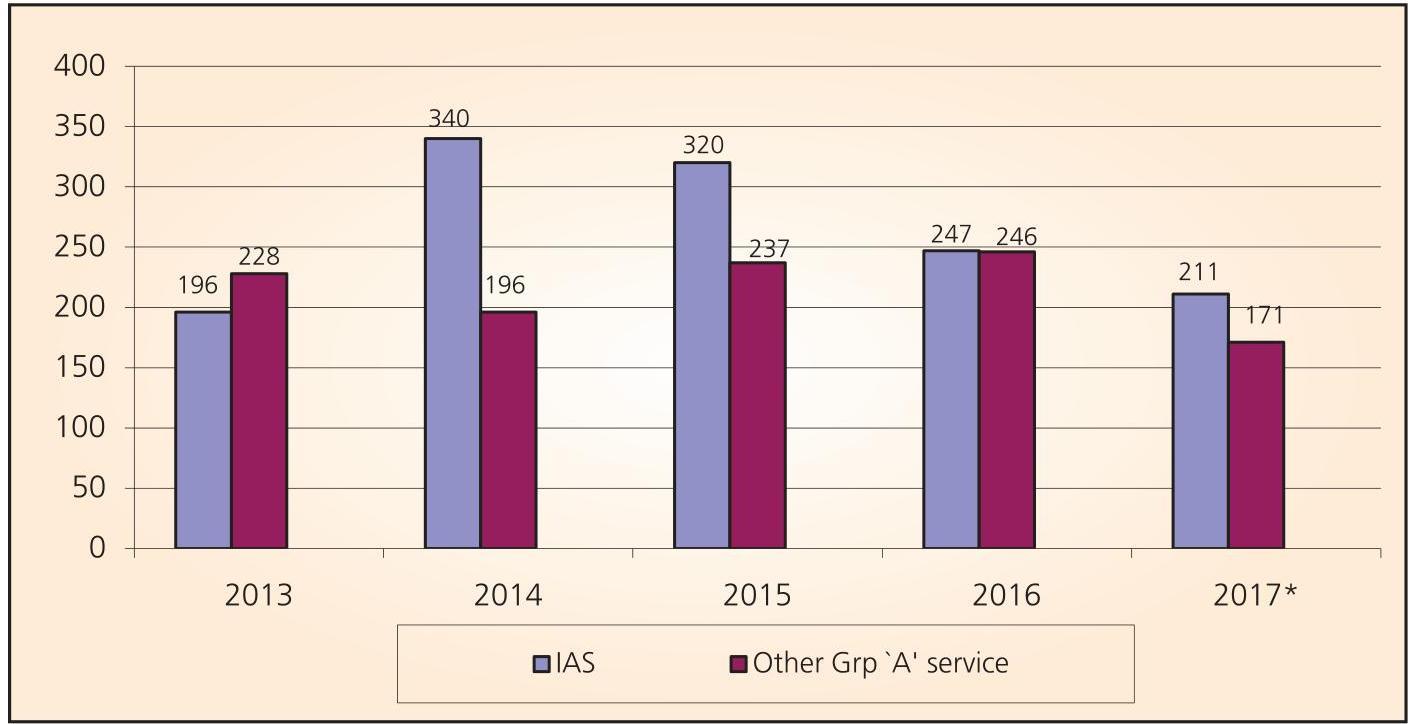
- (Up to 30-11-17)
CENTRAL DEPUTATION RESERVE
6.5 The Establishment Officers (EO) Division in the Department of Personnel \& Training maintains an electronic database of IAS officers and Group ‘A’ officers working at the
Centre under the Central Staffing Scheme. These records are maintained on the basis of orders/letters/notifications issued by the DOPT, various Central Ministries/Departments and the State Governments. The maintenance/
updation of this database is significant, as it helps in providing readily available digitized information in respect of all officers and also processing of cases for foreign appointments/ assignments and training etc.
6.6 The Central Deputation Reserve statement in respect of Indian Administrative Service summarizes the state wise number of officers that are on central deputation vis-í-vis senior duty posts. It also indicates number of officers presently on central deputation from each cadre.
CENTRAL DEPUTATION RESERVE FIGURES AS ON 01/01/2017
| Sl. No. |
Cadre | Total Authorized Strength |
Central Deputation Reserve |
No. of Officers at Centre |
Col. 5 as Percentage of Col. 4 |
|---|---|---|---|---|---|
| 1 | 2 | 3 | 4 | 5 | 6 |
| 1 | AGMUT | 337 | 73 | 42 | 57 |
| 2 | Andhra Pradesh | 211 | 46 | 19 | 41 |
| 3 | Assam, Meghalaya | 263 | 57 | 38 | 66 |
| 4 | Bihar | 342 | 74 | 39 | 52 |
| 5 | Chhattisgarh | 193 | 38 | 5 | 13 |
| 6 | Gujarat | 297 | 64 | 13 | 20 |
| 7 | Haryana | 205 | 44 | 11 | 25 |
| 8 | Himachal Pradesh | 147 | 32 | 24 | 75 |
| 9 | Jammu & Kashmir | 137 | 30 | 7 | 23 |
| 10 | Jharkhand | 215 | 45 | 7 | 15 |
| 11 | Karnataka | 314 | 68 | 16 | 23 |
| 12 | Kerala | 231 | 50 | 34 | 68 |
| 13 | Madhya Pradesh | 439 | 90 | 28 | 31 |
| 14 | Maharashtra | 361 | 78 | 21 | 26 |
| 15 | Manipur | 115 | 24 | 13 | 54 |
| 16 | Nagaland | 94 | 20 | 8 | 40 |
| 17 | Orissa | 237 | 51 | 19 | 37 |
| 18 | Punjab | 221 | 48 | 15 | 31 |
| 19 | Rajasthan | 313 | 64 | 16 | 25 |
| 20 | Sikkim | 48 | 10 | 3 | 30 |
| 21 | Tamil Nadu | 376 | 81 | 21 | 25 |
| 22 | Telangana | 208 | 35 | 11 | 31 |
| 23 | Tripura | 96 | 21 | 14 | 66 |
| 24 | Uttar Pradesh | 621 | 134 | 64 | 47 |
| 25 | Uttarakhand | 120 | 26 | 7 | 26 |
| 26 | West Bengal | 359 | 78 | 10 | 12 |
| Total | 6500 | 1381 | 505 | 36 |
6.7 In addition to the appointments under the Central Staffing Scheme, a total number of 374 appointments as Chairman/ CMD/MD/ Deputy Governor/Chairman/Vice Chairman/ Members/Executive Director/Officers Employee Director / Workmen Employee Director/ Functional Director/ Non Official Director were made on the Boards of Public Sector Undertakings and Banks/Financial Institutions during the period 1.01.2017 to 30.11.2017. During the same period, 185 appointments were made at the level of Chairman/Financial Commissioner/General Manager equivalent/ Member/Additional Member/ Director General in the Railway Board/Zonal Railways/RCT and
Promotion/empanelment was carried out for appointments to Higher Administrative Grade in Rs. 67,000-79,000/- and Rs. 75,500-80,000/-to various Group ‘A’ Services under the Ministry of Railways. Besides appointment of 315 Officers was also approved during the above period for additional charge/current charge/extension of tenure/non-extension of tenure/ad-hoc/rejection/termination of service of GM/DG/VC/CMDs/MDs, Functional Directors, Non-Official Directors in PSUs/ Banks/Financial Institutions, and the Ministry of Railways. Out of these 874 appointments/ additional charge, 78 are female officers.
NUMBER OF APPOINTMENTS OF CHAIRMAN – CUM-MANAGING DIRECTOR/MANAGING DIRECTOR ETC IN PSUs/BANKs
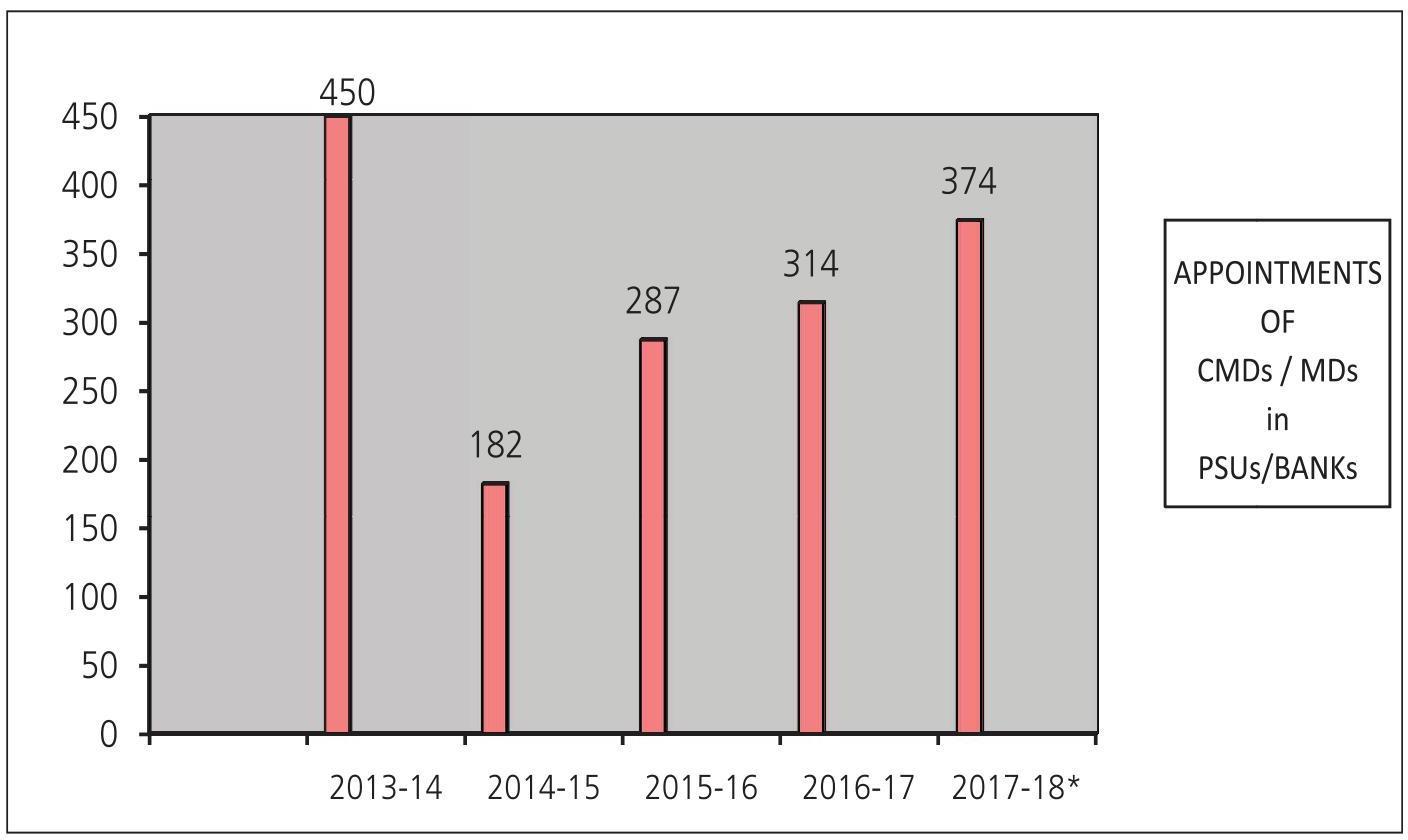
*(Up to 30/11/2017)
6.8 During this period appointment of 137 Member/Chairman/ Chief Executive Officer/ Advisor was approved in various Autonomous Bodies, Administrative Tribunals, Labour Courts and Regulatory Bodies. Out of these, 30 are women officers.
6.9 A total of 2470 officers were approved for empanelment for promotion to posts of and above the level of Joint Secretary in various organized Central Services which are not included in the Central Staffing Scheme. Out of these 315 are women.
6.10 During the year 2017 the Election Commission of India had sought the names of 40 IAS officers in the rank of Additional Secretaries and senior Joint Secretaries, drawn from the Central Ministries/ Departments for appointment as Observer for the Presidential Election held in July, 2017. A batch- wise list of 48 IAS officers (1986-88 batches) in the rank of Addl. Secretary and Joint Secretary along with their details was forwarded to the ECI.
Further, the ECI had also sought nomination of 85 IAS officers for appointment as Election Observer for General Elections to the State Legislative Assemblies of five States and a number of bye-elections held in the year 2017. Accordingly, nomination of 46 IAS Officers was sent to the ECI for appointment as Election Observer.
GENDER ISSUES
6.11 While taking up empanelment of officers to JS rank, it is ensured that women officers get adequate representation.
6.12 A total of 65 women officers were
appointed under Central Staffing Scheme during the period from 1/1/2017 to 30/10/2017 including 38 women officers at Secretary/Addl. Secy./ Joint Secy. Levels.
6.1378 women officers were approved during the above period for appointments/ holding additional current charge/Extension of tenure /service as CMDs/MDs, Executive Directors, Functional Directors, Non-official Directors in PSUs/Banks, Financial Institutions, Railway Claims Tribunal (Indian Railways) during the above period.
6.14 A total of 315 women officers were approved for appointment to posts of Joint Secretary Level and above in various organized Central Services excluding appointments under the Central Staffing Scheme.
6.1530 women officers were approved for appointment as Member/Chairperson/ CEO etc. in various Autonomous Bodies, Administrative Tribunals, Labor Courts, Regulatory Bodies.
Chief Vigilance Officer
6.16 During the year 2017-18 (upto December, 2017), 33 officers have been appointed as Chief Vigilance Officer (CVO) in various organizations, deputation tenure of 6 CVOs has been extended for two more years beyond initial tenure of three years, additional charge arrangement has been made for 8 vacant posts of CVOs and one officer has been debarred for not joining the assignment. Further, the procedure for appointment of CVOs has been revised wherein the process of appointment of CVOs has been simplified and aligned with the CSB procedure.
7
CHAPTER
Training Policy and Programmes
7.0 The Training Division of the Department of Personnel and Training is the nodal agency for training of government functionaries and is primarily responsible for formulating policies with regard to training. It also implements certain components of training directly. In the implementation of its mandate, the Division has set the following objectives:
- $\quad$ Administering Policy matters in training
- $\quad$ Identification of functional areas of training
- Designing and implementing training programs for officers involved in the priority development sectors
- Development of trainers and training capability
7.1 The ultimate goal of the Training Division is to attain “Training for All” which means that training would be imparted to all rungs of Civil Services starting from the lowest and cutting-edge to the highest in policy making.
Major Activities
1) In-service Training of IAS Officers
2) Mid Career Training of IAS Officers
3) Domestic Funding of Foreign Training
4) Post Graduate Programmes in Public Policy & Management
5) Training Support
6) Intensive Training Programme
7) Induction Training Programme
8) COMMIT
9) Posting of IAS Officers as Assistant Secretary
Long-Term Domestic Post Graduate programmes in Public Policy and Management
7.2 These programmes were envisaged to enhance the competence of Mid-Career Civil
Servants in Public Policy and Management by –
(i) Broadening awareness of the latest trends in policy approaches,
(ii) Developing technical, analytical and leadership skills for public policy,
(iii) Providing opportunity in specialization and
(iv) Exposing them to alternative systems of public management in other countries.
7.3 At present, Indian Institute of Management- Bangalore (IIMB), Management Development Institute- Gurugram (MDIG) and TERI University- New Delhi are offering these programmes. In order to provide international policy perspective to the participants, each programme has incorporated an international component of 2 weeks in association with reputed international institutes. From year 2015-16 a new one year Hybrid Programme
“Management of Public Policy Programme (MPPP)” at Indian School of Business Hyderabad/ Mohali (ISB-H/M) is also being conducted.
7.4 During 2017-2018, $16^{\text {th }}$ Batch of Post Graduation Programme in Public Policy and Management (PGPPM) at Indian Institute of Management- Bangalore, $2^{\text {nd }}$ Batch of One year Management Programme in Public Policy (MPPP) at Indian School of Business- Hyderabad/ Mohali, $11^{\text {th }}$ Batch of Post Graduation Diploma Programme in Public Policy and Management at Management Development InstituteGurugram and $9^{\text {th }}$ Batch of Programme in Public Policy & Sustainable Development (PP \& SD) at TERI University- New Delhi were launched.
Mid-Career Interaction between Armed Forces and Civil Services Officers
7.5 Mid-Career interactions between Armed Forces and Civil Services Officers are being organized at the Central Training Institutes/State Administrative Training Institutes and Defence Institutions in various parts of the country with an objective to benefit both the Armed Forces and Civil Services Officers by way of mutual learning from each other’s strength and also by imbibing the best points of each other’s work culture, ethos and customs. This, in the long run, is expected to help the participating officers to combat future challenges to national security in a better manner.
7.6 During the current financial year 20172018, 6 programmes have been planned on
themes like Cyber Security and Crime, Growing maritime challenges in the $21^{\text {st }}$ Century, Aid to Civil Authority, Cross Border Terrorism, Disaster Relief and Civil- Military relations during HADR, Jihadi threat in India emergence of ISIS and affiliates and treat to Internal Security. Of these three programmes have already been conducted so far and remaining three programmes are to be conducted in the upcoming months.
TRAINING SUPPORT
Thematic Training Programmes: State Category Training Programme
7.7 Under the scheme of “Training for All”, support is provided to State Administrative Training Institutions (ATIs) by way of sponsoring training programmes in the areas accorded priority by the Central Government. The Training Programmes conducted by the State ATIs are designed to develop management skills and knowledge in different areas for senior and middle level officers of State Govt. /State Public Sector Undertakings and State autonomous bodies. These training courses are also meant to sensitize the officers to new and important issues facing our society. The courses are also being conducted at District and Sub-District Centres of the State ATIs. These courses cover a large variety of subjects under broad thematic groups.
7.8 During the year 2017-18, 513 such short-term courses have been sponsored at various State ATIs on subjects such as Sustainable Development, Decentralized Planning, Public Private Partnership, Gender Issues, Minority Issues, Disability Issues, Audit
& Budget, Human Rights, Leadership \& Team Building, Computer \& IT, E-Governance, Cyber Security, Goods \& Service Tax (GST), Court Procedures, Office Procedures, Women Empowerment, Child Development, Role of NGOs, Labour Law, Panchayati Raj, Environment Issues, Road Safety, Right to Information, Establishment Rules, Ethics \& Values in Governance, Disaster Management, Financial Management, Urban Management, Consumer Rights etc. As on December, 2017, out of 513 sponsored courses, 312 courses have actually been conducted and more than 8300 participants have been trained under this Scheme.
TRAINER DEVELOPMENT PROGRAMME
7.9 Recognizing the importance of trainers in the training function, Training Division started the Trainer Development Programme in the early 1990s. Initially, faculty members of various training institutions were developed as Master Trainers and Recognized Trainers of various “Training of Trainers (ToT)” packages in collaboration with the Thames Valley University of U.K. Over a period of time, indigenous mechanisms were evolved for developing a cadre of professional trainers and resource persons in the country to create a cascading and multiplier effect. The programme has gone a long way in embedding the Systematic Approach to Training (SAT) into the process of designing and imparting effective training to government officials.
7.10 Currently, the following ToT programmes are sponsored under Trainer Development Programme at various training
institutions across the country:
- Training Needs Analysis (TNA)
- Design of Training (DOT)
- Direct Trainer Skills (DTS)
- Evaluation of Training (EoT)
- Management of Training (MoT)
- Experiential Learning Tools (ELT)
- Mentoring Skills
- Facilitation Skills
- Introduction to SAT courses
7.11 The Department has developed a pool of more than 60 Master Trainers and approximately 350 Recognized Trainers in different packages under this Scheme, who are called upon to conduct TDP courses. DoPT has sponsored 89 TDP courses on various packages during the current financial year 2017-18.
INTENSIVE TRAINING PROGRAMME
7.12 Intensive training programme for frontline Government functionaries of State Governments was initiated during the year 2008-09. The focus of this programme is on demand-driven training of frontline personnel and is conducted in close coordination with line Departments by the State Administrative Training Institutes (ATIs). The programme was given a momentum through issue of new ITP implementation and management guidelines to all the Chief Secretaries and the State ATIs; holding three workshops in the beginning covering all 29 States at Delhi, Hyderabad and Assam; followed by workshops, mid-termreviews of this programme in Chandigarh, Shillong and Goa.
7.13 The intensive training programme has been implemented in more than 170 districts and approximately 55,000 officials have been trained since its inception. Some of the sectors covered under the Programme include – Water and Sanitation, Public Health, Public Distribution System, Revenue, Integrated Child Development Services, School Education, Dairy Development, Registration, Social Welfare, Police, Citizen Centric Delivery and Right to Public Services Act etc. A national documentation-cum-facilitation centre for this programme has been established (www. itpndfc.in) under which an ITP knowledge portal is in existence for the benefit of general public and for the use of all those who are involved in the process of implementation of this Programme.
INDUCTION TRAINING PROGRAMME
7.14 In order to promote a citizen centric attitude in the employees, for better public service delivery and promote good practices towards achieving the vision of citizen centric governance Department of Personnel and Training had launched a capacity building programme on pilot basis in three States of Jammu & Kashmir, Maharashtra and Tamil Nadu for 3000 newly recruited cutting edge level government functionaries to develop in them Generic \& Domain specific competencies covering 15 districts in the financial year 2014-15.
7.15 After successful completion of the Pilot, a 12-Days Induction Training Programme (ITP) was launched in the year 2015-16 in 103 districts of 21 States with a Two Day Regional
Training of Trainers (ToT) Workshop at various State ATIs for training of 7000 frontline State government functionaries. A motivational talk by locally available inspirational achievers/ national award winners/sports persons in the inaugural session of the ToT Workshop and training programme in the districts, one day blood donation camp during the middle of the course and one night stay in the village as part of field/NGO visit were compulsory component of the 12 Days Induction Training Programme. In the year 2016-17, the Induction Training Programme has been implemented in 115 new districts of 24 States.
7.16 In the year 2017-18, the Induction Training Programme is proposed to be implemented in 75 new districts of 15 States.
COMPREHENSIVE ONLINE MODIFIED MODULES FOR INDUCTION TRAINING (COMMIT)
7.17 The Comprehensive Online Modified Modules on Induction Training (COMMIT) has been conceptualised in the background of the National Training Policy-2012 which stipulates that all civil servants from lowest level functionaries to the highest level will be provided training at the time of their entry into civil service and mandates that priority will be given to the training of front-line staff, including training on soft skills, so as to improve customer orientation as well as quality service delivery to the citizen. This programme will supplement the existing 12-Day Induction Training Programme (ITP) launched in 2014-15 for newly recruited frontline State Government functionaries to develop in them
Generic & Domain specific competencies. The coverage of this new programme has the potential to cover as many as 3.37 lakh officials every year. This is a huge jump in the coverage of the participants in comparison to the existing 12-Day ITP where only 10,000 officials are covered every year.
7.18 The COMMIT has been launched in 6 States of Assam, Haryana, Maharashtra, Tamil Nadu, Telangana and West Bengal on pilot basis during the current financial year 2017-18. The programme will cover approximately 82,000 frontline State Government functionaries in the financial year 2017-18. It is of 28 hours duration which will include e-Modules for 20 hours and face-to-face training for 8 hours. The 20 hours e-training is being imparted through specifically developed 12 Generic and 3 Domain specific e-Modules. The modules on soft skills are delivered as e-Modules \& through face-to-face training and the domain modules are covered through e-Modules only. As on December 2017 more than 25,000 officials have been registered for this course in the six piloting States and more than 5,000 officials have completed the course successfully.
7.19 The programme starts with the 8 hours face-to-face training where each participant is familiarized with the objective and concept of the programme. The participants thereafter are given login ID and password to access the e-Modules. They will have 60 days to complete the 15 e-Modules at their own pace. On conclusion of the programme, officials undergo online assessment and certificate of completion would be generated for download/
print. The programme is being implemented through State Administrative Training Institutes (ATIs).
7.20 This blended course allows officers and faculty to take advantage of much of the flexibility and convenience of an online course while retaining the benefits of the face-toface classroom experience. The COMMIT has been strategically aligned with the mission \& goals of the 12-Days ITP to develop skills and attitude towards improving service delivery keeping the citizen at the core. The advantage of such a blended programme is requirement of limited classroom space; to infuse new opportunities to officers who have had limited or no training to build the requisite skills, knowledge and attitude; and offer the convenience of online learning combined with the social and instructional interaction that may not lend themselves to online delivery (e.g. motivational talk, understanding of the vision and proctoring assessments).
Overseas Training Programmes
7.21 Department of Personnel and Training has been nominating officers for training programs abroad. In the past, these programs were funded by bilateral or multilateral assistance. However, over the years, this assistance had come down. Keeping in view the importance and benefits of providing international exposure to the officers, a scheme of Domestic Funding of Foreign Training (DFFT) was started in 2001. This covers both long term and short-term training in various universities/institutes in several countries. A scheme of “Partial Funding of Foreign Study”
was also started in 2002-03 as another component of the scheme of DFFT. Under this scheme, Government of India provides limited financial assistance to such officers who secure admission on their own in reputed universities and in programs relevant to their present or future job context.
7.22 During the financial year (as on 31/01/2018), 37 officers were nominated for long term foreign training programs and 316 officers were nominated under short term foreign training programs. Further, 11 officers have also been granted partial funding assistance under the DFFT Scheme. During the remaining period of 2017-18, 09 officers are likely to be deputed in Short Term programs under DFFT scheme.
Scheme of scholarship by Private Foundation Trust
7.23 A scheme for scholarship offered by private foundation/trust in top 10 ranked universities as per the world university ranking for officers of all the three All India Services has been approved by the Government. Funding under this scheme is available for pursuing programs in Master in Public Policy/Public Administration/International Development and Master in Business Administration, subject to the eligibility conditions.
7.24 Under this scheme, ‘Desai Sethi Family Foundation’ has offered ‘Desai Sethi Family Foundation Fellowship’. On this, two fellowships/scholarships are available for officers belonging to Indian Administrative Service, Indian Foreign Service, Indian Police
Service and Indian Forest Service for pursuing a 2 year Masters program in Public Policy/Public Administration/International Development at Harvard Kennedy School, Harvard University. The funding is US$ 50,000 per officer per year. The guideline on the fellowship is available on the website of this Department.
One-week In-Service Training (IST) Programs for Officers of All India Services and for those working under Central Staffing Scheme- Sponsored by Department of Personnel & Training
7.25 The Training Division sponsors ‘In-Service Training Programme’ of ‘one-week duration’ in various ATIs/CTIs/Other Premier Training Institutes in the country by inviting proposals from them on relevant themes. During current year (2017-18), 16 programmes have been offered at 10 selected institutions. These programmes provide select middle to higher management level officers an opportunity to update their skills in area of their own choice-in a sector they are currently working in, or in an area they expect to work in near future, or in a theme they feel they should specialize. These programs also provide a valuable platform for horizontal and vertical knowledge sharing.
7.26 The primary objective of the IST program is to sensitize the participants to national concerns and the values enshrined in the Constitution; to provide for exchange of experience and adequate discussion on issues of values, ethics and attitudes; to make the participants more confident to face problems in their work areas and attempt solutions; and to train the participants to look at problems in
an integrated manner and develop a systems approach.
7.27 In past, these programs have been offered in diverse and broad thematic area such as: Administrative Law, Agricultural & Rural Development, Climate Change (preparedness), Competition Law (policy formulation), Corruption (eradication strategy), Education (reforms \& challenges), E-governance (opportunities \& challenges), Environment \& NaturalResource(management),Environmental Impact Assessment (development projects), Ethics (Public Governance and Administration), Financial Markets (regulation), Fiscal Policy (Macroeconomic Management), Governance (IT management and improving through accountability), Infrastructure (Finance), Innovations (public service), Land Acquisition (rehabilitation \& resettlement), Leadership, Participatory Management (Community Mobilization), PPP (negotiating strategies and urban development), Procurement (procedure \& contracting), Project Analysis/Appraisal (risk analysis/management), Public Policy (management/governance), Quantitative Methods (management), Service Delivery (management), Social Policy (Governance), Social Sector (financing/marketing), Urban Development, WTO (basic/advance course), Citizen Centric, Cyber Crime, Stress Management etc.
In-House Training Programme
7.28 With a view to build the capacity of employees and as per the direction of Hon’ble Prime Minister, weekly One Hour Training for the officials of DoPT from LDC to Director
Level on various topics has been started w.e.f. 9.10.2014. Weekly training also includes training of official of CSSS up to the rank of PPS. Total 9 modules/training topics have been selected for training. So far eight modules viz. Filing System, Noting and Drafting, Gender Sensitization, Litigation Management(Handling of Court and CAT Cases), Preventive Vigilance, Ethics and Values, Records Management and Financial Management (Financial Property, issuing sanctions, role of Head of Office, role of Head of Department) have been completed. Ninth module on “Report writing (not APAR)” has been started from 23.08.2017.
Advanced Professional Programme in Public Administration (APPPA) at Indian Institute of Public Administration, New Delhi
7.29 The Training Division has been sponsoring a ten-month Advanced Professional Programme in Public Administration (APPPA) at the Indian Institute of Public Administration (IIPA), New Delhi every year since 1975-76.
7.30 The objectives of this programme is to prepare the participants to make a greater contribution to better governance, develop attitudes that focus on citizen services and also to strengthen leadership qualities in the civil service. It provides an opportunity to the participants to analyze major contemporary issues in Governance, learn about recent developments in the social sciences and their application in administration; review their experiences by making a critical analysis of environmental and other factors, apply relevant concepts, skills and techniques
relating to policy, behavioral and administrative sciences and to demonstrate their creative and analytical abilities individually and in groups. It also seeks to develop interpersonal skills and sensitiveness to the needs of the people with a view to making administration more responsive and result oriented.
7.31 The course covers classroom studies relating to various facets of administration viz, Social, Political, Economic, Legal and Administrative Systems, Organizational Behavior, Social Science and Research Methods, Operational Research, Information Technology in Management and Financial Management. Participants are also required to conduct rural and urban field studies and prepare a project report and dissertation. They are expected to select an area for specialization relevant to their present and likely future assignments from following fields of study: Advanced Information Technology and MIS, Comparative Development Experience, Project Management, Constitutional Law, Disaster Management, Economics of Regulation, Inter Governmental Relations, Management Systems, Organizational Needs Analysis, Public Expenditure Management, Public Organizational Theory, TQM, Finance, Personnel, Corporate or Public Sector Management, General Administration, Planning and Rural Development etc.
7.32 This 10 month programme includes three semesters, rural and urban field visits in India and a 10 day foreign study tour. In the $42^{\text {nd }}$ APPPA Programme, the participants visited in two groups to South Africa & Italy
and Peru \& Spain. The $43^{\text {rd }}$ APPPA Programme in this series is being held from July 3, 2017 to April 29, 2018. 47 participants are attending this programme.
Posting of IAS Officers as Assistant Secretary in Government of India:
7.33175 IAS Officers of 2015 batch were posted as Assistant Secretary in the Ministries/ Departments of Government of India from 03.07.2017 to 29.09.2017 on Central Deputation.
7.34 The objective of the Assistant Secretary Scheme is to provide exposure to the IAS officers of 2015 batch to Government of India functioning. This exposure would help them acquire a national perspective and a deeper appreciation of the harmonization of diversities in national policies. This will sensitize them to the larger perspective (vision) of any policy \& programme of Government of India.
7.35 Important Desks related with policy, flagship programmes of the concerned Ministries/Departments, etc. was assigned to the Assistant Secretaries. They worked on Desk Office pattern, initiated and disposed off files, the reports of which were submitted to DoPT periodically by concerned Ministries/ Departments.
7.36 The Hon’ble PM addressed the Assistant Secretaries in the inaugural session at DRDO Auditorium, New Delhi on 03.07.2017. Interaction of these Assistant Secretaries was also held with Cabinet Secretary, CAG, PMO, Election Commission, Central
Information Commission etc. They also visited attached offices of the concerned Ministries/ Departments and undertook field visits in addition to the Desk work assigned to them.
7.37 Interactive sessions with Assistant Secretaries (IAS-2015 Batch) were organized by DoP&T, NITI Aayog, Cabinet Secretariat, D/o AR\&PG on different topics in which a large number of dignitaries /Head of Departments /Head of Organizations /Senior Officers participated. Also a National Workshop was organized on “Innovation of Governance” in which Senior Officersparticipated from different Ministries /Departments /Organizations / States. Positive feedbacks on the posting were received from the officers in the feedback session organized on 27.09.2017.
7.38 The Assistant Secretaries had prepared presentations on the key learnings based on the work allocation. These presentations were shortlisted by sectoral group of Secretaries and thereafter shortlisted by Cabinet Secretariat. The following top 8 presentations were presented before the Hon’ble PM in Valediction session:
- Sahay by Shri Abhijeet,
- Carbon Footprint by Ms Lakshmi Priya,
- Financial inclusion by Shri Umesh and others,
- Archaeological Survey of India “Must see” by Shri Amrit ,
- Improving of rural income by Ms. Ira Singhal,
- Data driven planning by Ms. Priyanka,
- Safety of Railways by Shri Jaiswal and
- Attrition rate in Central Armed Police Forces by Ms. Akanksha.
7.39 Hon’ble Prime Minister addressed the Valedictory Session of Assistant Secretaries (IAS-2015 batch) at DRDO Auditorium, New Delhi on 26.09.2017 and inter alia emphasized to maintain a structured mechanism to keep in touch with Assistant Secretaries of the three batches (2013, 2014 and 2015). In this regard, the DOP\&T have written DO letters to Secretaries to Govt. of India as well as Chief Secretaries of State/UTs for follow-up. With the support of NIC, e-mails/ user groups have been created which includes Assistant Secretaries of three batches and Secretaries/ Nodal Officers of all 58 Ministries/Departments as Members.
Training Institutions
LAL BAHADUR SHASTRI NATIONAL ACADEMY OF ADMINISTRATION
Introduction
8.0 The Lal Bahadur Shastri National Academy of Administration (LBSNAA), Mussoorie is Government of India’s premier institution for the training of higher civil services in the country. The Academy imparts induction level and in-service training. A common Foundation Course is held for entrants to All India Services and all Group “A” Services of the Union. The professional training to regular recruits of the Indian Administrative Service (IAS) and members of the Royal Bhutan Civil Service is conducted after the Foundation Course. The Academy also conducts in-service and Mid-Career Training Program (MCTP) for members of the IAS and Induction Training program for officers promoted to the IAS from State Civil Services, as well as workshops and seminars on various issues in public administration.
8.1 To ensure that the academic curriculum is relevant, it is constantly reviewed and updated through extensive consultations with the representatives of the State Governments, the Central Government and other scholars and practitioners. Given the limitations of conventional classroom lectures, new pedagogical methods have been introduced to deliver training inputs in a more effective
manner. Most courses operate on a modular structure whereby relevant themes are chosen and dealt with in a consolidated fashion to ensure that all aspects relating to them are covered comprehensively.
8.2 In order to promote all-round development of the personality, due emphasis is placed on outdoor and co-curricular events. Physical training, team games and tennis, badminton cross-country running, yoga, horse riding, and adventure sports like river rafting, para-gliding, bungee jumping and rifle shooting are some of the activities that the officer trainees are involved in. Exposure to public speaking, theatre workshops, motor mechanic skills, gardening, photography and music appreciation are some of the co-curricular activities offered to the young administrators.
8.3 To nurture the values of integrity, moral courage, empathy and respect for the underprivileged, and freedom from any sectarian prejudices based on religion, region, caste, class or gender, Officer Trainees are encouraged to participate in diverse social activities. Various Clubs and Societies have been formed to which the Officer Trainees are elected as office-bearers. They organize and take part in quizzes, debates, poetry competitions and numerous other activities after class hours. This lends a spirit of bonhomie and also promotes esprit de corps.
Induction Training Courses
8.4 The Academy conducts Induction training courses for direct recruits to the IAS and other senior civil servants as well as officers promoted to the IAS.
Foundation Course (15 Weeks)
8.5 The Foundation Course is the flagship course of Induction training and is intended for fresh entrants to the All-India Services, i.e. the Indian Administrative Service, the Indian Police Service and the Indian Forest Service, and the various Central Services (Group-A) of the Union. It is a fifteen-week course conducted from September to December every year. The
course aims at imparting a basic understanding of the constitutional, political, socio-economic and legal framework of the country; and also fostering greater co-ordination among the members of the different public services by building esprit-de-corps and cultivating an attitude of co-operation and interdependence. This year total of 369 Officer Trainees including 11 officers from RBC, RBFS and RBPS participated in the Course scheduled from 28th August, 2017 to 8th December, 2017. The course was inaugurated by the Smt. Smirti Zubin Irani, Hon’ble Minister, Textiles and Information and Broadcasting, Government of India.
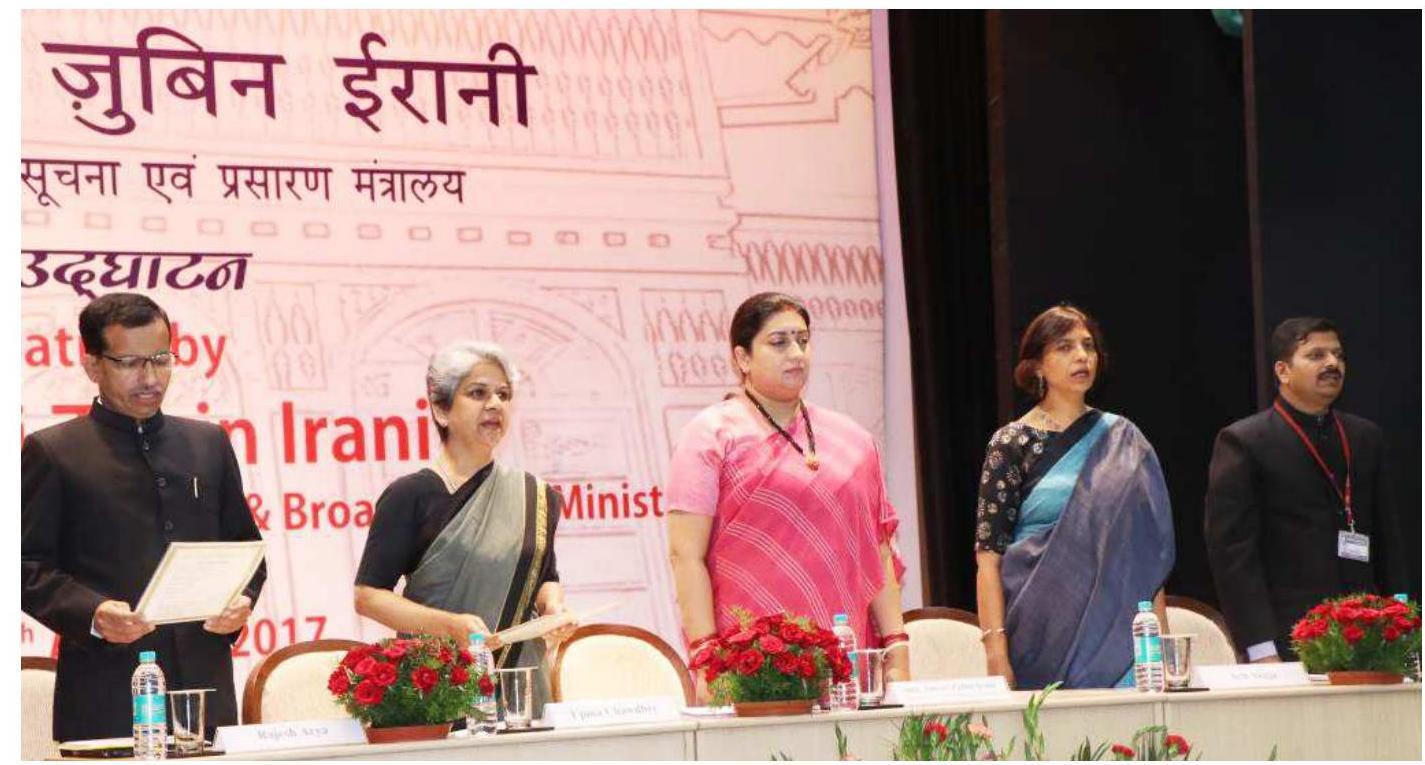
Inauguration of $92^{\text {nd }}$ Foundation Course, 2017
Parallel Foundation Courses were also conducted at MCR HRD Institute, Hyderabad and RCVP Noronha Academy of
Administration, Bhopal.
8.6 The main activities organized during the Foundation Courses were:
- Trekking: The objective of trek was
to inculcate the spirit of adventure and to strengthen Esprit de corps in the Officer Trainees. The trek was also a significant learning experience in group dynamics, interpersonal relations, courage, endurance and love and respect for nature.
2. Village Visit Programme: Officer Trainees spent one week in selected villages in Uttar Pradesh, Bihar, Madhya Pradesh and Rajasthan in groups of 5-6. Here they were sensitized to the empirical realities of rural India, through a structured study of a village. A special feature of the village visit this year was organization of “Swachatta Diwas’ in each of the selected villages when the trainees
raised awareness about the cleanliness mission of the Government and also undertook cleanliness drives in the villages along with the residents. The Officer Trainees also undertook an awareness drive on ‘Financial Inclusion’.
3. Extra-Curricular Activities were conducted in the afternoons and evenings in order to impart skills other than purely academic to the trainees in recognition of the need for an officer to have diverse interests and a wellrounded personality. Primarily, these included celebration of India Day, AK Sinha One-Act Play Competition, Cross Country Run, Athletic Meet and Blood Donation Camp.
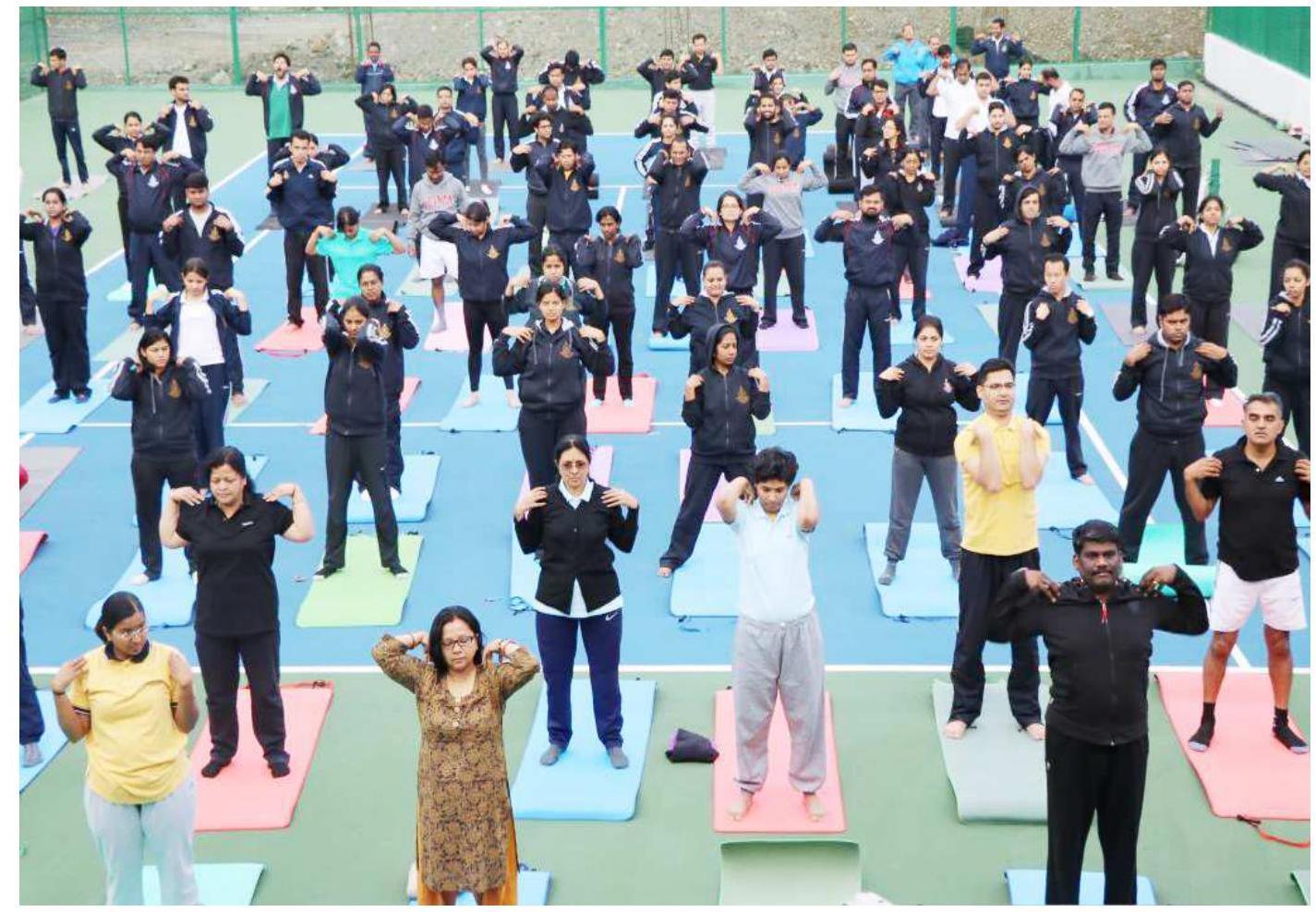
Yoga at the Academy on International Yoga Day on June 21, 2017
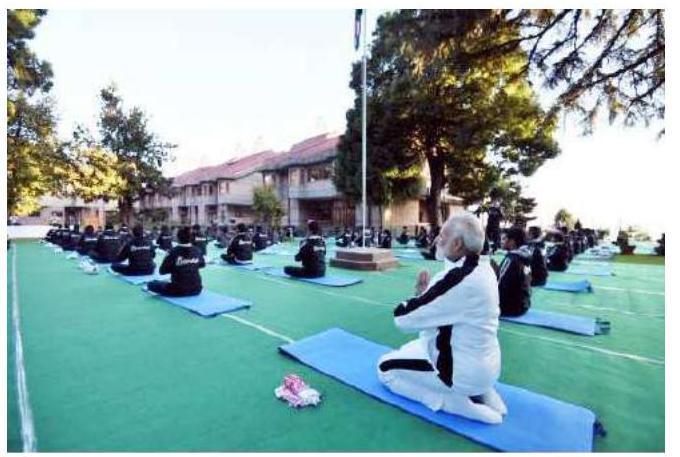
Officer Trainees of $92^{\text {nd }} F C$ doing Yoga with Hon’ble Prime Minister
4. The Honorable Prime Minister of India
Shri Narendra Modi visited the Academy on $26-27^{\text {th }}$ October 2017 and had informal interaction with the Officer Trainees and Faculty in groups. Two special institutional events – Chintan and Manthan were organized, in which the Officer Trainees presented their ideas and notions of governance for a New India to the Hon’ble Prime Minister. The Officer Trainees also joined the Hon’ble Prime Minister for a community dinner and breakfast at the Officer’s Mess. Prime Minister Modiji addressed the Officer Trainees with a basket of messages, to enable them to bring a positive change in the paradigm of administration.
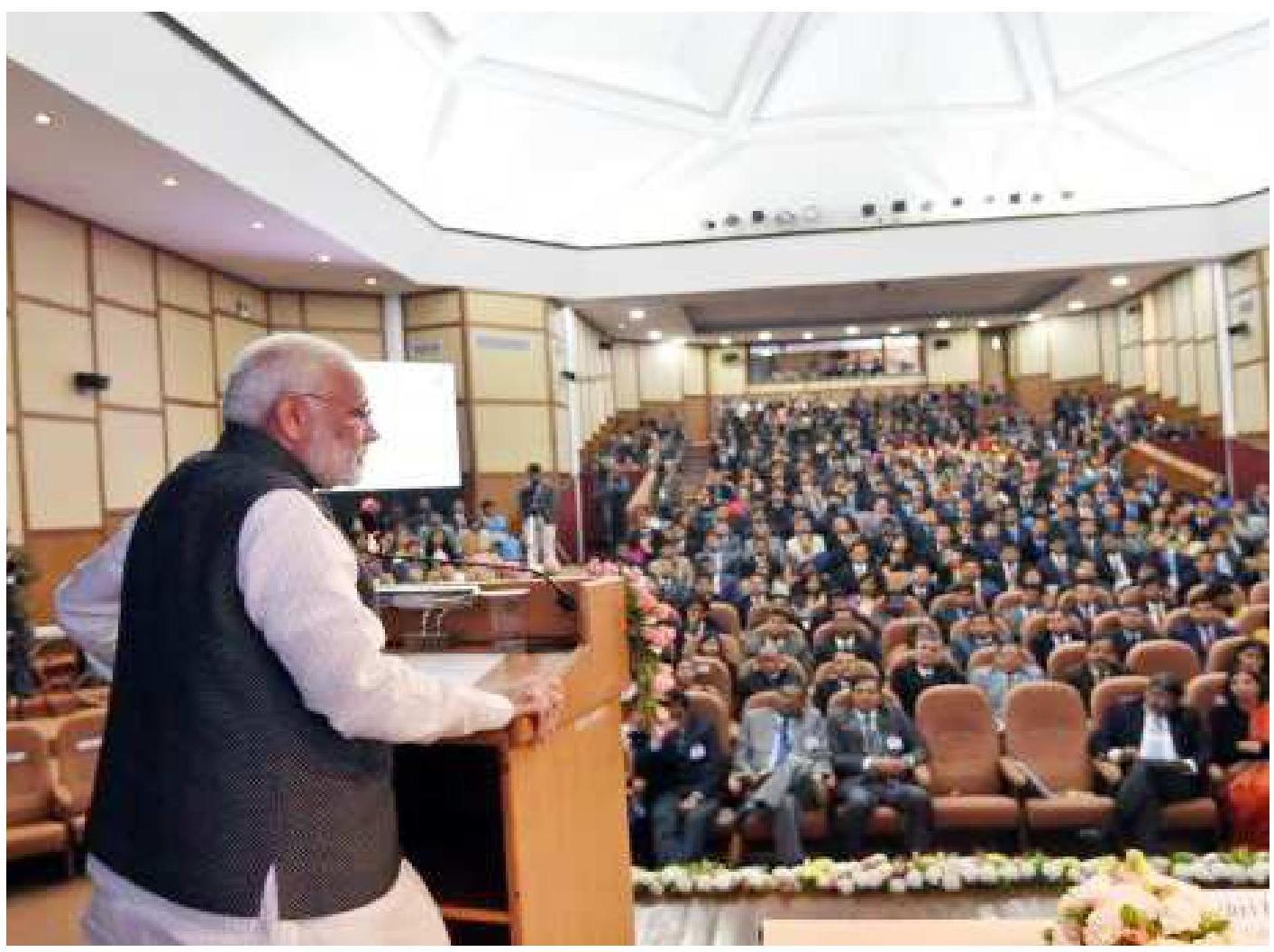
Prime Minister Shri Narendra Modi addressing Officer Trainees at LBSNAA
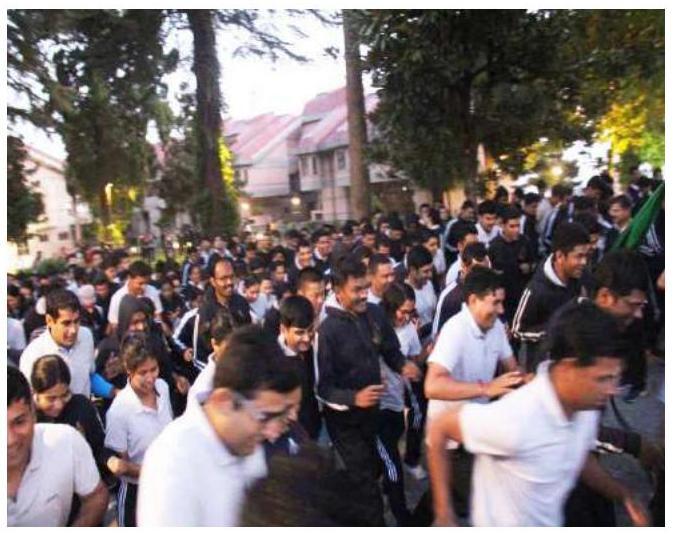
Cross-Country Race in $92^{\text {nd }}$ Foundation Course
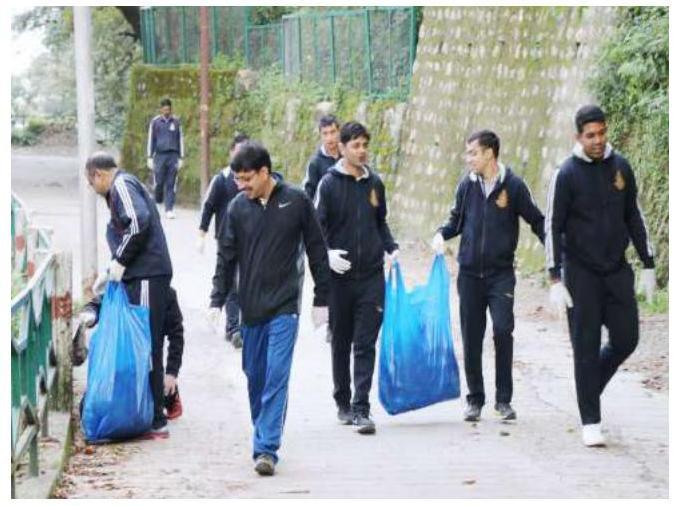
Officer Trainees doing Shramdan
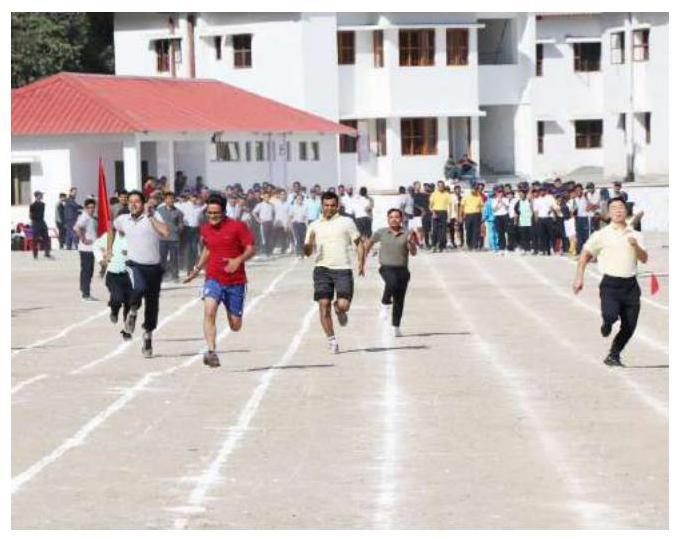
Athletic Meet
IAS Professional Course Phase-I (22 Weeks)
8.7 The IAS Officer Trainees of the 2016 batch (total 181 including 03 Officers Trainees from Royal Bhutan Civil Service) underwent the IAS Professional Course Phase-I from December 12, 2016 to May 12, 2017. This course aims at developing professional skills in handling a large range of responsibilities that an officer shoulders within the first ten years of service. Emphasis is laid on understanding public systems and their management, together with a grounding in Public Administration, Law, Economics, Management and Computer applications. During the first part of Phase-I, the Officer Trainees were sent on a 7 weeks Winter Study Tour (Bharat Darshan) comprising of attachments with the three Armed Forces, Public Sector, Private Sector Units, Municipal Bodies, Civil Society Organisations and civil administration in challenging areas, etc. Special focus visits to places with traditional and modern water conservation practices were organised. After completion of IAS Phase-I, they were relieved on May 12, 2017 for their District Training as part of IAS Professional Course Phase-II.
District Training (53 Weeks)
8.8 During the year-long District Training, the IAS Officer Trainees learn about the various facets of administration at the district level. During this period they are under the direct charge of the District Collector and the State Government. They get an opportunity to obtain first-hand knowledge of the work of
the Collector/ District Magistrate and various other institutions in the State government, along with orientation training at the State Administrative Training Institute. Most of the State Governments give them an opportunity of holding independent charge as Tehsildar/ Mamlatdar, Sub Divisional Magistrate, Block Development Officer and/or Executive Officer of a Municipality. The 2016 batch of the IAS will return to the Academy for their second phase of professional training commencing on May 21, 2018.
IAS Professional Course Phase-II (6 Weeks)
8.9 While theoretical concepts are sought to be imparted in the Foundation and Phase-I courses, the ground level delivery mechanisms are expected to be imbibed during District Training. Phase-II is a time to debrief and share experience and good practices from the various States of the country. The course content of Phase-II is designed to consolidate the learning and assimilation of the district experience with the theoretical constructs taught earlier. A total of 184 Officer Trainees (including 5 trainees from 2012 batch 1, 2013 batch 1 and 1 trainee of 2014 Officers of Royal Bhutan Civil Service) underwent the Phase II course organized from May 22, 2017 to June 30, 2017. Upon completion of the Phase II course, the officers proceeded for 3 months deputation to the Government of India as Assistant Secretaries for first-hand experience of Government of India functioning.
Induction Training Programme for officers promoted to IAS (6 Weeks)
8.10 The Academy organizes Induction Training Programme for officers promoted to the IAS from the state civil services. The aim of these courses is to update levels of knowledge, skills and information and to provide opportunities for exchange of ideas, views and experiences with people who have developed expertise in different sectors of national development. The underlying focus of the course is to provide the Induction Course participants an all-India perspective. The 119th edition of the Induction Training Programme had 62 participants from AGMUT, Assam-Meghalaya, Gujarat, Madhya Pradesh, Maharashtra, Manipur-Tripura, Punjab, UP and West Bengal and was held from July 03 to August 11, 2017. The programme aimed at training and sensitizing officers from the state services for the next level of governance and administration. The course included a Study Tour within India and to Seoul, South Korea to familiarize participants with successful interventions in various areas of governance. Participants were evaluated by means of a mid-term exam, policy memo and presentations and an overall assessment based upon peer review, discipline and participation in the programme.
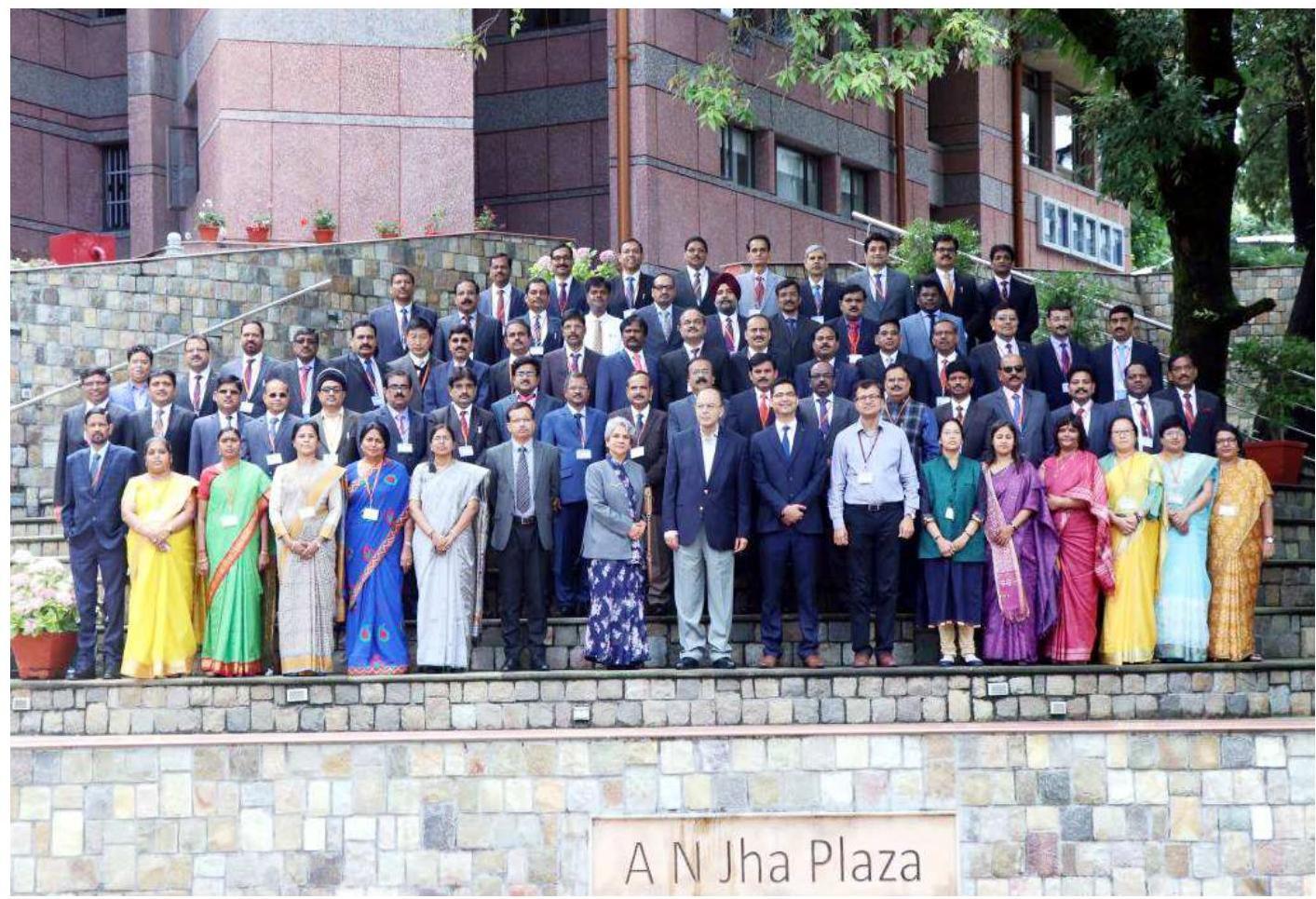
Group Photo of promoted IAS (119 th ITP)
Mid Career Training Programme (MCTP)
8.11 The issue of mandatory and structured mid-career training for IAS Officers was formalized with the introduction of the MidCareer Training Programme (MCTP) in 2007. The objective of MCTP was to equip officers to handle the next, higher level of responsibilities at certain identified stages of their careers; broadly when they were primarily working in the field (7-9 years), at the policy formulation stage (15-18 years) and inter-sectoral policy formulation and implementation stage (2728 years). These three stages were named Phase III, IV and V respectively. In the first three-year cycle, these programmes were
outsourced by the Ministry to international/ national institutions of repute. However, since 2010, the mandate for the design and delivery of the programme has been devolved by the Government to the Academy. The MCT Programme was reviewed by Government and its durations were shortened. The revised programme is as follows: Phase III (4 weeks); Phase IV (4 weeks including 1 week Foreign Study Tour) and Phase V (3 weeks).
Phase III Course (11 th MCTP- 4 Weeks)
8.12 The Phase III course targets the officers of 7-9 years of seniority. The Academy organized this 4 weeks course from $10^{\text {th }}$
April, 2017 to $05^{\text {th }}$ May, 2017. The focus of the course was on service delivery, project appraisal and implementation as well as on key governance challenges. Inputs also covered leadership and negotiation. Total 107 participants underwent the training course.
8.13 In 2017-18, a second Phase-III course was conducted having 85 participants at the Academy from $20^{\text {th }}$ November 2017 to $15^{\text {th }}$ December 2017.
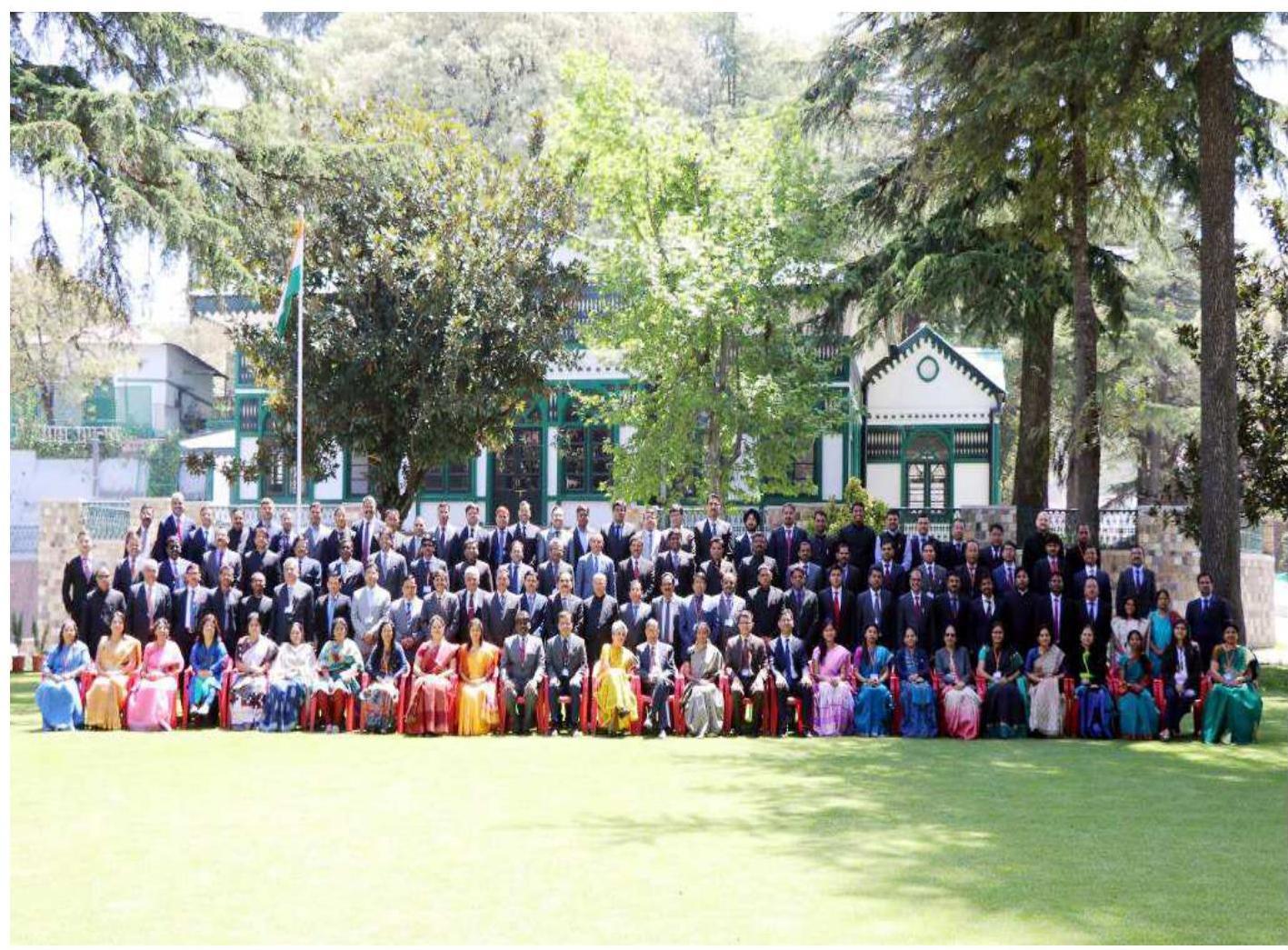
Phase IV Course (12 th Round – 4 Weeks)
8.14 The Phase IV Course targets middle level officers (of 15-18 years seniority) with a thrust on Public policy. Besides enhancing domain knowledge of the participants, especially in the realm of various aspects of public policy,
the Course also aims at broadening their perspective and developing soft skills. 75 participants attended the course organized from June 05 to June 30, 2017. The Course included a short Foreign Study Tour to the Lee Kuan Yew School of Public Policy, National University of Singapore.
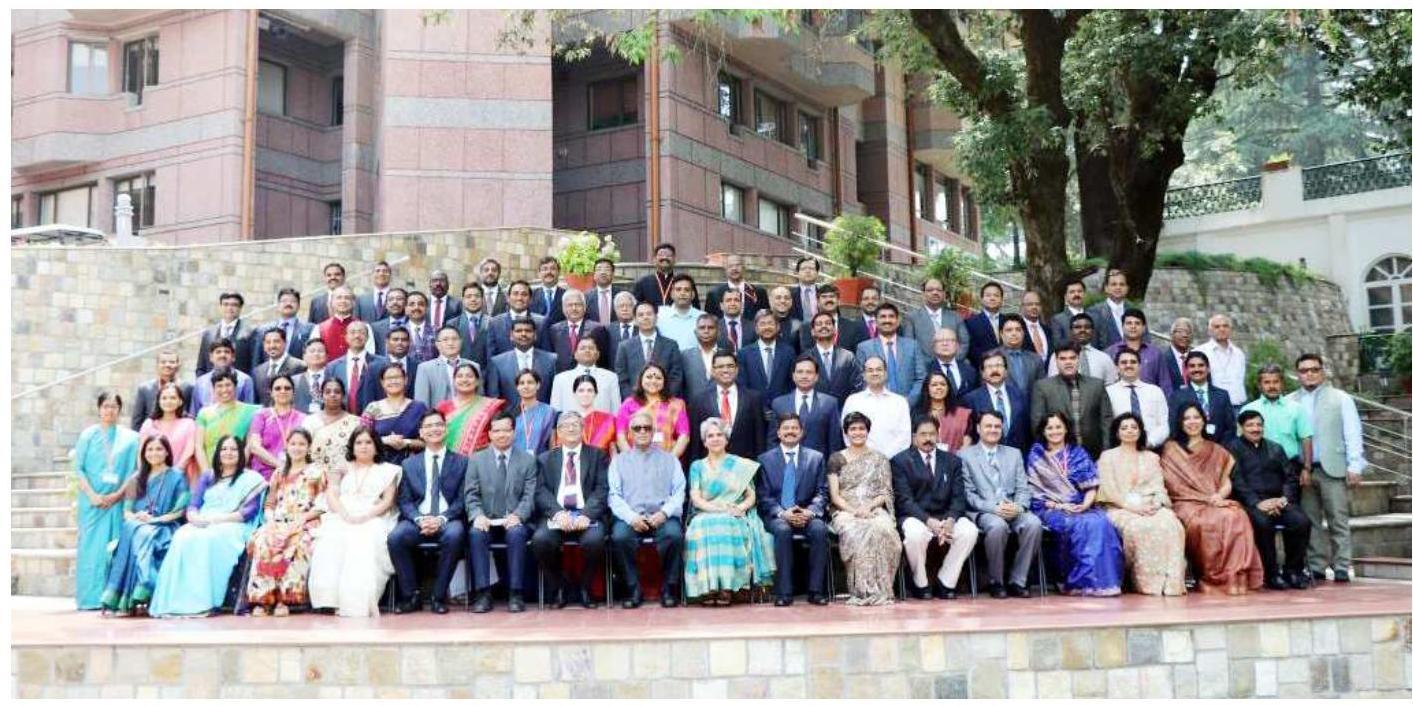
Group Photo of IAS Phase-IV Course (12 th Round)
Phase V Course (11 th Round- 3 Weeks)
8.15 The Phase V Course aims at developing strategic leadership skills in senior level IAS Officers (27-30 years seniority) for effective
inter-sectoral policy formulation and strategic leadership in government. 82 officers underwent the training course organized at the Academy from September 25 to October 13, 2017.
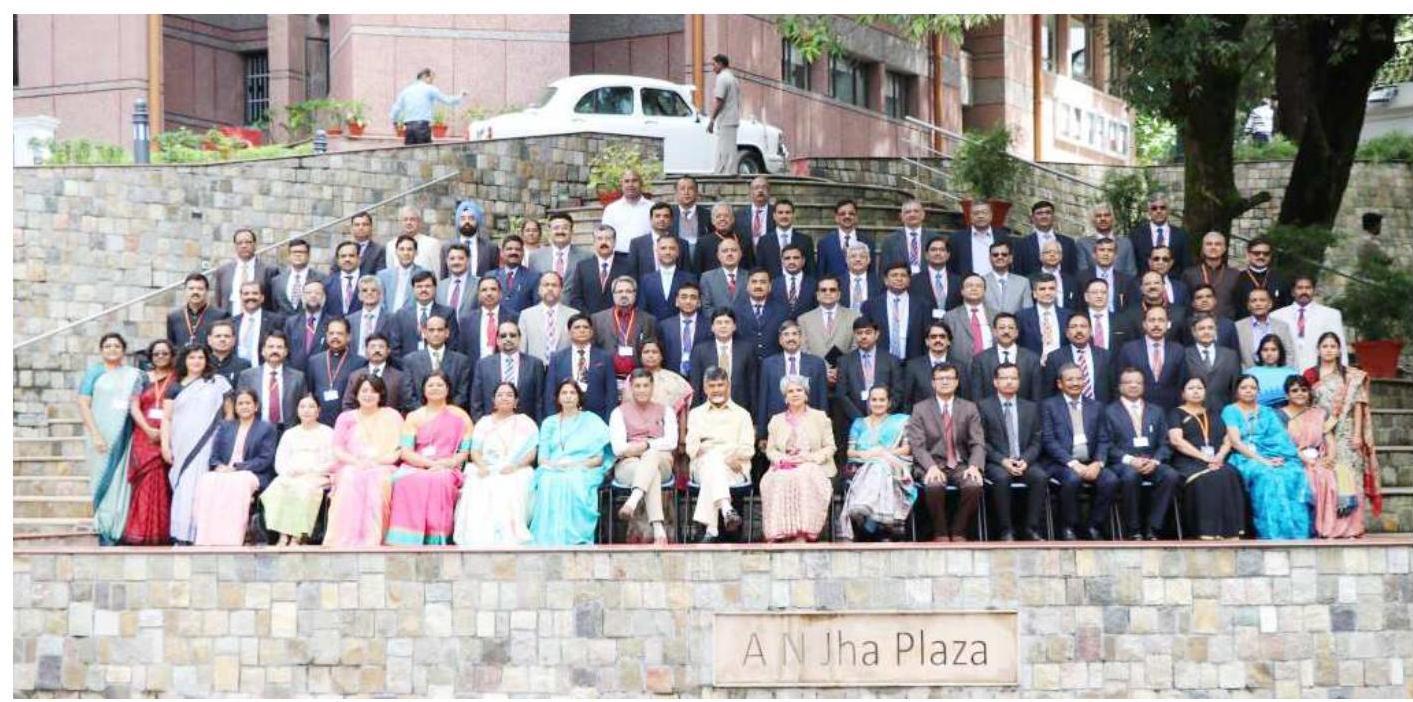
Group Photo of IAS Phase-V (11 th Round)
Other In- Service Training Courses/ workshops/ seminars
8.16 The Academy annually conducts short duration courses (ranging from one to two weeks) on a variety of subjects such as Joint CivilMilitary Course on National Security, Courses on Gender, Disaster Management, etc.
Golden Jubilee Reunion
8.17 The Academy organizes a reunion every year for Officers who joined the service 50 years ago. The first was held in 1997, the Golden Jubilee Year of the new nation, where the ICS and IAS Officers, who were in service at the time of independence, participated. Since then, the retired officers are called every year for a period of two-three days to share their
rich experience with the faculty and Officer Trainees. The Golden Jubilee Reunion for 88 officers of the 1967 batch (from various civil services who underwent FC at the Academy) was organized on May 26-27, 2017. TheReunion commenced with the inaugural ceremony on May 26, followed by a group photograph in the A.N. Jha Plaza. The participants were taken for a walk around the Academy campus before lunch and post-lunch, there was a two hour interaction with the Officer Trainees of the Phase-II 2015-17. The participants also had a session in small groups wherein they deliberated on issues of importance for the civil services in the present context before the Reunion come to a close with the valedictory ceremony on May 27, 2017.
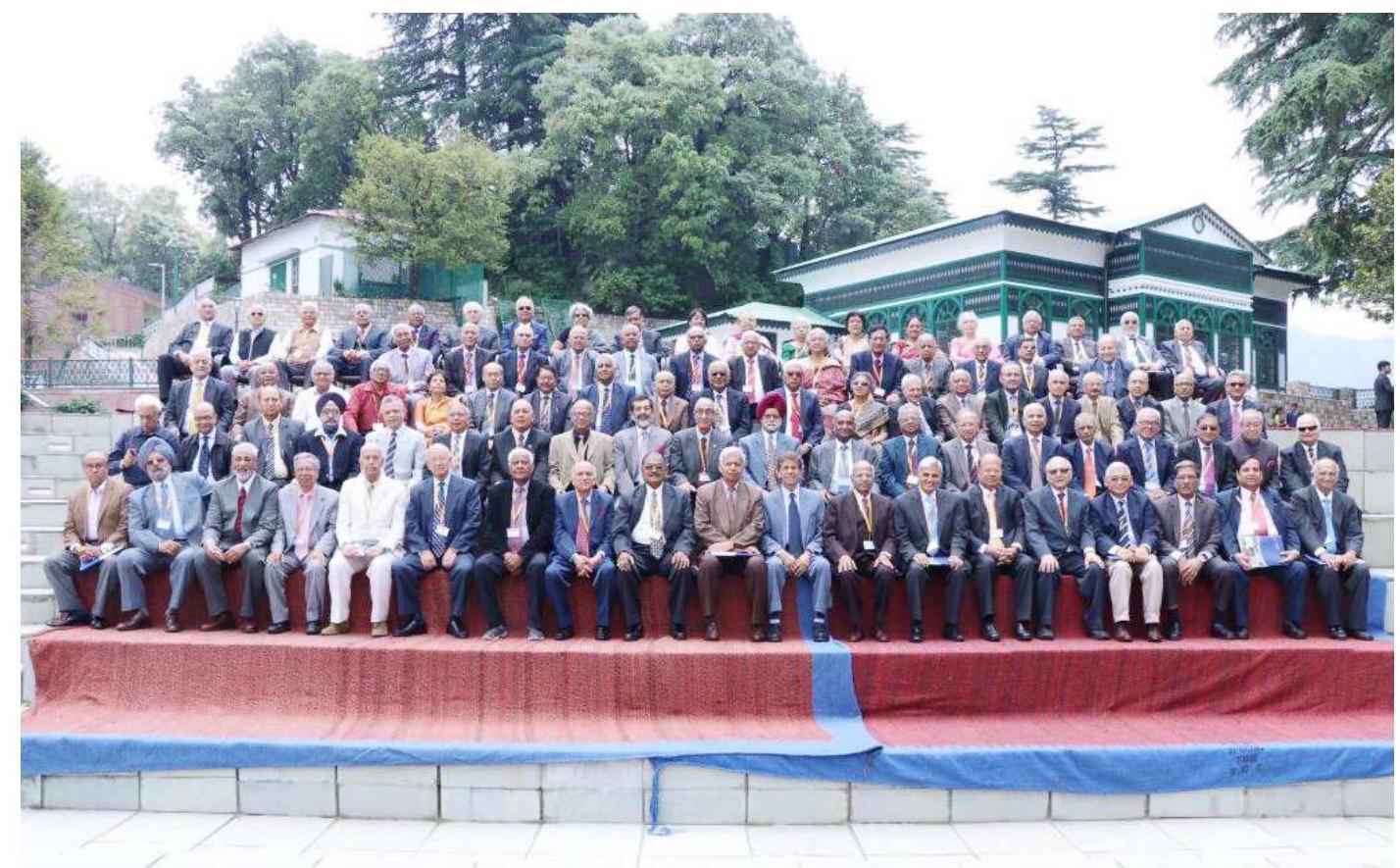
Golden Jubilee Reunion of 1967 Batch
Joint Civil Military Training Program
8.18 The Joint Civil-Military Programme on National Security was initiated in the year 2001 following the recommendations of GoM on National Security pursuant to the Kargil Review Committee with the aim of fostering structured interface between Civil Servants and Armed Forces officers for a shared understanding of National Security. Participants are drawn from the Civil Services, Armed Forces, and the Central Armed Police Forces.
Research Centres in the Academy
8.19 The centres of the Academy have been established with an aim to provide an avenue for initiating research in key areas of governance both from policy as well as implementation perspectives. The research is supposed to feed into the training curriculum and provide it with fresh insights. These centres are mostly funded either by line ministries, like CRS, or are self-sustaining like the NGC and CDM and collaborate with various national and international funding agencies. Various Research Centres have been set up for undertaking action-research on domains linked to Academy’s mandate and to feed into training inputs. These are as follows:
Centre for Rural Studies (CRS)
8.20 The Centre actively works on two modules- Land Administration Module and Rural Development Module. The Modules were delivered as per the design approved by the Academic Counseling Members (ACM) for 180 IAS Officer Trainees of 2016 batch.
The Centre published ‘Land Reforms in India: Vol.13: Understanding Women’s Land Rights Gender Discrimination in Ownership’ and “Socio-Economic Profile of Rural India, SeriesIII, volume-2”. The Centre brings out a biannual journal ‘Journal of Land and Rural Studies’ which focuses on issues land administration and rural development.
Centre for Disaster Management (CDM)
8.21 Ministry of Home Affairs, Government of India assisted the Academy in setting up the Centre for Disaster Management for acting as a nodal institution for imparting training on various aspects of Disaster Management with special focus on Incident Command System. Apart from conducting training programs the centre has been involved in formulation of national strategy for adaptation of the global best practices to suit Indian conditions in the field of disaster management as well as other research projects related to Disaster Management and Climate Change. The Centre organized two short-duration training programmes on Disaster Management and Risk reduction for officers belonging to the IAS. In addition, it also provides inputs in various training courses on disaster management and climate change, use of IT, GIS applications in Disaster Management, conducting research projects, documentation of best practices, development of case studies, teaching materials etc. Centre has also initiated the publication of a journal titled “Disaster Response and Management with ISSN number (ISSN: 2347-2553) and an annual book titled “Disaster Governance” with ISBN number (ISBN-.978-81-928670-1-4) apart from the other research publications.
National Gender Centre (NGC)
8.22 The Centre was established in 1995, with the foremost aim of mainstreaming gender and child rights in policy, programme formulation and implementation in Government. NGC is a capacity building centre under the aegis of the Academy, driven by the mandate of gender mainstreaming and its commitment to build synergies with different institutions, working on gender equality, child rights and women’s empowerment.
8.23 Working towards that end, the Centre, since inception has been actively involved in designing and conducting thematic workshops, programmes and trainings including Training of Trainers for trainers and policy makers – both to enhance gender sensitization but also to increase capacities for gender analysis and gender planning. Since its establishment, the Centre has successfully ensured the mainstreaming of gender training into all courses at the LBSNAA viz. induction trainings and in-service mid-career training programmes for IAS officers at all levels besides conducting programmes on myriad aspects for officers from All India/ Central Services.
8.24 In 2017-2018, the following projects/activities were done:
A. UN-Women Project “From Opportunities to Capacities:A MultiSectoral Approach to Enhancing Gender Responsive Governance”: The programme aimed to strengthen capacities of national and sub-national governments for gender responsive design and implementation of key schemes and policies, so as to ensure better outcomes for women. This is being operationalized by strengthening key capacity development institutions (such as the Administrative Training Institutes (ATI), National Institute for Rural Development & Panchayati Raj (NIRD\&PR) and State Institutes for Rural Development \& Panchayati Raj (SIRD\&PR) to mainstream gender responsive governance in their programmes and curricula. Under the project following programmes were held:
- Training of Trainers for “Gender Responsive Governance-an Orientation Course” held from 10- 15 July, 2017
- Training of Trainers on Gender Responsive Governance- an Orientation Course for ATI’s held from 11 – 15 September, 2017
- Training of Trainers – an Advanced Course on Gender Responsive Governance held from 13 – 17 November, 2017
B. UNICEF Project: A handbook on implementation of Juvenile Justice Act, 2015, is developed for the administrators. The handbook consists of Acts/ Rules, Frequently Asked Questions, illustrations/case studies and best practices. This will familiarize the administrators with the Act itself, the corresponding rules and schemes that would assist in better implementation of the Act and best practices from across the country.
Centre for Public Systems Management (CPSM)
8.25 The Centre for Public Systems Management was set up in 2016 by reconstituting the existing National Centre for Sustainable Community Systems (NCSCS) for more broad-based coverage of issues in public systems and their management.
The LBSNAA also propose to organize the following Training of Trainers Courses during January to March 2018:
- ToT on Case study writing – January $8-12$
The Academy Spirit
8.26 LBSNAA seeks to imbue civil servants with the required attitude and values expected in public service. The skills and knowledge required by a professional civil servant are relatively easier to impart, and these have traditionally been the strength of the Academy. However, to positively influence in the brief period available to us, the attitudes and values of intelligent young persons in their mid-twenties and thirties, coming from diverse backgrounds, is a more challenging task.
8.27 It is generally argued that for public service one needs integrity, moral courage, empathy with and respect for the underprivileged, and freedom from any sectarian prejudices based on religion, region, caste, class or gender. To nurture these values, Officer Trainees are encouraged to participate in diverse social activities. They are given responsibilities for improving the Lalita Shastri Balwadi School, where LKG/UKG & Class-I
are conducted at a concessional rate for the children of the employees and the public besides conducting regular coaching classes for poor students of the neighborhood. Officer Trainees also do shramdaan to clean their premises and to instill a dignity of labour. Emphasis on caring for the poor, listening to the people, providing safety nets for the vulnerable, and being open and transparent runs as a continuous thread in all the courses and interactions. In addition, Trainees are divided into counselor groups where they are able to articulate their views in an open and frank atmosphere. This forum serves as a great means of eliciting their views and conveying the right messages to them.
The Academy as Alma Mater
8.28 All Officer Trainees in the All India Services and Central Services begin their careers from the proverbial “gaumukh” of the civil service, the Lal Bahadur Shastri National Academy of Administration at Mussoorie. As a result, this institution provides a foundation that paves the way for lifelong professional and personal associations among officers across different civil services. These officers look back to the Academy with great nostalgia and also draw inspiration from the values and ideals instilled in them during their formative years.
Facilities
8.29 The Academy is well-equipped with good training infrastructure in terms of academic buildings, classrooms, hostels and other support infrastructure. Some of the key infrastructure facilities are given below:
- Academic & Administrative Blocks
- Karmashila
- Dhruvshila
- Gyanshila
- Aadharshila
- Gandhi Smriti Library – stocks 1.71 lac books, 279 journals and 7 e-resources databases
- Officers Mess – can cater to around 500 persons at 3 locations
- Sports – well-equipped Officers Club, Riding Ground and Shooting Range
- Health – well-equipped Medical Centre
- Executive Hostels – 4 executive hostels with 167 rooms
- Officer Trainee Hostels – 3 hostels with 131 rooms
- Wi-fi campus
Faculty
8.30 The Faculty comprises a healthy blend of senior administrators and academicians and researchers. The administrators combine the richness of their field experience with strong academic achievements to provide a stimulating atmosphere for learning. The Academy is presently headed by the Director Smt. Upma Chawdhary, IAS, an officer of the 1983 batch of Himachal cadre in the rank of Secretary to the Government of India.
INSTITUTE OF SECRETARIAT TRAINING AND MANAGEMENT
Introduction
8.31 The Institute of Secretariat Training and
Management (ISTM) is imparting training to the officers of the Central/State Governments, Public Sector Undertakings \& Autonomous Bodies. Originally set up with the objective of conducting foundational and in-service training programmes for Assistants and Section Officers of the Central Secretariat, the range of the activities of the Institute has increased exponentially over the last seven decades. In addition to the in-house training programmes, the Peripatetic Training provided by the Institute to the officials of State Governments and Union Territories in Behavioral Skills, Management Techniques, Financial Management and Office Management, are of particular significance. On specific request from Central Government Departments, Autonomous Bodies, Public Sector Organizations, the Institute also organises special programmes addressed to the specific customer needs in different areas.
8.32 From the year 2007-08, ISTM is also involved in implementation of the Central Secretariat Service Cadre Training Plan (CSS-CTP) and from 2011 onwards Central Secretariat Stenographer’s Service Cadre Training Plan (CSSS-CTP), which envisages mandatory training programmes having linkages with career progression up to Director level officers.
Training Programmes
8.33 ISTM conducts following programmes in various categories:
(a) Foundational and in-service Courses conducted as per new CSS and CSSS Cadre Training Plan
(b) Induction Training for Group ‘A’ Services of ICoAS, and Director General Civil Aviation (DGCA).
(c) Induction Training Component for various Group ‘A’ service like IAS,IFS, IRS, ISS, IES, ITS, ICLS, IDES, IIS & IRTS probationers.
(d) Personnel Administration and Office Management
(e) Financial Management
(f) Management Services
(g) Behavioral Training
(h) Training of Trainers
(i) Peripatetic Training Programmes
(j) Right to Information
(k) Prevention of Sexual Harassment of Women at Workplace
(l) Citizen Centric \& Service Delivery Approach
(m) Organization Specific Programmes/ Cadre Specific Programmes
(n) Capacity Building Programmes for North Eastern States sponsored by Department of Personnel \& Training
(o) Orientation Training Programmes on Office Procedure for IAS Officers sponsored by DOPT.
(p) Newly introduced training programmes on Swatch Bharat Abhiyan, Analytics of Big Data, e-Office, MS-Access, MSExcel (Advanced), Goods and Services tax (GST) and e-Procurement including Government e-Marketplace (GeM under GFR- 2017).
8.34 Number of Training programme and Training weeks scheduled and conducted during 2017-18 (As on 10.11.2017)
| Table 1 | |||
|---|---|---|---|
| S. No. |
Programme | No. of Programmes |
Training weeks |
| 1. | Number of programmes scheduled during 2017-18 |
307 | 515 Weeks 4 days |
| 2. | Programmes Conducted during 2017-18 from 01.4.2017 to 10.11.2017. |
192 | 239 Weeks 1 days (5976 trainees) |
| 3. | Programme scheduled to be conducted during 2017-18 from 11.11.2017 to 31.03.2018 |
115 | 276 Weeks 3 days |
8.35 No Foundational Training Programmes for Assistant Section Officer Direct Recruit (ASO-DR) and Stenographers Direct Recruit (SDR) have been conducted during 2017-18 (As on 10.11. 2017) due to nondeclaration of results of CGLE and Steno Grade
‘C’ \& ‘D’ examination, 2016.
8.36 Special Programmes for Officers of DoPT
(a) Two Special Training Programmes for 163 IAS officers sponsored by
Department of Personnel & Training on Office Procedure were conducted during 2017-18 on $7^{\text {th }}$ and $14^{\text {th }}$ July, 2017.
(b) 30 one-hour training programmes were conducted for officials of Department of Personnel \& Training at North Block, New Delhi, on ‘Financial Management, and ‘Report Writing (except APAR)’ as on $10^{\text {th }}$ November, 2017.
Other Training Programmes
8.37 94 Organization/Cadre Specific Programmes were conducted for various Central Ministries/Departments, States, UTs, Public Sector Undertakings (PSUs) and Autonomous bodies (up to 10.11.2017). 43 more Organizations/Cadre specific programmes are planned (from 11.11.2017 to 31.03.2018). One Capacity Building Training Programme for State Administrative Training Institute, Nagaland for North Eastern States (20 Participants) was conducted from 26.04.2017 to 28.04.2017.
Peripatetic Programmes
8.38 32 Peripatetic Programme have been planned during 2017-2018 for the officers of the Government of Arunachal Pradesh, Chandigarh Administration, Andaman \& Nicobar Administration and Puducherry Administration. 11 PT Programme have been conducted (up to 10.11.2017) and remaining PT Programmes are scheduled to be conducted during the period from 11.11.2017 to 31.04.2018.
International Training Programme (ITP)
8.39 One International Training Programme (ITP) on Administration was conducted from $11^{\text {th }}$ to $14^{\text {th }}$ September, 2017 for Government officials from Myanmar.
Consultancy Projects
8.40 ISTM is also engaged in the research and consultancy projects. The consultancy projects relating to following Government Departments/Organizations have been conducted / ongoing at present: –
(a) Consultancy projects completed till 10th November, 2017
i. Review of Rules, Regulations and Recruitment Rules of Gandhi Smriti and Darshan Samiti (GSDS) (Completed in June, 2017).
ii. Audit of proactive disclosure under RTI Act, 2005 for Department of Space, ISRO (Completed in May, 2017).
iii. Work Study for Delhi Public Library (DPL) (Completed in October, 2017)
(b) Ongoing Consultancy Projects and Audit of proactive disclosure under RTI Act, 2005
(i) Re-structuring Work Study for Farakka Barrage Project, Ministry of Water Resources (MOWR)
(ii) Consultancy project for work study \& re-structuring of nonteaching cadre in the Kendriya Vidyalaya Sangthan (KVS).
(iii) Review of Recruitment Rules for Indian Institute of Foreign Trade (IIFT).
(iv) $3^{\text {rd }}$ Party Audit of proactive disclosure under RTI Act, 2005 for Central Administrative Tribunal (CAT)
(v) $3^{\text {rd }}$ Party Audit of proactive disclosure under RTI Act, 2005 for Prime Minister’s Office (PMO)
New Initiatives
Inclusion of additional online registration module in Training Management Information System (TMIS)
8.41 The Training Management Information System (TMIS) project was initiated in the year 2011-12 and it has become operational from April, 2013 for the work pertaining to Co-ordination and Administration sections. As a part of further development under TMIS, online feedback system, guest faculty updation & statistical information have been enabled and implemented in the system during 201718. Software updation and online booking of hostel accommodation facility are ongoing projects under TMIS.
8.42 Special Training Programmes/ Sessions/ Workshops/ Seminars
i. A one-day Workshop on Sexual Harassment of Women at Workplace (Prevention, Prohibition and Redressal) Act, 2013 was organized on 5th May, 2017 in ISTM. This was a collaborative programme between Ministry of Women and Child Development and ISTM. It was attended by the Presiding
Officers of Internal Complaints Committee (ICC) of all Central Ministries and Departments. The Programme was inaugurated by Hon. Union Minister of Women and Child Development, Smt. Maneka Sanjay Gandhi.
ii. International Yoga Day was celebrated in ISTM on $21^{\text {st }}$ June, 2017.
iii. A special training session was conducted on “Verification of e-service Book” by officials of DOPT on $22^{\text {nd }}$ June, 2017.
iv. A Seminar on “Knowledge Economy and Intellectual Property Rights” was organised on $29^{\text {th }}$ July, 2017.
v. An Induction Training Programme was conducted for Chief Vigilance Officers of Central Vigilance Commission from $11^{\text {th }}$ to $22^{\text {nd }}$ September, 2017.
vi. One-day Workshop for stakeholders \& State ATIs and SIRDs to review design \& logistics field training component of Level ‘D’ programme was organised on $13^{\text {th }}$ October, 2017 at ISTM.
vii. One-day Seminar on Healthcare Sector and New Health Policy (Issues \& Challenges) was conducted on $28^{\text {th }}$ October, 2017 by Dr. Vipul Sood, Medical Director, Batra Hospital, New Delhi and Dr. Ajit Nagpal, Chairman, Amity Pacific Forum, New Delhi.
viii. A Special Session was conducted on “My vision: Corruption free India” in view of vigilance awareness week on $3^{\text {rd }}$ November, 2017. The session was presided by the Director, ISTM.
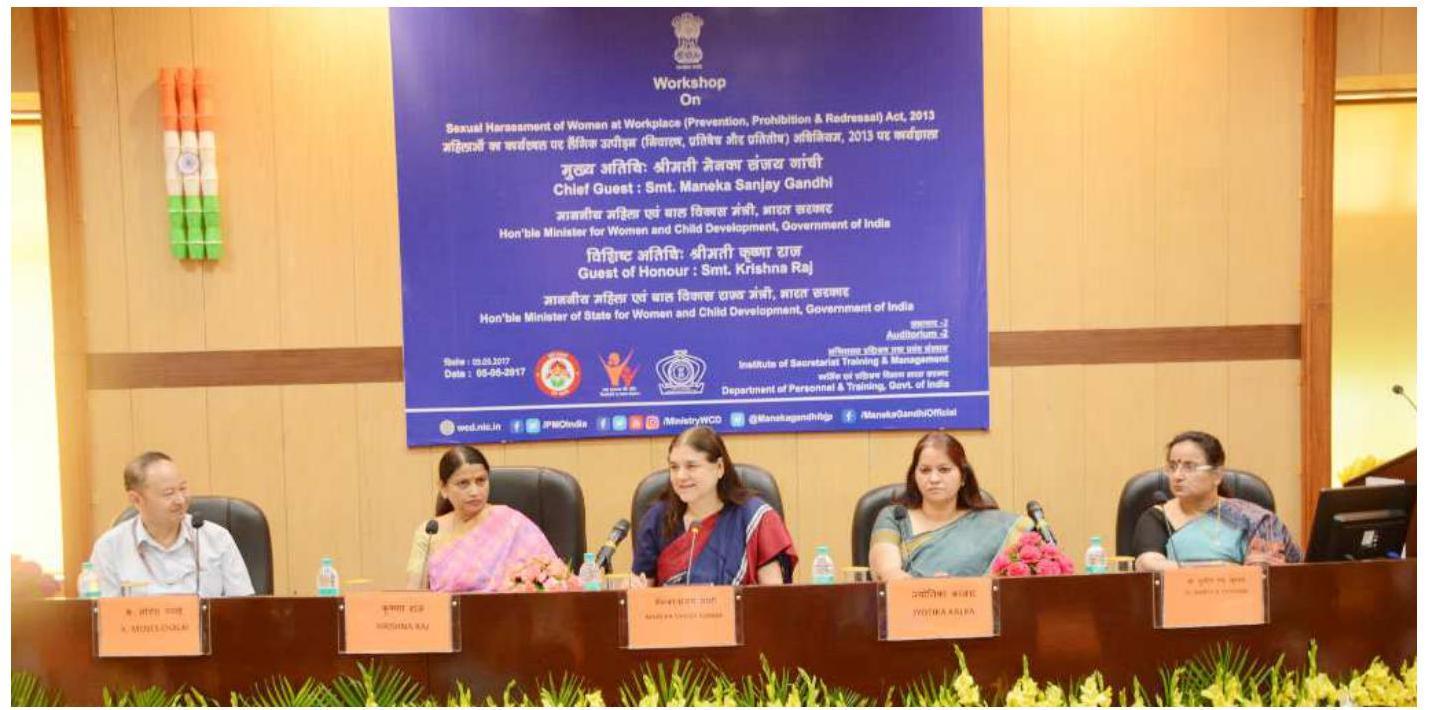
Workshop on Sexual Harassment of Women at Workplace (5 $5^{\text {th }}$ May, 2017)
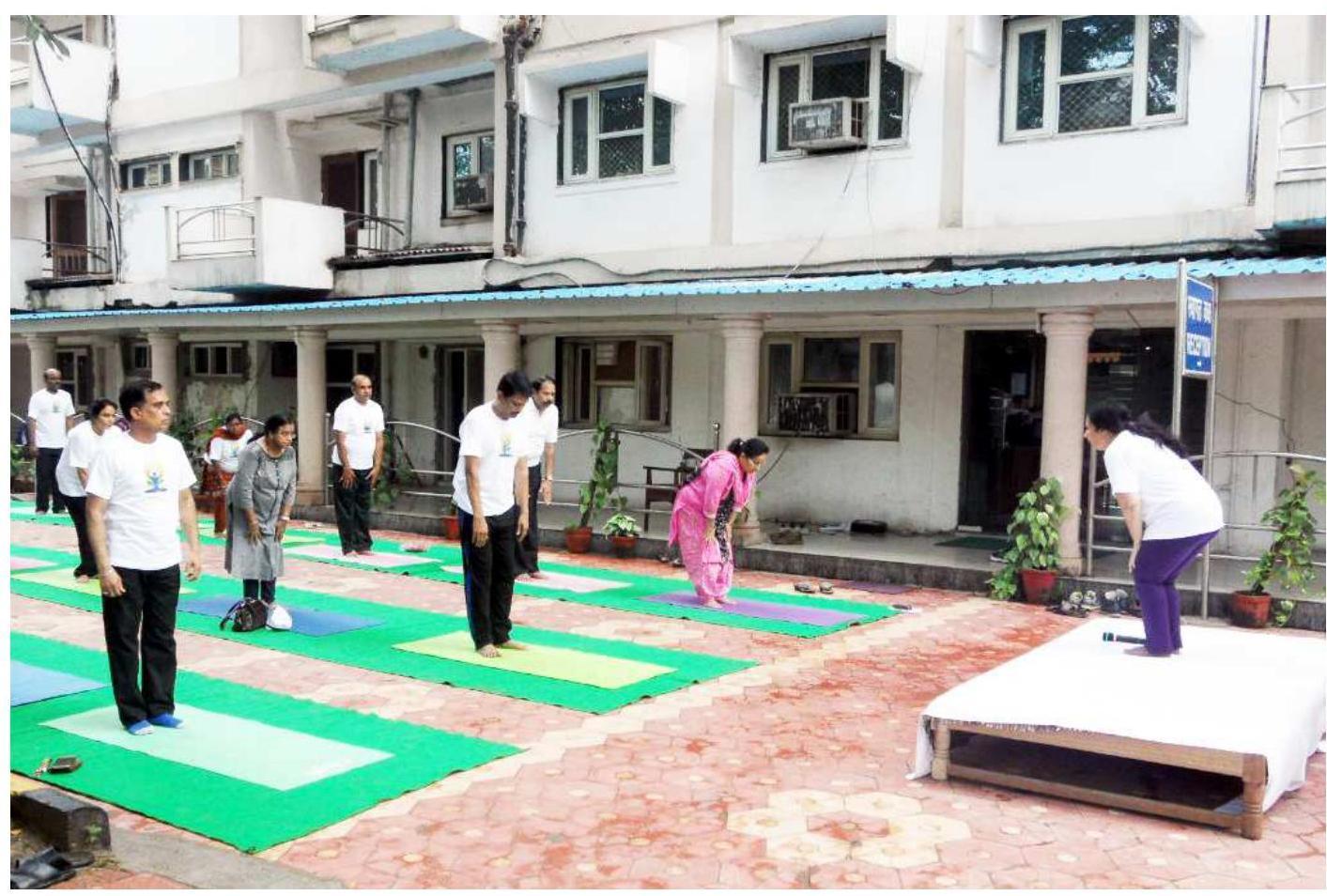
International Yoga Day Celebration (21st June, 2017)
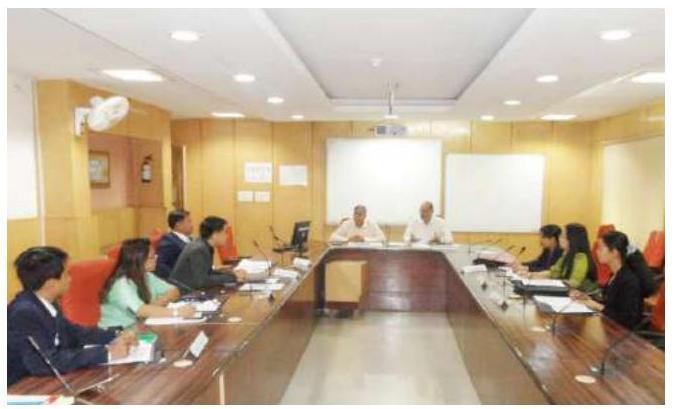
International Training Programme for Myanmar Officials (11-14 September, 2017)
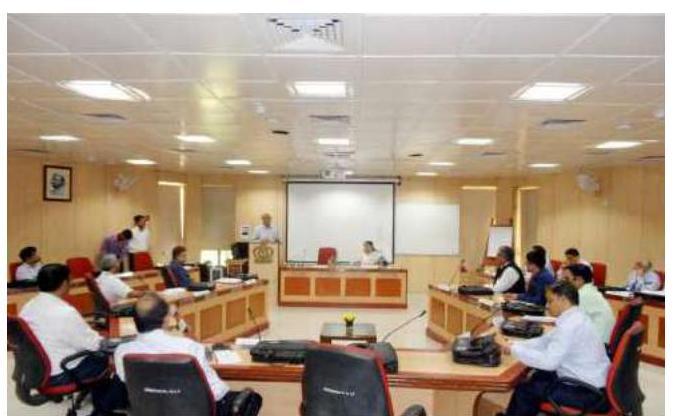
Special training programme for CVOs/CVC from 11-22 September, 2017
8.43 New Initiatives in Training during the year 2017-18
(i) Introduction of two-day Workshop on Analytics for Big Data in Government.
(ii) Introduction of three-day Workshop on Public Procurement under GFR2017
(iii) Introduction of one-day Orientation Training programme on GFR-2017
(iv) Introduction of one-day training on ‘Swatch Bharat Abhiyan”
(v) Introduction of two-day workshop on e- Office.
(vi) Introduction of one-day Orientation Training Programme on Goods & Services Tax (GST).
(vii) Introduction of two-day workshop on Goods \& Services Tax (GST).
(viii) Introduction of sessions on GST in various training programmes to create awareness among the trainees on the subject.
(ix) Introduction of a ‘Hands on’ training Module on Government e-Marketplace (GeM) in training programmes relating to public procurement.
(x) Input on Usage of Space Technology and Swatch Bharat in all CSS/CSSS training programmes.
(xi) Introduction of three-day MS-Access Training Programmes,
(xii) Introduction of three-day MS-Excel (advanced) Training Programme
(xiii) Introduction of online feedback system for all training programmes through Training Management Information System (TMIS) in ISTM.
(xiv) ISTM got ISO: 9001:2015 Certification in May, 2017, in the area of training activities.
8.44 Infrastructural Development
The following infrastructural facilities have been undertaken at ISTM during 2017-18: –
(i) Installation of Fire Fighting and Fire Alarm System including Public Address (PA) System.
(ii) Replacement of Electrical panels in Library Building
(iii) Installation of Security system in Administrative Block, Seminar hall complex, Library Building and Hostel Block of ISTM.
(iv) Upgradation of ICT Lab and setting up of one more Laboratory having capacity of 35 computers with all facilities.
(v) Repair, rehabilitation and sprucing up of Library Building in ISTM.
(vi) Procurement of Class room furniture, Billiards table.
(vii) Renovation of four guest rooms on ground floor in Hostel Block.
Blood Donation
8.45 During the year, four blood donation camps were organized from 01.04.2017 to 10.11.2017 at ISTM Campus, in which, 126 trainees and members of faculty donated blood.
Public Service
8.46 The trainees (present and past) and also some of the faculty members visit at regular
intervals to Rain-Baseras and Dharmashalas of major hospitals of Delhi and arrange for medicines, radiological and pathological tests to the poor patients as prescribed by doctors. In winters, they also distribute woolen blankets/ clothes in the odd hours of the day to the really needy people. Through these initiatives it is expected that these officials/officers will be able to develop a positive attitude which is expected to be reflected in their peoplefriendly, responsive and sensible approach at work.
People Connect Forum
8.47 ISTM has developed a “people connect” portal and hosted on its website. The platform provides opportunity to the participants (present & past) and other Central Government employees to disseminate information, share knowledge and experience on various issues regarding rules and their interpretation etc.
8.48 ISTM has been continuously upgrading its infrastructure and skills to match with the changes taking place outside, under the guidance and support from Department of Personnel and Training. The tasks and the targets assigned by DoPT are being achieved by ISTM despite faculty constraints.
Administrative Vigilance Division
9.0 Administrative Vigilance Division-I is responsible for examination of disciplinary cases in respect of Indian Administrative Service officers working under the Central Government. The Division also processes cases referred by the State Governments and Ministries / Departments under Government of India on the following issues:
- Proposals from State Governments seeking to impose major penalty of dismissal / removal / compulsory retirement on members of IAS;
- Proposals from State Governments seeking permission under the AIS (DCRB) Rules to initiate action against retired members of IAS;
- Proposals from State Governments for imposing penalty of cut in pension against IAS officers;
- Proposals to initiate disciplinary proceedings/suspension of IAS officers working under the Government of India;
- Appeal against suspension submitted by IAS officers serving in the States;
- Requests for sanction for prosecution under the Prevention of Corruption Act, 1988 against the above categories of officers;
- Advice / clarification to the State Governments / Departments on the Procedural aspects of disciplinary proceedings;
- Provides information regarding vigilance status of IAS officers at the time of their empanelment / training / posting on deputation etc. To facilitate this function, a Computerized Vigilance Information System is in operation with a central data base which can be accessed by the requisitioning Divisions concerned of this Department;
- Handling of Privilege Notices and Complaints from Members of Parliament against IAS Officers received from the Lok Sabha / Rajya Sabha Secretariat.
Disciplinary Proceedings & Sanction for Prosecution
9.1 Final orders in disciplinary proceedings were issued in 05 cases during the period 01.04.2017 to 30.10.2017.
Orders of sanction for prosecution under Prevention of Corruption Act, 1988 against IAS Officers were issued in 07 cases and sanction was denied in 02 cases during the period 01.04.2017 to 30.10.2017.
Complaints against IAS officers
9.2 During the period 01.04.2017 to 30.10.2017, 360 complaints were received, 320 were processed and 285 complaints were finally disposed of.
Privilege Notices and Complaints from Members of Parliament against IAS officers
9.3 During the period 01.04.2017 to 30.10.2017, 06 notices were received from the Lok Sabha / Rajya Sabha Secretariat and processed and 01 was finally disposed of.
Monitoring of Proposals of Sanction for Prosecution under provisions of Prevention of Corruption Act, 1988.
9.4 In terms of para 2(ix) of DoP&T O.M. No.399/33/2006-AVD-III dated 06.11.2006, the delayed cases of sanction for prosecution were reviewed by the Committee chaired by the Secretary (Personnel) on 08.05.2017.
9.5 Administrative Vigilance Division-I is also responsible for examination of disciplinary cases received from the Ministries / Departments in respect of Group ‘A’ and above level officers of the Central Secretariat Service (CSS) and Central Secretariat Stenographers Service (CSSS) for initiation of disciplinary proceedings under Rule 14 (major penalty), Rule 16 (Minor penalty), Rule 19 of CCS (CCA) Rules, 1965 and under Rule 9 of CCS (Pension) Rules.
9.6 Orders of sanction for prosecution under Prevention of Corruption Act, 1988 against Group A officers of CSS and CSSS cadre were issued in 02 cases during the
period 01.04.2017 to 30.10.2017. Complaints received against the Group ‘A’ officers of CSS and CSSS are being forwarded to the Ministry /Department concerned.
Disagreement cases in disciplinary matters
9.7 In order to bring about greater uniformity in existing disciplinary cases on behalf of the President, in cases where the President is the disciplinary authority and there is a difference of opinion between the CVC and the concerned Department, the Departments are required to consult the DoPT before taking a decision on not to accept the CVC’s advice. Similarly, disciplinary cases where Central Vigilance Commission advises major penalty and the UPSC favours a minor penalty or recommends exoneration, before the Disciplinary Authority takes a final view, the matter is to be referred to this Department for resolving the disagreement. This Division has disposed of 08 such cases, between 01.01.2017 and 31.12.2017 (Appendix -I).
Disagreement in the matter of Prosecution Sanction cases
9.8 Similarly, the cases of disagreement between the CVC/CBI and Sanctioning/ Disciplinary Authority in the matter of Prosecution sanction cases are required to be referred to DoP\&T for a final decision in terms of this Department’s OM dated 6th November, 2006. This has been modified vide DoP\&T’s OM No. 372/19/2012-AVD-III dated $3^{\text {rd }}$ May, 2012 providing that final decision for grant or denial of sanction for prosecution shall be taken by the Competent Authorities
concerned even in cases they decide to differ with CVC’s advice after obtaining views of DoPT. Accordingly, the views of DoP&T may be taken into account while passing final speaking order. This Division has disposed of 01 such case, between 01.01.2017 and 31.12.2017 (Appendix-II).
Central Vigilance Commission
Introduction
9.9 The Central Vigilance Commission is the apex integrity institution mandated to fight corruption and to ensure integrity in administration. It is a statutory multi member body vested with the superintendence of vigilance administration in the Central Government and its organisations. The Commission also endeavours to create awareness amongst civil society and the public at large towards achieving transparency, accountability and corruption free governance with its outreach measures.
Statutory Provisions
9.10 The Central Vigilance Commission (CVC) was set up by the Government of India through a Resolution vide No. 54/7/64 dated 11.02.1964 and was accorded statutory status by the Central Vigilance Commission Act, 2003 (No. 45 of 2003), notified in the Gazette of India Extraordinary on 12.09.2003.
9.11 The Commission is empowered to inquire or cause inquiries to be conducted into offences alleged to have been committed under the PC Act 1988 by specified categories of public servants and in terms of clause
(b) of sub Section (2) of Section 8 of the Central Vigilance Commission Act, 2003 and subsequent notifications issued vide $18^{\text {th }}$ March 2004 and $12^{\text {th }}$ September 2007.
The specified categories of officers are the following:
- $\quad$ Members of All India Services serving in connection with the affairs of the Union and Group ‘A’ officers of the Central Government;
- Chief Executives and Executives on the Board and other officers of the level of E-8 and above in Schedule ‘A’ and ‘B’ Public Sector Undertakings of the Central Government;
- Chief Executives and Executives on the Board and other officers of the level of E-7 and above in Schedule ‘C’ and ‘D’ Public Sector Undertakings of the Central Government;
- $\quad$ Officers of the rank of Scale V and above in the Public Sector Banks;
- $\quad$ Officers in Grade ‘D’ and above in Reserve Bank of India, NABARD and SIDBI;
- Managers and above in respect of General Insurance Companies;
- $\quad$ Senior Divisional Managers and above in Life Insurance Corporation of India; and
- $\quad$ Officers drawing grade pay of Rs 8700/- per month (pre-revised) and above on Central Government DA pattern, as may be revised from time to time, in societies and local authorities
owned or controlled by the Central Government.
9.12 The Commission exercises superintendence over the vigilance administration of the Ministries/Departments/Organisations of the Central Government.
9.13 The Commission is mandated to exercise superintendence over the functioning of CBI and monitoring cases taken up by CBI for investigation under PC Act.
9.14 The Central Vigilance Commission has been designated as the agency to receive and act on complaints or disclosure on any allegation of corruption or misuse of office from whistle blowers under the “Public Interest Disclosure and Protection of Informers’ Resolution” (PIDPI), 2014, which is popularly known as “Whistle Blowers” Resolution. The Commission is also empowered as the designated agency to take action against complainants making motivated or vexatious complaints.
9.15 The Commission conducts its activities concerning inquiry or causing inquiry through the Chief Vigilance Officers (CVOs), who are the extended arms of the Commission.
9.16 As per Section 14 of the CVC Act, 2003, the Commission submits an Annual Report of its activities to the President within six months of the close of the year under report. The report also contains a separate part on the functioning of the Delhi Special Police Establishment (DPSE) in so far as it relates to sub-section (1) of section 4 of the DSPE Act, 1946 (25 of 1946).
Multi Pronged Strategy of the Commission to combat Corruption
Punitive, Preventive and Participative Vigilance
9.17 As a part of its multi pronged strategy the Commission has been stressing on not just punitive but preventive and participative vigilance measures to combat corruption.
Punitive Vigilance
9.18 As far as punitive vigilance is concerned, the Commission feels that time-bound and effective punitive action resulting in award of exemplary and adequate punishment deters others from committing such misconduct. It tenders advice on issues referred to it by various organisations, it reviews the progress of work periodically through the mechanism of annual sectoral reviews and other meetings, it guides the Chief Executives and the CVOs of various organizations on issues pertaining to vigilance, it seeks organizational responses and suggests systems improvement in areas attracting complaints, conducts direct inquiries on certain sensitive complaints and also summons officials for hearings on specific issues. All this is done as part of comprehensive effort for better vigilance administration.
The advisory role of the Commission extends to references received from Departments/ Organisations of the Central Government in individual cases of officers covered under its jurisdiction and consists of a two stage mechanism i.e. on investigation /inquiry reports before initiating disciplinary action termed as first stage advice and on completion
of disciplinary proceedings as to the nature of penalty or otherwise termed as second stage advice.
Preventive Vigilance
9.19 The Commission has been laying stress on the importance of preventive vigilance in curbing corruption. Preventive vigilance is broadly a package of measures to improve systems and procedures, to reduce discretion and public interface and thereby eliminate corruption. The Commission believes in the dictum – Prevention is always better than cure and therefore, it has been strongly focussing on identifying the loopholes in the system to pre-empt the occurrence of corruption. Although potential areas of corruption are specific to organisations/sectors, there are some broad areas common to all organisations, such as procurement, sale of goods and services, allocation of scarce natural resources, human resource management (recruitment, promotion, transfer and postings), delivery of services to the common citizen, implementation of rules and regulations which remain more susceptible to corruption. The generic measures to combat corrupt practices include simplification and standardization of rules, leveraging technology, rethinking the structure of core processes in order to better fulfil the objectives of the organization and enhance transparency and accountability, regular and effective inspections, periodical rotation transfer of staff, training and awareness of employees and public etc. The Commission believes that preventive vigilance measures will lead to better management and governance resulting in improved deliverance
of services and operational results. The thrust of the Commission on preventive vigilance has led to organisations revisiting their processes and has also led to many new initiatives and innovations. The Commission has shared initiatives of 20 selected organisations in the form of a booklet titled ‘Initiatives in Preventive Vigilance’ showcasing the best practices on preventive vigilance, for wider dissemination during the Vigilance Awareness Week, 2017.
Integrity Pact
9.20 The concept of Integrity Pact envisages an agreement between the prospective vendors /bidders and the buyers committing the persons / officials of both the parties, not to exercise any corrupt influence on any aspect of the contract. As part of this scheme, organisations are directed to appoint a panel of Independent External Monitors in order to ensure proper implementation of the Integrity Pact.
During 2017, the Commission has reviewed the Standard Operating Procedure for adoption of Integrity Pact vide circular No. 02/01/2017 dated 13.01.2017.
Integrity Index
9.21 The Commission is developing an Integrity Index based on bench marking of internal processes and controls within an organization as well as management of relationships and expectations of external stake holders.
9.22 The Integrity Index will bring out annual scores/rankings of Public Sector Undertakings/
Public Sector Banks and Financial Institutions/ Departments / Ministries of Government of India by linking the essential drivers of vigilance with long term efficiency, profitability and sustainability of public organizations and create an internal and external ecosystem that promotes working with Integrity in public organizations.
9.23 Central Vigilance Commission has adopted a research-based approach for creating an integrity index that various organizations can use to measure themselves and which will evolve with changing needs and with this view IIM-Ahmedabad has been engaged to develop the Integrity Index. Being a new initiative, initially 25 organizations have been selected for development of the Integrity Index. Subsequently, it is proposed to extend the Integrity Index concept to all other CPSUs and organizations of Government of India.
Participative Vigilance
9.24 Participative vigilance seeks engagement with the citizens to root out corruption from the country. The most notable participative vigilance measure of the Commission is the observation of the Vigilance Awareness Week every year with a specific theme to create awareness amongst citizens, stakeholders, private sector, especially among youth and students about the menace of corruption and the need for its eradication. This outreach activity across the country is conducted every year. During the week, all the Ministries/Departments, PSUs, Banks, etc. are engaged extensively, especially reaching out to schools and colleges, NGOs, etc. under
an action plan prepared by the Commission to spread awareness amongst the common citizens. The activities inter alia include organising workshops, seminars, debate, competition, slogan / essay writing, cartoon, painting contests, etc. at urban and suburban level such as school, colleges, institutes, etc. The Commission also encourages the organisations to conduct similar outreach activities throughout the year to keep the anti-corruption momentum alive and the officers of the Commission actively participate in such activities. The theme of the Vigilance Awareness Week, 2017 was “My VisionCorruption Free India” (“मेरा लक्ष्य – भ्रष्टाचार मुक्त भारत”).
9.25 The Vigilance Awareness Week commenced with the taking of the Integrity Pledge by Shri K.V. Chowdary, Chief Vigilance Commissioner, Shri Rajiv, Vigilance Commissioner, and Dr T.M. Bhasin, Vigilance Commissioner at the Inaugural Function at Vigyan Bhavan, New Delhi on 30th October 2017. The Hon’ble Vice President of India presided over the function.
9.26 Activities conducted within organizations included distribution of pamphlets/handouts on preventive vigilance activities, whistle blower mechanism and other anti-corruption measures, and conduct of workshops and sensitization programmes for employees and other stake holders on policies/ procedures of the organization and preventive vigilance measures. Other activities included publication of journals/newsletters on vigilance issues, systemic improvements and good practices adopted for wider dissemination and
awareness, conduct of various competitions such as debates, quiz etc. for the employees and their families on issues relating to anticorruption and the use of organizational websites for dissemination of employees/ customer oriented information.
9.27 Seminars, panel discussions and other outreach events were organised involving the private sector, professional associations, trade unions and associations for wide participation of all sections of civil society. Outreach activities for public/citizens included the display of hoardings, banners, posters and distribution of handouts etc. at prominent locations/places in offices/field units and also at places with public interface and conduct of grievance redressal camps for citizens/customers by organisations having customer oriented services/activities. “Awareness Gram Sabhas” were organized on a large scale for dissemination of awareness in Gram Panchayats (in rural and semi-urban areas) to sensitise citizens on the ill-effects of corruption. Public at large were encouraged to take the online “Integrity Pledge” developed by the Commission.
9.28 Marathons, walkathons, bicycle rallies, human chains, street theatre, etc., were also organised in various cities and towns across the country. Many organizations extensively used bulk sms/e-mail, Whatsapp, electronic, print and social media for spreading awareness.
9.29 Laying stress for creation of awareness on the ill-effects of corruption amongst school and college students, special efforts were made by each field unit/branch of public sector enterprises, nationalized banks and
other organisations to reach out to students in schools and colleges. In this regard, various activities such as lectures, panel discussions, debates, quiz, essay writing, slogans/elocution/ cartoon/poster competitions on moral values, ethics, good governance practices etc. were organized across the country.
9.30 A new feature introduced in 2017 was the establishment of ‘Integrity Clubs’ in schools and colleges, as children are the future assets of the country and it is important to cultivate moral values in them.
Vigilance Excellence Awards
9.31 To give recognition to the reforms and good work done by organizations in the field of punitive, preventive and participative vigilance, the Vigilance Excellence Awards have been instituted from the year 2017 onwards. The Hon’ble Vice President of India gave away the Vigilance Excellence Awards for good work done by both vigilance functionaries and management in the field of punitive, preventive and participative vigilance.
Training and Capacity Building
9.32 Another part of the intervention strategy emphasises capacity building for officials working in this area. For newly appointed CVOs, Induction Training is being imparted to provide suitable exposure to statutory rules and regulations and also to empower them to discharge their functions efficiently. Besides induction trainings, short-term thematic training and refresher courses are organised, both nationally and internationally to build professional competencies and inculcate
personal attributes by exposing the officers to courses on leadership development, stress management, ethics and values in public governance.
9.33 Another initiative of the Commission is the monthly lecture series in which eminent speakers/personalities are invited to deliver lectures. In 2017, 12 eminent speakers delivered lectures as part of the Commission’s knowledge management efforts wherein senior executives/public servants of the Government PSUs/Banks, etc. attended. These lectures were webcast by NIC to reach out to a wider audience across the country.
Vigilance Manual
9.34 The Commission released the $7^{\text {th }}$ edition of the Vigilance Manual in 2017, by Dr Jitendra Singh, Hon’ble Minister of State (PP) on $7^{\text {th }}$ September 2017 with updated instructions and regulations issued by various authorities like citations circulars, orders, rulings, etc. A separate Chapter has been introduced on Banking and Insurance in view of the specialized nature of work of the financial sector, for which there was a felt need for enumerating procedures related to vigilance. A new chapter on Preventive Vigilance has been added in view of the need for clearly laid down procedures, reengineering of cumbersome or ambiguous processes wherever necessary to ensure transparency and accountability in organizations. The outreach activity of the Commission in reaching out to various sections of society with a view to creating awareness about honesty and integrity too has been dealt with in the revised edition of the
manual. Other important new topics include the working of the Chief Technical Examiners’ Organization and the role of forensics in the audit of transactions.
Lokpal & Lokayuktas Act, 2013 (No. 1 of 2014) \& Rules thereunder
9.35 In order to meet a long standing demand to establish a mechanism for dealing complaints on corruption against certain public functionaries, including corruption at high places, the Government had constituted a Joint Drafting Committee on 08.04.2011, consisting of five nominee Ministers from Government of India and five nominees of Shri Anna Hazare (including Shri Hazare himself), to prepare a draft of the Lokpal Bill. Based on the deliberations of the Committee, and on the basis of inputs from Chief Ministers of States and political parties, a draft Lokpal Bill was prepared. The Cabinet at its meeting held on 28.07.2011 considered the draft Lokpal Bill, 2011 and upon approval by the Cabinet, the Lokpal Bill 2011 was introduced in Lok Sabha on 04.08.2011. The said Bill was referred to the Department Related Parliamentary Standing Committee on Personnel, Public Grievances, Law and Justice on the $8^{\text {th }}$ August, 2011 for examination and report.
9.36 The Department Related Parliamentary Standing Committee after extensive discussion with all the Stakeholders, in its $48^{\text {th }}$ Report, made a number of recommendations suggesting major amendments in the Bill both as regards the scope and content of the Bill, including that necessary provisions be made, in the Union legislation, for establishment
of Lokayuktas in the States, so as to provide leverage to the States where no such institution exists and to bring in uniformity in the laws relating to State Lokayuktas which are already in existence in a number of States. The Committee also recommended that Lokpal and Lokayuktas should be conferred Constitutional status.
9.37 Upon consideration of the recommendations of the Standing Committee, the Government withdrew the Lokpal Bill, 2011 pending in the Lok Sabha and introduced a new comprehensive Lokpal and Lokayuktas Bill, 2011 in the Lok Sabha on 22.12.2011 providing for establishment of Lokpal at Centre and Lokayuktas in States. Also, keeping in mind the recommendations of the Standing Committee that the Lokpal and Lokayuktas may be made Constitutional bodies, the Government also introduced $116^{\text {th }}$ Constitutional Amendment Bill, 2011 to provide for Constitutional status to these bodies.
9.38 These Bills were taken up for consideration by the Lok Sabha on 27.12.2011. The Lokpal and Lokayuktas Bill, 2011 was passed with certain amendments whereas the $116^{\text {th }}$ Constitutional Amendment Bill, 2011 could not be passed with requisite majority. The Lokpal and Lokayuktas Bill, 2011 was taken up for discussion and passing in the Rajya Sabha on 29.12.2011 but the discussion remained inconclusive. Subsequently, the Rajya Sabha adopted a motion on 21.05.2012 and referred the Bill to a Select Committee of the Rajya Sabha for examination and report. The Select Committee of Rajya Sabha submitted its
report to the Rajya Sabha on 23.11.2012. The recommendations of the Select Committee were examined and a proposal for moving official amendments to the Bill as reported by the Select Committee was considered and approved by the Cabinet in its meeting held on $31^{\text {st }}$ January, 2013. The Bill was finally passed by Rajya Sabha with amendments on 17.12.2013 and the Lok Sabha agreed to the amendments made by Rajya Sabha on 18.12.2013. The Bill as passed by both Houses received the assent of the President on 01.01.2014. The Act was brought into force with effect from $16^{\text {th }}$ January, 2014. The Lokpal and Lokayuktas Act, 2013 requires some amendments, interalia, so as to provide for situations where the composition of the Selection Committee is deficient/incomplete due to absence of Leader of Opposition in the Lok Sabha, etc. Accordingly, Lokpal & Lokayuktas and other related law (amendment) Bill 2014 was introduced in Lok Sabha on 18.12.2014. The same was referred to the Departmentrelated Parliamentary Standing Committee on Personnel, Public Grievances, Law \& Justice for examination \& report. The Committee has submitted its report in the Parliament on 07.12.2015. The recommendations made in the said report are presently under active consideration of the Government and the Inter Ministerial Committee (IMC) is seized of the matter. Meanwhile, the Government moved the Lokpal and Lokayuktas (Amendment) Bill, 2016 seeking amendment to only section 44 of the Act. The said Bill was passed by both the houses of Parliament and after the assent of President on 29.07.2016 has become an Act tilted “the Lokpal and Lokayuktas
(Amendment) Act, 2016″. This Amendment Act shall be deemed to have come into force on 16-01-2014.
Rules made under the Act
9.39 The Central Government, in exercise of powers conferred by sub-section (1) read with clause (b) of sub-section (2) of section 59 of the Lokpal and Lokayuktas Act, 2013, notified the Search Committee (Constitution, Terms and Conditions of appointment of members and the manner of selection of Panel of Names for appointment of Chairperson and Members of Lokpal) Rules, 2014 on $17^{\text {th }}$ January, 2014. A writ petition has been filed by Common Cause, a Registered Society, before the Supreme Court wherein, inter alia, challenge has been made to the validity of the said Search Committee Rules. During the course of hearing of the case by the Supreme Court on $5^{\text {th }}$ May, 2014, the Court was informed that the Government will re-examine the issue and make formal amendments in the Rules and only thereafter proceed further in the matter. Accordingly, Government examined the matter and necessary amendments in the Search Committee Rules were notified in the official Gazette on $27^{\text {th }}$ August, 2014.
9.40 In terms of original section 44 of the Lokpal and Lokayuktas Act, 2013, the Central Government, in exercise of powers conferred by sub-section (1) read with clause (k) of subsection (2) of section 59 of the Lokpal and Lokayuktas Act, 2013, notified the Public Servants (Furnishing of Information and Annual Return of Assets and Liabilities and the Limits for Exemption of Assets in Filing Returns) Rules,
2014 as amended from time to time. However, with the passing of the Lokpal and Lokayuktas (Amendment) Act, 2016, these rules and all the amendments made thereto have become redundant. The Government is in the process of finalising a fresh set of rules in terms of amended section 44 for prescribing form and manner for making declaration of assets and liabilities by public servants.
The Prevention of Corruption (Amendment) Bill, 2013:
9.41 The Prevention of Corruption (Amendment) Bill, 2013, for amending the Prevention of Corruption Act, 1988, was introduced in the Rajya Sabha on 19.08.2013 in order to fill certain gaps in description and coverage of the offence of bribery so as to bring it in line with the current international practice and also to meet more effectively, the country’s obligations under United Nations Convention Against Corruption (UNCAC). The Bill was referred to the Department related Parliamentary Standing Committee on Personnel, Public Grievances, Law and Justice, for examination and report. The Parliamentary Standing Committee in its $69^{\text {th }}$ Report on the Bill submitted on 06.02.2014, made a number of recommendations for amendments in the Bill. Having regard to the fact that the Bill contemplates an important paradigm shift in defining the offences relating to bribery, Government also sought the views of the Law Commission of India on the proposals contained in the Bill. The Law Commission of India, in its $254^{\text {th }}$ Report on the Bill, presented to the Government on $12^{\text {th }}$ February, 2015, suggested a number of significant
improvements in the Bill which have been considered by the Government. The discussion on the Prevention of Corruption (Amendment) Bill, 2013 and official amendments thereto based on recommendations of the Law Commission in its $254^{\text {th }}$ Report, was initiated in the Rajya Sabha during the Winter Session, 2015 of Parliament and the Bill was referred to the Select Committee of Rajya Sabha, which has submitted its report on the Bill to the Rajya Sabha on $12^{\text {th }}$ August, 2016. Recommendations made by the Select Committee in its report on the Bill were considered by the Government and notices for consideration & passing and for moving official amendments to the Prevention of Corruption (Amendment) Bill 2013, as reported by the Select Committee of Rajya Sabha, were given during the $242^{\text {nd }}$ and $243^{\text {rd }}$ Sessions of Rajya Sabha. Though the Bill was included in the list of business of the House during these Sessions but it could not come-up for discussion. Fresh notices for consideration \& passing and for moving official amendments to the Bill have been given for the forthcoming $244^{\text {th }}$ Session of the Rajya Sabha.
Whistle Blowers Protection (Amendment) Bill, 2015:-
9.42 In order to establish a mechanism to receive complaints relating to disclosure on any allegation of corruption or wilful misuse of power or wilful misuse of discretion against any public servant and to inquire or cause an inquiry into such disclosure and to provide adequate safeguards against victimisation of the person making such complaint and for matters connected therewith and incidental thereto, the Government has notified the
Whistle Blowers Protection Act, 2014 (No. 17 of 2014) on $9^{\text {th }}$ May, 2014. The Act requires some amendments aimed at safeguarding against disclosures affecting sovereignty and integrity of India, Security of the State, etc., before it is brought into force. To make these amendments to the Act, the Government introduced the Whistle Blowers Protection (Amendment) Bill, 2015 in the Lok Sabha on $11^{\text {th }}$ May, 2015 which was passed by the Lok Sabha on $13^{\text {th }}$ May, 2015 and transmitted to the Rajya Sabha. Notices for consideration \& passing of the said Bill in the Rajya Sabha were given during the Monsoon \& Winter Sessions of 2015. The Bill was taken up for discussion in the Rajya Sabha during the Winter Session, 2015 and several Members participated in the discussion, which however, remained inconclusive. Notices for further consideration and passing of the said Amendment Bill were given during the all subsequent 238th to 243rd Sessions of the Rajya Sabha and the Bill was included in the List of Business of the House during all these Sessions except the 239th, $240^{\text {th }}, 242^{\text {nd }} \& 243^{\text {rd }}$ Sessions. However, the Bill could not come up for discussion during all these Sessions. The Bill is presently, pending in the Rajya Sabha, with discussion thereon yet to be concluded. Fresh notices for consideration \& passing and for moving official amendments to the Bill have been given for the forthcoming $244^{\text {th }}$ Session of the Rajya Sabha.
Prevention of Bribery of Foreign Public Officials and Officials of Public International Organisations Bill, 2011
9.43 The Government introduced the Prevention of Bribery of Foreign Public
Officials and Officials of Public International Organizations Bill, 2011 in Lok Sabha on 25.3.2011 in order to comply with Article 16 of United Nations Convention Against Corruption. The said Bill was referred to the Department Related Parliamentary Standing Committee. The Parliamentary Standing Committee submitted its Report (Fiftieth Report) on the Bill on 29.3.2012. The Committee in its Report made a number of recommendations, inter alia, for widening the scope of certain terms used in the original Bill and for comprehensively defining the term ‘undue advantage’, providing for uniform punishment in line with the domestic bribery law, etc. The majority of the recommendations of the Committee were accepted and the Cabinet,
in its meeting held on 17.08.2012, approved the proposal to move official amendments to the original bill. A further set of amendments were also moved after amendment to the Prevention of Money Laundering Act, 2002. These official amendments could not be taken up for consideration by the Parliament and the said Bill lapsed with the dissolution of the $15^{\text {th }}$ Lok Sabha.
9.44 In order to meet India’s obligations under Article 16 of the UNCAC, necessary legislation to criminalise foreign bribery is being considered. A proposal for introduction of a fresh Bill in Parliament for this purpose is under consideration of the Government.
Appendix -I
STATUS OF DISAGREEMENT CASES (as on 31.12.2017)
| S.No. | Case | Present Status |
|---|---|---|
| 1 | Disagreement between DA and CVC regarding disciplinary proceedings against Smt. Santhi G. Jaidev, Sr. Commandant, CISF. |
Disposed off on 04.08.2017. |
| 2. | Case of disagreement b/w M/o Information and Broadcasting regarding Undue favours to M/s World Tel and ors for telecast rights of ICC Knockout Tournament, 1998. |
Disposed off on 15.09.2017. |
| 3. | Disagreement between DA and CVC reg. disciplinary proceedings against Sh. A.K. Gautam, CIT (retd.) |
Disposed off on 13.07.2017. |
| 4. | Disagreement between DA and CVC regarding Disciplinary Proceedings against Sh. H.S. Sandhu, SE (Electrical) (Retd.), CPWD. |
Disposed off on 30.08.2017. |
| 5. | Disagreement between DA and CVC regarding Disciplinary Proceedings against Shri A.R.C. Varma, ADC (Marine) (Retired), DGoC. |
Disposed off on 30.06.2017. |
| 6. | Disciplinary Proceedings against Shri D. Venkatesan, Asst. DG, M/o Tourism. |
Disposed off on 09.10.2017. |
| 7. | Disagreement between DA and CVC regarding disciplinary proceedings against Shri Malay Chatterjee, CMD, KIOCL (ex-CMD HSCL), Ministry of Steel. |
Disposed off on 28.06.2017 |
| 8. | Disagreement between DA and CVC regarding Disciplinary proceedings against Dr. D.K. Khare, Scientist-F, M/o Renewable Energy |
Disposed off on 31.01.2017 |
Appendix- II
Status of cases of Sanction of Prosecution (as on 31.12.2017)
| S.No. | Case | Present Status |
|---|---|---|
| 1. | Disagreement between CVC & DA regarding Sanction for Prosecution against Shri H.C. Narang, AGM, Oriental Bank of Commerce. |
Disposed off. |
International Cooperation
MANDATE
10.0 The Department of Personnel and Training is the nodal Department for anti corruption. The primary tasks of IC Division emanate from the follow up to the ratification of the United Nations Convention Against Corruption (UNCAC) and the other consequential International collaborative efforts, on global platforms. This Division acts in conjunction with specialized agencies like the Central Vigilance Commission, Central Bureau of Investigation, Enforcement Directorate and other line Ministries entrusted with the specific ancillary tasks within their respective administrative domain, viz. corporate governance, extradition matters, prevention of money laundering, mutual legal assistance treaties etc.
10.1 The United Nations Convention Against Corruption (UNCAC) is a universally binding international legal Instrument to fight corruption at both domestic and global level and was adopted by the United Nations General Assembly in October 2003. The convention through its prescription aims to bring in rationalization and uniformity in legal frameworks and in the approaches in the fight against corruption. The prescriptions contain both mandatory and non mandatory obligations. India signed the Convention in December 2005 and ratified the same in May 2011, after being satisfied of substantial compliance status of its domestic laws with the tenets of the Convention.
10.2 The Convention provides for a detailed mechanism for peer review of the status of implementation of its provisions by the Member States. The review of implementation of UNCAC is carried out
chapter-wise under cycles of 5 years. The first cycle of review was carried out to assess the implementation of Chapter III (Criminalization and Law Enforcement) and IV (International Cooperation) of UNCAC. The second cycle of review has been initiated since November 2016 in which review of implementation of chapter-II (Preventive Measures) and chapter-V (Asset Recovery) of UNCAC is being assessed. Under this review mechanism, the review of the state of implementation is undertaken by governmental experts from two other Member States. The self assessment report of compliance of domestic laws with the provisions of the UNCAC was concluded by a core group consisting of officers drawn from different departments concerned with the domestic law/acts connected to the various provisions of the Convention, including the CBI. The self assessment report for India was prepared by the IC Division of DOPT and submitted to the United Nations Office on
Drugs and Crime (UNODC) which acts as Secretariat for the UNCAC.
10.3 During the first cycle of review, based on the self assessment report, India was reviewed for compliance status of domestic laws with the provisions contained in Chapters III (Criminalization and Law Enforcement) and IV (International Cooperation) of the Convention in 2015. This Department in coordination with various Ministries/Departments /Organizations like M/o Home Affairs, M/o Corporate Affairs, M/o External Affairs, Central Bureau of Investigation, Department of Legal Affairs, Enforcement Directorate and Constitutional bodies like CVC and UPSC provided its inputs from time to time to the reviewers regarding implementation of chapter-III and IV of UNCAC. On the basis of these inputs, reviewers have
shared the Executive Summary for Chapter-III of UNCAC which is under submission of the competent authority for approval and further publication on UNODC’s website. Reviewers also shared their country report on chapterIV of UNCAC on which India has given its views on the basis of inputs received from aforementioned stakeholders. The second cycle of review of implementation of chapterII (Preventive measures) and Chapter-V (Asset Recovery) has been initiated in 2016. India and Canada will be reviewing Tajiskistan in the first year of the review itself. India will be reviewed in the $5^{\text {th }}$ year of the second cycle of the review.
10.4 Details of interactions held on various global platforms specific to UNCAC related issues during the period April 2017 to March 2018 are indicated below:
| S. No. |
Description | Period | Organized by | Venue |
|---|---|---|---|---|
| 1. | $8^{\text {th }}$ Session of Implementation Review Group Meeting (IRG) | 19-23 rd June 2017 | UNODC | Vienna, Austria |
| 2. | Open-ended Intergovernmental Working Group on the Prevention of Corruption | 21-23 rd August $2017$ | UNODC | Vienna, Austria |
| 3. | Open-ended Intergovernmental Working Group on Asset Recovery | 24-25 th August $2017$ | UNODC | Vienna, Austria |
| 4. | $7^{\text {th }}$ session of Conference of State Parties (CoSP) | 6-10th November $2017$ | UNODC | Vienna, Austria |
| 5. | $6^{\text {th }}$ open-ended intergovernmental expert meeting to enhance international cooperation under the United Nations Convention against Corruption | 6-7th November $2017$ | UNODC | Vienna, Austria |
| 6. | Resumed $8^{\text {th }}$ session of the Implementation Review Group of UNCAC | 7-8 th November $2017$ | UNODC | Vienna, Austria |
10.5 India is also a Member of G-20 Anti Corruption Working Group for review of implementation of UNCAC provisions. This Group has finalized the Action Plan and Implementation Plan for year 2017-18 which inter alia requires the members of G-20 Group of countries to lead by example. The focus of this Group is towards the global financial system, particularly from the point of view of denial of entry or visa to corrupt officials, providing measures to protect whistle blowers, promote effective functioning of anti corruption bodies and association of private and business sector in combating corruption. India has been participating in Anti Corruption
Working Group (ACWG) meetings. In 2017, India made a presentation on the topic of unaccounted assets subsequent to circulation of a non-paper on the said subject. The basic objective behind the presentation was to place the concern of India and other developing countries on the issue of black money and the need for deliberation in the anti-corruption group for enhanced cooperation. In the Leaders’ Summit of G20 held on 7-8 July 2017 at Hamburg, Germany, India and other members of G20 committed to fully implement the G20 Anti Corruption Action Plan 2017-18. India’s participation in this forum from April 2017 to March 2018 is as follows:
| S. No. | Description | Period | Venue | ||
|---|---|---|---|---|---|
| 1. | $2^{\text {nd }}$ G20 Anti Meeting 2017 |
Corruption Working Group | $11-12^{\text {th }}$ April 2017 | Brasilia, Brazil | |
| 2. | $3^{\text {rd }}$ G20 Anti Meeting 2017 |
Corruption Working Group | $\begin{aligned} & 13-14^{\text {th }} \text { September } \ & 2017 \end{aligned}$ | Vienna, Austria | |
| 3. | $1^{\text {st }}$ G20 Anti Meeting 2018 |
Corruption Working Group | $28^{\text {th }}$ Feb-1 st March 2018 | Buenos Aires, Argentina |
10.6 The Organization for Economic Cooperation and Development Convention (OECD) on Combating Bribery of Foreign Officials in International Business Transactions (OECD Anti Bribery Convention) is a multilateral international convention which contains prescriptions for criminalizing the supply side of the bribery of Foreign Public Officials in International Business Transactions. This Convention came into force from 15th Feb 1999. India is not a signatory to the said Convention but has been a regular participant on this forum and its Working Groups as an Observer, so as to avoid multiplicity of similar
activities as are covered under the UNCAC umbrella. India is a founding member of Asian Development Bank (ADB)-OECD Anti Corruption Initiative and hosted the 16th Steering Group Meeting and 7th Regional Conference of the Initiative in New Delhi in September, 2011. The sole objective of such participation is to enhance capacity building and to stay in tune with the developments on the international level with respect to Foreign Public Officials.
10.7 As part of the capacity building exercise and so as to keep pace with the world on
anti corruption issues, India at the initiative of the then President, in 2011 conveyed its commitment of active and continued association with International Anti Corruption Academy (IACA) to foster exchange of information, research and training of Anti Corruption personnel. India acceded to IACA in $29^{\text {th }}$ May, 2013. IACA is a joint initiative of United Nations Office on Drugs and Crime, the Republic of Austria and European Anti Fraud Office. The parties to the Agreement of the Academy, enjoy participation in Assembly of Parties and also participate in the shaping of Academy’s curriculum and that there are no long term obligations or contributions, which are purely on voluntary basis.
10.8 BRICS Anti Corruption Working Group holds its meeting on the margins of G20 ACWG meetings at least twice every year to
discuss strategies for presenting a united front for anti-corruption in G20 Anti corruption working group meetings. Under China’s chairmanship of BRICS in 2017, the $1^{\text {st }}$ BRICS ACWG meeting was held on 22/01/2017 in Berlin, Germany and $2^{\text {nd }}$ BRICS ACWG meeting was held on $9^{\text {th }}$ April 2017 in Brasilia, Brazil. India actively participated in the meetings.
10.9 Apart from the direct interactions by the Department of Personnel and Training, there are other specialized areas for which the line Ministries are representing the Government of India in respect of specialized areas and the role of this Department in such cases is specific to providing overarching support and inputs and such association on global platforms include participation in FATF, SAARC, Stolen Asset Recovery (StAR) initiative etc.
11
Central Bureau of Investigation
CBI – AN OVERVIEW
11.0 In the early stages of the World WarII, the Government of India realised that the vast increase in expenditure for war efforts had provided opportunities to unscrupulous and antisocial persons, both officials and nonofficials, for indulging in bribery and corruption. In order to tackle the problem, the Government set up Special Police Establishment (SPE) under a DIG in the then Department of War, through an executive order in 1941, with mandate to investigate cases of bribery and corruption in transactions with which the War and Supply Department was concerned. At the end of 1942, the activities of the SPE were extended to include cases of corruption in Railways also, which was vitally concerned with the movement and supply of war materials.
11.1 In 1943, an Ordinance was issued by the Government, constituting a Special Police Force vested with powers for investigation of certain offences committed by officials of Central Government. As a need for a Central Government Agency to investigate cases of bribery and corruption was felt even after the end of the war, the Ordinance which lapsed on September 30, 1946, was replaced by Delhi Special Police Establishment Ordinance of 1946. Subsequently, the same year, Delhi Special Police Establishment Act, 1946 (DSPE Act) was enacted.
11.2 After promulgation of the DSPE Act, the superintendence of SPE was transferred to the Home Department and its functions were enlarged to cover all departments of the Government of India. The jurisdiction of SPE was extended to all the Union Territories and the Act provided for its extension to the States with the consent of the State Government. The Headquarters of SPE was shifted to Delhi and the organisation was put under the charge of Director, Intelligence Bureau. However, in 1948, a post of Inspector-General of Police, SPE was created and the organisation was placed under his charge.
11.3 In 1953, an Enforcement Wing was added to the SPE to deal with offences under the Import and Export Control Act. With the passage of time, more and more cases under various laws other than Prevention of Corruption Act and violations of Import and Export Control Act also came to be entrusted to the SPE. In fact, by 1963, SPE was authorised to investigate offences under 91 different sections of Indian Penal Code and 16 other Central Acts, besides offences under the Prevention of Corruption Act, 1947.
11.4 A growing need was felt for a Central Police Agency at the disposal of the Central Government, which could investigate not only cases of bribery and corruption, but also violation of Central fiscal laws, major frauds
relating to Government of India Departments, Public Joint Stock Companies, Passport frauds, crimes on the High Seas, crimes on the Airlines and serious crimes committed by organised gangs and professional criminals. Therefore, the Government of India set up Central Bureau of Investigation by a Resolution dated 1st April, 1963 with the following Divisions:
(i) Investigation&Anti-CorruptionDivision (Delhi Special Police Establishment).
(ii) Technical Division.
(iii) Crime Records and Statistics Division.
(iv) Research Division.
(v) Legal and General Division.
(vi) Administration Division.
11.5 The Investigation \& Anti-Corruption Division (Delhi Special Police Establishment) was entrusted with the following mandate in the Resolution although it continued to derive its jurisdiction and powers from DSPE Act, 1946:
- $\quad$ Cases in which public servants under the control of the Central Government are involved either by themselves or along with State Government servants and/or other persons.
- $\quad$ Cases in which the interests of the Central Government or of any public sector project or undertaking, or any statutory corporation or body set up and financed by the Government of India are involved.
- $\quad$ Cases relating to breaches of Central Laws with the enforcement of which
the Government of India is particularly concerned, e.g.:
(a) Breaches of Import and Export Control Orders.
(b) Serious breaches of Foreign Exchange Regulation Act.
(c) Passport frauds.
(d) Cases under the Official Secrets Act pertaining to the affairs of the Central Government.
(e) Cases of certain specified categories under the Defence of India Act or Rules with which the Central Government is particularly concerned. - $\quad$ Serious cases of cheating or fraud relating to the Railways, or Posts \& Telegraphs Department, particularly those involving professional criminals operating in several States.
- $\quad$ Crime on the High Seas.
- $\quad$ Crime on the Airlines.
- $\quad$ Important and serious cases in Union Territories, particularly those by professional criminals.
- $\quad$ Serious cases of fraud, cheating and embezzlement relating to Public Joint Stock Companies.
- $\quad$ Other cases of a serious nature, when committed by organised gangs or professional criminals, or cases having ramifications in several States, including Union Territories, serious cases of spurious drugs, important cases of kidnapping of children by
professional interstate gangs, etc. These cases will be taken up only at the request of or with the concurrence of the State Governments/Union Territories Administrations concerned.
- Prosecution of cases investigated by this Division.
11.6 CBI was further strengthened by addition of an Economic Offences Wing by a Government of India Resolution dated February 2, 1964. At this time, CBI had two Investigation Wings; one called the General Offences Wing, which dealt with cases of bribery and corruption involving employees of Central Government/PSUs and the other Economic Offences Wing, which dealt with cases of violation of fiscal laws.
11.7 In September 1964, a Food Offences Wing was formed to collect intelligence regarding hoarding, black marketing, smuggling and profiteering in foodgrains and take up such cases having interstate ramifications in view of the situation prevailing at that time. It was merged in the Economic Offences Wing in 1968.
11.8 Over a period of time, some of the work originally allotted to the CBI was transferred to other organisations. Part of the work relating to Crime Records and Statistics Division was transferred to National Crime Records Bureau (NCRB) and that relating to Research Division was transferred to Bureau of Police Research & Development (BPR\&D).
11.9 With the passage of time, requests were made by various quarters for CBI to take
up investigation even in conventional crimes like assassinations, kidnappings, hijackings, crimes committed by extremists, violation of Official Secrets Act, large scale Banks and Insurance Frauds, etc. and others complicated cases like Bhagalpur Blinding, Bhopal Gas Tragedy, etc. Since early 1980’s, Constitutional Courts also started referring cases to CBI for enquiry/investigation on the basis of petitions filed by the aggrieved persons in cases of murders, dowry deaths, rape, etc. In view of these developments, it was decided in 1987 to have two Investigation Divisions in CBI, namely, Anti-Corruption Division and Special Crimes Division, the latter dealing with cases of conventional crimes as well as economic offences. Banking Frauds and Securities Cell was created in 1992 to investigate cases related to Banking Frauds \& Securities Scams.
11.10 Even after the establishment of Special Crimes Division, Special Cells were created to take up investigation in important \& sensational cases of conventional nature, e.g. Special Investigation Team (SIT) was constituted in 1991 to investigate case relating to the assassination of Shri Rajiv Gandhi, Special Investigation Cell-IV was created in 1992 to investigate cases relating to the demolition of Babri Masjid in Ayodhya and Special Task Force was created in 1993 to take up investigation relating to bomb blast in Bombay.
11.11 Due to increased workload relating to Securities Scam cases and rise in economic offences with the liberalisation of Indian economy, a separate Economic Offences Wing was established in 1994. Accordingly, three Investigation Divisions were created in CBI:
(a) Anti-Corruption Division – To deal with cases of corruption and fraud committed by public servants of all Central Government Departments, Central Public Sector Undertakings and Central Financial Institutions.
(b) Economic Crimes Division-To deal with bank frauds, financial frauds, Import Export & Foreign Exchange Violations, large-scale smuggling of narcotics, antiques, cultural property and smuggling of other contraband items, etc.
(c) Special Crimes Division – To deal with cases of terrorism, bomb blasts, sensational homicides, kidnapping for ransom and crimes committed by the mafia/underworld.
11.12 Pursuant to the direction of Hon’ble Supreme Court in Vineet Narain and Others vs. Union of India, the then Legal Division was reconstituted as the Directorate of Prosecution in July 2001.
11.13 CBI of today continues to derive its power to investigate from DSPE Act, 1946. Section 2 of the Act vests DSPE with jurisdiction to investigate offences notified under section 3 of the Act in the Union Territories only. However, the jurisdiction of the DSPE Act can be extended by the Central Government to other areas, including Railway areas and States under Section 5(1) of the Act, provided a State Government accords consent under Section 6 of the Act. The Executive Officers of CBI of the rank of Sub-Inspector and above exercise all powers of a Station Officer-in-charge of
the Police Station for the concerned area for the purpose of investigation. As per Section 3 of the Act, Special Police Establishment is authorised to investigate only those cases, which are notified by the Central Government from time to time.
11.14 Over the years, the Central Bureau of Investigation has emerged as a Premier Investigating Agency of the country, which enjoys the trust of the people, Parliament, Judiciary and the Government. In the last 76 years, the organisation has evolved from an Anti-Corruption Agency to a Multifaceted, Multi-Disciplinary Central Police – Law Enforcement Agency with capability, credibility and legal mandate to investigate and prosecute offences anywhere in India. As on date, offences under existing 92 Central Acts, 34 State Acts and 275 offences under the Indian Penal Code have been notified by the Central Government under Section 3 of the DSPE Act.
11.15 With enactment of CVC Act, 2003, the superintendence of Delhi Special Police Establishment vests with the Central Government save investigations of offences under the Prevention of Corruption Act, 1988, in which, the superintendence vests with the Central Vigilance Commission. Director, CBI as Inspector-General of Police, Delhi Special Police Establishment, is responsible for the administration of the organisation. Director; CBI has been provided security of two year tenure in CBI by the CVC Act, 2003. The CVC Act also provides mechanism for selection of Director, CBI and other Officers of the rank of SP and above in CBI.
11.16 The Parliament has passed Lokpal and Lokayuktas Act, 2013 (Act No. 1 of year 2014) and amended the Delhi Special Police Establishment Act, 1946 to provide for selection of Director, CBI on the recommendation of a Committee consisting of the Prime Minister – Chairperson, the Leader of Opposition recognized as such in the House of the People or where there is no such Leader of Opposition, then, the Leader of the single largest Opposition party in that House – Member and the Chief Justice of India or Judge of the Supreme Court nominated by him – Member.
11.17 In order to improve the organisational efficiency, the organization was restructured with effect from 1.1.2009. A new zone namely “Technical Forensic & Coordination Zone” (TFC) headed by IG / DIG was created at CBI Headquarters, New Delhi with effect from 14th January, 2010. This zone is not only responsible for technological up-gradation of CBI including functioning of Technological and Forensic Support Units (TAFSU) but also strengthening inter-branch, inter-state and international cooperation and coordination. The CBI has 17 investigative Zones and 65 investigative Branches under these Zones, besides three support Divisions/Zones viz. Policy, Administration and TFC. It has been ensured that each State is covered by at least one Branch / Unit of CBI.
11.18 Since CBI is investigating complex crimes and economic offences which involves evidence that is digital in nature, tools for sophisticated text mining, data analytics forensic accounting, fraud examination, digital
forensic analysis to understand the modus operandi and establish the money trail, a Centralized Technology Vertical -CBI, has been proposed by CBI. DoPT has appraised and approved the same on 20.09.2016 at a total cost of Rs. 99 crores.
11.19 A Sport Integrity Unit has been established in CBI in the year 2014 having all India jurisdiction for investigation/enquiry of matters concerning corruption in sports including sports bodies, match fixing, doping, illegal betting and any other offences related to sports by individual sportsmen or/their agents or /and the role of organized crime syndicates.
HUMAN RESOURCES
11.20 The total sanctioned strength of CBI as on January 1, 2018 was 7274 against which 5945 officers were in position with 1329 posts lying vacant. The vacancies existed in the ranks of Special/Additional Director (3), Joint Director (8), Deputy Inspector-General of Police (21), Senior Superintendent of Police (9), Superintendent of Police (35), Additional Superintendent of Police (19), Deputy Superintendent of Police (36), Inspector (280), Sub-Inspector (167), Assistant Sub- Inspector (32), Head Constable (35), Constable (166). The posts of 105 Law Officers, 93 Technical Officers, 276 Ministerial Staff and 34 Canteen staff at various levels were also lying vacant.
CRIME INVESTIGATION WORK
11.21 During 2017, 1076 Regular Cases / Preliminary Enquiries were registered. 54 of these were taken up on the requests of States Governments / Union Territories and 231 on
the directions of the Constitutional Courts. 765 Regular Cases and 104 Preliminary Enquiries were finalised during the year. At the end of year, 1365 cases (RC/PE) were pending Investigation / Enquiry. During the year, 799 Prosecutions were launched and judgements were received in 894 Court Cases. The Conviction Rate for the year 2017 was $66.9 %$. There were as many as 9383 Court Cases pending in various Courts at the end of year.
REGISTRATION
11.22 The 1076 cases registered during 2017 comprised 939 Regular Cases (RCs) and 137 Preliminary Enquiries (PEs). Out of these, 167 cases were registered for demand of bribe by public servants for showing official favours and 56 cases were registered for possession of Disproportionate Assets to known sources of their income.
INVESTIGATION
11.23 During 2017, investigation was completed in 765 Regular Cases (RCs) and 104 Preliminary Enquiries (PEs).
11.24 The following Pie Chart gives the mode of the disposal of cases [RCs/PEs] from investigation/Enquiry during 2017:
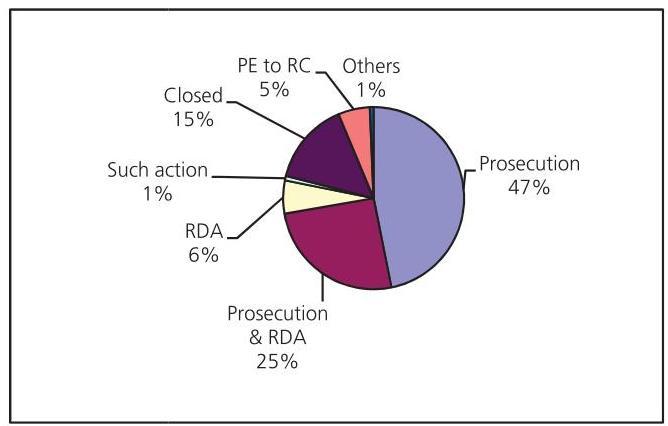
11.25 A total of 1365 cases [RCs/ PEs] were under Investigation/ Enquiry at the end of the year.
11.26 There were 597 cases under investigation for more than one year as on December 31, 2017.
TRIAL
11.27 During the year 2017, 799 Prosecutions were launched and Courts delivered Judgements in 894 Court Cases. Out of these, 557 cases resulted in Conviction, 254 in Acquittal, 21 in Discharge and 62 cases were disposed of for other reasons. The conviction rate was $66.9 \%$.
11.28 The following Bar Chart shows breakup of cases decided by the courts during the year 2017 :
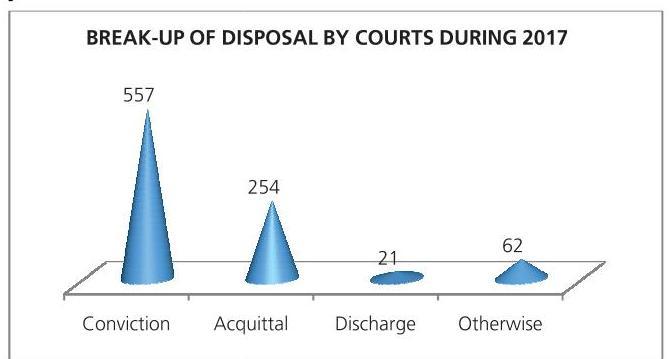
11.299383 trials were pending in various courts as on December 31, 2017.
INTERNATIONAL INVESTIGATION AND COORDINATION
11.30 India joined INTERPOL in the year 1949. After the formation of CBI in the year 1963, vide its circular dated 17.10.1966, the Government of India, conveyed its decision that the Central Bureau of Investigation will henceforth be the
representative of the country for the purposes of correspondence with the International Criminal Police Organisation (ICPO), popularly known as INTERPOL, its call sign for radio and wireless communication. Accordingly, the INTERPOL work was transferred to the Central Bureau of Investigation, an investigating agency under the administrative control of Department of Personnel and Training. All matters relating to the NCB India are, however, dealt with by the Ministry of Home Affairs, Government of India. The NCB India functions as an integral part of CBI, with Director, CBI being its ex-officio Head. The mandate of NCB-India is to secure greater cooperation and share information amongst law enforcement organizations throughout the world. Pursuant to its delegated authority, NCB-India’s primary functions are: To facilitate international law enforcement cooperation; to transmit information of criminal justice, humanitarian, or other law enforcementrelated nature between domestic and foreign law enforcement agencies in INTERPOL member countries, and to coordinate and integrate information in investigations of an international nature. As the National Central Bureau for India, CBI is authorized unrestricted access to INTERPOL’s secure, encrypted communications network, as well as its entire array of investigative databases. Populated with millions of records contributed by INTERPOL’s 190 member countries, these databases contain vital investigative information on international fugitives; stolen and lost travel documents; missing persons; unidentified bodies; images of child sexual abuse and other matters of investigative interest. This capability facilitates law enforcement interaction in real
time on investigative matters, ranging from simple criminal history checks to the sharing of sensitive criminal intelligence and investigative leads targeting transnational organized crime groups. In addition, NCB, India is exclusively responsible for securing the publication of INTERPOL Notices – a system of international lookouts or advisories used to assist law enforcement authorities in locating fugitives, identifying suspects and other investigative purposes on behalf of Indian law enforcement agencies and for ensuring that such notices published on behalf of other member countries are entered and maintained. NCB, India also supports the exchange of international humanitarian assistance requests involving such matters as death notifications and health & welfare checks on Indians overseas, as well as foreign nationals in India. NCB, India, as part of International Police Cooperation Unit (IPCU) of CBI, functions round the year on $24 \times 7$ basis. It is solely dedicated and equipped to assist the Indian law enforcement agencies and their foreign counterparts in overcoming the very real cultural, linguistic and legal barriers that hinder the exchange of criminal investigative information and support across national administrations and boundaries including situations where diplomatic relations may not exist. Even for Indian law enforcement agencies, with a well-developed international criminal investigative presence, NCB-India’s services are complementary, not competitive or duplicative. In all instances, NCB India serves to coordinate Indian law enforcement actions and responses, ensuring that it is consistent with Indian interests and law, as well as INTERPOL policies, procedures, and regulations. This
includes strict adherence to Article 3 of the INTERPOL Constitution, which expressly forbids the Organization to “…undertake any intervention or activities of a political, military, religious or racial character.”
VISIT OF DELEGATIONS TO CBI HEADQUARTERS
11.31 Mr. Andrew Mc Cabe, Dy. Director, FBI met with DCBI on 03.04.2017 at CBI HQ and held discussions with him on matters of mutual interest.
11.32 Mr. N. K. Ballah, Cabinet Secretary & Head of Civil Service, Mauritius led a delegation and met with Mr. Alok Kumar Verma, DCBI on 17.07.2017 at CBI HO.
11.33 Mr. Agus Rahardjo, Chairman, Indonesia Corruption Eradication Commission, Indonesia led a delegation on 14-15 Sept. 2017 and met Sh. Alok Kumar Verma, DCBI.
LETTERS ROGATORY (OUTGOING)
11.34 During the year 2017, a total of 94 LRs were sent abroad out of which 39 LRs pertain to CBI cases and 55 pertain to State Law Enforcement and Central Law Enforcement agencies. During the year 2017, 91 Execution reports (relating to 87 LRs ) have been received from Foreign Law Enforcement Agencies. It was confirmed by Indian Law Enforcement Agencies, including CBI that 21 LRs are fully executed in the year 2017. These 21 LRs include 12 LRs of CBI and 09 of State Police and other Law Enforcement Agencies. During 2017, 02 LRs were also treated as partially executed and closed. These LRs relate to CBI. Further, during
2017, 11 LRs were either returned/ withdrawn or disposed off. These include 06 LRs of CBI and 05 LRs of State Police Agencies. As on 31.12.2017, a total of 459 LRs are pending with other countries out of which 269 pertain to CBI cases and 190 pertain to State Police and other Central Law Enforcement Agencies.
LETTERS ROGATORY (INCOMING)
11.35 During the year 2017, as many as 81 Letters Rogatory (LRs) /Treaty Based Requests were received from various countries requesting to provide assistance in investigation of criminal matters. Execution Reports in 79 cases were sent to MEA/MHA, after receiving the same from the various INTERPOL Liaison Offices (generally State CID/Crime Branch/ CBI Branches) for onward transmission to the law enforcement agencies of the requesting countries. Besides these, 18 LRs were disposed otherwise as closed or withdrawn. As on 31.12.2017, 87 LRs are pending for execution.
EXTRADITION / DEPORTATION
11.36 The data pertaining to Red Notices published, Red Notice subjects arrested in India/ abroad and Red Notice subject extradited to India during the year 2017 is as under:-
Red Notices published by NCB-India 84
Fugitives wanted by India, arrested in 20
India
Fugitives wanted by India, arrested/ 34
located in foreign countries
Fugitives wanted by other countries, 07
arrested/located in India
Fugitives extradited/deported to India 05 from foreign countries
Fugitives extradited/deported from 04 India to foreign countries
DETAILS OF THE FUGITIVES DEPORTED/ EXTRADITED TO INDIA IN 2017
11.37 During 2017, the IPCU, CBI facilitated successful extradition/deportation of 5 fugitives wanted by different Law Enforcement Agencies in India. These include:-
- Bangur Mohd. Kasim Red Notice Control No. A-520/4-2005, Wanted by Gujarat Police: – Bangur Mohd. Kasim was wanted by Gujarat Police for the charges of fraudulently altered documents and false stamps to obtain passport. The authorities of Iraq deported him to India on 19.05.2017. The Gujarat Police team escorted the fugitive from Iraq.
- Md. Sultan Kadir Red Notice Control No.A-1837/8-2007, Wanted by Mumbai Police:- Md. Sultan Kadir was wanted by Mumbai Police for the offence charged against for Cheating. The authorities of Singapore extradited the subject to India on 23.09.2017 and the EOW/Mumbai Police took the custody.
- DANIEL Leslie Red Notice Control No.A-7648/8-2016, Wanted by Kerala Police:- DANIEL Leslie was wanted by Kerala Police for the charges of cheating and dishonestly
inducing delivery of property, act done by several persons in furtherance of common intention. The authorities of UAE extradited the subject to India on 22.10.2017. - DANIEL Santhan Red Notice No. A-7649/8-2016, Wanted by Kerala Police:- DANIEL Santhan was wanted by Kerala Police for the charges of cheating and dishonestly inducing delivery of property, act done by several persons in furtherance of common intention. The Authority of UAE extradited the subject to India on 22.10.2017.
- SHWETA Tyagi, Red Notice No.A-6588/7-2017, Wanted by Haryana Police:- SHWETA Tyagi was wanted by Haryana Police for the charges of cheating and dishonestly inducing delivery of property, criminal breach of trust, criminal intimidation extortion, and criminal conspiracy. The Authority of UAE extradited the subject to India on 13.12.2017.
11.38 FUGITIVES WANTED BY OTHER COUNTRIES DEPORTED/EXTRADITED FROM INDIA (2017)
- Anton Skryabin, Russian National, Diffusion:- The subject was wanted by Russian authorities for the offence of misappropriation. The fugitive was released from the Central Jail, Colcave, Goa, India and deported to Russia, thereafter, on 30.01.2017. the fugitive was escorted by two officers of NCB Moscow.
- Chandu MD Sadaruddin, Red Notice No. – A-7425/8-2016:- The subject was wanted by Bangladesh authorities for the offence of keeping illegal arms, dealing/keeping with illegal currency and Bank fraud. The subject was detained at IGI Airport New Delhi and after confirmation of identity was handed over to IGI Airport Station. The fugitive was deported to Bangladesh on 31.03.2017.
- $\quad$ Rajiv Chandrakant Shah, Red Notice No. A-493/5-2000:- The subject was wanted by USA authorities for the offences of conspiracy to commit Bank Fraud and Money Laundering. The subject was extradited to USA on 28.09.2017.
- Khakimova Lola, Red Notice No. A-6149/10-2013:- The subject was wanted by Uzbek authorities for the offences of Human Trafficking. The subject was detained at the Goa Airport and handed over to the Dabolim Airport Police Station. The subject was extradited to Uzbekistan on 22.12.2017 escorted by Uzbekistan escort team.
INTERPOL Stolen and Lost Travel Documents (SLTD) Database:-
11.39 NCB, India has uploaded data relating to lost/stolen/revoked Indian passports into the INTERPOL SLTD Database being maintained by IPCU Branch. Further, till 31.12.2017, data of about 15.22 lakh Stolen/Lost/Revoked Indian Passports has been uploaded in the
SLTD Database. During the year 2017, more than 200 cases of use of revoked/lost/stolen passports were reported by foreign NCBs.
INTERPOL Global Communication System [IGCS] messages received during 2017:-
11.40 The four Regional Desks (Asia/Middle East/USA/Europe) have received as many as 8871 requests/IGCS message/ letters from January 2017 to December 2017 regarding identity check, arrest message, conviction details, driving license check, identification of finger prints, missing persons, deportation, drug trafficking, searches and registration of thefts of antiquities stolen from India, etc. from various NCBs, PLOs and Indian Law Enforcement agencies/authorities. During the period under review, the four regional desks of NCB-India also worked in close coordination with other NCBs and rendered necessary guidance to them on various issues.
FOREIGN VISITS OF CBI OFFICERS
11.41 During the year 2017, a total number of 90 CBI officers attended various International Capacity Building Programmes/training courses, investigations etc.
TRAINING
11.42 In the year 2017, CBI Academy and the three RTCs conducted a total of 151 courses and trained 3471 Officers/Officials.
| No. of Courses | No. of Participants | Total | ||
|---|---|---|---|---|
| CBI | Non-CBI | |||
| CBI Academy | 122 | 1642 | 1247 | 2889 |
| RTC, Kolkata | 12 | 148 | 00 | 148 |
| RTC, Mumbai | 9 | 200 | 00 | 200 |
| RTC, Chennai | 8 | 234 | 00 | 234 |
| Total | $\mathbf{1 5 1}$ | $\mathbf{2 2 2 4}$ | $\mathbf{1 2 4 7}$ | $\mathbf{3 4 7 1 *}$ |
*includes 155 participants from Foreign Law Enforcement agencies.
12 Joint Consultative Machinery
12.0 The Scheme for Joint Consultative and Compulsory Arbitration for the Central Government Employees was introduced in the year 1966 on the lines of the Whitely Councils in the U.K. The scheme provides a platform for constructive dialogue & discussion between the representatives of the staff side and the official side for peaceful resolution of all disputes between the Government as employer and the employees. The scheme was introduced with the objectives of promoting harmonious relations and securing the greatest measure of cooperation between the Central Government as the employer and the employees in matters of common concern and with the object of further increasing the efficiency of the public service combined with the well being of those employed.
12.1 The JCM Scheme provides for three tier machinery:
(i) The National Council as the apex body; (chaired by the Cabinet Secretary);
(ii) Departmental Councils at the level of individual Ministries / Departments including their attached and subordinate offices and (chaired by respective Secretaries); and
(iii) Regional / Office Councils to deal with mainly the local problems at the level of each individual office, depending
on its structure. (Chaired by Head of office of respective organizations).
12.2 The scope of the JCM Scheme includes all matters relating to:
- $\quad$ conditions of service and work;
- welfare of the employees; and
- improvement of efficiency and standards of work,
12.2.1 Provided, however, that
(i) In regard to recruitment, promotion and discipline, consultation is limited to matters of general principles; and
(ii) Individual cases are not considered.
12.3 Under the JCM Scheme, there have been continuous interactions with staff unions at the National level as well as at the Departmental level and a number of important issues have been resolved amicably through mutual discussions. 46 meetings of the National Council (JCM) have been held under the Chairmanship of Cabinet Secretary since the inception of the Scheme in 1966.
Anomaly Committee
12.4 National Anomaly Committee to settle the anomalies arising out of the Implementation of the Seventh Central Pay Commission’s recommendations has been set up under the Chairmanship of Secretary (P).
Standing Committee Meeting
12.5 Meeting of the Standing Committee of the National Council (JCM) was held on 3rd May, 2017 under the chairmanship of the Secretary $(P)$.
$7^{\text {th }}$ Central Pay Commission Recommendation
12.6 This Department has issued OM No. 14/4/2015-JCA2 dated 31.08.2017 for implementation of a recommendation of the Seventh Central Pay Commission on Dress Allowance. In supersession of what the entitled categories of employees would get earlier, they would now be paid Dress Allowance @ 5000/per year during the post $7^{\text {th }} \mathrm{CPC}$ regime.
ARBITRATION
12.7 An important feature of the JCM Scheme is the provision for arbitration in cases where there is no agreement between
the Official Side and the Staff Side on matters relating to:-
- pay and allowances;
- weekly hours of work; and
- Leave of a class or grade of employees.
BOARD OF ARBITRATION (BOA)
12.8 A Board of Arbitration (BOA) comprising a Chairman (an independent person) and two Members, (nominated – one each by staff side and official side) functions under the administrative control of the Ministry of Labour & Employment. Awards of the Board of Arbitration are binding on both the sides, subject to the over-riding authority of Parliament to reject or modify the awards. Most of the awards which were in favour of the employees have been implemented, except a few which could not be accepted due to their potential adverse effects on national economy / social justice.
Administrative Tribunals
13.0 The Administrative Tribunals Act, 1985 owes its origin to Article 323-A of the Constitution of India which empowers Central Government to set up Administrative Tribunals by an Act of Parliament for adjudication of grievances and disputes arising out of the conditions of service of an employee appointed to the public services and posts in connection with the affairs of the Union and the States. In pursuance of the provisions contained in the Administrative Tribunals Act, 1985, the Administrative Tribunals, set up under it, exercise original jurisdiction in respect of service matters of employees covered by the Act. As a result of the Supreme Court’s judgment dated 18.03.1997 in the case of L. Chandra Kumar & Others. Vs. UOI, the appeals against the orders of an Administrative Tribunal shall lie before the Division Bench of the concerned High Court.
13.1 The Administrative Tribunals are distinguishable from the ordinary courts with regard to their jurisdiction and procedure. They exercise jurisdiction only in relation to the service matters of the litigants covered by the Act. They are also free from many of the procedural technicalities of the ordinary courts. The procedural simplicity of the Act can be appreciated from the fact that the aggrieved person can also appear before it personally. Government can also present its cases through its departmental officers or legal practitioners.
Further, only an affordable and nominal fee of ₹ 50 is to be paid by the applicants for filing the original application before the Tribunal. Thus, the objective of the Tribunal is to provide speedy and affordable redress to the aggrieved applicants arising out of employment or conditions of service.
13.2 The Central Administrative Tribunal was set up on 01.11.1985. At present, it has 17 regular Benches, 15 of which operate at the principal seats of High Courts and the remaining two at Jaipur and Lucknow. These Benches also hold Circuit Sittings at other seats of High Courts. A statement showing the location of Central Administrative Tribunal Benches, the dates of their establishment and the number of courts in each of these Benches along with a list of places where they hold Circuit Sittings is given in Appendix-I.
13.3 The Tribunal consists of a Chairman and Members. It has also been the constant endeavour of this Ministry to ensure that the posts of Chairman and Members are filled up well in time and no post remains vacant for long time. The Members of Central Administrative Tribunal (CAT) and State Administrative Tribunals (SATs) are drawn from judicial as well as administrative streams, so as to give the Tribunal the benefit of domain expertise both in legal and service matters. The sanctioned strength of the Chairman is
one and sanctioned strength of the Members of Central Administrative Tribunal is 65, out of which 32 are Judicial Members and 33 are Administrative Members.
13.4 The appointment of Members in CAT is made on the basis of recommendations of a high powered Selection Committee. Earlier, the Selection Committee was chaired by a sitting Judge of Supreme Court nominated by the Chief Justice of India. However, w.e.f. 01.06.2017 as per the new Rules, there will be a separate Selection Committee each for Judicial Members and Administrative Members. The Selection Committee for appointment of Judicial Member will be chaired by the Hon’ble Chief Justice of India or his nominee and for appointment of Administrative Members, it will be chaired by a person nominated by the Government. The names of the candidates recommended by the Selection Committee are sent to the Hon’ble Chief Justice of India for obtaining his concurrence. Thereafter, the appointments are made with the approval of Appointments Committee of the Cabinet.
13.5 State Administrative Tribunals (SATs) were also set up in the following States –
(i.) Andhra Pradesh
(ii.) Orissa
(iii.) Karnataka
(iv.) Maharashtra
(v.) West Bengal
(vi.) Kerala
(vii) Himachal Pradesh
Consequent upon formation of the new State of Telangana and in pursuant to request from State Government of Telangana, the functioning of the Andhra Pradesh State Tribunal in respect of the State of Telangana has been discontinued vide notification dated 15.09.2016. State Government of Tamil Nadu has requested to re-establish the SAT. State Government of Haryana has also requested to establish the SAT for their State.
13.6 The appointments to the vacancies in SATs are made on the basis of proposals sent by the State Governments with the approval of the Governor. Thereafter, their appointments undergo the same process as the one in respect of Central Administrative Tribunal.
13.7 Since its inception in 1985 and up to 31.12.2017, the Central Administrative Tribunal received 7,60,483 cases for adjudication (including those transferred from High Courts), out of which 7,13,213 cases have been disposed of, leaving a pendency of 47,270 cases. On an average more than $93 %$ of the cases instituted are disposed of. A statement indicating the institution, disposal and pendency of cases since inception of CAT is at Appendix-II.
13.8 Section 14(2) of the Administrative Tribunals Act, 1985 empowers the Central Government to extend the provisions of the Act to local or other authorities within the territory of India or under the control of Government of India and to Corporations or Societies owned or controlled by Government of India. In exercise of these powers, the Central Government had extended the provisions of
the Act to 214 organizations so far, out of which 06 Organizations were added therein during this year.
13.9 In order to familiarize the newly appointed Members of CAT with the functioning of the Tribunal, a short Orientation Programme / Training is held from time to time. So far, four such Orientation Programme / Training have been held at the National Judicial Academy, Bhopal.
13.10 Further, for maintaining absolute integrity and promoting fair practices in the professional court dealings and keeping in view the general directions of the Hon’ble Supreme Court, the designated Selection Committee, in its meeting decided that a Judicial Member of CAT, who earlier practiced as Advocate in a
Court in that station, should not normally be considered for posting in the CAT Bench of the same station.
13.11 It has been the constant endeavour of the Government to strengthen the infrastructure in all the Benches of CAT for their smooth functioning. During the Financial Year 2016-17, fund of ₹ 29.67 crore was allocated to CAT for purchase of land and construction of building. In the Financial Year 2017-18 also, fund of ₹ 11.78 crore has been allocated to CAT for this purpose.
13.12 Justice Shri Parmod Kohli, is the Chairman of CAT. He was appointed as Chairman, CAT with effect from 05.04.2016. Before his appointment as the Chairman, CAT, Justice Shri Kohli was the Chief Justice of Sikkim High Court.
APPENDIX-1
NAME, DATE OF SETTING, NO. OF COURTS AND ADDRESSES OF VARIOUS BENCHES OF CENTRAL ADMINISTRATIVE TRIBUNAL
| S.No. | Name of the Bench | Date of setting | No. of courts | Address |
|---|---|---|---|---|
| 1. | PRINCIPAL | 01.11 .1985 | 6 | NEW DELHI |
| 2. | AHMEDABAD | 30.06 .1986 | 1 | AHMEDABAD |
| 3. | ALLAHABAD | 01.11 .1985 | 4 | ALLAHABAD |
| 4. | BANGALORE | 03.03 .1986 | 2 | BANGALORE |
| 5. | CHANDIGARH | 03.03 .1986 | 2 | CHANDIGARH |
| 6. | MADRAS | 01.11 .1985 | 2 | CHENNAI |
| 7. | CUTTACK | 30.06 .1986 | 1 | CUTTACK |
| 8. | ERNAKULAM | 01.09 .1988 | 2 | ERNAKULAM |
| 9. | GUWAHATI | 03.03 .1986 | 1 | GUWAHATI |
| 10. | HYDERABAD | 03.06 .1986 | 2 | HYDERABAD |
| 11. | JABALPUR | 30.06 .1986 | 1 | JABALPUR |
| 12. | JAIPUR | 15.10 .1991 | 1 | JAIPUR |
| 13. | JODHPUR | 30.06 .1986 | 1 | JODHPUR |
| 14. | CALCUTTA | 01.11 .1985 | 2 | KOLKATA |
| 15. | LUCKNOW | 15.10 .1991 | 1 | LUCKNOW |
| 16. | MUMBAI | 01.11 .1985 | 2 | MUMBAI |
| 17. | PATNA | 30.06 .1986 | 2 | PATNA |
STATEMENT SHOWING THE NAME OF BENCH AND PLACES WHERE CIRCUIT SITTINGS ARE HELD
BENCH
- ALLAHABAD BENCH
- CALCUTTA BENCH
- CHANDIGARH BENCH
- MADRAS BENCH
- GUWAHATI BENCH
- JABALPUR BENCH
- BOMBAY BENCH
- PATNA BENCH
- ERNAKULAM BENCH
PLACES
- Nainital
- Port Blair, Gangtok
- Shimla, Jammu, Srinagar
- Pondicherry
- Shillong, Itanagar, Kohima, Agartala, Imphal, Aizwal
- Indore, Gwalior, Bilaspur
- Nagpur, Aurangabad, Panaji
- Ranchi
- Lakshadweep
APPENDIX-II
STATEMENT SHOWING THE POSITION OF INSTITUTION, DISPOSAL AND PENDENCY OF CASES IN THE CENTRAL ADMINISTRATIVE TRIBUNAL SINCE INCEPTION UPTO 31.10.2017.
(As provided by Central Administrative Tribunal, Principal Bench from time to time)
| S.NO. | PERIOD | INSTITUTION | DISPOSAL | PENDENCY AT THE END OF THE YEAR |
|---|---|---|---|---|
| 1. | 1985 | 2963 | 30 | 2933 |
| 2. | 1986 | 23177 | 8934 | 17176 |
| 3. | 1987 | 19410 | 15084 | 21502 |
| 4. | 1988 | 19425 | 13769 | 27158 |
| 5. | 1989 | 18602 | 13986 | 31774 |
| 6. | 1990 | 19283 | 15495 | 35562 |
| 7. | 1991 | 21623 | 17552 | 39633 |
| 8. | 1992 | 25184 | 23782 | 41035 |
| 9. | 1993 | 27067 | 28074 | 40028 |
| 10. | 1994 | 26230 | 26409 | 39849 |
| 11. | 1995 | 25789 | 23668 | 41970 |
| 12. | 1996 | 23584 | 20667 | 44887 |
| 13 | 1997 | 23098 | 21981 | 46004 |
| 14. | 1998 | 21911 | 18394 | 49521 |
| 15. | 1999 | 22944 | 24566 | 47899 |
| 16. | 2000 | 25146 | 31398 | 41647 |
| 17. | 2001 | 25977 | 31953 | 35671 |
| 18. | 2002 | 25398 | 29514 | 31555 |
| 19. | 2003 | 25089 | 28076 | 28568 |
| 20. | 2004 | 23825 | 27735 | 24658 |
| 21. | 2005 | 21528 | 22408 | 23778 |
| 22. | 2006 | 18722 | 17774 | 24726 |
| S.NO. | PERIOD | INSTITUTION | DISPOSAL | PENDENCY AT THE END OF THE YEAR |
|---|---|---|---|---|
| 23. | 2007 | 17725 | 18674 | 23777 |
| 24. | 2008 | 18287 | 20352 | 21712 |
| 25 | 2009 | 24496 | 23681 | 22527 |
| 26. | 2010 | 26620 | 25477 | 23670 |
| 27 | 2011 | 25869 | 24750 | 24789 |
| 28 | 2012 | 27786 | 24259 | 28316 |
| 29 | 2013 | 27442 | 21654 | 34104 |
| 30 | 2014 | 27872 | 23767 | 38209 |
| 31 | 2015 | 26059 | 23051 | 41217 |
| 32 | 2016 | 26984 | 26266 | 41935 |
| 33 | 2017 | 25386 | 20051 | 47270 |
| 34 | Total | 7,60,483 | 7,13,213 | 47,270 |
Staff Welfare
14.0 The Central Government is the largest single employer in the country and bears the major responsibility for looking after the welfare of a large number of employees spread all over the country. Realizing that improvement in the working and living conditions of the employees and their families leads to efficiency and high morale, the Department of Personnel and Training supports various staff welfare measures. A brief account of various welfare measures dealt with by Welfare Division is given below.
RESIDENTS’ WELFARE ASSOCIATION
14.1 In order to foster a spirit of mutual help and goodwill among residents of Government colonies and to promote social, cultural and recreational activities, Department of Personnel & Training (DOPT) has been encouraging formation of Central Government Employees Residents’ Welfare Associations (CGERWs). Every CGERWA seeking reorganization and grants-in-aid from Government is required to adopt Model Constitution prescribed by DOPT. At present, there are 95 recognized Associations. The members of the Managing Committee of these Associations are elected every two years under the Provisions of a Model Constitution framed by the Department of Personnel and Training. This Department Sanctions grants-in-aid only to recognized Associations, subject to a maximum of Rs.
10,000/- per annum for an Association.
AREA WELFARE OFFICERS
14.2 The Area Welfare Officers (AWOs) are nominated in residential colonies having a large number of Central Government employees. The AWOs serve as a link between the Government and residents in matters relating to the welfare of the Government employees living in various colonies. They also work as field officers in coordinating and maintaining liaison with various agencies of Government such as CPWD, CGHS, Police etc. Applications are invited from Gazetted officers working in various Ministries/Departments for being nominated as Area Welfare Officers for a period of two years. Officers desirous of being nominated as AWOs on voluntary and honorary basis are required to apply through their respective Ministries/Departments.
CENTRAL GOVERNMENT EMPLOYEES WELFARE COORDINATION COMMITTEES (CGEWCCs)
14.3 The Central Government Employees Welfare Coordination Committees (CGEWCCs) have been formed outside Delhi, at places where there are at least five Central Government Offices and the total number of Central Government Employees is not less than 1000. These Committees are responsible for coordinating the welfare activities of the
Central Government employees serving within their jurisdiction. The senior most officer at the station functions as the Chairman of the Committee. The quantum of grant based on the staff strength is sanctioned by the Department of Personnel and Training to the CGEWCCs.
CENTRAL CIVIL SERVICES CULTURAL AND SPORTS BOARD
14.4 The Central Civil Services, Cultural & Sports Board, a society registered under the Societies Registration Act, 1860 is the Central agency for promotion of Cultural \& Sports activities amongst the Central Government employees in the country. The Board was set up in 1964 as Central Secretariat Club in the Ministry of Home Affairs. Initially the objective of the Board was to promote cultural and sports activities amongst the Central Government Employees located in Delhi only. Subsequently, Regional Sports Boards were set up in various cities. Financial grants-in-aid are sanctioned every year by the Board to the Regional Boards.
ACTIVITIES OF THE BOARD:
INTER MINISTRY TOURNAMENTS 2017-18
14.5 The Board organized Inter-Ministry Tournaments in 18 Disciplines of Sports. So far, the board has organized Inter-Ministry Tournament in Cricket, Hockey, Volleyball, Basketball, Athletics, Badminton, Shooting Ball, Wrestling, Football, Swimming, Lawn Tennis, Power lifting, Weight lifting, Kabaddi, Table Tennis and Carom for the year 2017-18. Rests of the tournaments are being organized as per calendar of the Board.
ALL INDIA CIVIL SERVICES TOURNAMENTS HELD DURING THE YEAR 2017-18.
14.6 These tournaments, which are open to Central and State Government employees aim to give an opportunity to the civil servants to meet and interact with each other and compete. All India Civil Services Basketball Tournament was held from $12^{\text {th }}$ to $16^{\text {th }}$ November 2017 at Bhopal, MP. Central Secretariat Swimming team won the championship in the Tournament. Other AICS Tournament would be organized in collaboration with different States/UTs.
SCHEME FOR PROMOTION OF ADVENTURE SPORTS \& SIMILAR ACTIVITIES AMONGST CENTRAL GOVERNMENT EMPLOYEES
14.7 As welfare measure, the Central Civil Services Cultural and Sports Board launched a Scheme for promotion of adventure sports and similar activities amongst Central Government Employees working in the Ministries/Departments. The Scheme includes upto 10 days programme having components of environmental awareness, disaster management, team spirit, capacity building, and Swachchh Bharat Campaign and activities like Trekking, Mountaineering, Rock-Climbing, Cycling in a difficult terrain, Skiing, Rafting, Para Sailing, Jungle Safari and Environmental Awareness Camps etc.
14.8 It is expected that participation by Central Government Employees in adventure sports and similar activities will give them a platform where they would learn lessons from
nature and use the knowledge acquired for welfare of the society. It would also foster spirit of risk-taking, cooperative team work, capacity of readiness, vital response to challenging situations, endurance and environmental awareness.
BOARD’S AFFILIATION TO NATIONAL FEDERATION
14.9 The Board is affiliated to a number of sports associations/federations at the National level. Board’s team participates in the National Tournaments organized by these Associations/ Federations for Kabaddi, Hockey, Football, Carrom and Chess.
SPORTS FACILITIES IN DELHI
14.10 The Board has a sports complex at Vinay Marg, New Delhi which has facilities for Football, Hockey, Cricket, Athletics, Lawn Tennis, Basketball, Volleyball and practice pitches for Cricket. The Board also maintains Lawn Tennis Courts at Brassy Avenue, Bharti Nagar and R.K.Puram Sector -13, New Delhi. Brassy Avenue, New Delhi has facilities for Volleyball and Cricket practice pitches also. There is facility for indoor games such as Table Tennis, Carrom and Chess at Nirman Bhawan, New Delhi.
COACHING CAMP FOR CHILDREN/ DEPENDENTS OF GOVERNMENT EMPLOYEES
14.11 The Board also conducts regular coaching in Cricket and Lawn Tennis for the children/dependents of Government employees at Vinay Marg Sports Complex, New
Delhi. Coaching in Lawn Tennis is also available at Bharti Nagar and R.K. Puram Sector-13, New Delhi. Board also organizes Summer Coaching camp in Basketball, Cricket, Football, Self Defence and Lawn Tennis for children/ dependents of government employees.
PARTICIPATION OF GOVERNMENT EMPLOYEES AND THEIR FAMILIES IN SPORTING ACTIVITIES CONDUCTED IN COLLABORATION WITH SPORTS AUTHORITY OF INDIA (SAI)
14.12 The Board has introduced Scheme for Swimming for Central Government Employees and their children in collaboration with Sports Authority of India at Major Dhyanchand National Stadium New Delhi. Under the Scheme, an hour slot is booked in National Stadium by the Board for the use of Government employees and their dependents families during the summer seasons (i.e. April to September) at nominal charges. Badminton, Table Tennis and Fitness Centre facilities are also extended to Government Employees under “Come and Play” scheme of Sports Authority of India to the employees and their families. Under this scheme, the amount charged by SAI is reimbursed to the beneficiary after deduction of nominal fee.
SETTING UP OF GYMNASIUM IN MINISTRIES/DEPARTMENTS
14.13 The Board has framed the Scheme for establishment of indoor Gymnasium, open Gym and augmentation of existing Gyms in Ministries/Departments. As a staff welfare measure, the CCSCSB would provide financial
assistance to the Ministries/Departments of Central Government for setting up of indoor & open Gymnasium and augmentation of existing Gyms
GRIH KALYAN KENDRA
14.14 The Grih Kalyan Kendra (GKK) is a registered Society under the Societies Registration Act, 1860 and functioning under the aegis of Ministry of Personnel, Public Grievances \& Pensions.
14.15 The basic objectives of the Kendra, in brief are: –
a) To promote social, economic, cultural and educational activities for the welfare of Central Government Employees and their families.
b) To impart technical and vocational training in home crafts and other household arts for useful utilization of leisure time and for better and efficient housekeeping.
c) To organize and promote economic activities that may provide opportunities for gainful employment to families of Central Government employees for supplementing family income.
The GKK is administered by GKK Board.
14.16 The Board, which has the Secretary (P) or his nominated officer as the President, is responsible for the organization and administration of GKK.
14.17 In pursuance of its objectives, GKK has been conducting the following activities:
a) Training classes in cutting, tailoring and embroidery for the housewives and grown up girls during their leisure hours.
b) Nursery education for children in the age group of 3 to 5 years.
c) Creches or Day Care Centres for children between the age of 90 days to 10 years.
d) Recreational facilities like Health Club/ Gym, badminton and tennis, etc.
e) Coaching classes in Martial Arts, Yoga, Music, Dance, English Speaking Course, Computer, Brain Development, Fine Arts, Lawn Tennis etc.
14.18 The welfare activities run by Grih Kalyan Kendra are indicated in the table given below:
| Place | Number of Samaj Sadans/ Centres |
Craft Centres |
Nursery Schools |
Creche Centres | Health Clubs/Gyms |
|---|---|---|---|---|---|
| Delhi | 36 | 7 | 14 | 10 | 6 |
| Mumbai | 4 | 4 | 4 | – | – |
| Chennai | 3 | – | 2 | – | 1 |
| Jaipur | 2 | 1 | – | 1 | – |
| Place | Number of Samaj Sadans/ Centres |
Craft Centres |
Nursery Schools |
Creche Centres | Health Clubs/Gyms |
|---|---|---|---|---|---|
| Dehradun | 2 | – | 2 | – | – |
| Nagpur | 2 | – | – | – | – |
| Bangalore | 3 | – | – | – | – |
| Faridabad | 1 | 1 | 1 | 1 | – |
| Kolkata | 1 | – | – | – | – |
| Ghaziabad | 1 | – | – | – | – |
| Total | $\mathbf{5 5}$ | $\mathbf{1 3}$ | $\mathbf{2 3}$ | $\mathbf{1 2}$ | $\mathbf{0 9}$ |
14.19 The Grih Kalyan Kendra has undertaken the following activities during 2016-17:-
i) $\quad \mathbf{1 4 0 0}$ children in Nursery Schools, $\mathbf{1 2 7}$ Students in Craft Centres, $\mathbf{1 5 6}$ Children in Créches, 79 Users in Health Clubs/ Fitness Centres, 621 in Outsourced Activities and 2000 in Yoga Activity have been availing the facilities.
ii) DOPT launched a Yoga training scheme w.e.f. 01.04.2015 in association with Morarji Desai National Institute of Yoga, New Delhi for the benefit of Central Government employees and their dependents free of cost. The training sessions are conducted in 25 locations in Delhi and 14 Samaj Sadans of Grih Kalyan Kendra outside Delhi. Yoga Trainers have been selected by Morarji Desai National Institute of Yoga (MDNIY), New Delhi. These trainers have been engaged by Grih Kalyan Kendra, on contract basis. Government has allocated Rs. 2 crores for the scheme of Yoga Training sessions under the Non-Plan Head in 2017-18.
(iii) 1000 participants of Yoga Training Session at various Samaj Sadans in Delhi attended the International Yoga Day held on 21.06.2017. International Yoga Day was celebrated at the Samaj Sadans located outside Delhi namely, Kolkata, Chennai, Mumbai, Nagpur, Dehradun, Bangalore, Faridabad and Ghaziabad.
KENDRIYA BHANDAR
OBJECTIVES OF THE ORGANISATION
14.20 The Central Government Employees Consumer Cooperative Society Ltd., New Delhi, operating in the name of KENDRIYA BHANDAR was set up in 1963 in pursuance of Cabinet decision as a Welfare Project for the benefit of the Central Government Employees. The society endeavors to serve the Central Government Employees and general public at large by providing quality goods of daily needs at reasonable prices and consumer items through its retail stores. The range of items which Kendriya Bhandar provides includes consumer goods, grocery items, stationery and medicines etc.
MULTI STATE COOPERATIVE SOCIETY
14.21 The Society is registered under MSCS Act 2002, as a Multi-State Co-operative Society and operates in Delhi and other States of the country.
NETWORK
14.22 The Society operates a network of 149 stores/branches in Delhi, Maharashtra, Tamilnadu, Andhra Pradesh, Karnataka, Cochin, Daman, Goa, Gujarat, Uttar Pradesh, Uttaranchal, Rajasthan, Madhya Pradesh, West Bengal, Jharkhand, Assam, Haryana, Punjab and Chandigarh etc.
14.23 At Delhi, Kendriya Bhandar has a chain of 107 nos. grocery/consumer retail stores and 05 Exclusive Stores for Medicine. At Grocery/ Consumer stores, all items of consumer goods, grocery items and certain stationery items are being sold. In addition, we have exclusive Counter at East Block and West Block, R.K. Puram, New Delhi for sale of stationery and other products.
14.24 Furthermore, Kendriya Bhandar is supplying medicines and related items to CGHS Dispensaries and Hospitals in Delhi through its existing chemist shops. Kendriya Bhandar has also opened Three Jan Aushadhi Generic Drug Shops in GTB Hospital, DDU Hospital and Shastri Bhawan as a part of Jan Aushadhi project of the Department of Pharmaceuticals, Govt. of India.
SHARE CAPITAL
14.25 As on $31^{\text {st }}$ March 2017 Kendriya Bhandar had a paid-up capital of Rs. 100.06 lakhs of which Rs. 68.18 lakhs have been subscribed by the Central Government and the
rest by individual members.
MODERNISATION / AUTOMATION EFFORTS
14.26 Kendriya Bhandar has also undertaken the modernization of its retail stores including renovation, computerization etc. in order to provide a pleasant shopping experience to the customers and accordingly over 15 stores have been modernized over the last one year. This has also resulted in increase in customer’s footfall and significant increase in retail sales.
14.27 Activities such as billing to customers, purchase, inventory etc. of Stationery division of Kendriya Bhandar, located at R.K. Puram East & West Blocks are computerized through Local Area Network. Further, in Head Office, purchases \& stocks of Consumer items, pulses and spices are computerized. Kendriya Bhandar has also undertaken computerization of godowns such as Grocery \& consumer godowns and about 90 retail stores have already been computerized and rest of the retail stores will be computerized soon.
14.28 Debit/Credit Card swapping machines have been installed in all stores of Kendriya Bhandar for the convenience of customers.
SALES AND FINANCIAL PERFORMANCE
14.29 Kendriya Bhandar has registered significant growth in the recent past. Total sales during the year 2016-17 is Rs. 864.38 crores and the Net Profit after tax was Rs.3.96 crores respectively.
14.30 Kendriya Bhandar has declared a dividend of $10 %$ for the year 2016-17. There is no financial assistance from Govt. to Kendriya
Bhandar. Source of income of Kendriya Bhandar is trading of products, interest on FDRs etc.
BENEFITS TO CUSTOMERS
14.31 The Society has been able to maintain competitive prices for various products sold by it as compared to those prevailing in the market. In fact, selling prices prevailing in Kendriya Bhandar now are deemed as the bench mark in the market.
14.32 For better quality control, pre-testing of grocery items before distribution to stores has been introduced and testing of random samples picked from shelves of stores is also being continued. These steps ensure that the quality of goods sold is maintained for better consumer satisfaction.
14.33 It is pertinent to mention that the Society has been involved in welfare activities and has always assisted the Central Government and the Govt. of NCT of Delhi in arresting the price rise at the time of crisis.
14.34 In case of spurt in the prices of essential items during shortage/crisis, Kendriya Bhandar plays a very vital & effective role and serves at the beck and call of the Government for neutralization of negative impact of market trends/force. The services rendered by Kendriya Bhandar during crisis of pulses, onion, flood relief operations in J\&K, demonetization period etc. are some of the testing times when Kendriya Bhandar worked day and night for national cause and provided its worth by providing humanitarian assistance to countrymen beyond the call of its duty.
The Civil Service Society (Sanskriti School)
14.35 The Civil Services Society is a society registered under the Societies Registration Act. The Society was set up in February 1995, by the wives of the officers of the All India and Allied Civil Services. The wife of serving Cabinet Secretary is the Chairperson of the Civil Services Society. The office of the Society is on Dr. S Radhakrishnan Marg, Chanakyapuri, New Delhi – 110021.
Aims and Objectives
14.36 The aims and objectives of the society, interalia, are as under: –
- To establish progressive schools or other educational institutions in Delhi or outside Delhi, open to the children of officers of the All India and Central Services. Depending on the availability of seats, children of officers of the Public sector of non – government servants may also be admitted, at the discretion of the Governing Body.
- To impart sound and liberal education to boys and girls during their impressionable years – a type of education that will lay stress on character building, team work, esprit de corps, physical development and will infuse in school children a spirit of adventure, fair play and justice.
- To develop among its students a feeling of pride in Indian culture and to produce citizens who will truly be global and rise above social, communal, religious and provincial prejudices.
14.37 The Society started its first school with the strength of 32 students, the Sanskriti School, in New Delhi, in the year 1998. The Chairperson of the Society is also the Chairperson of the School. Sanskriti School is a recognized integrated co – educational school, affiliated to the CBSE, offering education from Nursery to Class XII.
14.38 The Society believes that every child can and must realize his/her full potential, and towards this end, must be enabled through appropriate means. With this in mind, the School has a Learning Centre with Special Educators and Counselors guiding children who have special needs, through an Individual Education Program (IEP).
14.39 Likewise, for those from the relatively less privileged sections of society, the Society runs a parallel school Umang in the afternoon. Efforts are also made to mainstream some of the children. These children from the economically weaker sections are admitted through the admission process under the Delhi Education Act.
14.40 The Civil Services Society has set up a Centre for Excellence to promote teacher training initiatives. It has instituted the Sanskriti Lecture Series to motivate students by exposing them to thought processes of eminent persons.
Management
14.41 The general management of the affairs of the Society is vested in its Executive Committee.
14.42 The general management of the affairs of Sanskriti School is also guided by the
Managing Committee.
Activities
14.43 As on $31^{\text {st }}$ March, 2017, Sanskriti School has 2835 students on its rolls from Nursery to Class XII. It has well stocked libraries, smart classrooms, laboratories, a gymnasium, a football field and a swimming pool. Apart from the prescribed curriculum, Sanskriti School offers its students a choice of sports and games, like cricket, football, basketball, table tennis, swimming and wide ranging co – curricular activities like yoga, chess, theatre, music, dance, quiz, public speaking, paper craft, etc.
Finance
14.44 The Society has no income of its own other than the annual subscription of the members. For Sanskriti School the source of income is the fees collected from the students.
CIVIL SERVICES OFFICERS INSTITUTE (CSOI)
INTRODUCTION
14.45 The Civil Services Officers’ Institute is a registered society under the Societies Registration Act and was set up in February 1998. CSOI was allotted a building at K.G. Marg, M.S. Apartments complex in 1998 which was later re-appropriated by CPWD to provide facilities of an Institute. Subsequently land was allotted to CSOI in 2002 at Vinay Marg, Chanakyapuri measuring 4.23 acres by Ministry of Urban Development, GOI. The new building was constructed by NBCC at a cost of Rs. 44.33 cr and it became operational with effect from December 2012. The Governing Council of CSOI took a decision to run both
the Institute at their respective locations in view of increased membership.
AIMS AND OBJECTIVES
14.46 The aims and objectives of the CSOI inter alia include:-
(i) To promote welfare of the officers of the Civil Services and bring them together under one umbrella to secure complete integration of the services and to build a corps of officers imbibed with the spirit of co-operation in all aspects of Civil Services.
(ii) To hold, organize, arrange and conduct seminars, symposiums, talks, debates, workshops, lectures and other means of dispensing education to meet the needs and challenges of modern day Civil Administration.
(iii) To print and publish journals, periodicals and manuals to keep the civil servants abreast with modern day developments in Civil Administration.
(iv) To acquire and promote modern skills of Civil Administration and harmonize between different fields of Civil Administration by disseminating or exchanging knowledge thereof and by providing such other facilities as would lead to their Universal application.
(v) To establish and maintain libraries and information system to facilitate study of Civil Administration at International level and spreading information in regard thereto.
(vi) To organize and maintain, on no-profit-no loss basis, limited residential accommodation for the members of
the Society coming to participate in the activities of the Association and of other bodies with cognate objectives, as well as non-members, invited to participate in the activities of the Association.
MANAGEMENT
14.47 CSOI is managed by a Governing Council headed by Cabinet Secretary, an Executive Committee headed by Secretary (DOPT), and a Working Committee headed by Additional Secretary (DOPT).
DEPARTMENTAL CANTEENS
14.48 As a measure of Staff Welfare, Departmental Canteens/ Tiffin Rooms have been set up in the Central Government Offices/ Establishments to provide beverages, snacks and meals at reasonable rates and prepared hygienically. At present about 1000 departmental canteens/ tiffin rooms are functioning in various Central Government Offices across the country. With a view to maintain cleanliness and quality of service, a scheme of modernization of canteens was introduced in 2015. As on 31.12.2017, a sum of Rs. 53,54,700/- was sanctioned for renovation of six Departmental Canteens.
14.49 Scholarship Scheme for children of employees of Non- Statutory Departmental Canteens was instituted in 1998 out of the funds in the discretionary fund of Director of Canteen. The scheme was introduced to encourage higher studies to the children of the canteen staff. During 2017-18, a sum of Rs. 12,150/- was awarded as scholarship to thirteen children/wards of eight canteen employees.
The Right to Information
- Administration of the RTI Act and Rules including amendments thereof.
- Issue of Guidelines and clarification on RTI.
- Implementation of the Annual Programme titled ‘Improving Transparency and Accountability in Government through Effective Implementation of RTI Act’.
- Management of RTI online web portal.
- Administrative matters of Central Information Commission.
- Selection of Chief Information Commissioner and Information Commissioners in the Central Information Commission.
- Framing of Right to Privacy Law.
SALIENT FEATURES OF THE RIGHT TO INFORMATION ACT, 2005
15.1 To set out a practical regime for securing information by citizens from the Public Authorities and to promote transparency and accountability in the working of all Public Authorities, the Parliament enacted the Right to Information Act in 2005.
15.2 The Act is comprehensive and covers disclosure of information on almost all matters of governance. It is applicable to Government at all levels- Union, State and Local and also to the bodies owned, controlled or substantially financed directly or indirectly by the Government. It covers all legislative bodies, the judiciary, the executive and all Constitutional bodies.
15.3 The Act casts an obligation on public authorities for suo-motu disclosure/publication
of large amount of information in the public domain. It also requires the public authorities to supply information called for by any citizen and to permit him to inspect the documents and collect samples of various works. The procedure for seeking information is very simple. A person seeking information has to make a request to the concerned Public Information Officer indicating the information required. The request can be sent either by post, in person or online, if such facility exists with the public authority. It can be made in Hindi or English or in the official language of the area in which the application is made.
15.4 The Act creates an elaborate machinery to ensure supply of information which consists of Public Information Officers, Assistant Public Information Officers, Departmental Appellate Authorities, independent Central and State Information Commissions etc.
15.5 The Act requires supply of information in time bound manner. A Public Information Officer is required to send information called for at the specified address within 30 days. In case of information concerning the life or liberty of a person, the information is provided within forty eight hours. If the information is not provided within the prescribed period, the Act provides for imposition of stringent penalty on the Public Information Officer. The Public Information Officer may have to pay a penalty of Rs.250/- per day of delay subject to a maximum penalty of Rs. 25,000/-.
15.6 The Information Act has created a system of two appeals. If an applicant does not get information within the prescribed period or the applicant is not satisfied with the reply given to him, he can make first appeal within 30 days to the departmental appellate authority who is generally the next superior officer to the Public Information Officer. If the applicant is not satisfied with the decision of the first appellate authority, he can file a second appeal to the Central Information Commission or the State Information Commission, as the case may be, within 90 days.
15.7 The provisions of the Act have been made over-riding in character, so that the scheme is not subverted through the operation of other minor Acts. However, certain types of information pertaining to security of the country, scientific or economic interest of the country and information on trade secrets etc. are exempted from disclosure. Certain security or intelligence organizations have been exempted from disclosing any information except pertaining to corruption or violation of
human rights. Such organizations are required to designate Public Information Officers and first Appellate Authorities to deal with applications and appeals relating to information pertaining to corruption or violation of human rights.
CENTRAL INFORMATION COMMISSION
15.8 The Government of India has constituted the Central Information Commission and, all the 28 States to which the Act applies, have constituted State Information Commissions. These Commissions are highly empowered independent bodies which, inter-alia, can look into the complaints made to them and decide the appeals. The Commissions have power to impose penalty on the defaulting Public Information Officers. Central Information Commission entertains complaints and appeals in case of offices, financial institutions, public sector undertakings, etc. under the Central Government and the Union Territories while the State Information Commissions entertain appeals pertaining to offices, financial institutions, public sector undertakings, etc. under the concerned State Government.
15.9 The Central Information Commission, when constituted initially, had five Commissioners including the Chief Information Commissioner. During the last 2 years (2015-16 & 2016-17), the Government has strengthened the Commission by the appointment of one Information Commissioner in 2015 and three Information Commissioners in 2016 and the Chief Information Commissioner in 2015 and 2016. The Commission at present has SIX Information Commissioners and the Chief Information Commissioner.
RIGHT TO INFORMATION RULES, 2012
15.10 In supersession of the Central Information Commission (Appeal Procedure) Rules, 2005 and the Right to Information (Regulation of Fee and Cost) Rules, 2005, the Right to Information Rules, 2012 has been notified in the Gazette of India on $31^{\text {st }}$ July, 2012.
15.11 The Right to Information Rules, 2012 provide that a request for obtaining information shall be accompanied by an application fee of rupees ten by way of cash against proper receipt or by demand draft or bankers’ cheque or Indian Postal Order payable to the Account Officer of the public authority. The applicant may have to pay fee in addition to application fee for obtaining documents or for inspecting the documents as follows:
(i) Rs. 2 for each page in A-3 or smaller size of paper;
(ii) Actual cost or price of a photocopy in larger size paper;
(iii) Actual cost or price for samples or models;
(iv) Rupees fifty per diskett or floppy;
(v) Price fixed for a publication or rupees two per page of photocopy for extracts from the publication;
(vi) No fee for inspection of records for the first hour of inspection and a fee of rupees 5 for each subsequent hour or fraction thereof; and
(vii) So much of postal charge involved in supply of information that exceeds fifty rupees.
15.12 The persons below poverty line are not required to pay any fee for seeking information.
15.13 The RTI Rules, 2012 also prescribe the procedure for deciding appeals by the Central Information Commission. The Rules provide for the following aspects of the appeal:
(i) Documents to be enclosed with the appeal;
(ii) Return of Appeal
(iii) Process of Appeal
(iv) Procedure for deciding appeals
(v) Presence of the appellant before the Commission
(vi) Presentation by the Public Authority
(vii) Service of notice by Commission
(viii) Order of the Commission
RTI WEBSITE
15.14 There is a dedicated website on RTI”www.rti.gov.in”, which contains valuable information including circulars, notifications and Guides on RTI, search facility for locating CPIOs and Appellate Authorities in Central Government etc. It has a linkage with other RTI related sites as well.
ANNUAL PROGRAMME ON RIGHT TO INFORMATION
15.15 The Government has launched a Centrally Sponsored Plan Scheme “Improving Transparency and Accountability in Government through Effective Implementation of the Right to Information Act” in August, 2010 to undertake activities in the area of
awareness generation and capacity building. Under the scheme, the State Administrative Training Institutes and State Information Commissions are given support through release of grants for awareness generation and training programmes of all stakeholders. The total outlay of the scheme under XII th Five Year Plan was Rs.110.36 crores. During the last financial year i.e., 2016-17 an expenditure of Rs.6.00 crores has been incurred under the Scheme. During the current F.Y i.e 2017-18, an amount of Rs 3.84 crores has been released till 30.01.2018. After the appraisal of the Plan Scheme beyond XII th Five Year Plan, the Scheme has been changed to an Annual Programme.
TRAINING:
15.16 The above Plan Scheme has components of training of Public Information Officers / First Appellate Authorities of Centre as well as States. On the training of State PIOs, a sum of Rs.157.56 lakhs was released to Administrative Training Institutes during the current year upto $30^{\text {th }}$ January, 2018.
MASS MEDIA CAMPAIGN ON RTI:
15.17 The component of awareness generation includes mass media campaign and publication of guidebooks. During the year under review an expenditure of Rs. 123.25 lakhs was incurred on these components during the current year till $30^{\text {th }}$ January, 2018.
INTERNSHIP ON RTI:
15.18 Considering the need to consolidate and document the experiences of the Ministries/ Departments of Government of India in
the implementation of RTI, its successes, constraints in implementation, to identify the areas which need more attention, to address the gap areas and to see what more needs to be done to help achieve the objectives of the RTI Act, DOPT provides Short Term Internships to undergraduates who are in second year pursuing five year integrated course in Law or graduates in the first year pursuing three year graduation course in Law to conduct an analysis of RTI application in Select Public Authorities. During the year under review, Internship was offered to 20 interns under RTI Internship Programme from 01.06.2017 till 05.08.2017 out of which 16 interns successfully completed the internship.
RTI FELLOWSHIP:
15.19 The RTI fellowship of 3-month duration is awarded every year to four fellows in the age group of 25-40 years from the field of Media/Journalism/Civil Society Organizations associated with RTI/RTI Trainers to conduct field based research on themes relating to RTI with the aim that the research output will enhance our understanding of the status of the implementation of the Act, including its success, constraints in its implementation and how those are being/could be overcome and what more needs to be done to help achieve the objectives of the Act. During the fellowship period each fellow is granted a total stipend of upto Rs.2.00 lakhs. The fellowship has been started from 2010. In the year of 2016, four RTI Fellowships were awarded.
RTICELLSINMINISTRIES/DEPARTMENTS
15.20 Department of Personnel & Training provides a one-time grant of Rs. 50,000/under the Annual Programme for setting up RTI Cells in the Central Ministries / Departments to streamline receipt and disposal of RTI applications / appeals and orders. During this year, so far no Central Public Authority has availed of funds to set up RTI Cells.
RTI LOGO
15.21 With a view to create a brand for the Right to Information, a logo given below had been adopted for the RTI on $28^{\text {th }}$ October, 2010. The logo is very simple and iconic. A sheet of paper with information on it, and the authority figure behind it – providing the information. This represents the two key stakeholders in the process of sharing information under the RTI Act.

RTI ONLINE PORTAL
15.22 A web portal namely ‘RTIOnline’ has been launched to provide the facility for the Indian Citizens to file online RTI applications and first appeals and also to make online payment of RTI fees. The prescribed fee can be paid by the applicant through internet banking of the State Bank of India as well as by Credit/Debit cards of VISA / Master, through the payment gateway of SBI linked to RTI Online portal.
15.23 The RTI online portal provides for sending online replies to applications and appeals, though reply can be sent by regular post also. For the successful implementation of this facility, extensive training to the CPIOs / FAAs has been provided by DOPT, with the help of NIC. Till 31.01.2018, 2149 Public Authorities have been aligned under this portal.
SUO MOTU / PROACTIVE DISCLOSURE
15.24 Section 4(1) (b) of the RTI Act lays down the information which should be disclosed by Public Authorities on a suo motu or proactive basis. Sections 4(2) and 4(3) of the Act prescribe the method of dissemination of this information. In order to improve the proactive disclosure, Government of India constituted a Task Force on Suo motu disclosure in May, 2011. After considering the recommendations of the Task Force, the Government of India has issued guidelines to Central Ministries / Departments for Proactive Disclosure under section 4 of the RTI Act on 15.4.2013. These guidelines envisage –
(a) Suo motu disclosure of more items under section 4,
(b) guidelines for digital publication of proactive disclosure,
(c) detailing of certain clauses of section 4(1)(b) to make disclosure more effective
(d) compliance mechanism for suo motu disclosure
(e) personal information of an individual not to be disclosed
15.25 As per the guidelines, Pubic Authorities may publish information relating to procurement, public private partnerships, transfer policy and orders, RTI applications, CAG and PAC paras, citizens’ charter, discretional and non-discretionary grants, foreign tours of Prime Minister and Ministers.
15.26 The guidelines further provide that each Central Ministry/ Public Authority should get its proactive disclosure package audited by a third party every year and that such audit should be communicated to the Central Information Commission annually through publication on their own websites along with the names of the third party auditors. Under these guidelines it is mandatory that a senior officer of the level of Joint Secretary in the case of Ministry/ Department and Additional HoD in the case of attached/subordinate offices is nominated as nodal officer for ensuring compliance with the proactive disclosure guidelines.
15.27 State Governments have also been requested to consider issuing similar guidelines, along with templates for disclosure at various levels, for better implementation of suo motu disclosure at State level. Four areas have been identified for development of templates viz. Public distribution system, Panchayats, MGNREGA and Primary and Secondary Schools.
15.28 A facility to upload the reply of RTI applications and first appeals on the respective website of the Ministry/Department has been started from 31st October, 2014. All the Ministries/Departments of Govt. of India have been requested to upload the reply to RTI application and first appeal on their respective websites, except the replies relating to the personal information of an individual, if they do not serve any public interest.
16
Grievance Redressal Mechanism & Citizens’ Charter
Citizen’s/ Client’s Charter and Sevottam Compliant Public Grievance System of the Department:
16.1 The Citizens’/Clients’ Charter of the Department was reviewed by the Task Force constituted by the Department. The Task Force appreciated the efforts of the Department and suggested some changes/modifications which were duly carried out and the revised Charter has been uploaded in the website of the Department. The revised citizens’/clients’ charter of the Department contains the services provided by the various Divisions, name and contact, details of the responsible officer, service standards and time taken, process involved and documents required. The charter also contains the name and contact details of public grievance officer. The services included in the citizens’/clients’ charter are:
i. Processing of proposals for ACC approval.
ii. Allocation of Service on the basis of result of Civil Services Examination (Display on website of this Department)
iii Nomination of candidate to whom service allocated for Foundation Course (Display on website of this Department)
iv Release of holiday list for the Government Department/organisations.
v. Release of Grants-in-aid to staff side Secretariat of National Council (JCM).
vi. Grant of advice on disagreement cases with UPSC on disciplinary matters.
vii. Clarification on ACRs/APARs.
viii. Processing for extension of ad-hoc appointment /Grant of approval.
ix. Processing of proposals for framing/ amendment/relaxation of RRs (including proposals received online on RRFAMS).
x. Cadre Clearance for Deputation.
xi. NOC for filling up of posts in Government organisation.
xii. Nomination of officers under domestic Funding of Foreign Training- Long Term Training Programmes (6 months- 1 year) \& Short Term Training Programmes (up to 6 month).
xiii. Nomination of officers for Advanced Professional Programme in Public Administration (APPPA).
xiv. Advice /clarification to Ministries/ Departments on the issue of Reservation in Services to SC, ST, OBC, PWD and Ex-Servicemen.
xv. Payment to vendors for invoices submitted, except air bills, submitted complete in all respects.
16.2 Review of implementation of Citizens’/ Clients’ Charter is a continuous process and the Department is committed to include more services and improve service standards.
Public Grievances Redressal System
16.3 The Department is implementing the centralized Public Grievances Redress and Monitoring System (CPGRAMS), an online grievance redressal mechanism, developed and monitored by the Department of Administrative Reforms and Public Grievances (DARPG). During the period January, 2017 to 15 December, 2017 the Department has received 38255 grievances in CPGRAMS, out of which 36729 grievances were disposed of.
16.4 In addition, this Department receives grievances in printed/handwritten copies as well from citizens and forwarded by other Ministeries/Departments of the Government of India. These Grievances are forwarded to various Divisions for examination and redressal. The grievances which do not pertain to this Department are forwarded to the concerned Ministries /Departments and the petitioner is informed accordingly.
16.5 Grievance redressal position, the obstacles which prevent as early resolution as well as measures to improve on the
performance are discussed at regular intervals under the chairpersonship of both JS (PG) and Secretary $(P)$.
16.6 Joint Secretary, DoPT is the Nodal Officer of Public Grievances for DoPT. As per the instructions of Department of Administrative Reforms & Public Grievances, Wednesday are observed as meeting-less days so that the citizens can meet the officers concerned with their grievances.
16.7 As part of the ongoing exercise undertaken by DARPG through Quality Control of India(QCI), qualitative evaluation of grievance disposal and the systemic changes which, if brought about, can bring down the number of grievances are the two crucial points on which priority attention is being paid.
Information and Facilitation Centre
16.8 Information and Facilitation Centre (IFC) of this Department is functioning with a Help Desk for providing information to the citizens, both at North Block and Lok Nayak Bhawan. Apart from facilitating and guiding the citizens, the IFC disseminates information regarding Department of Personnel and Training and its activities. IFC has been set up with a view to facilitating easy accessibility for the citizen.
Progressive Use of Hindi in Official Work
17.0 The Ministry continued to make concerted efforts to promote the use of Hindi in official work and to ensure compliance of the provisions of the Official Language Act, 1963 as amended in 1967 and Official Language Rules, 1976 framed thereunder. Various Orders/Instructions issued from time to time by the Department of Official Language with a view to ensure proper implementation of the Official Language Policy of the Union are also implemented in the Ministry.
17.1 MACHINERY FOR IMPLEMENTATION AND TRANSLATION
17.1.1 The Ministry has a full-fledged Official Language Division headed by a Joint Director (OL) with 01 (One) Deputy Director (Post Vacant) and 02 (Two) Assistant Directors (one post vacant) and other supporting staff. This Division caters to the needs of the Department of Personnel and Training. There is a separate OL section under a Deputy Director (Official Language) with necessary supporting staff in the Department of Administrative Reforms and Public Grievances. Likewise, there is also a separate OL section under 01 (One) Assistant Director (OL) with necessary supporting staff in Department of Pension and Pensioners’ Welfare. Besides monitoring the implementation of the Official Language Policy and the Annual Programme, the Official Language Division arranges in-service training
for the staff for learning Hindi Language, Hindi Stenography and Hindi Typewriting. It also undertakes translation of the material received from various Sections/Desks of the Department from English to Hindi such as General Orders, Standard forms, Notifications, Resolutions, Cabinet Notes (except the annexures relating to other Ministries/Departments), Administrative and other Reports, Press Releases and Periodic Statements/Summaries etc. referred to in section 3(3) of the Official Language Act, 1963 in addition to Parliamentary and Budgetary matters.
17.2 VARIOUS COMMITTEES FOR EFFECTIVE IMPLEMENTATION OF OFFICIAL LANGUAGE POLICY
17.2.1 Kendriya Hindi Samiti
Kendriya Hindi Samiti headed by the Hon’ble Prime Minister suggests various ways and means to the Ministries/Departments to promote the use of Official Language Hindi in the official work. Last meeting of the Committee was held on 28.07.2011. The directions of the Committee are being implemented in the Department.
17.2.2 Hindi Salahakar Samiti
This is a high level committee consisting of 30 members. The Hindi Salahakar Samiti of this Ministry was reconstituted on 13.04.2014
after the constitution of $16^{\text {th }}$ Lok Sabha. The eleventh meeting of the committee was held in New Delhi under the chairmanship of Hon’ble Minister of State (PP) on $8^{\text {th }}$ May, 2017 in which progressive use of Hindi in official work of the Ministry was reviewed.The next meeting of Hindi Salahkar Samiti is scheduled to be held on $15^{\text {th }}$ February, 2018 under the chairmanship of Hon’ble Minister of State (PP).
17.2.3 Kendriya Rajbhasha Karyanvayan Samiti
Kendriya Rajbhasha Karyanvayan Samiti is headed by the Secretary, Department of Official Language which reviews the ongoing progress of the use of Hindi in all Ministries/Departments of Government of India. The directions of this Committee are being complied with in the Department.
17.2.4 Official Language Implementation Committee (OLIC)
The meetings of the Official Language Implementation Committee (OLIC) of the Department of Personnel and Training are held periodically in the Department to discuss the Quarterly Progress Reports and suggest various measures for progressive use of Official Language Hindi in the Department. The meetings of Official Language Implementation Committee (OLIC) are being held regularly in the Department. Last meeting was held on 08.12.2017. The Quarterly Progress Reports related to Official Language Hindi are reviewed in the meetings of Official Language Implementation Committee (OLIC) and various measures are taken for progressive use of
Official Language Hindi in the Department.
17.2.5 Official Language Implementation Committee (OLIC) of Attached Offices
All the attached/subordinate offices of the Ministry have their own Official Language Section and they have their own Official Language Implementation Committee (OLIC). The meetings of Official Language Implementation Committee are held regularly in these offices and the representatives of the Department also attend these meetings.
17.3 SPECIFIC MEASURES TAKEN FOR PROMOTING THE USE OF OFFICIAL LANGUAGE HINDI
17.3.1 Quarterly Progress Report and Annual Assessment Report
To assess the work done by the personnels in Hindi in their official work, a Quarterly Progress Report is compiled after collecting relevant data from various Divisions/Sections in a prescribed proforma and sent to the Department of Official Language, Ministry of Home Affairs on regular basis. Similarly, Annual Assessment Report is also sent to the Department of Official Language, Ministry of Home Affairs.
17.4 CASH AWARDS AND INCENTIVE SCHEMES
Various incentive schemes of the Department of Official Language to encourage officers and employees to do their official work in Hindi are in vogue in all the government departments. One such scheme is in vogue in this Department.
Cash awards are given to staff members who carry out their official work (Noting & Drafting) in Hindi.
HINDI WORKSHOPS
17.5 Hindi Workshops are organized in the Department to remove the hesitation among the officers and employees to do their official work in Hindi in which all the participants are given practical training of Rajbhasha Hindi. During the period under review, three Hindi Workshops were organized on 20.01.2017, 27.04.2017 and 08.09.2017 at North Block; CSOI, New Delhi and North Block respectively. Thereafter, the last Workshop was organized at North Block, New Delhi on $15^{\text {th }}$ December, 2017.
ORGANISING HINDI FORTNIGHT/DIWAS
17.6 Hindi Fortnight was organized in the Department from $13^{\text {th }}$ September, 2017 to $29^{\text {th }}$ September, 2017. During the fortnight ten competitions namely Hindi Noting \& Drafting (Hindi/Non-Hindi), Hindi Essay Writing (Hindi/Non-Hindi), Official Language Hindi and General Knowledge, Translation, Hindi Story Writing, Hindi Extempore and Hindi Poetry Recitation etc. were organized. Hindi Symposium: Condition and Direction of Official Language Hindi in Morden Perspective was also organized as the $10^{\text {th }}$ competition on this occasion in which a Hon’ble member of Hindi Salahkar Samiti along with a large number of officers and employees of the Department enthusiastically participated and the participants who secured first, second and third positions and also those who performed well were awarded with cash prizes and
commendation certificates.
HINDI IN TRAINING INSTITUTIONS
17.7 The two Training Institutions under the Ministry viz. Lal Bahadur Shastri National Academy of Administration (LBSNAA), Mussoorie and the Institute of Secretariat Training and Management (ISTM), New Delhi have made considerable progress in providing the training materials in Hindi also. In LBSNAA, the teaching material of main subjects are provided in book form and translation of the lecture notes of the topics taken by the faculty members is provided immediately on the demand of trainee officers. Institute of Secretariat Training and Management (ISTM) also has its all the training material available in bilingual form.
MONITORING AND INSPECTION
17.8 The progress made in Hindi for effective implementation of the Official Language Policy is reviewed on the basis of Quarterly Progress Report and Annual Assessment Report. The progress made in the progressive use of Hindi is discussed at length in the quarterly meetings of internal Official Language Implementation Committee in which remedial measures are suggested to remove the shortcomings found.
Besides, Divisions/Sections and the Attached Offices of the Ministry are inspected by Official Language Section of the Department of Personnel and Training in a phased manner and necessary measures are taken and directions are given to overcome the practical difficulties experienced in the course of implementing the Official Language Policy of the Union.
During the year under review, subordinate offices located at Central Bureau of Investigation, Mumbai and Staff Selection Commission, Kolkata were inspected from 04.10.2017 to 06.10.2017 and 31.10.2017 to 02.11.2017 respectively from the point of view of implementation of Official Language in their official work and the progressive use of Hindi in their work was also reviewed. Twenty two(22) sections (AIS-I, II, III; Estt.(B),(C),(D); ACC; Election Cell; SM-I, II; Training Deptt.; Welfare; AVD-I, II, III, IV; CRD; AT; EO (SM/ ACC-3); CS-I, II; Estt.(L) at Headquarters were insepected in the month of August to take the stock of the progress made in the implementation of Official Language. Recently, one attached office of the Department i.e. Staff Selection Commission, New Delhi was also inspected in the month of August to take the stock of the use of Official Language in their official work. Thereafter, Lal Bahadur Shastri National Academy of Administration, Mussoorie and Central Bureau of Investigation, Dehradun have been scheduled to be inspected from $20^{\text {st }}$ February, 2018 to $24^{\text {rd }}$ February, 2018.
RAJBHASHA RUNNING SHIELD
17.9 With a view to promote competitive feeling among subordinate offices for promoting Rajbhasha Hindi in the official work of the Department, an ambitious shield scheme entitled Rajbhasha Chal Vaijayanti Yojana consisting of two parts was launched. The first part is meant for the sections located at Headquarters under which Rajbhasha Running Shield would be given to the section using Hindi in its official work more than any other section and the officers and employees working there in Hindi would be rewarded. The second part of the scheme is meant for the Subordinate Offices in which provisons have been made to give the Rajbhasha Running Shield to the Subordinate Office doing its official work in Hindi more than any of the Subordinate Offices. For the year under review, AD-IV section and SSC have been selected as the outstanding section and subordinate office of the Department respectively using Hindi in its official work more than any other section or office. They will be awarded with the Rajbhasha Running Shield in due course.
Financial Management
18.1 The provision is for expenditure of the Ministry of Personnel, Public Grievances & Pensions in respect of:
a) Department of Personnel \& Training which is entrusted with the work relating to framing / interpretation of rules and regulations; recruitment, promotion and reservation policy; induction, training and refresher courses for all levels / grades of Civil Services posts; service conditions, career and manpower planning, vigilance, discipline and welfare activities of Central Government servants; investigation and prosecution in corruption cases and other serious crimes; redressal of grievances of public servants. The provision includes Grants-in-aid assistance to Residents Welfare Associations, Sanskriti School, etc.
b) Department of Administrative Reforms \& Public Grievances which is entrusted with matters relating to Administrative Reforms, O\&M and policy, coordination and redressal of grievances including those pertaining to Central Government Agencies; hosting of Civil Service Day, PM’s Award, Chief Secretaries Conference etc.
c) Department of Pension \& Pensioners Welfare which administers all activities relating to retirement benefits including Gratuity, Pension, fringe benefits to pensioners, etc.
18.2 The provision is for establishmentrelated expenditure of the Central Bureau of Investigation which is entrusted with investigation and prosecution in corruption cases against public servants, private persons, firms and other cases of serious crimes. This also includes provision for various projects such as CBI e-Governance, Modernization of Training Centre, Establishment of Technical and Forensic Support Units, Construction of office / residence complexes for CBI branches, Comprehensive Modernisation of CBI branches/ offices.
18.3 The provision is for meeting CBI’s secret service expenditure.
18.4 The provision is for establishmentrelated expenditure of the Staff Selection Commission including expenditure on the conduct of examinations for recruitment of lower grade staff in Central Ministries/ Departments etc.
18.5 The provision is for establishmentrelated expenditure of the Central Administrative Tribunal which is entrusted with the redressal of grievances exclusively of
public servants. This also includes provision for Purchase of Land and Construction of Building for various Benches of CAT.
18.6 The provision includes establishment related expenditure of Institute of Secretariat Training & Management (ISTM), Lal Bahadur Shastri National Academy of Administration (LBSNAA) \& Training Division, DOPT. These Organizations arrange several training programmes including foundation courses, refresher courses, mid-career training, etc. so as to equip all levels / grades of Secretarial functionaries with adequate exposure to the latest rules and regulations, aptitude etc., expenditure on domestic / overseas travel, course fees etc. in respect of CSS / CSSS officials who are to undergo mandatory training at ISTM as a pre-condition for consideration for promotion to next higher grade have also been included centrally in the budget of this Ministry.
18.7 The provision is for establishment related expenditure of Public Enterprises Selection Board and Central Information Commission.
18.8 The provision is for establishment and construction related charged expenditure for Lok Pal.
18.9 Theprovisionismeantfor reimbursement to State Governments towards House Building Advances paid to All India Service Officers.
18.10 This also includes provision for Training schemes like Training for all, Domestic Funding for Foreign Training, Upgradation of LBSNAA
to a Centre of Excellence, Augmentation of Training Facilities at ISTM, UNDPStrengthening of Human Resource Management.
18.11 This also includes Scheme provision for Department of Administrative Reforms \& Public Grievances scheme for Modernisation of Government Offices, Pilot projects on Administrative Reforms which consists of promotion of e-governance, fostering of good governance, learning from success, sevottam etc. It also includes allocation for Department of Pension’s scheme “Pensioners Portal”.
18.12 This also includes Grants in aid allocations to Indian Institute of Public Administration and National Centre for Good Governance.
18.13 The provision includes Grants-inaid assistance to Grih Kalyan Kendra \& Central Civil Services Cultural \& Sports Board.
18.14 This also includes provisions for projects such as Construction of office building of the Central Information Commission, CIC’s project on effective implementation of RTI Act. It also includes CIC’s allocation for Dak digitization, setting up of Video Conferencing facilities, preparation of publicity material on RTI, setting up of Call Centre and establishment of wing for transparency and accountability studies for CIC. Fund allocations in respect of DOPT’s Propagation of RTI Act are also made.
18.15 Establishment Related
Demand No-70, Ministry of Personnel, Public Grievances & Pensions
(Rs. In crore)
| | Actuals | BE | Actuals | RE | BE |
| — | — | — | — | — | — |
| | 2016-17 | 2017-18 | As on $12^{\text {th }}$
Dec, 2017 | 2017-18 | 2018-19 |
| REVENUE | | | | | |
| Administration of Justice (CAT)
(Major Head -2014) | | | | | |
| Salary | 78.06 | 78.11 | 58.55 | 79.18 | 83.14 |
| Others | 19.85 | 15.92 | 10.13 | 23.72 | 23.72 |
| Total | 97.90 | 94.03 | 68.68 | 102.90 | 106.86 |
| Public Service Commission (SSC)
(Major Head -2051) | | | | | |
| Salary | 27.98 | 29.98 | 21.49 | 29.93 | 31.43 |
| Others | 84.94 | 167.33 | 163.93 | 319.75 | 254.69 |
| Total | 112.92 | 197.31 | 185.42 | 349.68 | 286.12 |
| Secretariat General Services (M/o Personnel, PG \& P)
(Major Head -2052) | | | | | |
| Salary | 74.02 | 85.15 | 58.99 | 85.75 | 89.99 |
| Others | 27.08 | 36.86 | 27.15 | 39.10 | 52.18 |
| Total | 101.10 | 122.01 | 86.14 | 124.85 | 142.17 |
| Police- Criminal Investigation and Vigilance (CBI and Interpol \&Coord Wing)
(Major Head -2055) | | | | | |
| Salary | 441.65 | 441.68 | 353.25 | 469.47 | 490.11 |
| Others | 141.52 | 115.84 | 57.66 | 124.39 | 124.39 |
| Total | 583.16 | 557.52 | 410.90 | 593.86 | 614.50 |
| Training (LBSNAA, ISTM \& Other Training Schemes)
(Major Head -2070) | | | | | |
| Salary | 28.85 | 30.83 | 15.27 | 33.20 | 33.39 |
| Others | 37.32 | 36.20 | 25.52 | 52.83 | 58.19 |
| Total | 66.17 | 67.03 | 40.79 | 86.03 | 91.58 |
| Lok Pal (Major Head -2062) | |||||
|---|---|---|---|---|---|
| Salary | 0.00 | 1.45 | 0.00 | 0.00 | 1.45 |
| Others | 0.00 | 2.34 | 0.00 | 0.00 | 2.34 |
| Total | 0.00 | 3.79 | 0.00 | 0.00 | 3.79 |
| Other Expenditure (PESB & CIC) (Major Head -2070) | |||||
| Salary | 11.17 | 11.31 | 7.44 | 11.71 | 12.27 |
| Others | 17.93 | 14.11 | 11.95 | 19.72 | 14.27 |
| Total | 29.10 | 25.42 | 19.38 | 31.43 | 26.54 |
| TOTAL (REVENUE) | |||||
| Salary | 661.73 | 678.51 | 514.99 | 709.24 | 741.78 |
| Others | 328.63 | 388.60 | 296.34 | 579.52 | 529.77 |
| Total | 990.35 | 1067.11 | 811.32 | 1288.76 | 1271.55 |
| CAPITAL | |||||
| Capital Outlay on Police CBI-Motor Vehicles / Machinery \& Equipments (Major Head -4055) |
2.00 | 2.10 | 1.62 | 2.51 | 2.10 |
| Capital Outlay on Public Works | |||||
| Staff Selection Commission (Major Head -4059) | 0.00 | 0.01 | 0.00 | 0.08 | 0.01 |
| CAT- Purchase of land \& Construction of Buildings for various benches of CAT (Major Head- 4059) | 10.40 | 11.78 | 0.42 | 3.50 | 5.00 |
| Lokpal- Construction of Building (Major Head- 4059) |
0.00 | 0.50 | 0.00 | 0.00 | 0.50 |
| Loans \& Advances to State Government HBA to AIS Officers (Major Head -7601) |
0.00 | 1.50 | 0.00 | 1.65 | 1.65 |
| TOTAL (CAPITAL) | 12.40 | 15.89 | 2.05 | 7.74 | 9.26 |
| GRAND TOTAL (GRANT NO 70) | 1002.75 | 1083.00 | 813.37 | 1296.50 | 1280.81 |
18.16 Details of Central Sector Schemes/ Projects of this Ministry as per Statement of Budget Estimates (SBE) 2018-19
Scheme wise allocations are given below:-
(Rs. in crores)
| SI.No. | Name of the Programme/Scheme | Revenue Or Capital |
Budget Estimates 2017-18 |
Revised Esti- mates 2017-18 |
Expen- diture as on 12 Dec, 2017 |
Budget Estimates 2018-19 |
|---|---|---|---|---|---|---|
| 1 | 2 | 3 | 4 | 6 | 7 | 8 |
| I | Training Schemes | |||||
| (a) | Training for All – Support for Training Activities and Capacity Building for Project Appraisal |
R | 28.00 | 26.00 | 9.25 | 26.00 |
| (b) | Strengthening of Human Resource Management SHRM-UNDP Project- EAP |
R | 1.35 | 0.00 | 0.00 | 0.00 |
| (c) | Domestic Funding for Foreign Training |
R | 60.00 | 60.00 | 39.36 | 60.00 |
| (d) | Augmentation of Training Facilities at ISTM |
R | 2.21 | 1.00 | 0.03 | 1.00 |
| C | 0.81 | 0.51 | 0.00 | 1.00 | ||
| (e) | Improvement of Infrastructure and up gradation of Essential facilities at LBSNAA – Up gradation of LBSNAA to a Centre of Excellence |
R | 11.00 | 11.00 | 5.86 | 11.00 |
| C | 16.00 | 19.00 | 9.29 | 17.75 | ||
| Total – Training Schemes | 119.37 | 117.51 | 63.79 | 116.75 | ||
| II | Administrative Reforms & Pensioners’ Scheme | |||||
| (a) | Plan Schemes for Administrative Reforms |
R | 29.53 | 27.00 | 10.13 | 30.00 |
| (b) | UNDP Project- Strengthening of Public Administration \& Governance -EAP |
R | 3.00 | 0.70 | 0.18 | 0.00 |
| (c) | Pensioner’s Portal | R | 6.00 | 5.75 | 2.06 | 6.00 |
| Total – Administrative Reforms \& Pensioners’ Scheme |
38.53 | 33.45 | 12.37 | 36.00 | ||
| Total | 157.90 | 150.96 | 76.16 | 152.75 | ||
| Revenue | 141.09 | 131.45 | 66.84 | 134.00 | ||
| Capital | 16.81 | 19.51 | 9.29 | 18.75 |
18.17 AUDIT OBSERVATIONS IN RESPECT OF MINISTRY OF PERSONNEL, PUBLIC GRIEVANCES & PENSIONS
18.17.1 Public Accounts Committee
3 PAC Para are pending in this Ministry and the Lok Sabha Secretariat has been requested
to provide extension of time for submission of Action Taken Report on this Para.
18.17.2 Comptroller \& Auditor General of India
No C\&AG paras is pending in this Ministry
18.17.3 Statutory Audit Paras
| S.No. | Name of the office | No. of outstanding paras as on 15/12/2016 |
No. of Outstanding paras as on 31/10/2017 |
|---|---|---|---|
| 1 | Department of Personnel \& Training | 92 | $\mathbf{5 1}$ |
| 2 | Staff Selection Commission | 44 | $\mathbf{7 2}$ |
| 3 | Union Public Service Commission | 8 | $\mathbf{5}$ |
| 4 | Institute of Secretariat Training \& Management |
14 | $\mathbf{1 2}$ |
| 5 | Department of AR \& PG | 5 | $\mathbf{1 1}$ |
| 6 | Deptt. of Pensions \& Pensioners’ Welfare | 9 | $\mathbf{6}$ |
| 7 | Lal Bahadur Shastri National Academy of Administration |
4 | $\mathbf{9}$ |
| 8 | Central Administrative Tribunal | 40 | $\mathbf{3 7}$ |
| 9 | Central Vigilance Commission | 12 | $\mathbf{1 2}$ |
| 10 | Central Information Commission | 8 | $\mathbf{9}$ |
| 11 | Central Bureau of Investigation | 191 | $\mathbf{1 3 9}$ |
| Total | 427 | $\mathbf{3 6 3}$ |
All the concerned authorities have been instructed to take steps for early settlement of the audit objections.
Department of Administrative Reforms and Public Grievances
Vision
Excellence in governance for the benefit of all citizens.
Mission
To foster excellence in governance and pursuit of administrative reforms through:
- Improvements in government policies, structures and processes
- Promoting citizen-centric governance with emphasis on grievance redress
- Innovations in e-Governance
- Documentation and dissemination of best practices
Objectives
- Promoting administrative reforms in government policies and processes
- Formulation of policy and coordination of issues relating to redress of grievances
- Dissemination of knowledge and best practices in governance
- Promoting reforms through e-Governance
EXECUTIVE SUMMARY
The Department of Administrative Reforms and Public Grievances is the nodal department of Government of India responsible for administrative reforms and redress of public grievances. The Department endeavors to document and disseminate successful governance practices. The Department also undertakes activities in the field of international exchange and cooperation to promote public service reforms. The Department promotes e-Governance activities and formulates and simplifies common office procedures.
There are seven Divisions in the Department, as follows:
i) Administrative Reforms
ii) Organization & Methods
iii) e-Governance
iv) Documentation \& Dissemination
v) International Exchange \& Cooperation
vi) Administration \& Coordination
vii) Public Grievances.
19.1 The Department of Administrative Reforms & Public Grievances is headed by a Secretary. Available Staff Strength is 1 Secretary, 1 Additional Secretary, 3 Joint Secretaries, 4 Directors/ Deputy Secretaries and 16 Under Secretaries. An organizational chart of the Department is at Annexure-II. Incumbency position of Under Secretary and above level officers is at Annexure-III.
Information regarding steps taken by this Departmentfor Prevention of sexual harassment of women at workplace and welfare of SC, ST, OBC and Persons with Disability (PWD) is at Annexure-IV and Annexure-V respectively.
19.2 As per the Government of India Allocation of Business Rules, the following subjects have been allocated to the Department of Administrative Reforms \& Public Grievances:
- Administrative Reforms, including e-governance and dissemination of best practices.
- Organization and Methods.
- Policy, coordination and monitoring of issues relating to –
(a) Redress of public grievances in general; and
(b) Grievances pertaining to Central Government agencies. - (a) Research in public management;
(b) Liaison with State Governments, professional institutions etc. in public management matters. - Administration of Central Secretariat Manual of Office Procedure:
19.3 FUNCTIONS
(i) Matters relating to administrative reforms.
(ii) Organization of Civil Services Day and Prime Minister’s Award.
(iii) Coordinating and supporting implementation of National e-Governance Plan of Government of India.
(iv) Management of Public Grievance Redress Mechanism.
(v) Documentation and dissemination of Good Governance Practices.
(vi) Formulation and simplification of common office procedures.
Important events/achievements of the Department
19.4 Promoting Prime Minister’s Award for Excellence in Public Administration
19.4.1 During the Civil Services Day held on $21^{\text {st }}$ April, 2017, the Hon’ble Prime Minister presented 12 awards of which 10 awards were given to the best performing districts in implementing Priority Programmes and 2 awards for Innovation Category.
19.4.2 During the function, panel discussions on ‘Creating value through Human Capital Management in Government’ and three Breakaway Sessions on ‘Agriculture’, ‘Energy’ and ‘Skill Development and Entrepreneurship’ were organized. Inputs on the theme ‘Creating value through Human Capital Management in Government’ were taken from 533 District Collectors and these were crystallized in the form of a paper for the panel discussion.
19.4.3 Another new feature of Civil Services Day 2017 programme was that 55 shortlisted initiatives were made available online and shared with IAS officers of 2013 to 2016 bathches. The objective was to make them imbibe learning from these case studies and encourage them to study, analyse and further innovate on these schemes and programmes. 615 young officers responded to a questionnaire based on these case studies and provided their perspectives and suggestions. These were also shared in the breakaway sessions on Agriculture, Energy and Skill & Entrepreneurship.
19.5 Public Grievances
19.5.1 A grievance analysis study was conducted earlier for top 20 Ministeries/ Departments, receiving large number of grievances. A Project Management Unit (PMU) has been set up in the Department for monitoring the reforms being undertaken by these Ministries/ Departments. The report of Project Management Unit (PMU) on monitoring reforms in the top 20 grievance receiving Ministries / Departments / Organizations has been finalized and will shortly be circulated to the concerned Ministry/Department.
19.5.2 Grievance Analysis Study in respect of the next 20 grievance receiving Ministries/ Departments/OrganizationslistedonCPGRAMS has been conducted by Quality Council of India. The reports were finalized and circulated to concerned Ministries/ Departments/ Organizations for implementation of the suggested systemic reforms.
19.5.3 The Public Grievances Call Centre which has been set up in Feb., 2016 for expeditious
action on public grievances has made an impact on expediting redress of grievances .This will continue to be in operation till 31.3.2018.
19.5.4 A Twitter Seva was launched on 4.2.2017 for facilitating people to tweet on pending Grievances and also on other issues relating to this Department
19.5.5 A new version 6.0 of CPGRAMS with several additional features viz., one time registration, lateral transfer of grievances among Ministries/ Departments, etc. is ready and is likely to be launched soon.
19.5.6 A National Workshop on Implementation of Right to Services Acts in States/UTs was held in Jammu during 11/12.11.2016. It was inaugurated by Dr. Jitendra Singh, MoS (PP). The Workshop was organized in collaboration with D/o Public Policy and Public Administration, Central University of Jammu and attended by Senior Officers from 17 States/UTs who made detailed presentations on the subject and also participated in the panel discussions. On the occasion, a Report of Research and Evaluation Study on the Prime Minister’s Awarded initiatives, conducted by IIDM, Bhopal was also released by MoS (PP).
IT based redressal and monitoring system of Grievances
19.5.7 A new Mobile App with more user friendly features has been developed and has been integrated with Unified Mobile Application for New-age Governance (UMANG).
19.5.8 An Award Scheme has been launched for recognizing performance on CPGRAMS
through issue of Certificate of Appreciation. Till now 19 Certificates of Appreciation have been awarded. This year, Certificate of appreciation was awarded by MoS (PP) on 04.09.2017 to 5 Ministries/ Departments/ Organizations listed on CPGRAMS for the first and second quarter of 2017 viz. Central Board of Direct Taxes, M/o Micro, Small and Medium Enterprises, M/o Development of North Eastern Region, M/o Panchayati Raj and D/o Administrative Reforms and Public Grievances.
19.5.9 A project for reviewing the Citizens’ Charter of a few selected Ministries/ Departments with large public interface is being implemented. It will identify all the services being delivered by these Ministries/ Departments and recommend relevant standards (timelines, designated officers etc.) for making it more citizen centric.
19.5.10 Intensive review meetings and frequent trainings on CPGRAMS were held during the year 2017.
19.6 Promoting e-Governance (National e-Governance Awards)
The $20^{\text {th }}$ National e-Governance Conference was organized in Visakhapatnam, Andhra Pradesh on 9-10th January, 2017 jointly by the Department of Administrative Reforms & Public Grievances, Ministry of Electronics \& Information Technology and State Government of Andhra Pradesh. The main theme of the Conference was “Digital Transformation”. During the conference, the National e-Governance Awards were given under 12 categories of excellence in the field of e-Governance. On the occasion, the
Department also released four publications viz. (i) Background paper; (ii) Compendium of selected papers; (iii) Excellence in Governance; and (iv) Citations for National e-Governance Award Winners.
19.7 Promoting Adoption of Selfdeclaration and Self-attestation
DARPG has pursued with Ministries/ Departments of the Govt. of India and the State/ UTs to review the requirement of Affidavits and Attestation by Gazetted Officers in various application forms. About 58 Ministries/ Department of the Central Government and majority of the States have already abolished requirement of Affidavit and Attestation by Gazetted officers except where it is required under a statute. DARPG is pursuing with the Ministries/Department of Government of India and the State/UTs, which have not adopted this practice through meetings/letters at highest level, so that citizens can benefit from the Government initiative.
19.8 Promoting Minimum Government Maximum Governance Initiatives (e-office Mission Mode Project)
e-Office is one of the Mission Mode Projects (MMPs), under the National e-Governance Plan (NeGP). DAR\&PG is the nodal agency for implementing this project. Effective steps have been taken to expedite implementation of e-office in Central Government Ministries/ Departments. 30 Central Ministries and Departments have already implemented e-office fully and 46 Central Ministries/ Departments have also started showing improving trends.
19.9 Promoting Documentation and Dissemination of Good Governance Initiatives
19.9.1 The Department produces documentary films on Best Practices across the country. A documentary Film on e-Governance initiatives was showcased on the occasion of 20th National Conference on e-Governance Award, 2017. Two Documentary films namely ‘Journey to PM Awards’ and ‘Making New India’ were showcased during the celebration of $11^{\text {th }}$ Civil services Day, 2017.
19.9.2 This Department is engaged in publication of books containing articles on select best practices. Two books namely ‘New Beginning’ (Book on Innovations) and ‘Fostering Excellence’ (Book on Success stories) have been published and released by Hon’ble PM on the occasion of Civil Services Day, 2017.
19.9.3 The Department organizes Regional Conferences with a view to bring National and State level organizations on the same platform to share experiences in the formulation and implementation of good governance practices. This year three Regional Conferences have been organized. First Regional Conference on the theme “Good Governance and Replication of Best Practices” was held in the month of July, 2017 at Nainital, Uttarakhand. Second Regional Conference on the same theme was held in the month of September, 2017 at Goa. Both the conferences were graced by Hon’ble MoS (PP). The Chief Ministers of respective states were also present. Third Regional Conference on the same theme was held in the month of December, 2017 at Guwahati, Assam.
19.9.4 The Department provides financial assistance to support professional documentation and dissemination of good governance initiatives by the State/UT governments. This year, financial assistance has been granted to 10 good governance initiatives.
19.9.5 Publication of e-magazine ‘Minimum Government – Maximum Governance’
The January-June, 2017 issue of e-Book “Minimum Government – Maximum Governance” is published and available on the website of the Department at http://darpg. gov.in/journal-MGMG.
19.10 Promoting International Exchange and Cooperation:
19.10.1 DARPG works as the nodal department in respect of matters relating to international cooperation in the field of Public Administration and Governance, which includes organizing programmes and visits of the foreign delegations to India and visits of Indian delegations abroad as part of projects / bilateral measures taken up in accordance with the Memorandum of Understandings (MOUs) / Agreements signed between India and other countries (bilateral or multilateral).
19.10.2 Department of Administrative Reforms and Public Grievances as the institutional member and Board member of Commonwealth Association for Public Administration and Management (CAPAM) is actively engaged with various strategic programmes and activities of CAPAM in promoting good governance across the Commonwealth. Shri C. Viswanath, the
then Secretary, Department of Administrative Reforms and Public Grievances, participated in the CAPAM Board of Directors Meeting/Strategic Planning meeting held in New York, USA during $28^{\text {th }}$ to $30^{\text {th }}$ April, 2017.
19.10.3 Under Capacity Building in the field of Public Administration and Governance, the Department has organized two customized short-term Foreign Training Programmes on the theme ‘Minimum Government with Maximum Governance’ through e-Governance based Citizen Centric On-line Services. The programme covered officers from Government of India and the States/UTs, including PM Award winners/National e- Governance Award winners in the Korea Development Institute (KDI), Seoul, South Korea in September, 2017 and the London School of Economics (LSE), London, UK in October, 2017.
19.10.4 Under the ongoing partnership with UNDP, the Department of Administrative Reforms and Public Grievances (DARPG) is working towards enhancing India’s ranking in the UN e-Government Survey. According to United Nations e-Government Survey 2016 conducted biennially, India’s rank has improved in the UN e-governance index. The Survey has shown India’s progress on the e-Government Development Index, with a ranking of 107 out of 193 countries as against 118 in 2014.
19.10.5 DARPG, in association with UNDP and National Informatics Centre (NIC), organized a Master Trainer Workshop of States / UTs and selected Ministries / Departments of Government of India on $13^{\text {th }}$ October 2017 in New Delhi to strengthen the
services on National Government Services Portal to improve India’s ranking on UN E-Government Index and to make a single window platform for all Government services.
19.10.6 Department has signed an MoU on 24th June, 2017 with Government of Portugal on ‘Public Administration and Governance Reforms’ with the objective to strengthen and promote cooperation between the two countries in the area of Public Administration and Governance.
19.10.7 A Presentation was made by Mr. Jaakko Kuosmanen, Expert at Demos, Helsinki on “Foresight and Innovation Lab” on $20^{\text {th }}$ November, 2017 in Department of Administrative Reforms and Public Grievances which was attended by select Ministries/ Departments of Government of India and States.
19.11 Initiative for Swachhata Pakhwada:
19.11.1 DAR&PG undertook massive cleanliness drive and activities during the Swachhata Pakhwada from $16^{\text {th }}$ June to $30^{\text {th }}$ June, 2017. The Department undertook various activities like reviewing and weeding out of old records, digitization of records, disposal of old and obsolete items, cleanliness of office premises, canteens, toilets, and surrounding areas adjacent to the building during the Pakhwada. Further, Poster(s)/Slogan Competition was organised on the theme of Swachha Bharat. The best workstation was also declared in the Department. The Department achieved the target of complete e-office implementation, digitized the records
and destroyed the physical files, which were not required to be retained as per Record Retention Schedule.
19.11.2 The Union Minister of State (Independent Charge) Development of NorthEastern Region (DoNER), MoS PMO, Personnel, Public Grievances & Pensions, Atomic Energy and Space, Dr. Jitendra Singh visited the office premises at Sardar Patel Bhawan and saw the implementation of the Swachchta Action Plan followed by a press conference on implementation of Swachhata Pakhwada.
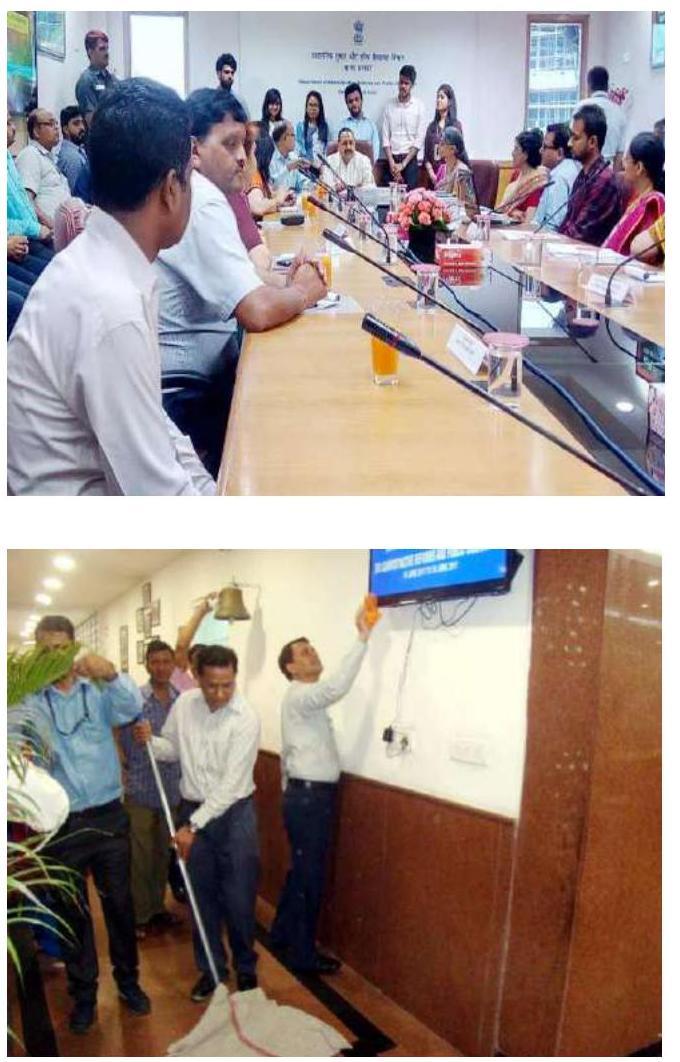
19.12 Celebration of International Day of Yoga
19.12.1 DARPG celebrated $3^{\text {rd }}$ International Day of Yoga on $21^{\text {st }}$ June, 2017. In this connection, regular Yoga classes were organized in office premises during the period, which were attended by the officers and staff members. The officials of the Department also participated in the Yoga at different places, organized on the occasion of $3^{\text {rd }}$ International Day of Yoga on $21^{\text {st }}$ June, 2017.
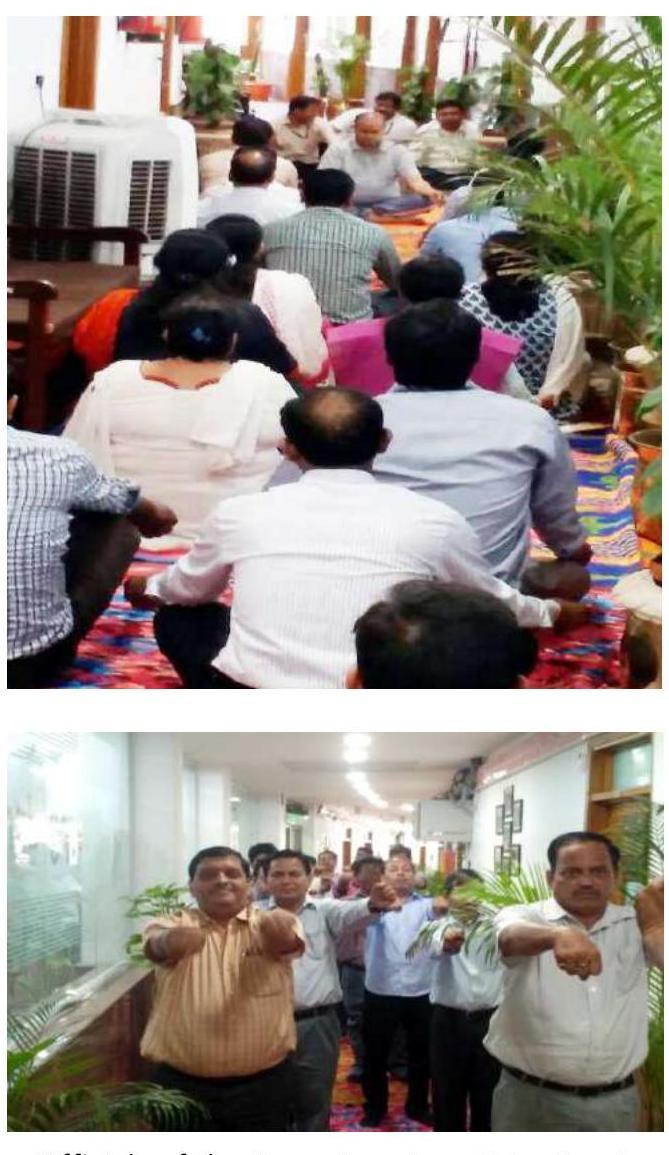
Officials of the Department participating in Yoga classes
20
CHAPTER
Administrative Reforms
Civil Services Day and Prime Minister’s Awards Scheme for Excellence in Public Administration
20.1 Government of India celebrates April 21 every year as ‘Civil Services Day’ for the civil servants to rededicate themselves to the cause of citizens and renew their commitment to public service and excellence in work. This date coincides with the date when the first Home Minister of Independent India Sardar Vallabhbhai Patel addressed the first batch of Indian Administrative Service Officers at Metcalfe House New Delhi. The first such function was held in Vigyan Bhavan, New Delhi on $21^{\text {st }}$ April, 2006. On this occasion, the Hon’ble Prime Minister conferred “Prime Minister’s Award for Excellence in Public Administration” to acknowledge, recognize and award the extraordinary and innovative work done by officers of the Central and State Governments including Districts.
20.2 Civil Services Day, 2017 was observed on 20-21st April, 2017 at Vigyan Bhavan, New Delhi. On this day, panel discussions on ‘Creating value through Human Capital Management in Government’ and Three Breakaway Sessions on ‘Agriculture’, ‘Energy’ and ‘Skill Development and Entrepreneurship’
were organized. Inputs on the theme ‘Creating value through Human Capital Management in Government’ were taken from 533 District Collectors and these were crystallized in the form of a discussion paper for the panel discussion. In addition 55 shortlisted initiatives were shared with batches of IAS officers from 2013 to 2016. Inputs from 615 officers were discussed in various panel discussions.
20.3 On Civil Services Day, 2017, the Hon’ble PM presented the total of 12 awards, of which 10 awards were given to the best performing districts in implementing Priority Programme namely (i) Pradhan Mantri Krishi Sinchayee Yojana (ii) Deen Dayal Upadhayay Gram Jyoti Yojana (iii) Pradhan Mantri Fasal Bima Yojana(iv) Start Up India (v) Stand Up India and (vi) e-National Agriculture Market (e-NAM) and 02 awards to the organization of Central/ States/UTs including Districts for Excellence in Innovation in Public Governance. Under this scheme, awards were given for implementing Priority Programmes of Govt. of India and for Innovation in environment conservation, disaster management, water conservation, energy, education and health, women and child centric initiatives etc.
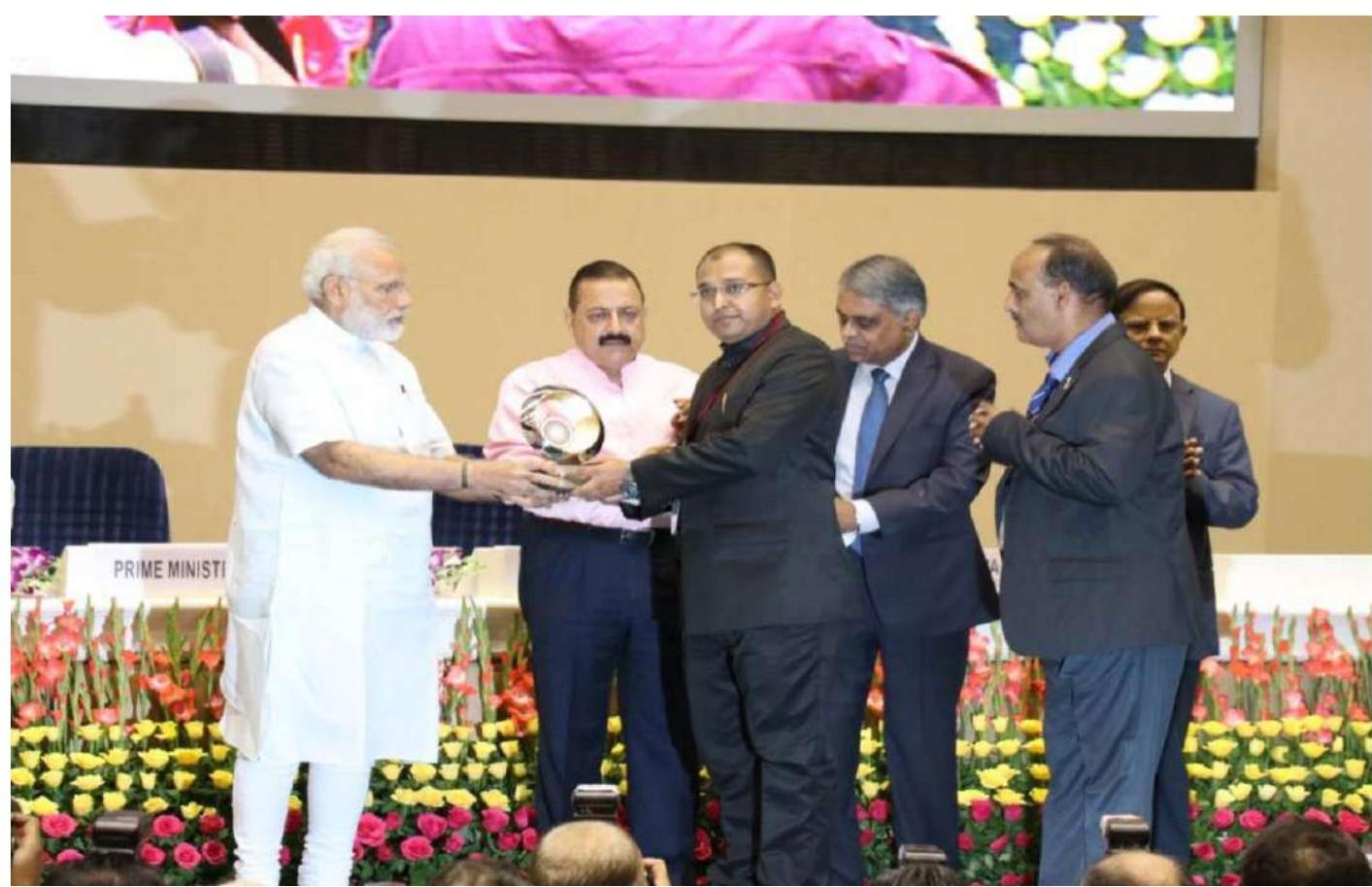
Hon’ble PM presenting the Awards for Excellence in Public Administration on $21^{\text {st }}$ April 2017 at Vigyan Bhawan, New Delhi
20.4 For Civil Services Day, 2018 Priority Programmes namely, (i) Pradhan Mantri Fasal Bima Yojana (ii) Deen Dayal Upadhayay Grameen Kaushalya Vikas Yojana (iii) Promoting Digital Payments (iv) Pradhan Mantri Awas Yojana – Urban & Rural have been identified for awards. In addition, two awards will also be given to an organization of Central/States/ UTs including Districts for Innovation in Public Governance in the field of environment conservation, disaster management, water conservation, energy, education and health, women and child centric initiatives etc., of which 01 award will be given to an Aspirational.
20.5 Application for PM Awards will be received online on designated portal and will be evaluated by three levels of Committees i.e. Screening Committee chaired by Additional Secretary level officers, Expert Committee chaired by Secretary Department of AR \& PG and Empowered Committee chaired by Cabinet Secretary. Citizens’ feedback of shortlisted Districts/ Organizations obtained through Call Centre, spot study reports and presentation / interaction by the Districts etc. will be taken into account while selecting the candidates for PM Awards.
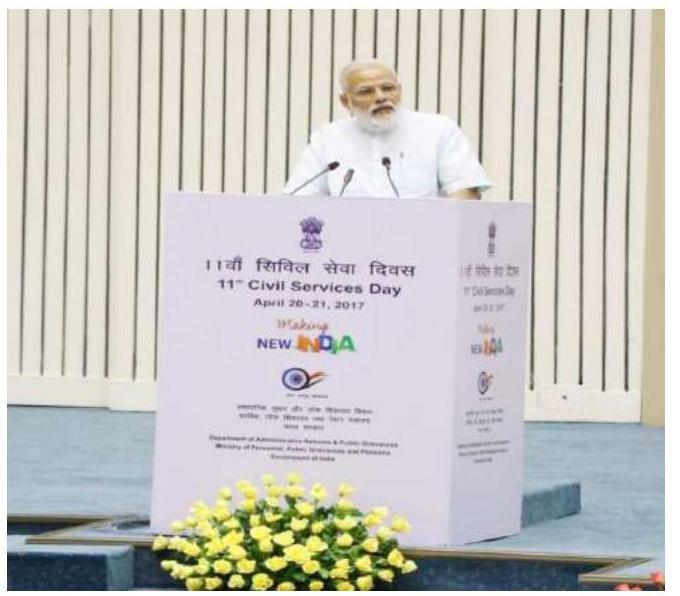
Hon’ble Prime Minister addressing $11^{\text {th }}$ Civil Services Day function in New Delhi on $21^{\text {st }}$ April 2017
State Collaboration Initiatives
20.6 DARPG provides funds to the State Governments under the scheme “State Collaboration initiative” with a purpose to improve public service delivery. The scheme
was revised in 2015-16 to include funding for replication of PM awarded and National e-Governance awarded initiatives. In the year 2016-17, DARPG funded approx. Rs. 3.50 Crores to 5 projects in three States.
Good Governance Index
20.7 Department of Administrative Reform and Public Grievances (DARPG), GOI has been mandated to develop Good Governance Index (GGI) recommended by Group of Secretaries (GoS) on Governance. Proposed Good Governance Index would present a statewise comparative picture about the strong and weak areas of service delivery, which would help them in generating performance improvement mechanism. The work has been assigned to Centre for Good Governance (CGG), Hyderabad for technical assistance. The parameters of Good Governance are being developed through consultation with various stakeholders.
Public Grievances
MANDATE
The Public Grievances Division is responsible for issuing policy guidelines and coordinating & monitoring of issues regarding redress of public grievances and staff grievances for the Central Government. In accordance with federal principle of governance, the grievances relating to States are forwarded to concerned State Government for appropriate action. The PG Division also coordinates the implementation of Sevottam which is a part of a citizen centric quality management framework for better service delivery.
21.1 The Allocation of Business Rules, 1961, allocates to DARPG inter alia, the responsibility for Policy, Coordination and Monitoring of issues relating to (a) Redress of Public Grievances in general and (b) Grievances pertaining to Central Government Agencies, in particular. The Public Grievance Division is responsible for this activity since December 1987. From 1997, the Division has also been made responsible for several Citizen Centric Initiatives under the platform of ‘Responsive Government’. These include Citizens’ Charter, Information Facilitation Counters, and Quality Management System (QMS) framework called Sevottam, for bringing improvement in public service delivery on a continuous basis that may result in Certification under Indian Standard 15700:2005 by Bureau of Indian Standards.
21.2 The management of Public Grievances today envisages reduction in grievances, by bringing continuous improvement in Public Service Delivery through the extension of Quality Management System ‘Sevottam’ at the Centre as well as in the States. Accordingly,
a Scheme for strengthening of State ATIs through implementation of Sevottam Cell is in place under which 10 State ATIs are being funded by the Department.
21.3 The Public Grievances Division has undertaken the following activities during the year and before:-
21.4 Grievance Redress
21.4.1 An online system for grievance redress, called the ‘Centralized Public Grievance Redress and Monitoring System’ (CPGRAMS) has evolved since 2007. At present its upgraded version 5.0 is accessible at http://pgportal. gov.in and also through www.darpg.gov.in. It interlinks 139 Ministries/Departments/States/ UTs and other Apex organizations in CPGRAMS. There are 26400 sub-ordinate users listed on it which includes subordinate and field offices. The number of subordinate users linked to CPGRAMS has increased from about 1500 in 2010-11 to over 35,000 in 2017-18. CPGRAMS is also available in Hindi.
Grievance Receipts/disposal in CPGRAMS as on 31-12-2017
CPGRAMS
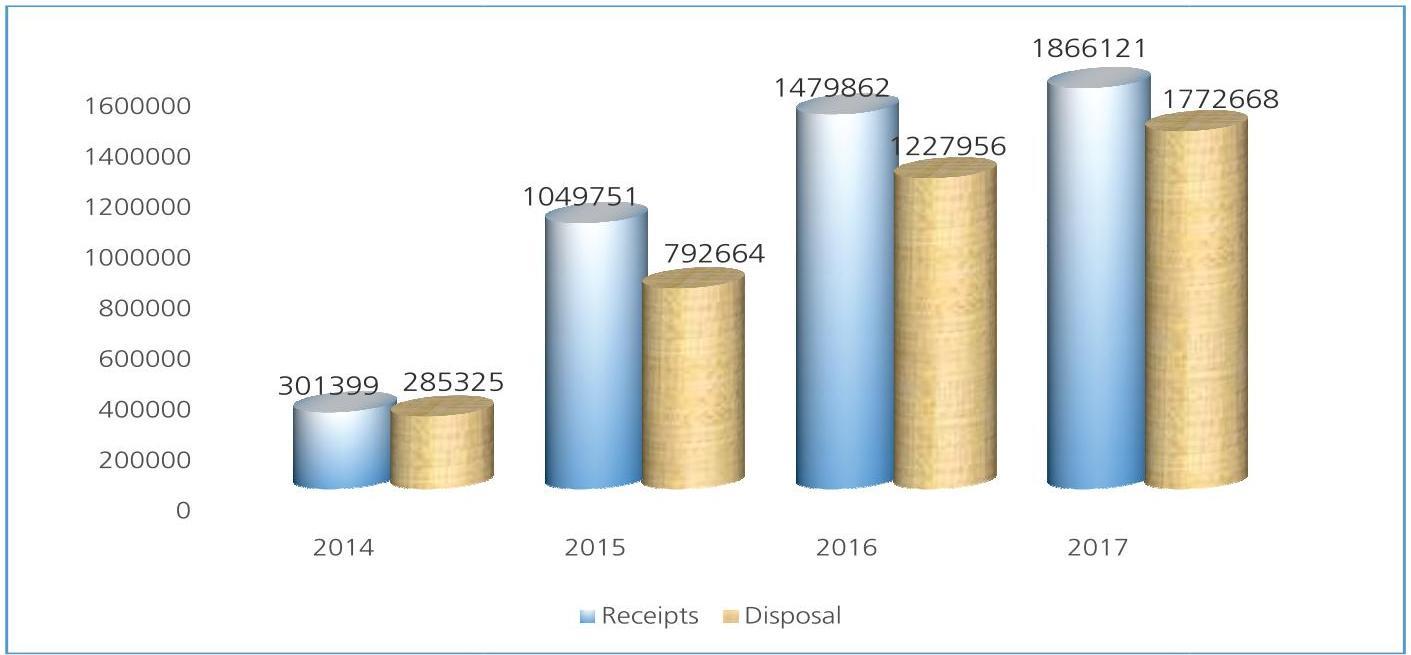
Total No of Organizations registered in CPGARMS
Total Ministry/Departments/States/UTs
Total grievances sent to States by DARPG during 1.1.2017- 31.12.2017
(Electronic Complaints: 38649, by Manual/ Post: 5995)
State Governments
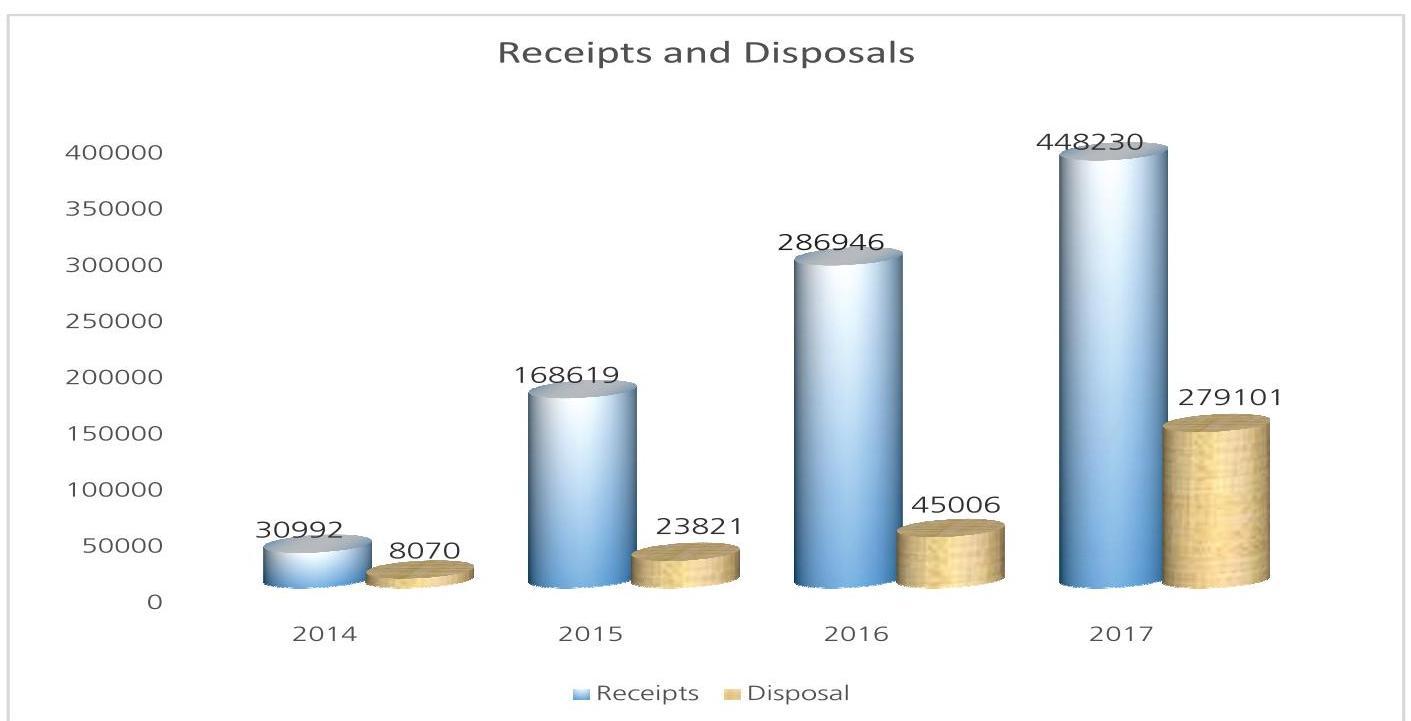
Central Governments
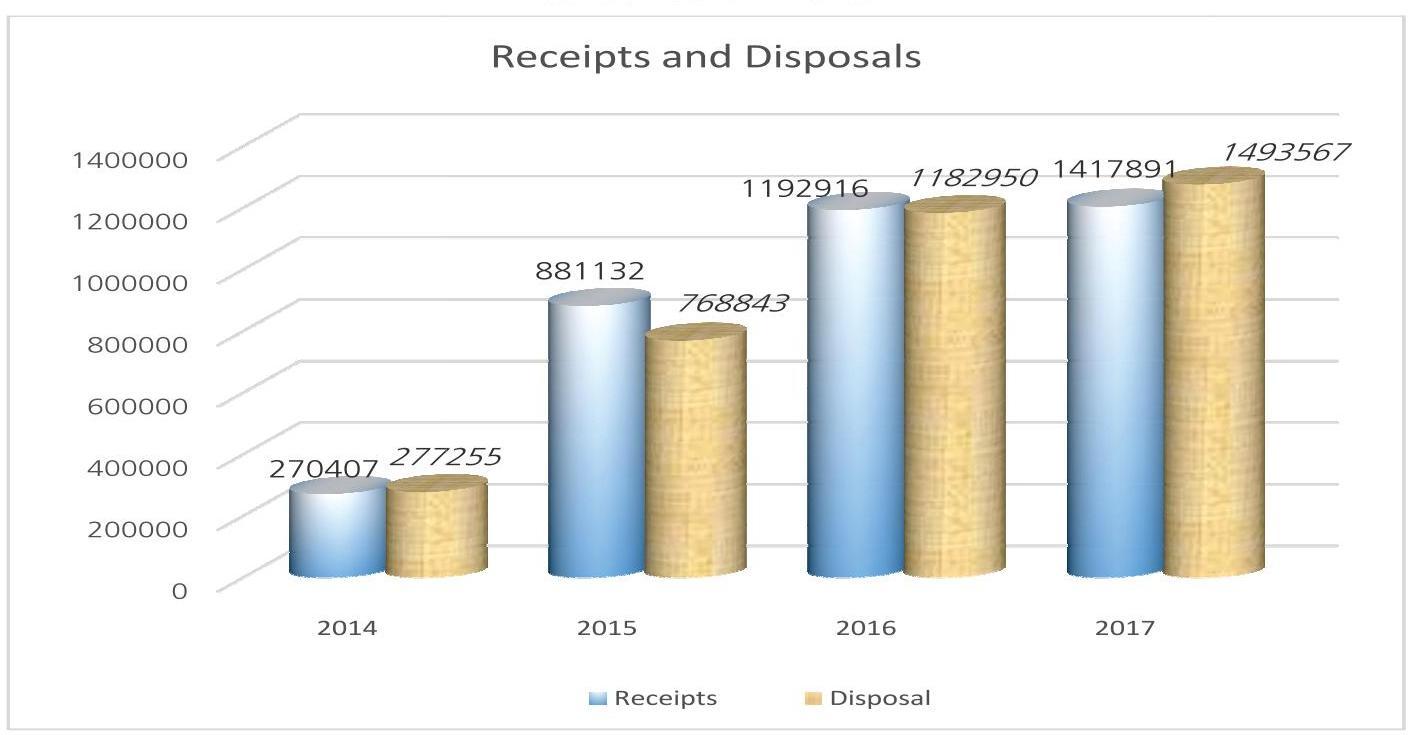
21.4.2 The public interface of pg portal has been duly integrated with the pensioners’ portal and Public grievance mechanism of PMO available on website www.pmoindia.gov. in. For providing grass root access to the pg portal, the Common Service Centre has been integrated with it on a trial basis so that a person can lodge a grievance on the pg portal through the Common Service Centre located in his area by paying a nominal fee.
21.4.3 Extending CPGRAMS to State
Governments/Union Territories- The codes for using the CPGRAMS, through the Internet, have been provided to all State Governments. During the year, the Division has extensively used the System to forward public grievances to the State Governments concerned. From $1^{\text {st }}$ January 2017 to 31.10 .2017 a total of 12096 grievances have been sent to State Governments by Department of ARPG. Out of these, 10207 were received electronically,
and 1889 were received by post or given in person by the complainants. The inflow of State related grievances is in two forms (i) through the CPGRAMS and (ii) through post. The grievances received by post are digitized and sent both through the System as well as by post to the State Government concerned. Redress response as received is sent by post, to the complainant.
21.4.4 CPGRAMS with local language interface, has so far been launched in all departments of the Governments in the 9 States of Haryana (www.harsamdhan. gov.in), Orissa (www.cmgcorissa.gov. in), Rajasthan (www.sugamrpg.raj.nic.in), Mizoram (http://mipuiaw.nic.in), Meghalaya (http://megpgrams.gov.in), Union Territory of Puducherry (http://puduvaikural.puducherry. gov.in), Uttrakhand (samadhan.uk.gov.in), Jharkhand (http://jharkahandsamadhan.nic.in) and Punjab (http://shikayatnivaran.gov.in.
Figure Snapshot of PG Portal version 5.0 in English
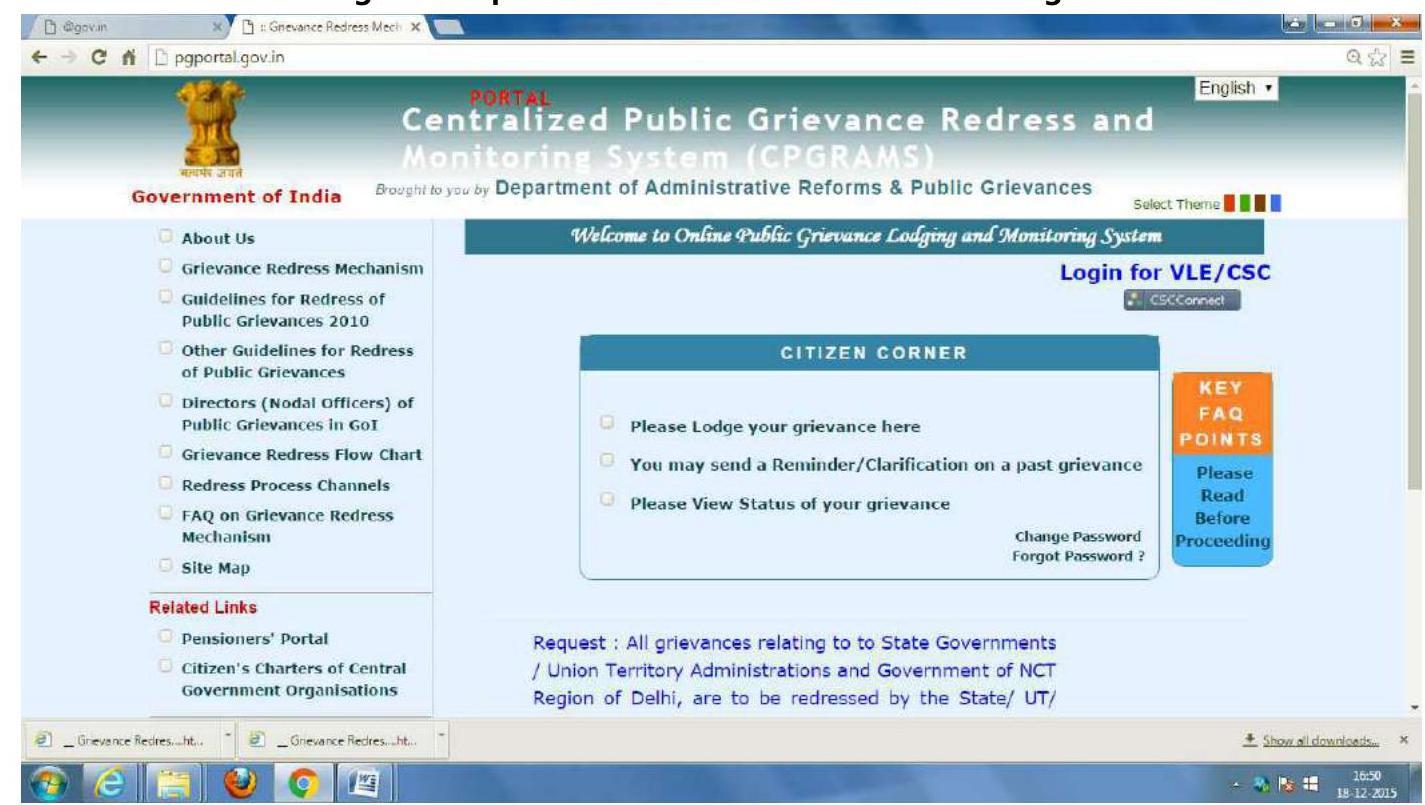
Figure Snapshot of PG Portal version 5.0 in Hindi.
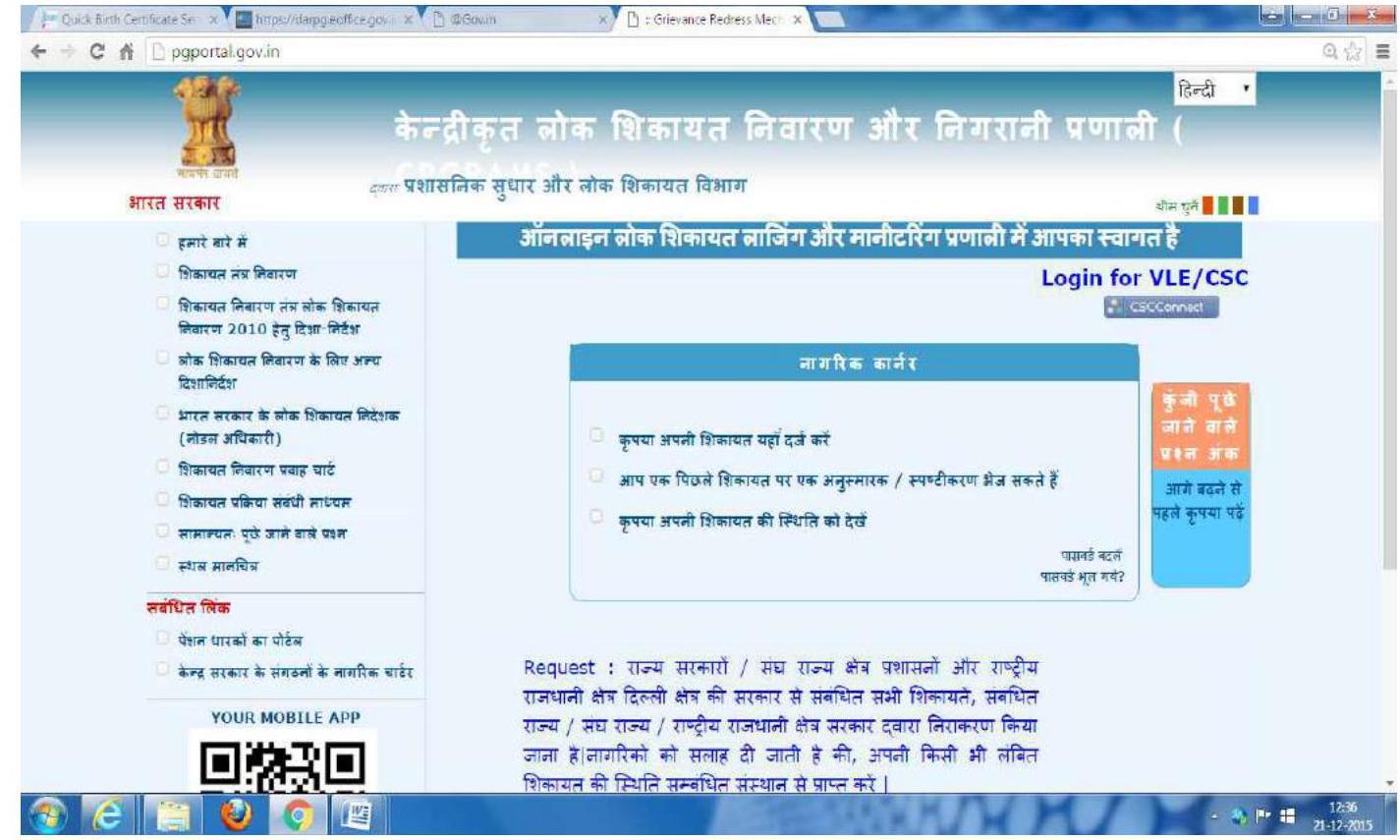
21.4.5 A new version 6.0 of CPGRAMS has been created with several additional features viz., one time registration, lateral transfer of grievances among Ministries/ Departments, etc. The new version is ready and will be launched shortly.
21.4.6 A Mobile App available in the pg portal allowing lodging of public grievances from android based mobile was launched on 21.10.2015 by the Hon’ble MoS (PP). The Action Status can be viewed on the mobile itself. A new Mobile App with some added features has been developed. The new App is more user-friendly. This has been integrated with Unified Mobile Application for New-age Governance (UMANG).
21.4.7 Study reports on the Grievance Analysis Study conducted by Quality Council of India for identifying grievance prone areas, root cause analysis and systemic reforms in r/o top 20 grievance receiving Ministries/ Departments/ Organizations listed on pg portal were duly circulated to the concerned Ministries/ Departments/Organizations. For further action on recommendations, a Project Management Unit (PMU) has been set up in the Department for monitoring the reforms. A number of reforms have already
been introduced by some of the Ministries/ Departments viz., automatic refunds on cancellation of Railway Tickets, Single Window Pension through disbursing Banks, intensive mechanized cleaning of coaches, e-verification of Income Tax Returns, expeditious Income Tax Returns upto Rs.50,000/-, etc.
21.4.8 An online Dashboard has been developed for monitoring further action on this reform. A framework has been created to enable highlighting the impact of implemented reforms on the Dashboard in consultation with the concerned Ministries/ Departments. This will be launched shortly.
21.4.9 In continuation of the Grievance Analysis Study in respect of top 20 Ministries/ Departments receiving maximum grievances on CPGRAMS, another Grievance Analysis Study for next 20 Ministry/ Departments receiving bulk of the grievances was concluded during the year. The reports were released by the MoS (PP) in the Department on 25.08.2017 and thereafter circulated to the concerned Departments/ Ministries for further action on the recommendations regarding systemic reforms contained in the Reports. The Reports contained 100 reforms for reducing grievances leading to better public service delivery.
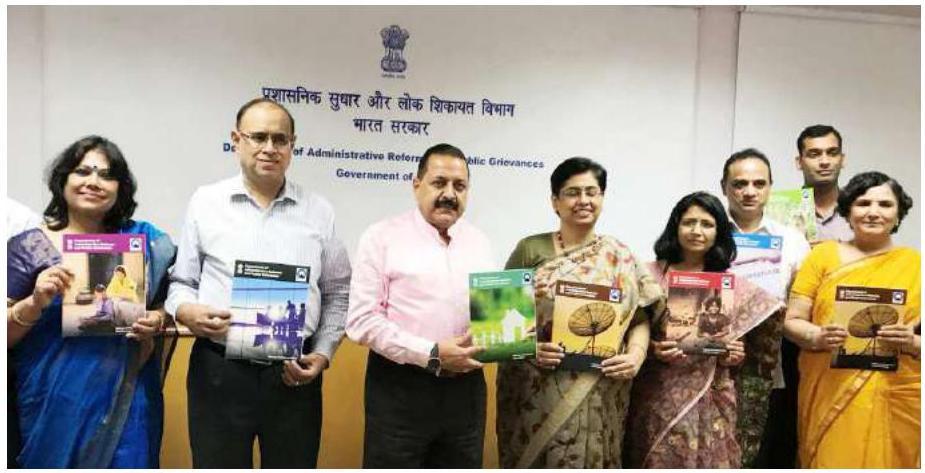
Release of diagnostic Study
Report on public grievance for the next 20 Ministries/
Departments receiving bulk of grievances
21.4.10 A Public Grievances Call Centre that was started on pilot basis for reminding the concerned officials of 20 Ministries/ Departments/Organizations receiving maximum grievances w.e.f. February, 2016 has been continued upto 31.3.2018. It is now reminding top 40 grievance receiving Ministries/ Departments for expeditious action on pending grievances. The PG Call Centre has also been collecting feedback on some of the grievances disposed through CPGRAMS which are being shared with the Ministries/ Departments concerned.
21.4.11 During the year 2017, operational trainings on CPGRAMS have been regularly held in the Department.
21.4.12 During the period from 1.1.2017 to 9.11.2017, 5 review meetings for reviewing the status of pending public grievances in Ministries/Departments and expediting action on them have been held in Department of ARPG. A total of 66 Ministries/Departments
participated. A presentation was made by CBDT during the review meeting dated 4.10.2017on the measures taken for reduction in grievances.
21.4.13 An Award Scheme has been launched for recognizing outstanding performance on CPGRAMS through issue of Certificate of Appreciation. The Scheme not only takes into consideration the number of grievances disposed by the Ministries/ Departments/ Organizations, but also the feedback of the petitioners whose grievances have been closed in the System. Till now 21 Certificates of Appreciation have been awarded. This year, Certificate of appreciation was awarded by MoS (PP) on 04.09.2017 to 5 Ministries/ Departments/ Organizations listed on CPGRAMS for the first and second quarter of 2017 viz. Central Board of Direct Taxes, M/o Micro, Small and Medium Enterprises, M/o Development of North Eastern Region, M/o Panchayati Raj and D/o Administrative Reforms and Public Grievances.
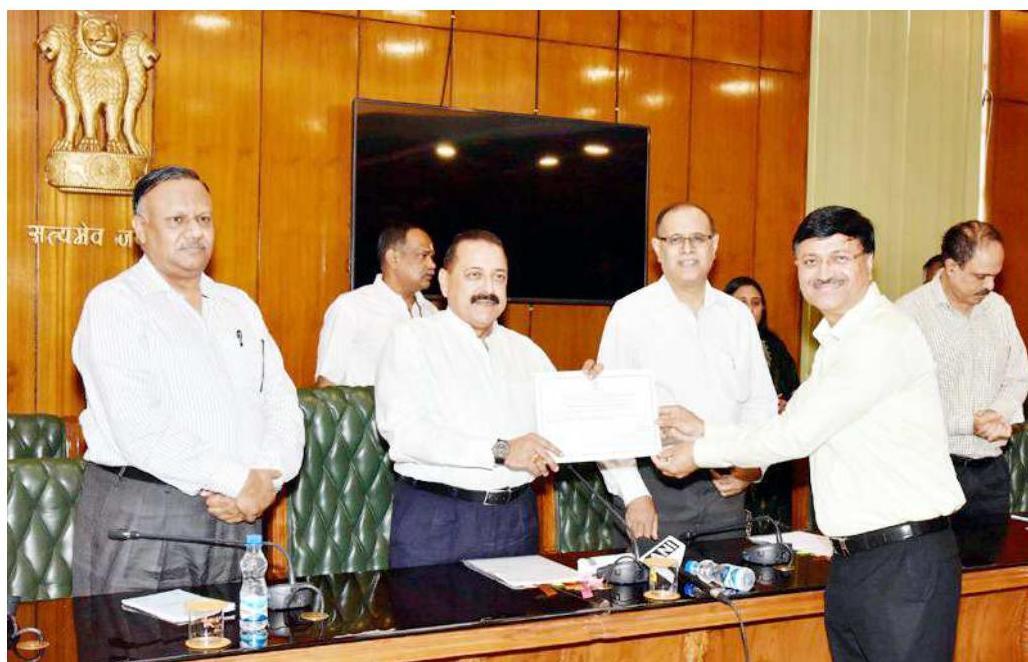
Certificate of Appreciation is being awarded by Hon’ble MoS (PP) to Ministries/ Departments/ Organizations for outstanding performance on CPGRAMS
21.5 PUBLIC SERVICE DELIVERY
Introductory
21.5.1 Quality Management System (QMS) Sevottam framework for bringing excellence in service delivery by Government organizations: A Quality Management System (QMS) ‘Sevottam’ framework has been developed for bringing improvements in the quality of public service delivery. This is a citizen centric initiative for institutionalizing an assessment-improvement framework for improving the quality of service delivery on a continuous basis through the involvement of Ministries / Departments and citizens. Sevottam includes three dimensions of a public service organization as follows: (a) Citizens’ / Clients’ Charter that specifies the service delivery standards (b) Grievance Redress Mechanism that gets activated if the service delivery is not as per standards in the charter (c) Service Delivery Capability of the organization to delivery service as per standards in the charter.
21.5.2 Under the Sevottam (Plan) pilot projects, a new Scheme for Strengthening of the State ATIs and CTIs, has been started from October 2012, for building capacity of the ATI to become consultants for implementing Quality Management System ‘Sevottam’ in all departments of the State Governments, including replication of best practices from other States/UTs. A number of on-campus and off-campus training have been held by the ATIs for sensitizing the officers of the State Government in implementation of Citizens’ Charter and Grievance Redress Mechanism. A meeting for reviewing the performance of the State ATIs was held in the Department on 13.6.2017. The meeting was attended by
the representatives from 7 State ATIs. It was decided that officers from DARPG may visit ATIs which have done significant work to understand the best practices and challenges involved in implementation of Sevottam. The Participating ATIs were requested to give their action plan for current year. They were also asked to give suggestions for making the Scheme more relevant.
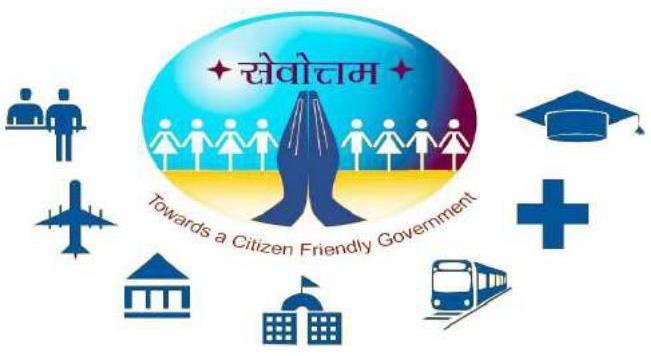
The logo adopted for Sevottam
21.5.3 Based on the utilization certificates received and performance, the next installment of grant under the above scheme, has been released during the year to the 2 State ATIs viz., Haryana and Himachal Pradesh.
21.6 CITIZENS’/ CLIENTS’ CHARTERS
21.6.1 The Citizen/Client charter of DARPG for 2015-16 has been prepared and duly uploaded on the web site of the Department. The Contact details of the officers were updated during the year.
21.6.2 The Department related Parliamentary Standing Committee on Personnel, Public Grievance, Law & Justice visited Mumbai, Chandigarh, Kasauli and Shimla during 5th to 11th June, 2017. During the visit, the Parliamentary Standing Committee on grievance also interacted on the functioning of Public Grievance Redressal Mechanism in the States.
22
CHAPTER
Organisation and Methods Division
Mandate
- Formulation and simplification of common office procedures.
- Publication and updating of the paper based Central Secretariat Manual of Office Procedures (CSMOP), Central Secretariat Manual of e-Office Procedure (CSMeOP) and Record Retention Schedule (RRS).
- Aiding and advising the Central Ministries/Departments and States/UTs Governments on O&M aspects.
- Implementation of the Plan Scheme of Modernization of Central Government offices located in the city of Delhi.
Manual of e-Office Procedure (MOP)
22.1 With a view to integrating paper based Central Secretariat Manual of Office Procedure, electronic based Central Secretariat Manual of e-Office Procedure (CSMeOP) and user’s manual on e-Office formulated by NIC, the Department has engaged the services of ISTM to prepare a single MOP, which will also be called the 2nd Edition of CSMeOP. The ISTM has submitted a draft of the MOP, which is under consideration in this Department. The ISTM was asked to make certain modifications in it which is under examination of the Department. The comprehensive MOP is expected to be released during this financial year.
22.2 An inter-Ministerial Committee headed by the Additional Secretary, Department of Administrative Reforms \& Public Grievances with members from the Department Legal
Affairs, Ministry of Culture, National Archives of India (NAI), Ministry of Electronics \& Information Technology (MeiTY), National Informatics Centre (NIC), DOP\&T, Department of Expenditure, Ministry of Railways and Department of Posts have given their recommendations regarding prescribing a fresh Record Retention Schedule (RRS) for electronic/digitized records and also to take a decision on disposal/retention of once they have been digitized. The recommendations are under examination.
Modernization of Government Offices Scheme
22.3 In order to give catalytic effect to modernization of offices as an overall process of Administrative Reforms, DARP\&G is implementing a Plan Scheme for Modernization of Government offices located in the city of Delhi since the year 1987-88.
22.4 Under the Scheme the Department provides $75 %$ of the total cost of the project as recommended by an Inter-Ministerial Screening Committee as financial assistance and the beneficiary has to chip in with $25 \%$ of the cost. Since 1987-88 till date DAR&PG has extended a financial assistance of Rs.75.52 crore approximately for financing 460 modernization projects/proposals. During the current financial year, DAR\&PG proposes to release Rs. 6.00 crore for financing 10 modernization proposals.
23
CHAPTER
E-Governance
23.1 Department of Administrative Reforms & Public Grievances (DAR\&PG) and Ministry of Electronics \& Information Technology (MeiTY) in association with one of the State/ UT Governments has been organizing the annual National e-Governance Conference since the year 1997. This Conference provides a platform to the senior officers of the Government including IT Secretaries of State Governments, IT Managers of the Central Government, and Resource Persons, Experts, Intellectuals from the industry and academic institutions etc. to discuss, exchange views and experiences relating to various e-governance initiatives. In the National e-Governance
Conference, National e-Governance Awards are also given to the initiatives which have excelled in the field of e-Governance. The $20^{\text {th }}$ National Conference on e-Governance was held in Visakhapatnam, Andhra Pradesh on 9-10 th January, 2017. During the Conference, the National e-Governance Awards were given under 12 different categories of excellence in the field of e-Governance. On the occasion, the Department also released four booklets, namely, (i) Background paper; (ii) Compendium of selected papers; (iii) Excellence in e-Governance; and (iv) Citations for National e-Governance Award Winners.
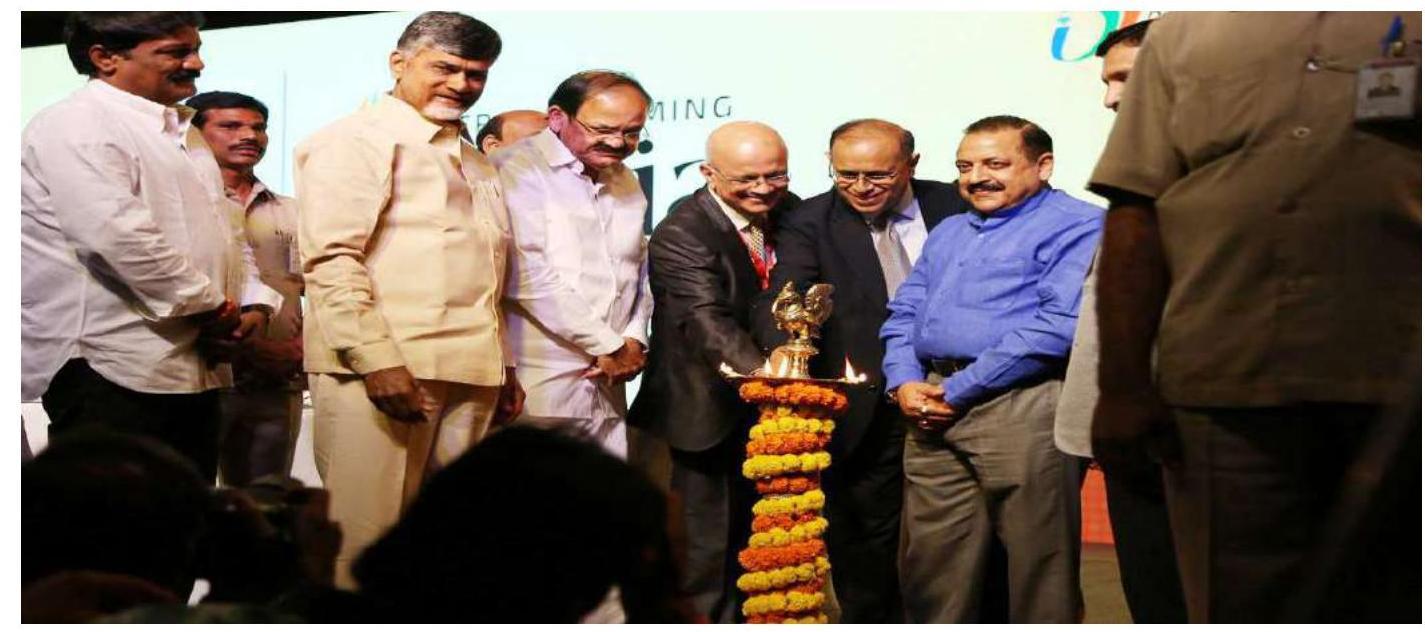
Inaugurating the $20^{\text {th }}$ National Conference on e-Governance by lighting the lamp and sequence from left to right Shri Nara Chandrababu Naidu, Hon’ble CM of Andhra Pradesh, Shri M. Venkaiah Naidu, the then Hon’ble Minister of Urban Development, Housing \& Urban Poverty Alleviation,
Information & Broadcasting, Shri R. Chandrasekhar, President, NASSCOM, Shri C. Viswanath, the then Secretary, DARPG and Dr. Jitendra Singh, Hon’ble Minister of State (Independent Charge ), Ministry of Development of North Eastern Region, Minister of State Prime Minister’s Office, Ministry of Personnel, Public Grievances \& Pensions, Department of Atomic Energy and Department of Space
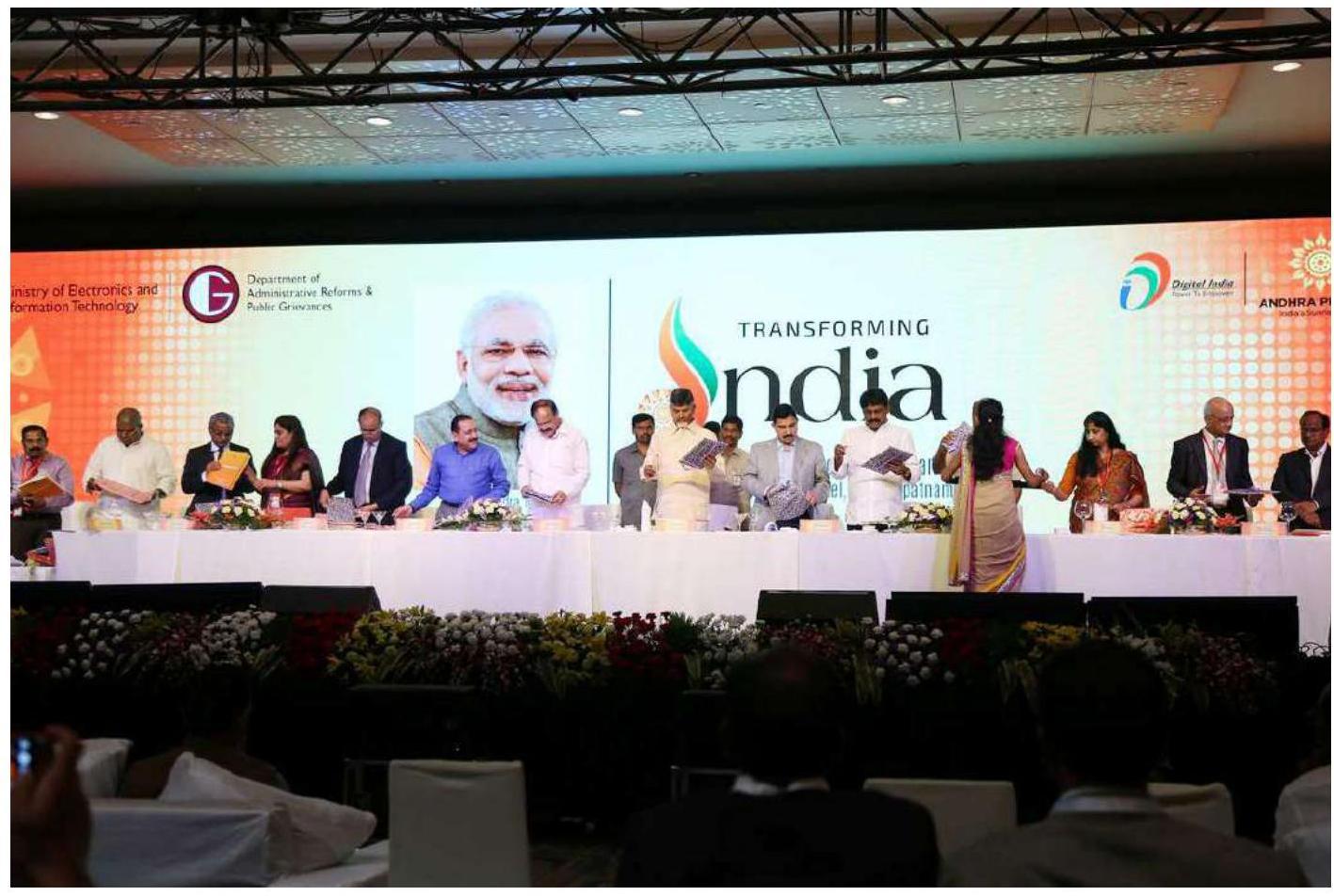
Dignitaries on the DAIS releasing the NCeG booklets; Sequence from left to right:- Shri K. Vijayanand, Secretary (IT), Government of Andhra Pradesh, Shri Palle Raghunatha Reddy, Hon’ble Minister of Information \& Public Relations, Information Technology \& Communications, Non-Resident Indian Empowerment \& Relations, Telugu Language \& Culture, Minority Welfare \& Empowerment, Government of AP. Shri J. Satyanarayan, Advisor to Govt. of AP and Chairman, UIDAI, Smt. Usha Sharma, the then AS (ARPG), Shri C. Viswanath, the then Secretary, DARPG, Dr. Jitendra Singh Hon’ble MoS for Ministry of Development of North Eastern Region, Prime Minister’s Office, Ministry of Personnel, Public Grievances \& Pensions, Department of Atomic Energy and Department of Space, Shri M. Venkaiah Naidu, the then Hon’ble Minister of Urban Development, Housing\& Urban Poverty Alleviation and also Information \& Broadcasting, Shri Nara Chandrababu Naidu, CM of AP and Shri Y.S.Chowdary, Hon’ble Minister of State for Science and Technology \& Earth Sciences, GOI
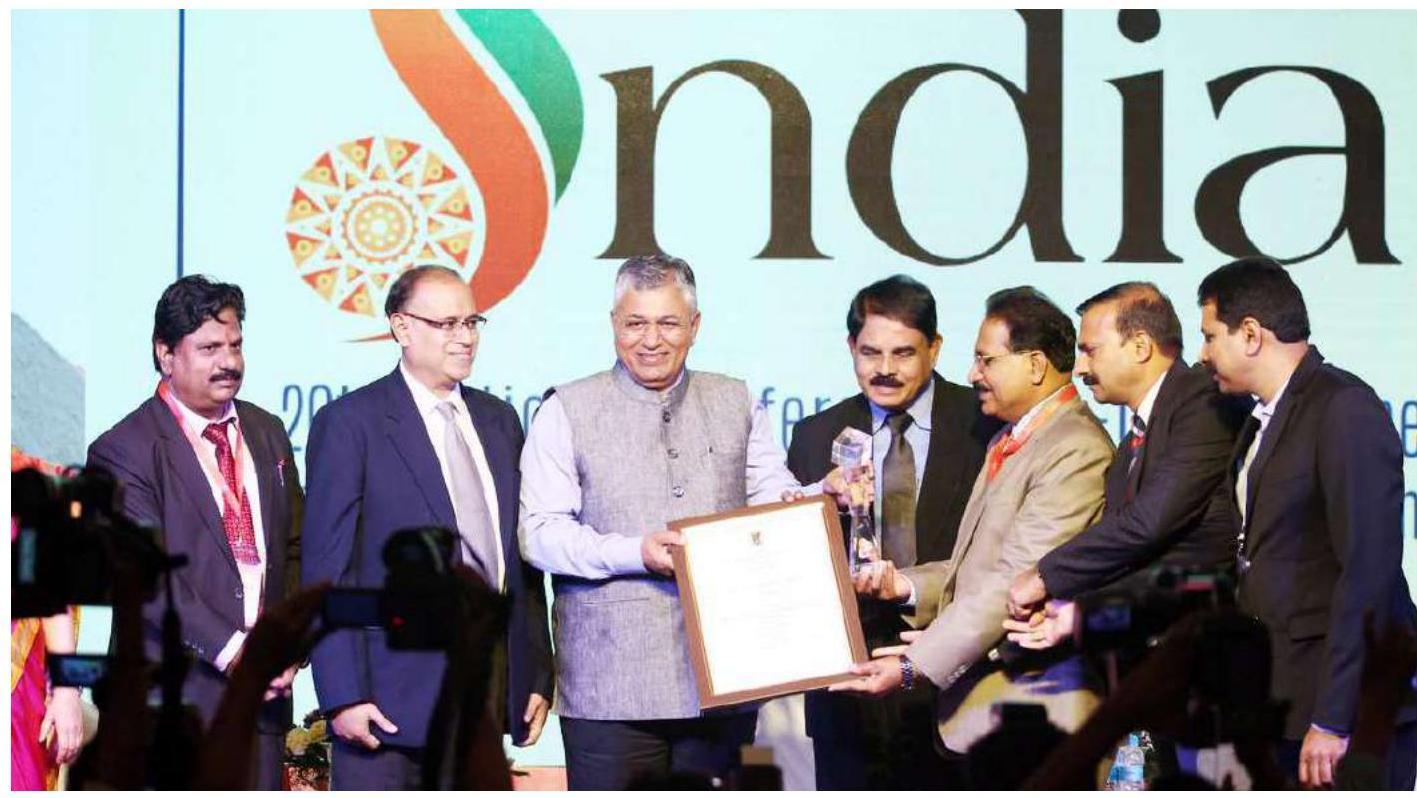
Shri P. P. Chaudhary, Hon’ble Minster of State for Electronics & Information Technology and Law \& Justice along with Shri C. Viswanath, the then Secretary, DARPG during the award distribution ceremony
23.2 21st National Conference on e-Governance is going to be organized by the State Government of Telangana in Hyderabad on 26-27th February, 2018. During the Conference, it is proposed to give National e-Governance Awards under 9 different categories, namely, (i) Excellence in Governance Process Re-engineering (ii) Outstanding Performance in Citizen-centric Service Delivery (iii) Innovations in existing projects of Government Departments other than PSUs (iv) Best District level initiative through ICT in (1) North East States; (2) Hill States + UTs (excluding Delhi); (3) Other States (v) Use of Spatial Technology and GIS in e-Governance (vi) Innovative Use of ICT by Central Government PSUs/State Government
PSUs(vii) Outstanding initiative in e-Governance by Academic/Research Institutions and NGOs, including Cooperatives/ Federations/Societies (viii) Innovative Use of ICT in e-Governance Projects/initiatives by Start-ups, registered with Government (ix) Replication/Adaptation of the best e-Governance projects/ practices awarded during 01.04.2014 to 31.03.2017.
23.3 The Department of Administrative Reforms \& Public Grievances during the current financial year has taken a decision to replicate the initiatives, which have won National e-Governance Awards in the past, in the other parts of the country. For the purpose, the Department has engaged the services of Vision Indian Foundation, for acting as Consultant, on free of cost basis.
23.4 For the purpose of replication, the DAR&PG had organized a workshop of all States/UTs on $31^{\text {st }}$ August, 2017 in New Delhi for eliciting their feedback on replication of the following three past awarded e-Governance initiatives.
(i) Madhya Pradesh State Pension Portal, an e-governance initiative.
(ii) Application of e-governance and Geographic Information System (GIS) for efficient property tax collection by the Surat Municipal Corporation.
(iii) Application of e-Governance in Mysore Intelligent Transport System (ITS)
In the Workshop the representatives from many States/UTs and line Central Ministries/ Departments had participated. The Workshop was successfully organized. The three project teams presented their respective projects and addressed queries raised from officials of different states/UTs. The workshop developed deeper into practicalities of project implementation with sessions on avenues for central financial assistance and drafting of DPR/RFP/SRS. A number of States/UTs government expressed their willingness to replicate the above mentioned three awarded e-Governance initiatives in their State/UT. The Department also organized a one day workshop in Surat, Gujarat on $10^{\text {th }}$ October,
2017 for all the States/UTs to have firsthand experience of the ‘application of e-Governance and GIS technology for property tax collection’.
e-OFFICE
23.5 Effective steps have been taken by DAR\&PG to expedite implementation of e-office in all central Government Ministries/ Departments by conducting regular review meetings and also by establishing a project monitoring unit in the Department. As on date 31 Central Ministries have moved into complete e-Office platform and about 46 Central Ministries/Departments have also started showing improving trends in e-Office implementation.
Workshop on e-Office
23.6 A workshop on best practicesone-Office implementation was organized by DAR\&PG on 04.07.2017 at Civil Services’ Officers Institute (CSOI), Vinay Marg, Chanakyapuri, New Delhi. In the workshop, apart from National Informatics Centre making a presentation on the subject, the officials of the Ministry of Water Resources, River Development \& Ganga Rejuvenation, Ministry of Railways and Ministry of Civil Aviation made presentations of the success stories in their respective Ministries. In the workshop a lot of exchange of ideas took place, feedback given and impediments pointed out.
24
CHAPTER
International Exchange and Cooperation
24.1 The Department of Administrative Reforms & Public Grievances (DARPG) deals with matters relating to international exchange and cooperation in the field of Public Administration and Governance, which includes, among other things, organizing programmes and visit of Indian delegations to foreign countries and visit of foreign delegations to India as part of projects / bilateral measures in furtherance of activities included in the Memorandum of Understandings (MOUs) / Agreements signed between India and other countries (bilateral or multilateral).
24.2 The aim of international exchange and cooperation component is to share information, best practices and personnel across national governments. Presently bilateral MOUs in the areas of Public Administration and Governance have been signed with France, Malaysia, Singapore, United Kingdom, Portugal, China and trilateral MoU with Brazil and South Africa (IBSA). MOUs with China and Singapore are under renewal. MOUs with these countries have enabled exchange of visits and undertaking programmes/projects and activities in the field of Civil Services, Personnel Management, Public Administration and Governance.
24.3. India-Portugal Cooperation
24.3.1 Department has signed an MoU in June, 2017 with Ministry of the Presidency and
of Administrative Modernization, Government of Portuguese Republic on ‘Cooperation in the field of Public Administration and Governance Reforms’. The areas of co-operation under this MoU includes Digital transformation of Government, Administrative simplification and process re-engineering, Public Service Delivery, Building and developing staff capability, Sharing good governance practices in public administration, Public Grievance Redress Mechanism.
24.3.2 In pursuance of the MoU, a Senior Consultative Body meeting between the two countries is likely to be held in mid-January, 2018 to have a close interaction with Portugal side.
24.4 India – United Kingdom Cooperation
24.4.1 Department of Administrative Reforms and Public Grievances, has signed a MoU with the Cabinet Office, Her Majesty’s Government of the United Kingdom (HMG), for ‘Cooperation in Public Administration and Governance Reforms in November, 2015.
24.4.2 The main objectives of the MoU are to strengthen and promote bilateral cooperation between the two countries in public administration and governance. The areas of co-operation under this MoU includes (i) sharing good governance practices in public
administration, (ii) user led service design, (iii) reducing bureaucracy in service delivery, (iv) government process re-engineering, (v) building and developing staff capability, (vi) public grievance redress mechanism, (vii) local government reforms, (viii) reforms towards strengthening of social security, (ix) collaboration in strategies for promotion of ethics in Government, (x) collaboration between Government and industry on staff management., (xi) mechanisms for public engagement, (xii) crisis and disaster management and (xiii) digital transformation of government.
24.4.3 India-UK First Joint Working Group meeting was held in London, UK in January, 2016. Both sides shared their best practices in the area of public administration, governance reforms and online delivery of citizen-centric services and explored the possibilities of adopting suitable best practices in these areas. Subsequently, four member delegation from the Govt. of United Kingdom led by UK’s Chief Technology Officer [Mr. Andy Beale, CTO Government Digital Service (GDS)] visited India during in September, 2016.
24.5 India – France Cooperation
24.5.1 The Department of Administrative Reforms and Public Grievances, Ministry of Personnel, Public Grievances & Pensions has signed a Partnership Agreement in January, 2016 with Ministry for Devolution and Civil Service of the Government of France on ‘Public Administration and Administrative Reforms.
24.5.2 The main objectives of the Partnership
Agreement are to strengthen and promote bilateral cooperation between the two countries in public administration and governance. The areas of co-operation under this Partnership Agreement includes, cooperation in the field of civil services, human resource management, public administration and administrative reforms for mutual benefit of the official and institutional level, in such areas as the Parties agree upon.
24.5.3 The first India-France First Joint Working Group meeting under the Partnership Agreement was held in June, 2016. Both sides exchanged/shared views in the area of public administration, governance reforms and online delivery of citizen-centric services and explored the possibilities of adopting suitable best practices in these areas.
24.6 Indo-Malaysia Cooperation
24.6.1 An MoU on cooperation in the field of Public Administration and Governance was signed in November, 2013. The areas of cooperation under the MoU in the field of Public Administration and Governance are – (i) human resources management, (ii) improved systems of public service delivery, (iii) e-governance, (iv) accountability and transparency, (v) capacity building and skills up-grading, (vi) quality of outcome, (vii) governance reforms of both countries, and (viii) any other areas of cooperation in the field of Public Administration and Governance to be jointly decided by the Participants.
24.6.2 India-Malaysia third Joint Working Group Meeting on Public Administration and
Governancewas held in Kuala Lumpur, Malaysia in September, 2015 to carry forward the implementation of MoU signed between the two countries. In furtherance to the Programme of Action agreed during Joint Working Group Meeting (a) 15 officers of Government of India / States and UTs including recipients of Prime Minister’s Award (Category I – Excellence in Implementing a Priority Programme) attended the training programme at National Institute of Public Administration (INTAN), Kuala Lumpur, Malaysia. in July, 2016; and (b) Ministry of Skill Development nominated 2 officers for ASEAN Skill Competition (ASC) 2016 held in Kuala Lumpur, Malaysia in September, 2016. Both the training programmes were funded by Government of Malaysia.
24.7 India – China Cooperation
24.7.1 MOU on cooperation in the field of Civil Services, Personnel Management and Public Administration between Department of Administrative Reforms and Public Grievances, Government of India and the Ministry of Human Resources and Social Security of the People’s Republic of China was signed in May, 2010 during the visit of President of India to China. The areas of cooperation under the MOU are – (i) capacity building and skills upgradation, (ii) improved systems of public service delivery, (iii) human resources development – civil services, (iv) human resources management in public sector, and (v) public sector reforms. It has since held four India-China Joint Working Group meetings, the last bilateral meeting was held in November 2013.
24.7.2 MOU with Government of China lapsed in May, 2015. Modalities for signing of MoU are being worked out.
24.8 India – Singapore Cooperation
24.8.1 Memorandum of Understanding (MOU) on cooperation in the field of Personnel Management and Pubic Administration between Department of Administrative Reforms and Public Grievances, Government of India and Public Service Division, Prime Minister’s Office was signed in November, 2011. The areas of cooperation under the MoU are – (i) capacity building and skills upgrading, (ii) improved systems of public service delivery, (iii) human resources management, (iv) public sector reform, and (v) leadership/talent development.
24.8.2 Two Joint Working Group meetings between the two countries under the MoU have been held, the last one was held in January, 2015 in Singapore. Under the aegis of MOU and Programme of Action (POA) agreed between the two sides during the India Singapore 2nd Joint Working Group meeting, a 4-day training programme for a Group comprising 25 officers of Government of India and States/UTs including PM/National e-Governance Award winners was organized on the theme e-governance in Civil Services College, Singapore in July, 2016
24.8.3 The MoU with Singapore expired in November, 2016. The matter has been taken up with Government of Singapore through MEA for renewal of MoU.
24.9 India-Brazil-South Africa (IBSA) Forum
24.9.1 An MoU on cooperation in the field of Public Administration and Governance was signed in October, 2007 in South Africa during the $2^{\text {nd }}$ IBSA Summit. The areas of cooperation under the MoU are integrated monitoring and evaluation, (ii) e-governance, (iii) human resource development, (iv) citizen oriented service delivery, (v) anti-corruption and ethics, and (vi) accountability and transparency.
24.9.2 The $7^{\text {th }}$ WGPA meeting was held in New Delhi in March, 2011, where the Working Group decided a way forward in terms of an Action Plan for implementing the MOU in identified areas of interest.
ASSOCIATION WITH MULTILATERAL ORGANIZATIONS IN THE FIELD OF PUBLIC ADMINISTRATION
24.10 Cooperation with International Institute of Administrative Sciences (IIAS)
24.10.1 The Department is an institutional member of the International Institute of Administrative Sciences (IIAS) since 1998. IIAS was established for the purpose of promoting the development of Administrative Sciences, better organization and operation of public administrative agencies, improvement of administrative matters and techniques and for the progress of International Administration. Additional Secretary (DARPG) is on the Council of Administration of IIAS in ex-officio capacity. Additional Secretary (DARPG) has been nominated Vice President for South East Asia and the Pacific region of IIAS for the term 2016-19
24.11 Cooperation with Commonwealth Association for Public Administration and Management (CAPAM)
24.11.1 The Commonwealth Association for Public Administration and Management (CAPAM), is a membership organization dedicated to strengthening public management and consolidating democracy and good governance throughout the Commonwealth. Since inception, CAPAM has grown to a network of over 1100 members across the Commonwealth countries. The Department became an institutional member of CAPAM in 1997. Secretary of the Department is on the Board of Directors of CAPAM for the term 2016-18
24.11.2 The membership enables the Government of India to keep pace with the latest developments in the field of public administration, through participation in various programmes of CAPAM viz; International Innovations Awards Programme, International Innovations Cascading Programme, International Meetings, Seminars and Conferences organized by CAPAM, as well as through various publications, journals and study reports issued by CAPAM.
24.11.3 CAPAM recognizes and promotes good governance through its award programmes given under four categories. The CAPAM International Innovations Awards celebrate the spirit of innovation in the public service by recognizing organisations that have made significant contributions to improving governance and services in the public sector.
CAPAM awards inspire and encourage public service innovators to continue exploring, creating and implementing the ideas in order to enhance the quality of life for citizens, communities and nations. The International Innovation Awards are held biennially.
24.12 GOI-UNDP Project “Strengthening Public Administration and Governance”
24.12.1 The Department of Economic Affairs on behalf of Government of India and United National Development Programme (UNDP) had signed the Country Programme Action Plan (CPAP) 2013-2017. CPAP 2013-2017 is also aligned with the main aims of the Government’s $12^{\text {th }}$ Five Year Plan and with the 2013-2017 United Nations Development Action Framework (UNDAF).
24.12.2 Department of Administrative Reforms & Public Grievances (DARPG) is implementing partner for the Project titled “Strengthening of Public Administration and Governance” under Country Programme Action Plan (CPAP) 2013-2017. The project is fully funded by UNDP.
24.12.3 Under the ongoing partnership with UNDP, the Department of Administrative Reforms and Public Grievances (DARPG) is working towards enhancing India’s ranking in the UN e-Government Survey. The UN e-Government Survey is released bi-annually by the UN Department of Economic and Social
Affairs (UNDESA). It is the global report that assesses the e-government development status of the 193 UN Member States. The survey serves as a tool for decision-makers to identify their areas of strength and challenges in e-government and to guide e-government policies and strategies.
24.12.4 According to United Nations e-Government Survey 2016 conducted biennially, India’s rank has improved in the UN e-governance index. The Survey has shown India’s progress on the e-Government Development Index, with a ranking of 107 out of 193 countries as against 118 in 2014. In E-participation, India ranks 27 as against 40 out of 193 in 2014. India ranks very high on the Online Services Index (OSI) with a score that increased from 0.5433 in 2014 to 0.7464 in 2016.
24.12.5 In order to further improve India’s ranking in the UN e-Government Index, a separate National Service Portal (https:// services.india.gov.in/ ) has been launched by the National Informatics Centre (NIC). DARPG, in association with UNDP and National Informatics Centre (NIC), organized a Master Trainer Workshop of States / UTs and selected Ministries / Departments of Government of India in October, 2017 in New Delhi to strengthen the services on National Government Services Portal to improve India’s ranking on UN E-Government Index and to make a single window platform for all Government services.
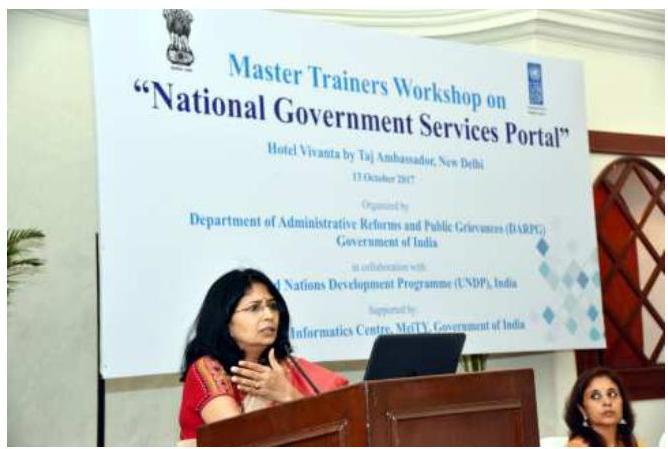
Master Trainers Workshop on National
Government Services Portal
24.12.6 As on $15^{\text {th }}$ November, 2017, 3918 services in English and Hindi by 35 States/UTs, and 932 services in English and Hindi by 40 Ministries/Departments of Government of India have been linked with National Government Services Portal, whereby citizens can access these services across the Governments.
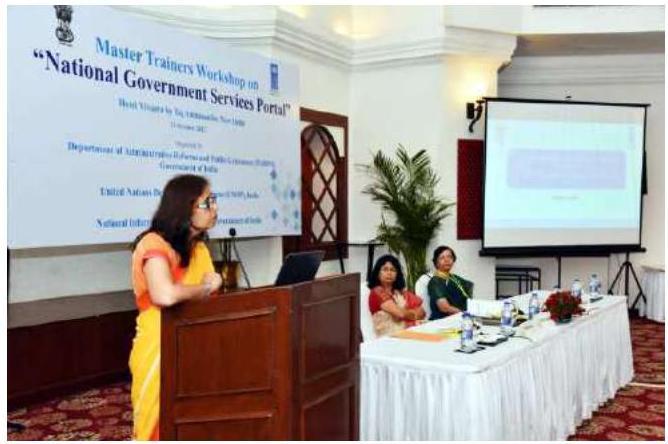
Master Trainers Workshop on National
Government Services Portal
24.13 Capacity Building in the field of Public Administration and Governance
24.13.1 As part of its international collaborative efforts, Department has been exploring the possibility of learning and sharing the administrative experiences of other countries, particularly in the area of e-Governance and on-line delivery of public services.
24.13.2 During 2017, the Department has organized two customized short-term Foreign Training Programmes on the theme ‘Minimum Government with Maximum Governance’ through e-Governance based Citizen Centric On-line Services, for officers from Government of India and the States/UTs, including PM Award winners/National e- Governance Award winners in the Korea Development Institute (KDI), Seoul, South Korea in September, 2017 and the London School of Economics (LSE), London, UK in October, 2017.
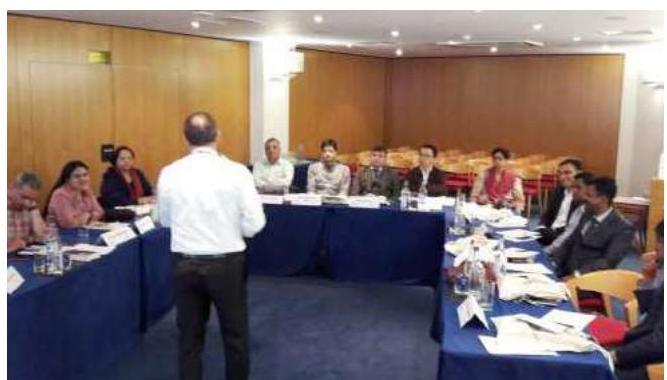
Training Programme at London School of Economics, London, United Kingdom
Documentation and Dissemination Division
Mandate
The Documentation and Dissemination Division of the Department primarily carries out the activities of documentation and dissemination of good governance practices of Centre, State/ Union Territory Governments with a view to sharing of experience with each other and replication elsewhere. Besides, the Division also brings out periodic publications and maintains repository of reference material concerning public administration, management, information technology, human resource development in the shape of rich and well equipped library.
25.1 The Documentation and Dissemination Division of the Department primarily carries out the activities of documentation and dissemination of good governance practices of Central, States and Union Territory Governments with a view to facilitate sharing of experience with one another and replication elsewhere. The activities dealt by the Division are detailed below:-
Financial Assistance to State Governments/ UT Administrations for professional documentation and dissemination of ‘Good Governance Practices’
25.2 The objective of the Scheme is to provide financial assistance to support professional documentation and dissemination of good governance initiatives by the State/UT Governments with a view to share experiences with each other and replicate elsewhere. So far eighty-two projects have been sanctioned. The scheme of providing financial assistance
to the State Governments/UT Administrations has been revised w.e.f. financial year 201617. The professional documentation report will now be in e-Book form, instead of paper documentation, alongwith short documentary film and the amount of financial assistance is upto Rs.3.00 lakh.
Organization of Regional Conferences on “Learning from successes”
25.3 Regional Conferences are organized on specific themes in association with various State/Union Territory Governments with a view to bring National and State level organizations along with other stakeholders including NGOs, intelligentsia and media on the same platform to share experiences in the formulation and implementation of good governance practices. This year, First Regional Conference on the theme “Good Governance and Replication of Best Practices” was held in the month of July, 2017 at Nainital, Uttarakhand. Second Regional Conference on the theme “Good
Governance and Replication of Best Practices” was held in the month of September, 2017 at Goa. Third Regional Conference on the same theme was held in the month of December, 2017 of Guwahati, Assam. The proceedings of the Regional Conference held at Nainital and Goa are available on the department website i.e. www.darpg.gov.in.
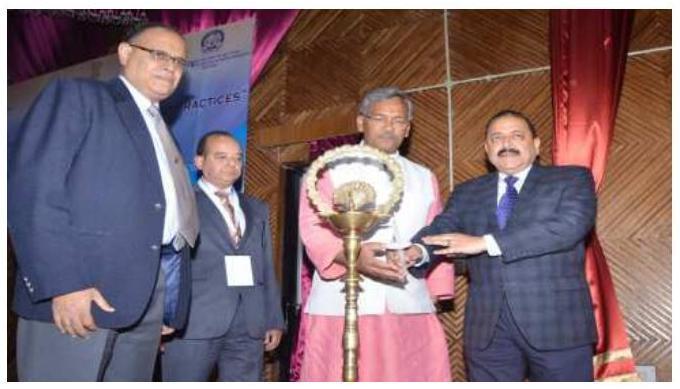
Shri Trivendra Singh Rawat, Hon’ble Chief Minister, Uttarakhand and Dr. Jitendra Singh, Minister of State, Independent Charge for Development of North Eastern Region, MoS for PMO, Personnel, P.G. & Pensions, Atomic Energy and Space lighting the traditional lamp at the Valedictory Session.
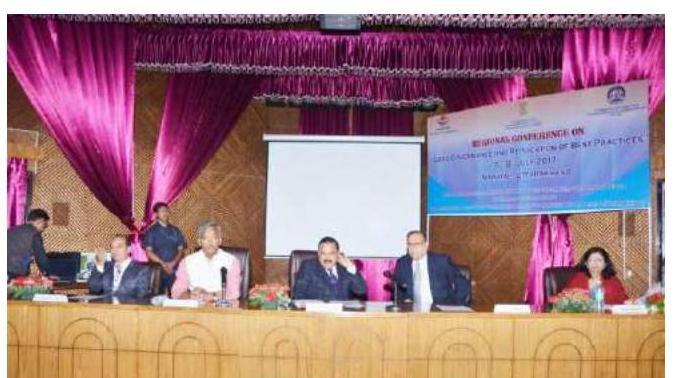
Shri Trivendra Singh Rawat, Hon’ble Chief Minister, Uttarakhand and Dr. Jitendra Singh, Minister of State, Independent Charge for Development of North Eastern Region, MoS for PMO, Personnel, P.G. \& Pensions, Atomic Energy and Space Shri C. Viswanath, Secretary,
Department of Administrative Reforms \& Public Grievances, Shri Avanendra S. Nayal, Director, Dr. Raghunandan Singh Tolia Uttarakhand Academy of Administration, Nainital, Smt. Smita Kumar, Joint Secretary, Department of Administrative Reforms \& Public Grievance, in the two-day Regional Conference on “Good Governance and Replication of Best Practices”, at Nainital, Uttarakhand on 07-08 th July, 2017.
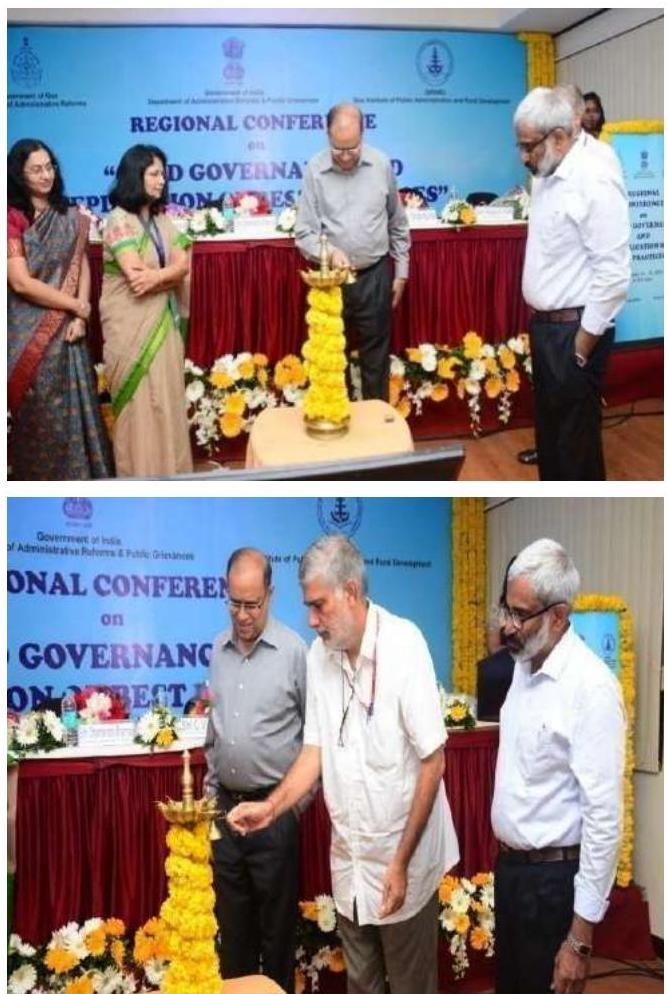
Shri C. Viswanath, Secretary, Department of Administrative Reforms \& Public Grievances, Shri Dharmendra Sharma, Chief Secretary, Government of Goa lighting the traditional lamp in the inaugural session of two-day Regional Conference on “Good Governance and Replication of Best Practices”, at Goa on 14-15 th September, 2017.
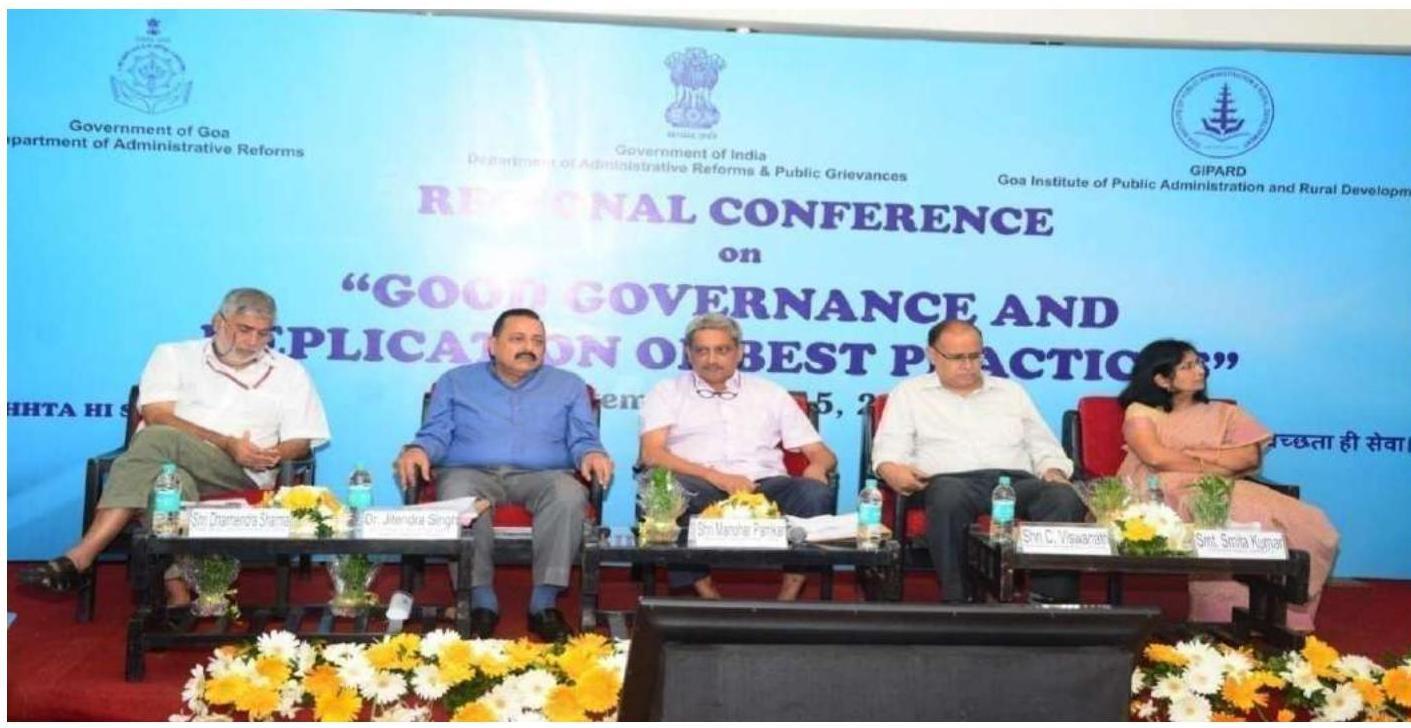
Dr. Jitendra Singh, Minister of State, Independent Charge for Development of North Eastern Region, MoS for PMO, Personnel, P.G. & Pensions, Atomic Energy and Space, Shri Manohar Parrikar, Chief Minister, Goa, Shri C. Viswanath, Secretary, Department of Administrative Reforms \& Public Grievances, Shri Dharmendra Sharma, Chief Secretary, Government of Goa, Smt. Smita Kumar, Joint Secretary, Department of Administrative Reforms \& Public Grievance, in the valedictory session of two-day Regional Conference on “Good Governance and Replication of Best Practices”, at Goa on 14-15 th September, 2017
25.4 Publication of Books
This Division publishes books containing articles on select award winning good governance practices. These articles are on the initiatives which have been conferred Prime Minister’s Award or National e-Governance Awards. The Division has already published a series of books on the subject. In the financial year 2017-18 two books namely ‘New Beginning’ (Book on Innovations) and ‘Fostering Excellence’ (Book on Success stories) have been published and released by Hon’ble PM on the occasion of Civil Services Day, 2017.
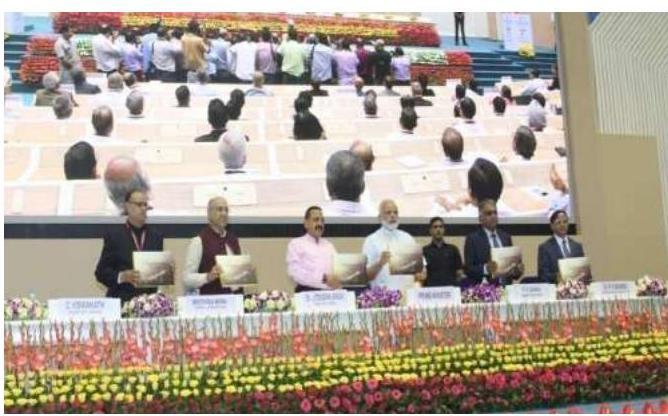
Shri Narendra Modi, Hon’ble Prime Minister of India releasing the book “New Beginning” on the occasion of $11^{\text {th }}$ Civil Services Day held on 20-21 st April, 2017.
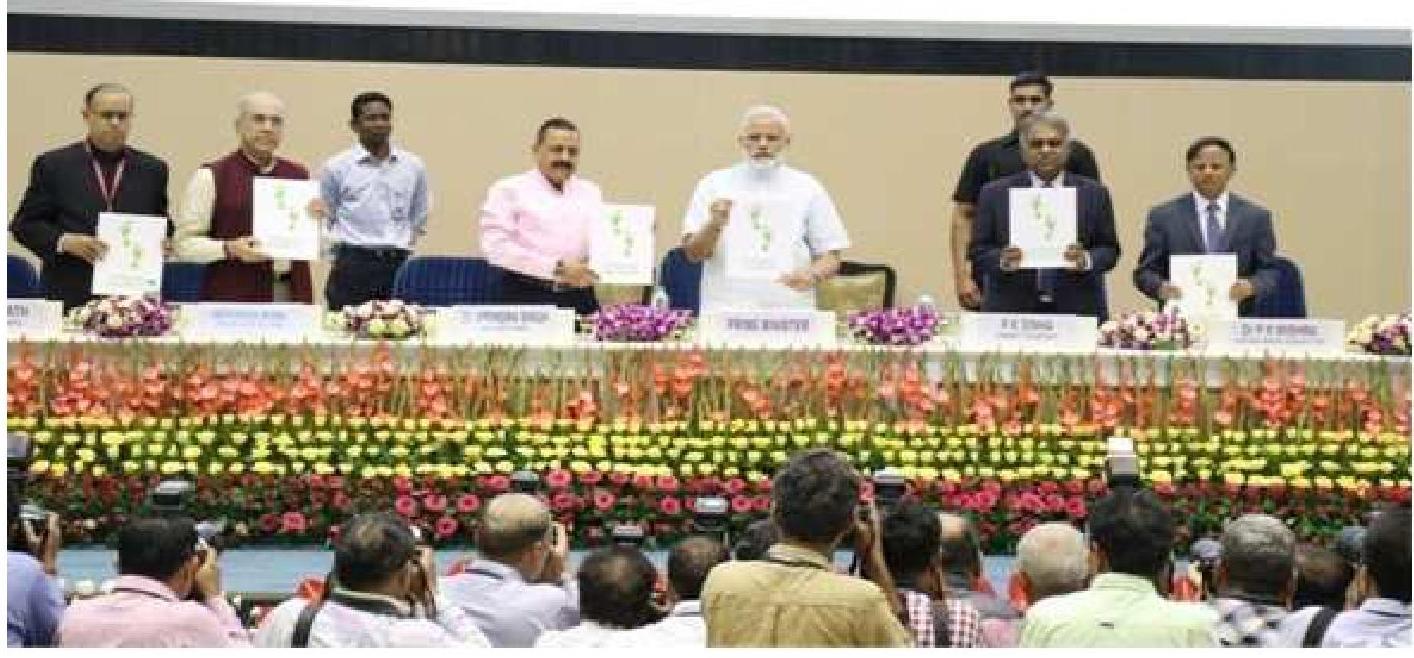
Shri Narendra Modi, Hon’ble Prime Minister of India releasing the book “Fostering Excellence” on the occasion of 11th Civil Services Day held on 20-21st April, 2017.
Exhibition on the occasion of Civil Services Day, 2017
25.5 An exhibition on priority programmes of the Government was inaugurated by Dr. Jitendra Singh, Hon’ble MoS, Development of North Eastern Region (I/C), Prime Minister’s Office, Personnel, Public Grievances & Pensions, Department of Atomic Energy, Department of Space on the occasion of $11^{\text {th }}$ Civil Services Day held on 20-21st April, 2017.
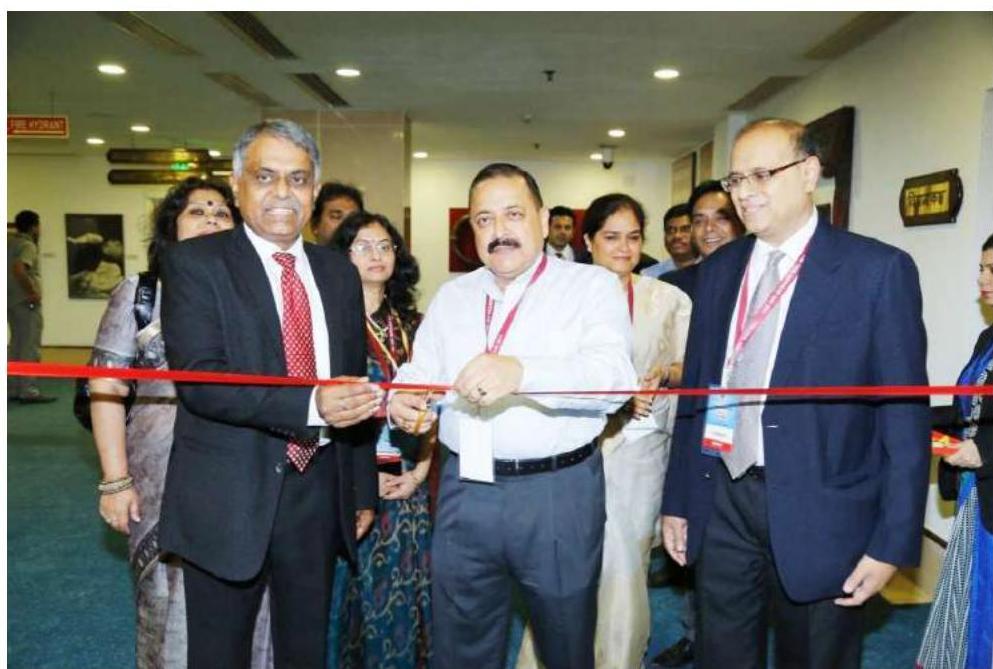
Dr. Jitendra Singh, Minister of State, Independent Charge for Development of North Eastern Region, MoS for PMO, Personnel, P.G. \& Pensions, Atomic Energy and Space inaugurating the exhibition on the Civil Services Day, 2017.
Production of Documentary Films on Best Practices
25.6 The Department is engaged in producing documentary films on best practices. These films are immensely useful for the administrators as they facilitate dissemination of success stories and their replication. Eighty two such documentary films have been produced so far. In current financial year, two films namely Journey of PM Awards and Making New India have been produced & screened during CSD, 2017. The film is made available on the Department’s website, as well as social media platforms such as twitter and facebook.
Publication of ‘Minimum GovernmentMaximum Governance’ – A By-Annually Journal
25.7 Department of Administrative Reforms and Public Grievances is bringing out a periodical journal “Management in Government” (MIG) since 1969 and now renamed “Minimum Government – Maximum Governance” and launched first e-Book” on 22.10.2015. From Jan, 2017, the quarterly e-journal is being published bi-annually. The e-Book “Minimum Government – Maximum Governance” is available on the website of the Department at http://darpg.gov.in/journalMGMG.
Hindi Section
26.1 Hindi Section of the Department of Administrative Reforms and Public Grievance is committed to comply with various guidelines issued by the D/o Official Language to promote the usage of Hindi language in the office.
26. 2 The main function of the Section is to render Hindi translation of the works given by various sections/officers of the Department and implementation of the official language Policy, which mainly include compilation of quarterly reports received from various sections of the Department and send it in an integrated form to the D/o Official Language in time; organizing quarterly meeting to discuss these reports. In addition, all the officers/sections are made aware of the guidelines issued from time to time by the D/o Official Language in connection with promotion of Hindi and their compliance is also ensured.
26.3 Hindi Pakhwada was organized in the Department during September 14-28, 2017 wherein various competitions were held i.e. Essay writing competition, Noting- drafting competition, Dictation and General Knowledge etc. Many officers/employees participated in these competitions and cash prizes were awarded to the winners of these competitions.
26.4 It is significant that Department has attended the meetings organized by Department of Official Language, Ministry of Home Affairs on various topics regarding implementation of Official Language policy for Ministries/Departments.
26.5 The website of Department of Administrative Reforms and Public Grievances has been updated and made bilingual.
Department of Pension and Pensioners’ Welfare
27.0 The Department of Pension & Pensioners’ Welfare was set up in 1985 as part of the Ministry of Personnel, Public Grievances and Pensions to formulate policy and coordination of matters relating to retirement benefits of Central Government employees. The Department of Pension \& Pensioners’ Welfare, being the nodal Department for pension and pension related matters, receives large number of references from Ministries/ Department/PSUs, etc. The Department renders advice on interpretation of Pension Rules and considers cases referred by Ministries/ Departments for relaxation of the provisions of Pension Rules. The Organisational Chart is at Annexure-VI and Incumbency position of Group ‘A’ Officers is at Annexure-VII. As per the Citizen’s Charter of Department of Pension \& Pensioners’ Welfare, the ‘Vision’ and ‘Mission’ are given below:
Vision
Active and dignified life for Pensioners
Mission
- Formulation of Pension Policy.
- Timely and Smooth payment of pension and other retirement benefits for Central Government Employees.
- Simplification of rules/guidelines and procedure and their dissemination.
- Facilitating prompt redressal of the pension related grievances.
- Promoting the welfare of pensioners.
27.1 The Department administers the following rules:
i. CCS (Pension) Rules, 1972
ii. CCS (Commutation of Pension) Rules, 1981
iii. CCS (Extra-ordinary Pension) Rules 1939
iv. GPF (CS) Rules, 1960.
v. CPF (India) Rules, 1962
vi. Payment of Arrears of Pension (Nomination) Rules, 1983
27.2 The approximate number of pensioners as on $31^{\text {st }}$ March, 2017 is as follows:
| Category of Pensioners |
No. of Pensioners |
|---|---|
| Civil | $10,06,061$ |
| Defence | $30,31,618$ |
| Postal | $3,17,774$ |
| Railways | $14,50,959$ |
| Telecom | $3,10,858$ |
| Total | $\mathbf{6 1 , 1 7 , 2 7 0}$ |
27.3 Pensioners’ Portal:
The Department of Pension \& Pensioners’ Welfare has developed a web-based
‘Pensioners’ Portal’, a Mission Mode Project (MMP) under the National e-Governance Plan of Government of India. The Portal interalia provides for dissemination of pension related information as well as registration of pensioners’ grievances online. It has noninteractive and interactive components. The non-interactive part contains updated information on pension rules and various instructions issued there under etc. The interactive part involves personalized pension road map, online calculators for pension, family pension, etc. and online registration of grievances of pensioners and their redressal, Bhavishya-an online Pension Sanction and Payment Tracking System and Anubhav-a platform for sharing experiences etc. 55.42
lakh hits were received on Pensioners Portal (as on 01.12.2017).
27.4 Standing Committee of Voluntary Agencies (SCOVA):
A Standing Committee of Voluntary agencies (SCOVA)hasbeensetupundertheChairmanship of MOS (PP) with a view to provide feedback on the implementation of policies/programmes of this Department besides mobilizing voluntary effort to supplement the Government action. The SCOVA consists of a Standing Group (5 members) and a Rotating Group (10 members). SCOVA was reconstituted in August, 2015. The last SCOVA meeting was held on 12th January, 2017, which was attended by representatives of various Pensioners Associations and the Ministries/Department.
SCOVA Meeting held on $12^{\text {th }}$ January, 2017
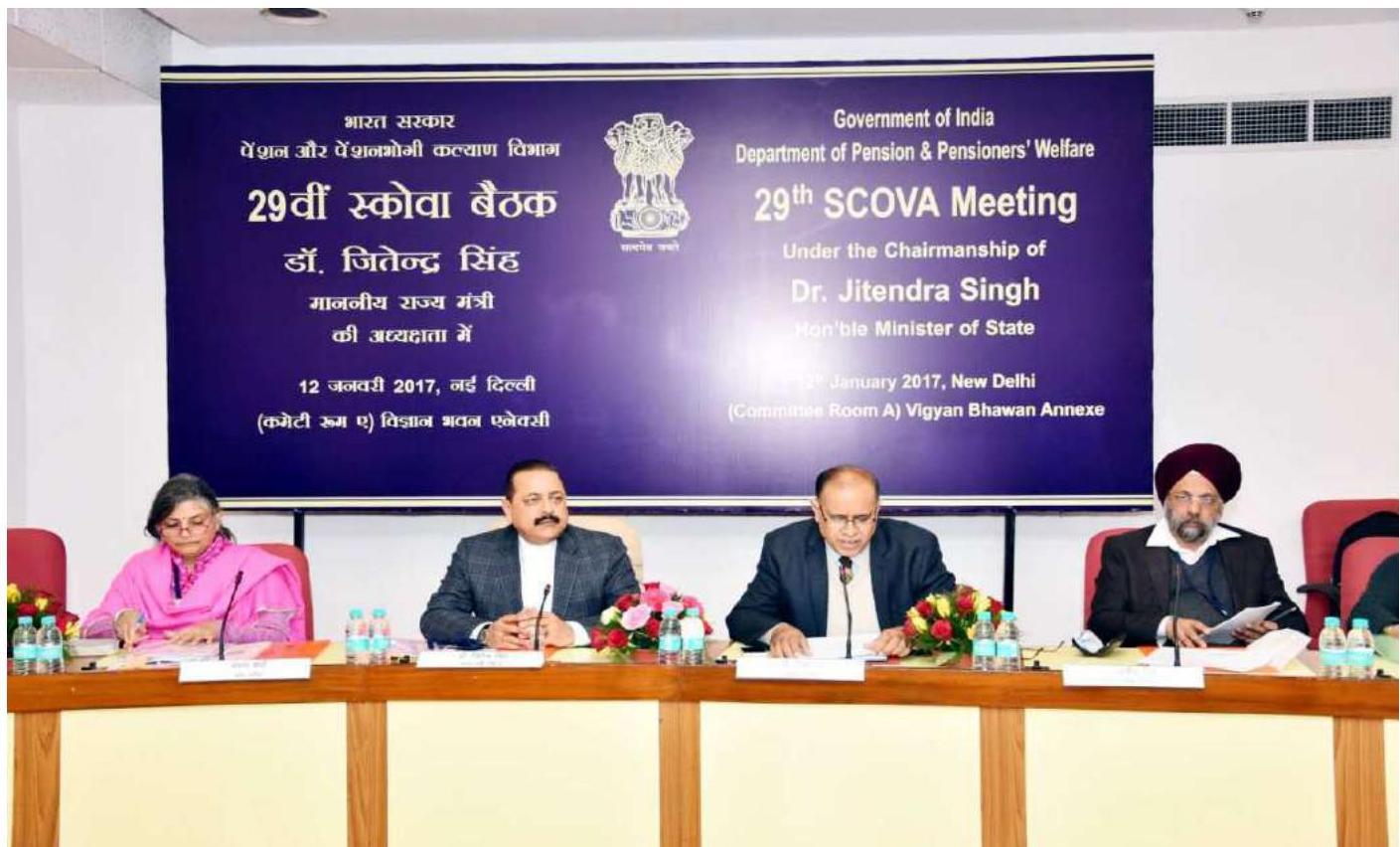
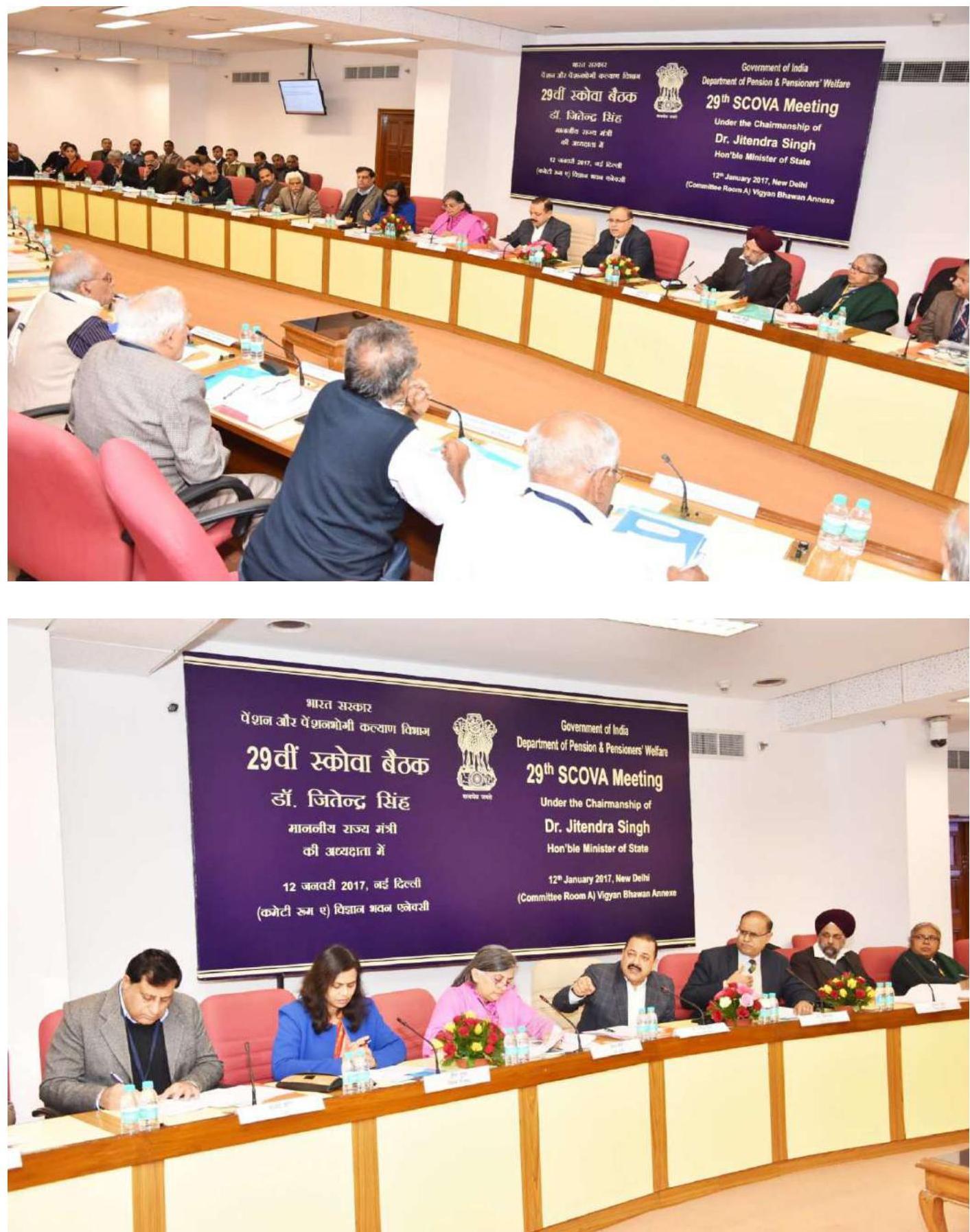
Annual Report 2017-18
27.5 Dearness Relief to Pensioners/ Family Pensioners
Revised rates of Dearness Relief (DR) to Central Government Pensioners/Family pensioners on implementation of decision taken on recommendation of $7^{\text {th }} \mathrm{CPC}$ are admissible at following rates:-
| Date from which payable |
Rate of Dearness Relief per month |
|---|---|
| From 01.01.2017 | 4% of Basic Pension/ Family Pension |
| From 01.07.2017 | 5\% of Basic Pension/ Family Pension |
For the convenience of all Ministries/ Departments and Banks/Treasuries/Post Offices, orders are hosted on the website of this Department. This facilitates faster payment of enhanced DR by Pension Disbursing Authorities.
The process has been streamlined to ensure that enhanced DR orders are issued with a minimum time lag with reference to the orders for enhancement of D.A.
27.6 NEW INITIATIVES OF THE DEPARTMENT
(i) SANKALP
It is our experience that Central Government employees after retirement felt a vacuum in life especially when it comes to manage daily routine and social engagement. Given that the average life expectancy today is 69.2 years, it is apparent that a Government Servant will have many years of active life left after retirement which could be fruitfully directed towards contribution to Society.
Keeping these factors in mind the Department has initiated Sankalp which aims to prepare the retired Government servants to channelize experience and skill towards meaningful intervention in the society. Under Sankalp PreRetirement Counselling Workshops are being organised for retirees which covers a PAN picture of entitlement of pension and other retirement benefits, CGHS facilities, investment plans, income tax incentives to senior citizens and voluntary engagement after retirement Till date 35 number of Pre Retirement Counselling sessions have been organized benefitting 3261 number of employees. ‘Training of Trainers’ workshop has also been initiated to strengthen in house capabilities of Government Ministries/Departments for conducting Pre-retirement counseling for their retiring employees. The Department has conducted 09 ‘Training of Trainers’ workshops till date creating a pool of around 601 trainers.
The Department has also facilitated pensioners to adopt MCD Schools for improvement of quality of Education and environment of the Schools. The Department has forwarded a list of Central Government Civil Pensioners registered under ‘Sankalp’ to various Regional Centers at Staff Selection Commission who detailed them for invigilation and Flying Squad duties in the Combined Graduate Level Exam, 2017. These pensioners are being engaged by SSC for duties in the forthcoming exams also.
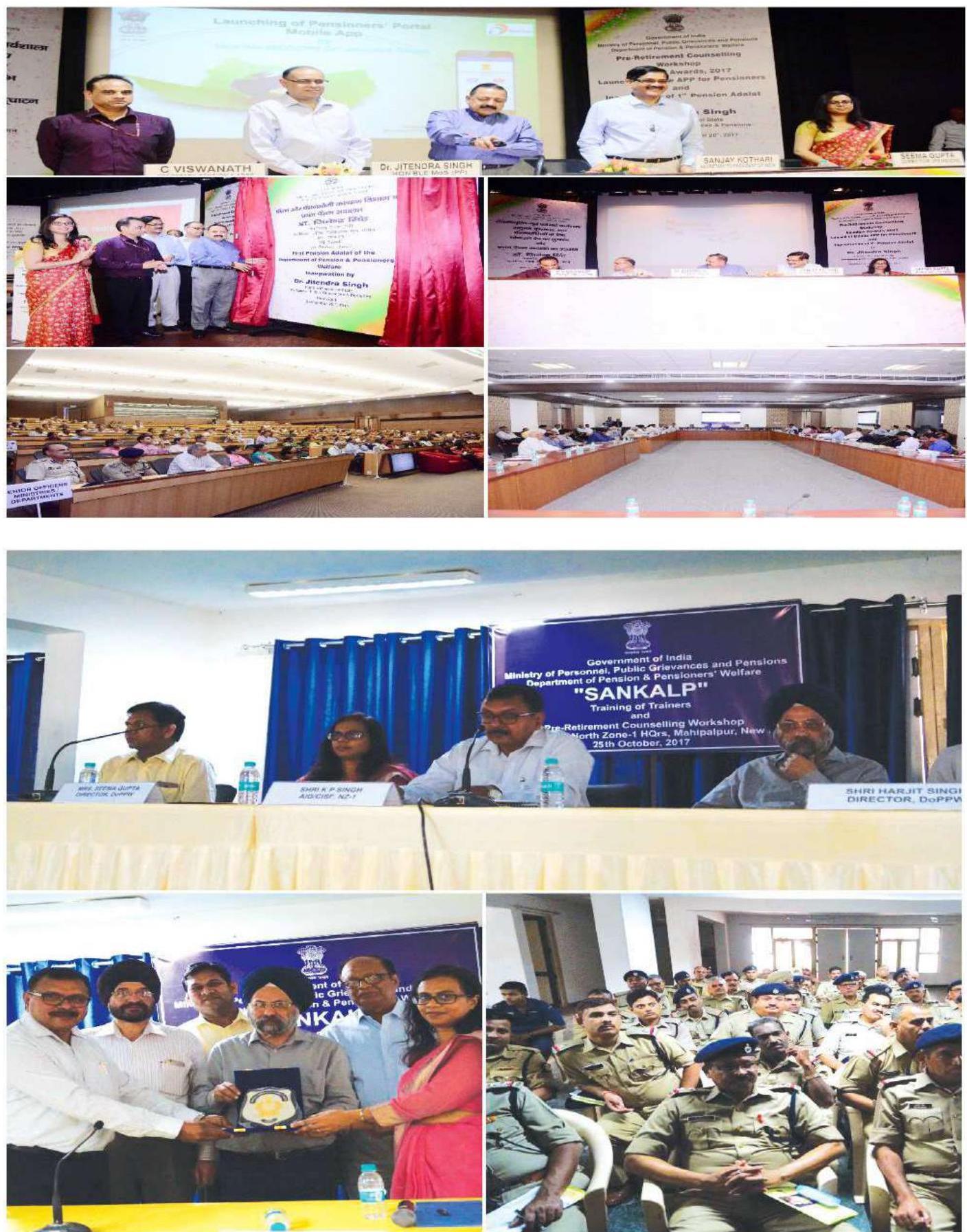
208 Annual Report 2017-18
(i) Pension Adalat
Department of Pension & Pensioners’ Welfare organized its first Pension Adalat on $20^{\text {th }}$ September, 2017, which was inaugurated by the Hon’ble MoS(PP). The objective was to provide on-the-spot resolution of unresolved grievances in CPENGRAMS and also to reduce the delays in the settlement of legitimate dues of the pensioners.
For the first Pension Adalat, 29 grievances, which were old or where the pensioners has expressed his/her dissatisfaction over the disposal by the concerned authorities, were selected from the unresolved grievances in CPENGRAMS. The petitioners as well as the concerned stakeholders like Ministry/ Departments / organization / CPAO / Bank, etc were invited to attend the above Adalat.
During the Pension Adalat, out of the 29 selected cases, 19 cases were resolved in the Adalat itself. 18 out of these 19 cases were resolved by accepting the claims of the Pensioners. Suitable instructions were given to the concerned Departments in the remaining cases. As on $30^{\text {th }}$ November, 2017, out of 29 grievances raised in Adalat, 26 have been resolved.
(ii) Bhavishya – Online Pension Sanction and Payment Tracking System
Department of Pension \& Pensioners’ Welfare has launched Bhavishya – an online tracking system for pension sanction and payment which is replica of CCS (Pension) Rules, 1972. By keeping track of the progress as well as close
monitoring of each pension case, it introduces transparency and accountability into the system thereby plugging delays. Thus, the system benefits the retiring employees, pensioners and the Government authorities equally. The system allows online filing of application for pension by the retiring employees, encapsulates the Pension Rules required for processing pension cases and generates all forms necessary for finalizing pension cases as well as reports needed for monitoring by the Departments. It is also providing information/data for generation of e-PPO.
In order to enforce accountability and transparency in all offices of Central Government Ministries/ Departments except Railway, Defence, Post \& Telecommunication, Bhavishya has been made mandatory for processing Pension cases w.e.f. 01/01/2017. Till date, Bhavishya is running in the main secretariat of 89 Ministries/Departments and 458 attached offices through 6166 DDOs. Pension cases of 21808 retiring/retired employees are in various stages of processing through the system. Further, this application has so far cumulatively processed and issued PPOs in respect of 26025 pensioners.
With respect to the implementation of Government’s decision on the recommendations of $7^{\text {th }}$ Central Pay Commission regarding the revision of pension of pre-2016 pensioners/ family pensioners etc., the Department of Pension \& Pensioners’ Welfare fed the concordance table in ‘Bhavishya’ Software and also developed a tool on 31.08.2017 which was made available
to all the Heads of Department (HOD) to revise the individual revision cases instantaneously.
(iv) Anubhav
On the directions of the Hon’ble Prime Minister of India, Department of Pension & Pensioners’ Welfare has launched an online software, ‘Anubhav’ for sharing experiences by retiring government employees while working with the Government. It is envisaged that over a period of time this will create a wealth of institutional memory with replicable ideas and suggestions. This tool in addition, gives opportunity to the retiring employees to invest his experience, skill and time for growth of social capital of the country.
Instructions for use of this application have been issued vide OMs No. 4/2/2014-P\&PW (Coord.) dated 19.02.2015 \& 05.03.2015.
An annual Award Scheme, to incentivize and encourage more retiring employees to submit his/her experience, has been institutionalized and six awards were conferred by the Hon’ble MOS (PP) on $19^{\text {th }}$ February, 2016 to the selected write-ups.
During the second Anubhav Award Ceremony, 16 Awards were given by the Hon’ble Minister of State (PP) on $20^{\text {th }}$ September, 2017 to selected write ups published during January, 2016 to March, 2017. The details of Awardees is given in table below:
| S.No. | Name \& Designation | Office Address |
|---|---|---|
| 1 | Dr. Manas Kumar Mandal Director General – Life Sciences (Retd.) |
D/o Defence Research \& Development, DRDO Hq, New Delhi |
| 2 | Shri Devi Dass Sharma Deputy Commandant Engineer (Retd.) |
Indo Tibetan Border Police, Chawla Camp ITBP New Delhi |
| 3 | Shri Manjit Kumar, CSS Director (Retd.) |
D/o Heavy Industries, Udyog Bhavan New Delhi |
| 4 | Shri Megaraj Prakash Technical Officer (Retd.) |
D/o Defence Research \& Development, DARE, Bengaluru, |
| 5. | Shri Nanjappa C. Scientist (Retd.) |
D/o Defence Research \& Development, DFRL, Mysore |
| 6 | Shri Prabhaker Kumar Verma, CAS Additional Director General (Retd.) |
M/o Urban Development, Chief Architect NR- 1 CPWD, Chandigarh |
| 7 | Shri Umed Singh Mallik Inspector (Retd.) |
Central Reserve Police Force, 1 Signal BN CRPF New Delhi |
| 8 | Shri Bapu Pandu Choudhari Technical Officer (Retd.) |
D/o Defence Research \& Development, ARDE, Pune |
| 9 | Dr. Satpute Ravindra Shamkant Scientist (Retd.) | D/o Defence Research & Development, Armament, Lab: HEMRL, Pune |
|---|---|---|
| 10 | Shri R. Sagayaraj Technical Officer (Retd. | D/o Defence Research \& Development, DEBEL, Bengaluru |
| 11 | Dr. Satish Chandra Pant Joint Director (Retd.) | D/o Defence Research \& Development, DRDE, Gwalior |
| 12 | Ms. Preeti Ramesh Mudhol Postal Assistant (Retd.) | D/o Post, Head Post Office Belagavi-590001 |
| 13 | Shri Chhotelal Ram Sub Inspector (Retd.) | Central Reserve Police Force, GC, CRPF, Agartala, Tripura |
| 14 | Dr. V. Ramanujachari Scientist \& Director (Retd.) | D/o Defence Research \& Development, DRDO, RIC, Chennai |
| 15 | Dr. Surendra Kumar Jain Scientist (Retd.) | D/o Defence Research \& Development, DL, Jodhpur |
| 16 | Shri Provat Ranjan Majumder Station Manager (Retd.) | M/o Railways, DRM Eastern Railway Sealdha |
Anubhav prize distribution on 20 September, 2017
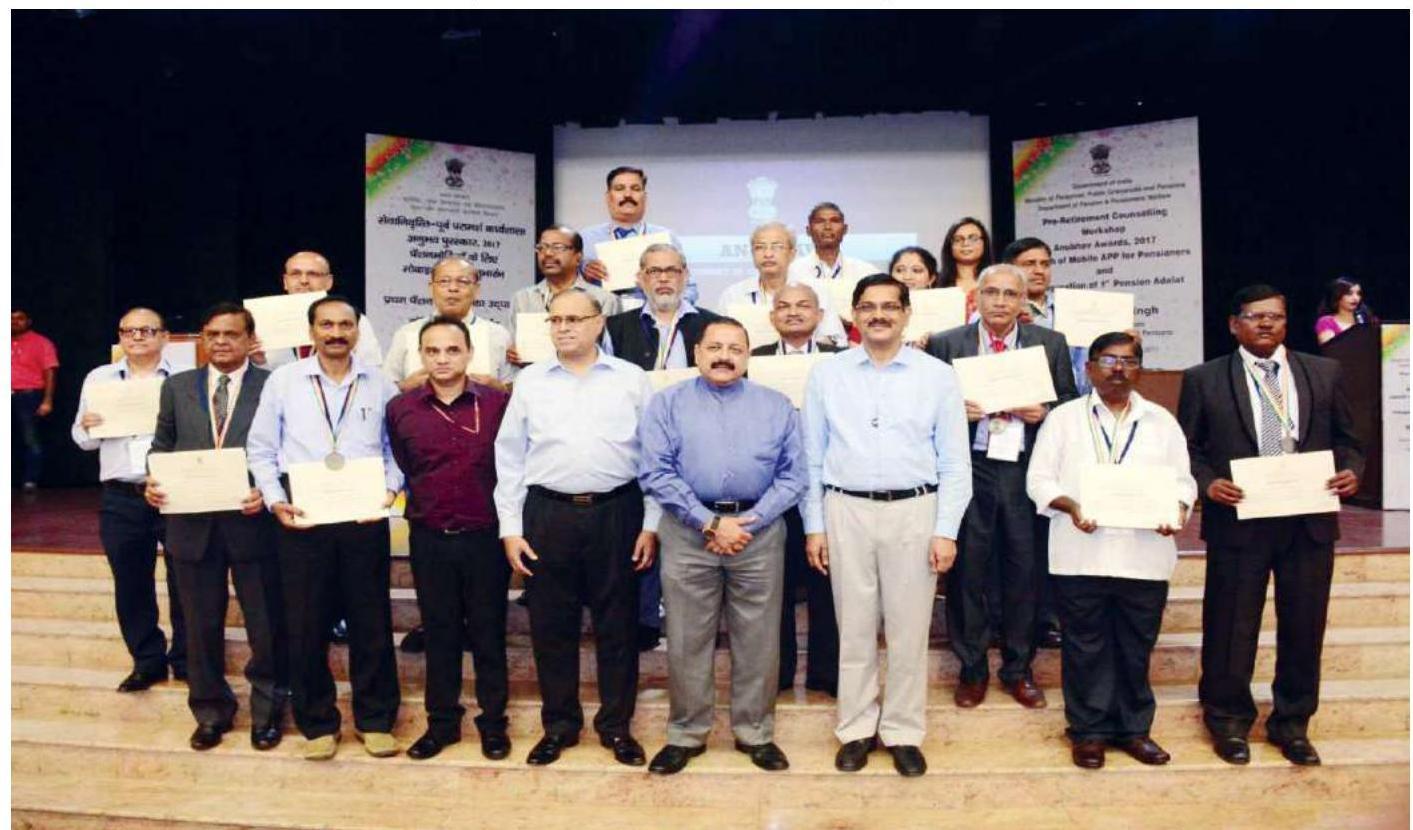
91 organizations have registered, 4406 writeups have been published and 1728 write-ups which have been uploaded are waiting to be published as on 01.12.2017.
(v) Jeevan Pramaan
An Aadhar based scheme for online submission of digital life certificate was launched by the Hon’ble Prime Minister in November, 2014. The scheme benefits pensioners specially the old and infirm who can submit life certificate from the comfort of their homes anywhere in the country or abroad. 11 lakh pensioners availed this facility through banks from $1^{\text {st }}$ November, 2017 to $30^{\text {th }}$ November, 2017. The efforts made by the Department towards this endeavour include:-
(i) Meetings with Banks, Department of Posts and CPAO.
(ii) Publicity through audio, visual and print media to reach out to the pensioners.
Till date about $93 %$ of the pension bank accounts of Central Government pensioners drawing pension through banks have been seeded with Aadhaar Numbers.
(vi) Liberalisation and simplification of GPF Rules.
In order to make General Provident Fund (Central Service) Rules more subscriber friendly, Government has reviewed the eligibility and conditions of advances and withdrawals from the fund by the subscribers and liberalised the advance & withdrawal conditions vide OM No. 3/2/2017-P\&PW(F)(i)\&(ii) dated the $7^{\text {th }}$ March
2017. As per the liberalised rules, limits for withdrawals have been raised and procedures simplified especially for activities of house building and education of children, where the costs have gone up manifold over the last two decades. In furtherance of the Government’s commitment towards self certification, subscribers will be allowed to withdraw funds based on a simple declaration. No further documentary evidence will be required.
27.7 Implementation of the Recommendations of $7^{\text {th }}$ Central Pay Commission (CPC)
For Employees retired/retiring on or after 1.1.2016 Orders were issued on 4.8.2016 for regulating pension/gratuity/commutation of pension/family pension/disability pension/ ex-gratia lump sum compensation, etc. of employees retired/retiring on or after 1.1.2016. In accordance with the above order:-
(i) There is no change in the pension fixation formula for those retired/ retiring on or after 1.1.2016.
(ii) The minimum pension would be Rs.9,000/-per month as againstexisting minimum pension of Rs.3,500/- per month.
(iii) The ceiling of gratuity has been increased from the existing Rs. 10 lakhs to Rs. 20 lakhs
(iv) A new slab of death gratuity has been added. The family of a Government servant dying while in service with a qualifying service of 11-20 years would be entitled to death gratuity @
20 times of monthly emoluments as against the existing entitlement of 12 times of emoluments.
(v) The rates of ex-gratia lump sum compensation being paid to the families of employees who die in performance of duty has been increased from existing 10-15 lakhs to Rs.25-45 lakhs, depending upon the circumstances in which the death occurs.
27.8 Revision of pension of Pre-2016 Pensioners under $7^{\text {th }} \mathbf{C P C}$
On the basis of decision of the Government on the recommendations of the $7^{\text {th }} \mathrm{CPC}$, orders have been issued by this Department on 4.8.16 and 12.5.17 for revision of pension of pre-2016 pensioners/family pensioners.
In accordance with the order dated 4.8.2016, the pension as had been fixed at the time of implementation of the $6^{\text {th }} \mathrm{CPC}$ recommendations was multiplied by 2.57 for arriving at a figure of revised pension w.e.f. 1.1.2006.
$7^{\text {th }} \mathrm{CPC}$ also recommended another formulation for revision of pension of past pensioners by notionally fixing the pay by giving the benefit of increments earned by the retiree in the scale from which he/she retired before 1.1.2016. The Govt. decided that this formulation may be made applicable if its implementation is found feasible after examination by a Committee. Accordingly, a Committee headed by Secretary, Department of Pension & Pensioners’ Welfare was constituted to examine the feasibility of this formulation for revision of pension of pre-
2016 pensioners. The Committee submitted its report on 14.12.2016. The Committee recommended revision of pension of past pensioners by notionally fixing their pay in the Pay Matrix recommended by the 7th CPC. The recommendations of the Committee were accepted by the Government.
Accordingly, the orders were issued on 12.5.2017 for revision of pension of pre-2016 pensioners/family pensioners. The order inter alia provides that the revised pension/family pension w.e.f. 01.01.2016 in respect of all civil personnel, including CAPF’s who retired/ died prior to 01.01.2016 may be revised by notionally fixing their pay in the pay matrix recommended by the $7^{\text {th }} \mathrm{CPC}$ in the level corresponding to the pay in the pay scale/pay band and grade pay at which they retired/ died. This will be done by notional pay fixation under each intervening Pay Commission based on the Formula for revision of pay. While fixing pay on notional basis, the pay fixation formulae approved by the Government and other relevant instructions on the subject in force at the relevant time shall be strictly followed. $50 %$ of the notional pay as on 01.01.2016 shall be the revised pension and $30 \%$ of this of the notional pay shall be the revised family pension w.e.f. 1.1.2016 as per the first Formulation. In the case of family pensioners who were entitled to family pension at enhanced rate, the revised family pension shall be $50 \%$ of the notional pay as on 01.01.2016 and shall be payable till the period up to which family pension at enhanced rate is admissible as per rules.
It has also been decided that higher of the two Formulations i.e. the pension/family pension already revised in accordance with thisDepartment’sOMNo.38/37/2016-P&PW(A) (ii) dated 04.08.2016 or the revised pension/ family pension as worked out in accordance with the notional pay fixation method, may be granted to pre-2016 Central civil pensioners as revised pension w.e.f. 01.01.2016. In cases where pension/family pension being paid w.e.f. 1.1.2016 in accordance with this Department’s OM No. 38/37/2016-P\&PW(A) (ii) dated 04.08.2016 happens to be more than pension/family pension, the pension already being paid will be treated as revised pension w.e.f. 1.1.2016.
Based on the fitment tables provided by the Department of Expenditure, concordance tables for fixation of notional pay and pension/ family pension of employees who retired/died in various grades during the $4^{\text {th }}, 5^{\text {th }}$ and $6^{\text {th }}$ Pay Commission periods have been issued vide this Department’s OM No. 38/37/2016-P\&PW(A) dated $6^{\text {th }}$ July, 2017.
The Department fed tables into the ‘Bhavishya” software and developed a tool which was made available to all the Heads of Departments to revise individual revision cases instantaneously. For revision of pension of pre2016 pensioners belonging to All India Service in the States, Chief Secretaries of the States have been requested for close monitoring and expeditious processing of the pension cases. The revision of pension by the administrative Department is being closely monitored.
27.9 Important decisions
(a) Restoration of full pension of absorbee pensioners
As per orders of Hon’ble Supreme Court dated 01-9-2016, suitable instructions were issued by Department of Pension \& Pensioners’ Welfare on $23^{\text {rd }}$ June, 2017 and $21^{\text {st }}$ July, 2017 allowing restoration of full pension after expiry of commutation period of 15 years to all absorbee pensioners, who had taken 100% lump-sum amount in lieu of pension on absorption in PSUs/Autonomous Bodies in accordance with the then existing Rule 37-A and in whose case $1 / 3$ pension had been restored after 15 years, from the date of payment of 100\% lump-sum amount.
(b) Revision of Pension of medical officers drawing Non-Practicing Allowance
The Central Civil Services (Pension) Rules, 1972 provides for inclusion of Non-Practicing Allowance (NPA) in the emoluments reckoned for calculation of pension of medical officers in lieu of private practice. Medical officers retired during the period from 1.1.2016 to 30.6.2017 were in receipt of NPA @ $25 \%$ of their pre1.1.2016 pay and this NPA was to be taken into account for calculation of their initial pension. The medical officers retired/retiring on or after 1.7.2017 are entitled to pension based on emoluments which include NPA at the rate of $20 \%$ of the revised basic pay. Orders have also been issued on 8.11.2017 for revision of pension of medical officers who have retired from 1.1.2016 to 30.6.2017. As per these orders, the pension/family pension
in respect of medical officers who retired/died during 1.1.2016 to 30.6.2017 shall be further revised w.e.f. 1.7.2017 by adding NPA @ 20% to the basic pay on the date of retirement.
For the purpose of revision of pension of pre2016 retired medical officers in accordance with this Department’s O.M. dated 12.05.2017, their pay will be notionally revised w.e.f 1.1.2016 based on the formula for revision of pay as applicable to the medical officers in the $7^{\text {th }} \mathrm{CPC}$ as well as in the intervening Pay Commissions. NPA at the rate as applicable as on 01.01.2016 shall be added to such notional pay as on 1.1.2016 to arrive at pension/family pension of retired medical officers w.e.f. 1.1.2016. The pension/family pension of ${ }^{1}$ retired medical officers shall be further revised w.e.f. 1.7.2017 by adding NPA @ 20\% to the notional pay as on 1.1.2016, instead of the NPA admissible as on 1.1.2016.
(c) Family Pension to divorced daughters
The Department issued orders on 19th July, 2017 stating that the Family Pension to divorced daughter to be granted even in such cases where divorce proceedings had been filed in a competent court during the life time of employee/pensioner or his/her spouse but divorce took place after their death, provided the claimant fulfils all other conditions for grant of family pension under Rules 54 of CCS (Pension) Rules, 1972.
(d) Timely payment of GPF final payment to retiring Government servant.
To ensure timely final payment of GPF to the retiring Government servant, orders have been issued for payment of final GPF amount to the retiring Government servant immediately on retirement, vide OM No.3/3/2016-P&PW(F) dated 16/1/2017. As per these orders, in all cases where GPF final payment is delayed shall be put up to the Secretary of the concerned Ministry/Department and responsibility shall be fixed at all levels and to take appropriate action against the Government servants who are found responsible.
(e) Revision of family pension and disability pension under CCS(EOP), Rules
- In implementation of the recommendations of $7^{\text {th }}$ Central Pay Commission, disability pension and family pension covered under CCS(EOP)Rules were revised by multiplying a factor 2.57 , vide this Department’s order No.38/37/2016P\&PW(A)(ii) dated 4/8/2016.
- $\quad$ The minimum disability pension and family pension covered under CCS(EOP) Rules of a Government servant/family of the deceased Government holding a pensionable post has been enhanced to Rs.18,000/- per month vide OM No.1/4/2016-P\&PW(F) dated 2-82017.
- $\quad$ The disability pension and family pension covered under CCS (EOP) Rules were also revised by pay fixation method, vide OM No.1/4/2016P\&PW(F) dated 12/10/2017.
(f) Constant Attendant Allowance
The Constant Attendant Allowance being paid to disability pensioners has been revised from the existing Rs.4500/- p.m to Rs.6750/p.m, vide OM No.1/4/2017-P&PW(F) dated 2/8/2017.
(g) Fixed Medical Allowance
The Department issued an order dated 19th July, 2017 increasing the amount of Fixed Medical Allowance from Rs. 500/- per month to Rs. 1000/- per month payable to the Central Government Pensioners residing in areas not covered under CGHS, w.e.f. 01.07.2017.
(h) Other Initiative
Instructions have been issued to all Ministries/ departments to issue printed Plastic Identity Cards to the retiring employees with state emblem. In the Department of Pension \& Pensioners’ Welfare a PVC Thermal printer has been procured for issuing Plastic Identity Cards to the employees retiring from Department of Pension \& Pensioners’ Welfare, Department of Personnel \& Training, DARPG and Department of North-Eastern Region.
27.10 Handling of various references and Centralised Pension Grievance Registration and Monitoring System (CPENGRAMS)
- The Department of Pension \& Pensioners’ Welfare has implemented the improved version of CPENGRAMS which integrates with the data base of Centralized Public Grievances Redressal and Monitoring System (CPGRAMS)
under the administrative control of Department of Administrative Reforms \& Public Grievances. With this version, pension related grievances get combined with public grievances and thus the Ministries/ Departments do not have to monitor grievances through two different applications. - During the period under report concerted efforts were made to bring down the pendency of old grievances while maintaining the quality in disposal for which regular review meetings were held with the Nodal Officers of various Ministries/ Departments. As a result, 22027 grievances were disposed off during 01.04.2017 to 24.11.17 as compared to 30010 during the previous year i.e. 1.4.16 to 31.3.17.
- $\quad$ The time limit to redress grievances is 60 days. During the period 01.04.2017 to $24.11 .17,84.2 %$ grievances were disposed of within 60 days as compared to $84.4 \%$ during the previous year i.e. 1.4.16 to 31.3.17.
27.11 Creating awareness on pensioners’ entitlements and Rules
Often it is observed that due to lack of knowledge on entitlements/rules pensioners suffer financially. To deal with such issues department has started a drive to create awareness on entitlements / retirement benefits among pensioners as well as officers/ staff dealing with pension matter so that pensioners / family pensioners can get their legitimate amount of benefit. In the current year –
- The Department held two training sessions for officers and members of staff of 43 Ministries/Departments to apprise them of latest development and changes in Pension Rules. As a result 281 officials were trained on pensionary matters.
- In addition the Department also conducted 3 Workshops on National Pension System applicable to Government servants who joined service on or after 01.01.2004. These workshops were attended by around 300 officials dealing with NPS matters and NPS beneficiaries from Central Armed Police Forces.
- The Department also conducts awareness workshops for pensioners in various parts of the country. During the period under report, the Department conducted 2 such workshops – one each at Jaipur and Shillong benefitting about 300 pensioners.
- To reach out to the pensioners’ especially family pensioners located in different parts of country, print and electronic media is being used to sensitise them about their entitlements, latest updates on pensionary matters and about Jeevan Pramaan. Department kept a Budget provision of Rs.4.17 crore (RE) for 2017-18. Under this provision, advertisements are published in national and regional dailies across the country. In addition to it radio audio spots are broadcast on AIR, Vividh Bharti FM stations etc. Video clips on Jeevan Pramaan are
telecast on Doordarshan and other private TV channels.
M-governance for pensioners
- Moving towards E governance to M governance, various facilities for pensioners have been brought under Mobile App. With the App, a superannuating central civil government official will be able to monitor the progress of his pension settlement, and retired officials will be able to self-assess their pension through the pension calculator and are also able to register their grievances, if any, and get updates on orders issued by the Department.
27.12 Hindi Pakhwara
A Hindi Pakhwara was organized by the Department in the month of September from 14- 29 September, 2017 to inculcate the spirit of use of Hindi in official noting drafting and communications. Five Competitions in essay writing, Expansion of Hindi Story, translation and usage of Hindi, Official Language questionnaire and General Knowledge and noting and drafting were organized for the staff members and suitable awards were given as incentive.
27.13 Swachhta Pakhwada
This Department implemented Swachhta Pakhwada from $16^{\text {th }}$ to $30^{\text {th }}$ June, 2017. During these Pakhwadas identified Pensioners Associations sensitized their neighbourhood. A special drive of cleanliness of department premises was also carried out on $29^{\text {th }}$ September, 2017.
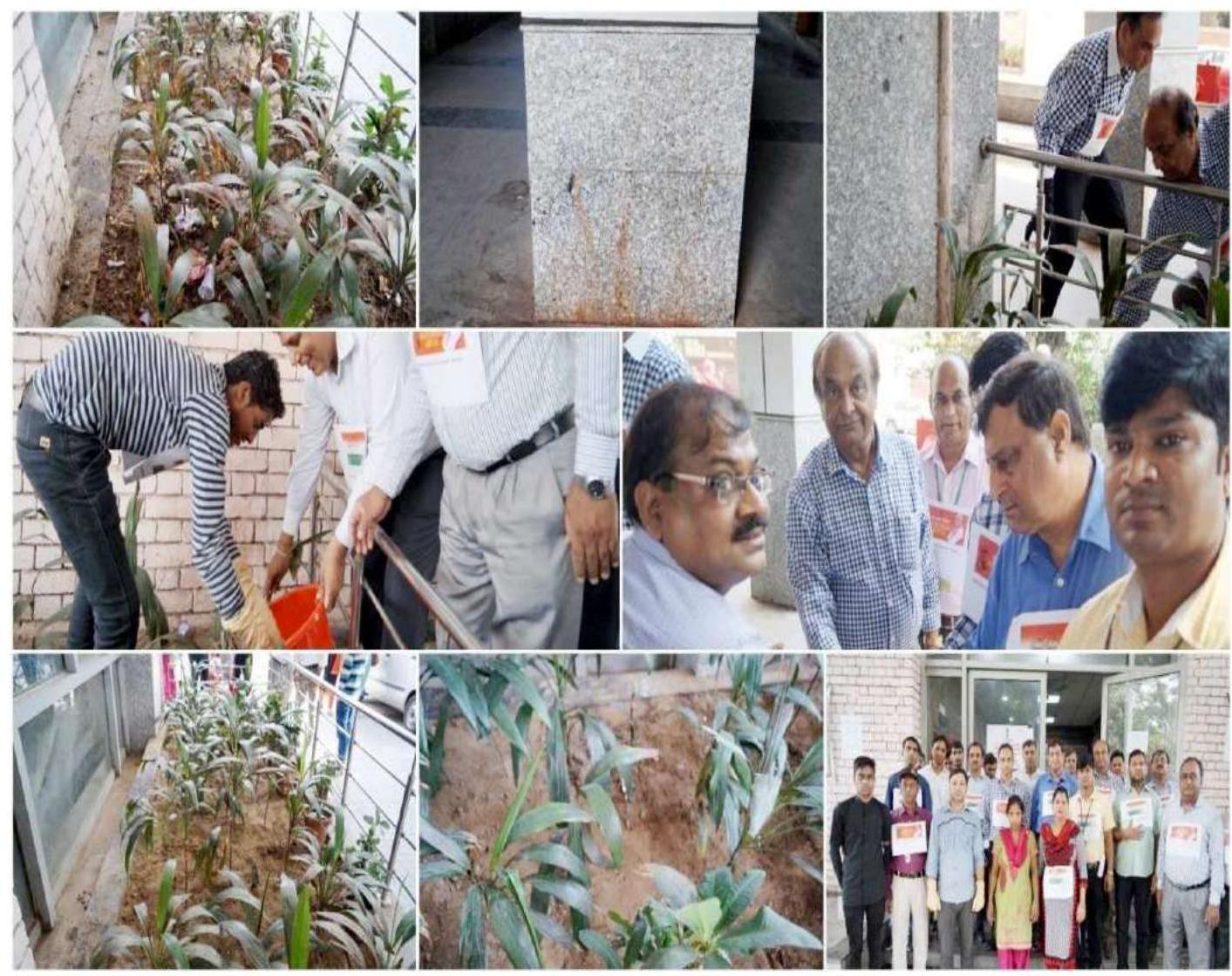
Cleanliness Drive on 29 September, 2017 in and around the office premises.
ANNEXURES
220 Annual Report 2017-18
Annexure – I
Department of Personnel and Training
Incumbency Position of Group ‘A’ Officers in D/o Personnel and Training as on 21.01.2018
| Post | Name of Incumbent |
|---|---|
| Secretary (Personnel) | Shri. Ajay Mittal |
| Additional Secretary | Shri. Pradip Kumar Tripathi |
| Joint Secretary | 1. Shri. Srinivas Ramaswamy Katikithala |
| 2. Shri. Devesh Chaturvedi | |
| 3. Shri. Vijoy Kumar Singh | |
| 4. Shri. G. Dev Tripathi | |
| 5. Shri. Mukul Ratra | |
| 6. Ms. Kimbuong Kipgen | |
| 7. Smt. G. Jayanthi | |
| Director | 1. Shri. Anand Madhukar |
| 2. Shri. Ashish Kumar | |
| 3. Shri. J. Srinivasan | |
| 4. Shri. N. Sri Raman | |
| 5. Shri. N. Raja | |
| 6. Ms. Rajul Bhatt | |
| 7. Shri. Shri Prakash Dubey | |
| 8. Shri. Subramanya M.S. Rao | |
| 9. Shri. V. K. Sinha | |
| 10. Ms. Varsha Sinha | |
| Principal Staff Officer | 1. Shri. Neeraj Sagar |
| Post | Name of Incumbent |
|---|---|
| Deputy Secretary | 1. Shri. A.K.Saha |
| 2. Shri. Ashok Kumar Jain | |
| 3. Shri. Ashish Madhaorao More | |
| 4. Shri. A.N.Narayanan | |
| 5. Shri. C.A.Jacob | |
| 6. Shri. D.K. Sengupta | |
| 7. Shri. G. Srinivasan | |
| 8. Ms. Kavitha V. Padmanabhan | |
| 9. Ms. Khusboo Goel Chowdhary | |
| 10. Shri. Rajender Kumar | |
| 11. Shri. Sanjiv Kumar | |
| 12. Ms. Vanita Sood | |
| Senior Principal Private Secretary | 1. Smt. Harbhajan Kaur Gill |
| 2. Shri. Rajender Singh | |
| 3. Shri. Satish Kumar Thakur | |
| 4. Shri. Virendar Aggarwal | |
| Principal Private Secretary | 1. Shri. Ramesh Chand |
| 2. Shri. Harish Kumar Chawla | |
| 3. Smt. Krishna Kain | |
| 4. Shri. Panna Lal | |
| 5. Shri.Yati Raj Sehgal | |
| 6. Shri. Girish Kumar Ahuja | |
| 7. Shri. P. Suresh | |
| 8. Shri. R.K.Malhotra | |
| 9. Shri. Munesh Chand |
| Post | Name of Incumbent |
|---|---|
| Under Secretary | 1. Shri. Anil Tripathy |
| 2. Shri.Amit Srivastava | |
| 3. Shri. Ajay Kumar Singh | |
| 4. Shri. Ajit Kumar | |
| 5. Shri. Anil Bajpai | |
| 6. Shri.Amit Srivastava | |
| 7. Shri. Arvind Thakur | |
| 8. Shri. Avinash Chandra | |
| 9. Shri. Anand Upadhyay | |
| 10. Shri. Biswajit Banerjee | |
| 11. Shri. Chattra Mani | |
| 12. Shri. Chandra Shekhar | |
| 13. Shri. Chirabrata Sarkar | |
| 14. Shri. Debabrata Banerjee | |
| 15. Shri. Debabrata Das | |
| 16. Ms. Gracy Varghese | |
| 17. Shri. I.P.Nagpal | |
| 18. Ms. Jayashree Chellamani | |
| 19. Shri. Jai Narain | |
| 20. Ms. Jyotsna Gupta | |
| 21. Shri. K. Prakasham | |
| 22. Shri. Kulbhushan Malhotra | |
| 23. Shri. K.Salil Kumar | |
| 24. Shri.K.C. Raju | |
| 25. Shri.K. Srinivasan | |
| 26. Shri.K. Srinivasan | |
| 27. Shri. Lalan Prasad Sharma | |
| 28. Ms. Majula Juneja | |
| 29. Ms. Manmeet Kaur | |
| 30. Shri. Manoj Gupta | |
| 31. Shri. Nitin Gupta | |
| 32. Shri. Naresh Arya |
| Post | Name of Incumbent |
|---|---|
| 33. Shri. P.K. Jaiswal | |
| 34. Shri. P.K. Pattanaik | |
| 35. Ms. Preeti Khanna | |
| 36. Shri.Pankaj Gangwar | |
| 37. Shri. Pradeep. A | |
| 38. Shri. R. Venketasan | |
| 39. Shri. Rajesh Sharma | |
| 40. Shri Rajeshwar Lal | |
| 41. Shri. Rajeev Bahree | |
| 42. Shri. Raj Kishan Vatsa | |
| 43. Shri. Raju Saraswat | |
| 44. Shri. Rakesh Kumar Gupta | |
| 45. Shri. Rajbir Singh | |
| 46. Shri. S.G. Mulchandaney | |
| 47. Shri. Subandu Basu | |
| 48. Shri. S.P.R.Tripathi | |
| 49. Shri. Sunil Kumar Mandi | |
| 50. Shri. S. K. Prasad | |
| 51. Shri. Sanjay Mehta | |
| 52. Shri. Sandeep Saxena | |
| 53. Shri. Surya Narayan Jha | |
| 54. Shri. S.K. Verma | |
| 55. Shri. Syed Imran Ahmed | |
| 56. Shri. Sukdeo Sah | |
| 57. Shri.Uday Bhan Singh | |
| 58. Shri. Umesh Kumar Bhatia |
Annexure – II
ORGANIZATION CHART OF DEPARTMENT OF ADMINISTRATIVE REFORMS AND PUBLIC GRIEVANCES
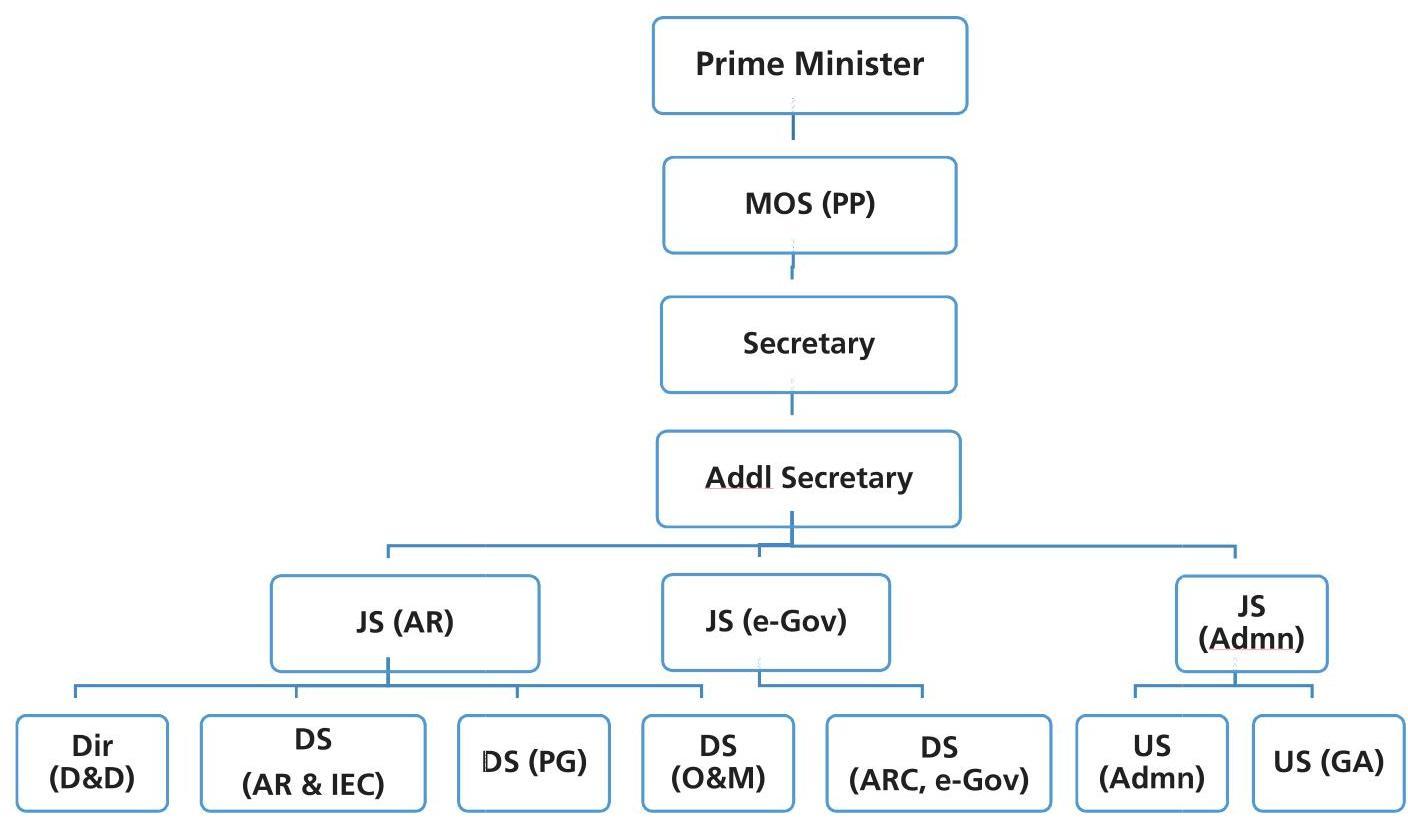
Department of Administrative Reforms and Public Grievances
Incumbency Position of Under Secretary and above level Officers in D/o AR&PG as on January, 31.11.2017
| Post | Name of Incumbent |
|---|---|
| Secretary | Shri K.V. Eapen |
| Additional Secretary | Ms. Vasudha Mishra |
| Joint Secretary | 1. Ms. Smita Kumar 2. Ms. Kiran Puri 3. Shri Vanraj A. Chavda |
| Director | 1. Smt. Alpana Shukla Rao |
| Deputy Secretary | 1. Shri Anurag Srivastava 2. Smt. Sumita Dasgupta 3. Shri Satish Kerba Jadhav |
| Under Secretary | 1. Smt. Renu Arora 2. Shri Sandeep Mohan Prasad 3. Smt. Prisca Mathew 4. Shri Dhananjay Kumar 5. Shri Ajit Kumar Sah 6. Shri U K Mukherjee 7. Shri Jagdish Kumar Ambwani 8. Shri R Rajendar Goud 9. Shri Jitendra Sihwag 10. Smt. Pratibha Ahuja 11. Shri Arun Kumar Sarkar 12. Shri Din Dayal 13. Shri Khamchin Naulak 14. Shri Gya Prasad 15. Smt. Vibhuti Panjiyar 16. Shri Rajiv Sharma |
| PPS | Shri Satish Kumar |
Annexure-IV
Department of Administrative Reforms and Public Grievances
Prevention of sexual harassment of women at work place
An Internal Complaint Committee has been constituted in Department of Administrative Reforms and Public Grievances for prevention of sexual harassment of women at work place comprising of following members:
(i) Smt. Smita Kumar Joint Secretary – Chairperson
(ii) Shri. Anurag Srivastava, Deputy Secretary – Member
(iii) Ms. Prisca Mathew, Under Secretary – Member
(iv) Ms. Hazel Siromoni, representative sponsored by YWCA – Member
Women employees are being made aware of existence of said Committee from time to time through circulars, display on notice boards and interactions. No complaint of sexual harassment from any of the women employees has been received during the year. However, to review the overall condition of working environment for women, the Committee met last time on 16.05.2017 and also decided to have regular interaction with women to give them comfort and security.
Annexure-V
Department of Administrative Reforms and Public Grievances Welfare of SC, ST, OBC and Person with Disability (PWD)
As on 22.11.2017, the incumbency position of SC, ST, OBC and Person with Disability (PWD) in the Group A, B and C category of officials of Department of Administrative Reforms and Public Grievances is as under:
| Category | Total | SC | ST | OBC | PWD |
|---|---|---|---|---|---|
| Group-A | 25 | 3 | 2 | 3 | — |
| Group-B | 45 | 7 | 2 | 6 | $1(\mathrm{OH})$ |
| $1(\mathrm{HH})$ | |||||
| Group-C | 22 | 11 | — | 1 | — |
| $\mathbf{9 2}$ | $\mathbf{2 1}$ | $\mathbf{4}$ | $\mathbf{1 0}$ | $\mathbf{2}$ |
The Department has appointed a Nodal Officer to look into the complaints/ representations, if any, received from SC, ST and OBC officials and as also to watch their welfare. As per instructions of DoPT, the Department is submitting annual report regarding SC, ST, OBC and PWD incumbents online through the URL “rrcps.nic.in”. No complaint from SC, ST, OBC and PWD officials is received during the year.
Annexure-VI
Department of Pension and Pensioner’s Welfare ORGANISATIONAL CHART
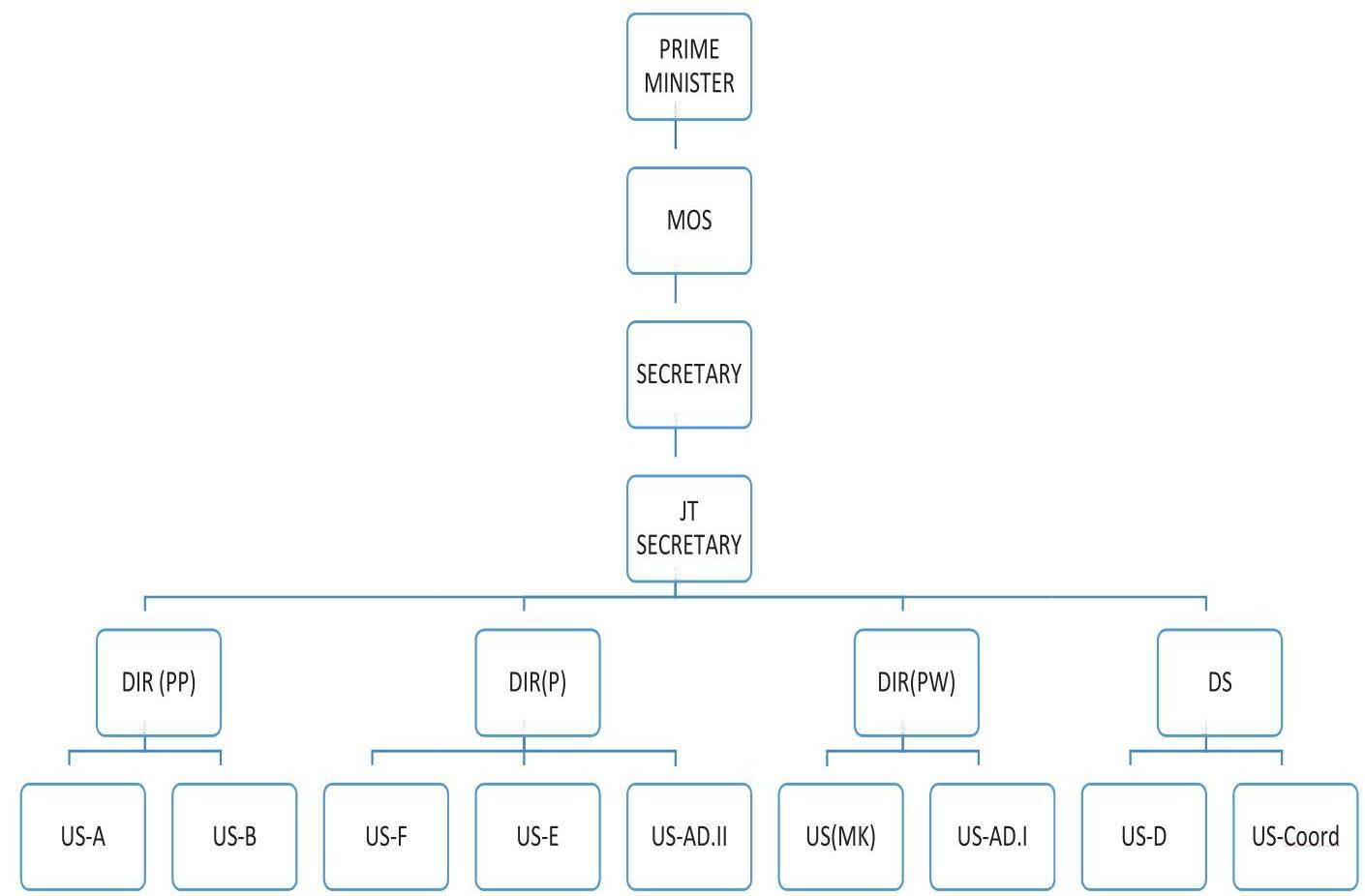
Annexure VII
Incumbency position of Group ‘A’ Officers in D/o Pension & Pensioners Welfare as on 11/12/2017
| Post | Name of the incumbent |
|---|---|
| Secretary | Shri K.V. Eapen |
| Joint Secretary | Shri Sanjiv Narain Mathur |
| Director | Smt. Seema Gupta Shri Harjit Singh Smt. Sujasha Choudhury |
| Deputy Secretary | Shri Sanjay Wadhawan |
| Under Secretary | Shri Rajendra Kumar Dutta Shri S.K.Makkar Shri Charanjit Taneja Shri Manoj Kumar Shri S.Chakrabarti Shri Sanjoy Shanker Shri Ashok Kumar Singh Shri T. C. Varghese Shri Subhash Chander |
| Assistant Director(OL) | Ms. Pushpalata Kumari |
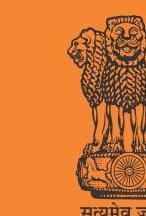
MINISTRY OF PERSONNEL, PUBLIC GRIEVANCES & PENSIONS GOVERNMENT OF INDIA